Birds of Switzerland in taxonomic hierarchy
Schellente am Südende des Pfäffikersee Ich hätte gern ein besseres Foto aber die Schellenten waren nur etwa 100 Meter vom
Weg entfernt und dazu hinter Schilf. Auch mein 600mm Objektiv hat nicht gereicht,
aber zugegeben, ein Stativ hätte geholfen. 2021-01-26 15.36.26 Pfäffikersee
First observed in 🇨🇭 on 2021-01-26.
This bird appears across the great seas in the following continents:
Europe, North America.
Etymology: Nabu: Schellenten verdanken ihren Namen dem pfeifenden und wie ein Klingeln («Schellen») tönenden Fluggeräusch. [Vogelwarte.ch erklärt: ]
Gruener Kopf mit gelbem Auge (Goldeneye), weisser Kreis zwischen Auge und (schwarzem) Schnabel, weisser Bauch und Seiten mit etwa 5 duennen schwarzen Streifen, schwarzer Ruecken. In Island gibt's eine sehr aehnliche Ente und in kleineren Mengen auch diese.
Wintergast am Pfäffikersee.
Vocalization: ![]() Male display sound a dry nasal disyllabic "Ka-weerr". First note introductory and second longer and descending. Usually accompanied by back-throwing head motion. Female: dry harsh "aahrrrr aahrrrr aahrrrr ". Wings make a characteristic whistling sound. [Link]
Male display sound a dry nasal disyllabic "Ka-weerr". First note introductory and second longer and descending. Usually accompanied by back-throwing head motion. Female: dry harsh "aahrrrr aahrrrr aahrrrr ". Wings make a characteristic whistling sound. [Link]
Physical details: length=42-50 cm,
wingspan=65-80 cm,
weight=650-1200 g
Habitats:
River and lake
Gänsesäger am Nordende des Pfäffikersee 2021-01-26 17.02.58 Pfäffikersee
First observed in 🇨🇭 on 2021-01-26.
This bird appears across the great seas in the following continents:
Europe, North America.
Zuerst gesehen am Pfäffikersee.
Vocalization: ![]() Male: Mostly heard when courting. A twanging, disyllabic "whip-ooooo", first syllable ascending and second whistle-like and rapidly falling. Female: A coarse "ahrrr ahrrrr", or a raspy drawn "ah-ahrrrrrr ah-ahrrrrr", slightly rising, then falling in pitch. Also various cackling sounds. [Link]
Male: Mostly heard when courting. A twanging, disyllabic "whip-ooooo", first syllable ascending and second whistle-like and rapidly falling. Female: A coarse "ahrrr ahrrrr", or a raspy drawn "ah-ahrrrrrr ah-ahrrrrr", slightly rising, then falling in pitch. Also various cackling sounds. [Link]
Physical details: length=58-66 cm,
wingspan=82-97 cm,
weight=900-2100 g
Habitats:
River and lake
Call:
Automatically generated from Xeno-Canto recording
♫ Source: BirdNet
20210510_090939 birdnet 1539 - Common Merganser plus Golden Oriole - = - Common Merganser - Locarno.mp3
2021-05-10 09.09.39 Locarno (song?)
Mittelsaeger Weibchen auf Lago Maggiore, Locarno. 2021-04-06 13.18.48 Northern Lago Maggiore
First observed in 🇨🇭 on 2021-04-06.
This bird appears across the great seas in the following continents:
Europe, North America.
Personal notes: ![]() Zuerst gesehen in Lago Maggiore in Locarno. Jan 2022 auch als Wintergast am Pfaeffikersee. [Link]
Zuerst gesehen in Lago Maggiore in Locarno. Jan 2022 auch als Wintergast am Pfaeffikersee. [Link]
Appearance and identification: ![]() In winter you can admire a few of these birds with the straggly tuft. [Link]
In winter you can admire a few of these birds with the straggly tuft. [Link]
Habitats:
River and lake
Looks similar to:
Greater scaup.
Eiderente, vom Steg aus gesehen in Rapperswil. 2021-02-12 13.42.20 Rapperswil
First observed in Iceland on 2015-06-09.
This bird appears across the great seas in the following continents:
Europe, North America.
Etymology: Nabu: Auch heute noch erinnert ihr wissenschaftlicher Name an die Bedeutung ihrer isolierenden Daunen für die Menschen. Übersetzt bedeutet ihr Name nämlich „die Allerweichste mit dem schwarzen Körper“. [Link]
Geography: ![]() Die im Norden Europas häufige und wegen ihren Daunenfedern bekannte Eiderente war in der Schweiz früher ein seltener Gast. Doch in der zweiten Hälfte des 20. Jahrhunderts erfolgten mehrere grosse Einflüge. Dank der Wandermuschelvermehrung war das Nahrungsangebot ausreichend und die Vögel verbrachten zunehmend den Sommer bei uns. Mittlerweile gehört die Eiderente sogar zu den Brutvögeln, was für einen ans Meer angepassten Vogel bemerkenswert ist. [Link]
Die im Norden Europas häufige und wegen ihren Daunenfedern bekannte Eiderente war in der Schweiz früher ein seltener Gast. Doch in der zweiten Hälfte des 20. Jahrhunderts erfolgten mehrere grosse Einflüge. Dank der Wandermuschelvermehrung war das Nahrungsangebot ausreichend und die Vögel verbrachten zunehmend den Sommer bei uns. Mittlerweile gehört die Eiderente sogar zu den Brutvögeln, was für einen ans Meer angepassten Vogel bemerkenswert ist. [Link]
Calls: ![]() Males call a typical, pleasant, clear, 2-3 second long "aaaooooooh". Starting on a low note, slowly ascending and ending on a descending note. Usually accompanied by the female "ga ga ga ga". [Link]
Males call a typical, pleasant, clear, 2-3 second long "aaaooooooh". Starting on a low note, slowly ascending and ending on a descending note. Usually accompanied by the female "ga ga ga ga". [Link]
Physical details: length=50-71 cm,
wingspan=80-108 cm,
weight=1500-2800 g
Habitats:
River and lake
Mother and 4 of 9 babies on the Pfäffikersee 2020-05-20 09.12.44 Pfäffikersee
First observed in 🇨🇭 on 2020-05-20.
This bird appears across the great seas in the following continents:
Europe, North America, South America, Africa.
Common waterbird at Pfäffikersee
Etymology: ![]() Der heutige Name kann als Hinweis auf ihre Brutplätze verstanden werden, zu denen auf Stock gesetzte Weiden, Weidengebüsch oder auch Reisighaufen gehören.
['Stock' wird weiter erklärt: Als Stockausschlag bezeichnet man bei Bäumen und Sträuchern Triebe, die nach dem Verlust der primären Sprossachse
neu aus dem Stumpf oder Stubben (der dann „Stock“ genannt wird) austreiben.] [Link]
Der heutige Name kann als Hinweis auf ihre Brutplätze verstanden werden, zu denen auf Stock gesetzte Weiden, Weidengebüsch oder auch Reisighaufen gehören.
['Stock' wird weiter erklärt: Als Stockausschlag bezeichnet man bei Bäumen und Sträuchern Triebe, die nach dem Verlust der primären Sprossachse
neu aus dem Stumpf oder Stubben (der dann „Stock“ genannt wird) austreiben.] [Link]
![]() The name 'was derived from the Old French malart or mallart for "wild drake"' [Link]
The name 'was derived from the Old French malart or mallart for "wild drake"' [Link]
Vocalization: ![]() Female: A distinct coarse, laughing quacking; "haaa ha ha ha ha ha", with first note accented and then descending in pitch. Male: a more silent, very nasal "rriib". [Link]
Female: A distinct coarse, laughing quacking; "haaa ha ha ha ha ha", with first note accented and then descending in pitch. Male: a more silent, very nasal "rriib". [Link]
Calls: ![]() Display call a high-pitched short whistle. [Link]
Display call a high-pitched short whistle. [Link]
Physical details: length=50-65 cm,
wingspan=81-98 cm,
weight=750-1450 g
Habitats:
River and lake
Krickente am Aa-Bach beim Südende des Pfäffikersee 2021-01-26 15.41.54 Pfäffikersee
First observed in 🇨🇭 on 2021-01-26.
This bird appears across the great seas in the following continents:
Europe, North America, South America, Africa, Asia.
Wintergast am Teich am Aa-Bach beim Südende des Pfäffikersee
Etymology: ![]() Die hellen «krrik»-Rufe der stimmfreudigen Erpel verhalfen dieser Art zu ihrem deutschen Namen. [Link]
Die hellen «krrik»-Rufe der stimmfreudigen Erpel verhalfen dieser Art zu ihrem deutschen Namen. [Link]
Vocalization: ![]() Male: characteristic, short, highly resonant and metallic "plytt". A bit similar to Pintail, but higher pitched and lacking accompanying whistling sound. Female: various quacking sounds generally quicker paced, more nasal and noticeably higher pitched than Mallard. [Link]
Male: characteristic, short, highly resonant and metallic "plytt". A bit similar to Pintail, but higher pitched and lacking accompanying whistling sound. Female: various quacking sounds generally quicker paced, more nasal and noticeably higher pitched than Mallard. [Link]
Physical details: length=34-38 cm,
wingspan=58-64 cm,
weight=200-450 g
Habitats:
River and lake
Call:
Blup blup, fast wie vom Computer generiert, fur mich nohe Noten (obwohl Sonogram nur 2.5 KHz zeigt)
Krickente Ruf von XenoCanto
♫ Krickente Ruf von XenoCanto Source: XENOCANTO
XC619133-Krickente von Peter Bosman, Belgium.mp3
(call)

Call attributes:
Call melody: simple rhythmic, slow, Frequency: low (1-3 KHz),
Loeffelenten am Greifensee bei Silberweide Es gab dutzende davon, dazwischen eine Krickente. 2021-02-08 15.20.36
First observed in 🇨🇭 on 2021-02-08.
This bird appears across the great seas in the following continents:
Europe, North America, South America, Africa.
Wintergast am Greifensee.
PK: white, black, rust-brown, yellow eyes, black spoonbill, red legs.
Vocalization: ![]() Male is characteristic and most often heard: A hoarse nasal knocking sound "took took", often staccato or disyllabic. Female similar to Mallard but flatter and more creaking. [Link]
Male is characteristic and most often heard: A hoarse nasal knocking sound "took took", often staccato or disyllabic. Female similar to Mallard but flatter and more creaking. [Link]
Physical details: length=44-52 cm,
wingspan=70-84 cm,
weight=470-800 g
Habitats:
River and lake
Profile Wikipedia eBird Vogelwarte BirdLife ZH ornitho.ch Audubon AllAboutBirds Xeno-Canto BirdID NABU
Spiessente Paar. 2022-02-05 13.14.54 Klingnauer Stausee (man-made lake)
First observed in 🇨🇭 on 2022-02-05.
This bird appears across the great seas in the following continents:
Europe, North America, South America, Africa, Asia.
Long tailfeathers make the name obvious, also a thin white stripe from the white neck up the back of the head.
Vocalization: ![]() Female: similar to Mallards coarse laughing sound, but with a more emphasized first "haaa", and a more silent accelerating subsequent "laugh". Male: Pleasant, resonant "plop" similar to Teal, but lower pitched, richer, mellower and not so metallic. Accompanied by a higher pitched, slightly raspy whistling "aiiooo" rising and falling in pitch. [Link]
Female: similar to Mallards coarse laughing sound, but with a more emphasized first "haaa", and a more silent accelerating subsequent "laugh". Male: Pleasant, resonant "plop" similar to Teal, but lower pitched, richer, mellower and not so metallic. Accompanied by a higher pitched, slightly raspy whistling "aiiooo" rising and falling in pitch. [Link]
Physical details: length=51-66 cm,
wingspan=51-66 cm,
weight=500-1100 g
Habitats:
River and lake
Schnatterente am Greifensee bei Silberweide Es gab dutzende davon, dazwischen eine Krickente. 2021-02-08 15.45.18
First observed in 🇨🇭 on 2021-02-08.
This bird appears across the great seas in the following continents:
Europe, North America, Africa.
In my mind this is the chocolate duck.
Etymology: ![]() The etymology of the word gadwall is not known, but the name has been in use since 1666.[9] [Link]
The etymology of the word gadwall is not known, but the name has been in use since 1666.[9] [Link]
Nabu: Die Schnatterente fällt aber – wie ihr Name schon vermuten lässt – durch ihre Art der Nahrungssuche auf. Sie durchschnattert das Wasser mit ihrem Schnabel. [Link]
Chocolate bill, black-and-white pattern on head, shoulders, belly, sides of wings, chocolate patterned wings, black butt, a bit of white before the butt.
Appearance and identification: Nabu: Die Schnatterente ähnelt auf den ersten Blick so sehr der weiblichen Stockente, dass man diese schnell verwechseln kann. [Link]
Wintergast am Greifensee.
Calls: ![]() Males display-call a short dry rattling or croaking sound and some high whistling notes. Female quacking similar to Mallard, but drier and shriller. [Link]
Males display-call a short dry rattling or croaking sound and some high whistling notes. Female quacking similar to Mallard, but drier and shriller. [Link]
Physical details: length=46-56 cm,
wingspan=84-95 cm,
weight=550-1000 g
Habitats:
River and lake
Call:
Automatically generated from Xeno-Canto recording
♫ Schnatterenten, Moewen und an 29 Sekunden eindeutig ein Jet von Swiss, da wir in Neeracherried sehr nach am Kloten Flughafen sind, BirdNet schlaegt auch Teichrohrsaenger vor, wie auch ein Moewe-Typ aus Kalifornien. ![]() Source: Zoom H6 2021-10-24 13.12.46 Neeracherried (song?)
Source: Zoom H6 2021-10-24 13.12.46 Neeracherried (song?)
Pfeifente Erpel , Neeracher Ried. Die zehnte Entenart, die ich gefunden habe. 2021-02-24 14.05.08 Neeracherried
First observed in 🇨🇭 on 2021-02-24.
This bird appears across the great seas in the following continents:
Europe, North America, Africa.
Etymology: ![]() Es ist der Ruf des Männchens, der zu dem deutschen Namen der Art geführt hat. Das Männchen leitet seine kurzen, scharfen, zwei- bis dreisilbigen pfeifenden wiu-Rufe häufig mit einem krr krkrkrr ein. [Link]
Es ist der Ruf des Männchens, der zu dem deutschen Namen der Art geführt hat. Das Männchen leitet seine kurzen, scharfen, zwei- bis dreisilbigen pfeifenden wiu-Rufe häufig mit einem krr krkrkrr ein. [Link]
Funny red head (made me confused it with the Kolbente) that's brown with a golden forehead (Kolbente is brown, a bit lighter at the back of the head) is the obvious characteristic. Also has a nice black and white pattern on its back and wings with white-rimmed black feathers at the end of the wing, a bit of white before a black butt.
Vocalization: ![]() Male: a pleasant high pitched whistle "piiiiuuu", rapidly rising in pitch and then falling. Quite vocal. Female: a harsh "kraaa kraaa kraa" more like female diving-ducks than other dabbling-ducks. [Link]
Male: a pleasant high pitched whistle "piiiiuuu", rapidly rising in pitch and then falling. Quite vocal. Female: a harsh "kraaa kraaa kraa" more like female diving-ducks than other dabbling-ducks. [Link]
Physical details: length=45-51 cm,
wingspan=75-86 cm,
weight=500-1000 g
Habitats:
River and lake
Call:
Pfeifen, fast wie ein Rotmilan oder Maeusebussard. Ton steigt und faellt!
Pfeifente von XenoCanto
♫ Pfeifente von XenoCanto Source: XENOCANTO
XC613742-Pfeifente von Adrien Mauss.mp3
(call)
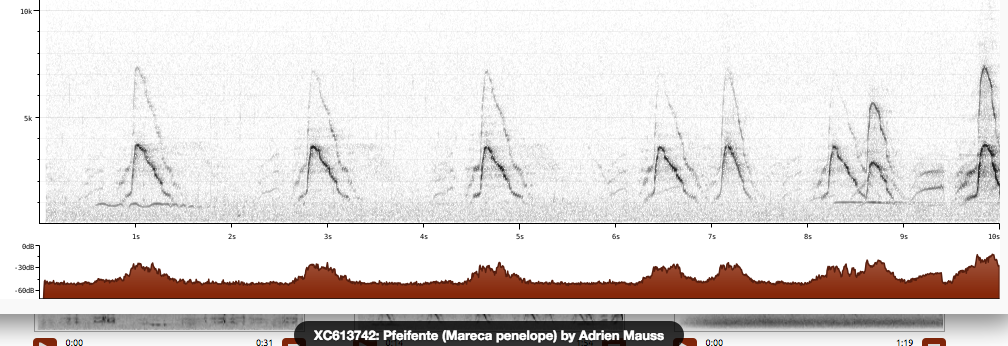
Call attributes:
Call melody: simple rhythmic, slow, Frequency: low (1-3 KHz),
Profile Wikipedia eBird Vogelwarte BirdLife ZH ornitho.ch Xeno-Canto NABU
Reiherenten und Kolbenente-Paar. 2021-02-12 10.49.46
First observed in Iceland on 2015-06-05.
Etymology: Nabu: Die Kolbenente hat ihren Namen wohl aufgrund des auffällig großen Kopfes des Männchens. Dieser Eindruck wird durch eine ausgeprägte rotbraune Federhaube auf dem Kopf erzeugt. Die Federhaube dürfte vor allem während der Balzzeit von Vorteil sein, wenn der Erpel ein ausgeprägtes Balzverhalten zeigt, um das Weibchen zu beeindrucken. [Link]
Funny red head that's brown with a golden forehead is the obvious characteristic. Also has a nice black and white pattern on its back and wings with white-rimmed black feathers at the end of the wing, a bit of white before a black butt.
Appearance and identification: ![]() Erpel mit orangerotem, buschig dickem Kopf und korallenrotem Schnabel, Hals und Unterseite schwarz; Ente bräunlich mit weissgrauen Wangen, die sich scharf von der dunklen Kopfplatte abheben, Schnabel dunkelgrau; ruft knarrend "körr". [Link]
Erpel mit orangerotem, buschig dickem Kopf und korallenrotem Schnabel, Hals und Unterseite schwarz; Ente bräunlich mit weissgrauen Wangen, die sich scharf von der dunklen Kopfplatte abheben, Schnabel dunkelgrau; ruft knarrend "körr". [Link]
Habitats:
River and lake
Tafelente in Rapperswil. 2021-02-12 13.34.38 Rapperswil
First observed in 🇨🇭 on 2021-02-08.
This bird appears across the great seas in the following continents:
Europe, North America, Africa.
Wintergast am Greifensee.
Etymology: ![]() Die in der deutschen Sprache übliche Bezeichnung Tafelente ist ein Hinweis auf das als schmackhaft angesehene Fleisch dieses Entenvogels. [Link]
Die in der deutschen Sprache übliche Bezeichnung Tafelente ist ein Hinweis auf das als schmackhaft angesehene Fleisch dieses Entenvogels. [Link]
Tafelente: Wiederspruch: wer isst ein Tier mit roten Augen?Rostbraun, schwarz, schwarz-weiss-gemustert, Schnabel schwarz UND weiss.
Vocalization: ![]() Female: a coarse "ahrrrrrrr-ahrrrrr-ahrrrr" with a vibrating quality. [Link]
Female: a coarse "ahrrrrrrr-ahrrrrr-ahrrrr" with a vibrating quality. [Link]
Calls: ![]() Male courting call a pleasant, drawn out, nasal whistle "tweeeeep", rising in pitch, often followed by a falling "puuuh" (e.g a long disyllabic tweeepuuuuuuh). Also a sharper "ki-ki-ki" or "ki-ki-kiko". [Link]
Male courting call a pleasant, drawn out, nasal whistle "tweeeeep", rising in pitch, often followed by a falling "puuuh" (e.g a long disyllabic tweeepuuuuuuh). Also a sharper "ki-ki-ki" or "ki-ki-kiko". [Link]
Physical details: length=42-49 cm,
wingspan=72-82 cm,
weight=650-1200 g
Habitats:
River and lake
Reiherente closeup bei Jona. 2021-02-12 10.34.46 Jona
First observed in Iceland on 2015-06-05.
Schwarz-weiss mit Muster auf Ruecken/Fluegel, gelbe Augen, blau-grauer Schnabel mit schwarzer Spitze
On a lake in wintertime.
Geography: ![]() 'Die Reiherente ... zählt zu den so genannten Tauchenten und gilt als die häufigste Süßwassertauchente. Es handelt sich um eine verhältnismäßig kleine, kompakt gebaute Ente. Auffällig sind der verhältnismäßig kurze Schnabel und der auffällig runde Kopf. Die Männchen haben am Hinterkopf einen langen, herabhängenden Schopf. Das Weibchen weist eine kurze Holle auf.
Die Reiherente ist in Mitteleuropa ein verbreiteter Brut- und Jahresvogel',
und in der Schweiz ein Wintergast. [Link]
'Die Reiherente ... zählt zu den so genannten Tauchenten und gilt als die häufigste Süßwassertauchente. Es handelt sich um eine verhältnismäßig kleine, kompakt gebaute Ente. Auffällig sind der verhältnismäßig kurze Schnabel und der auffällig runde Kopf. Die Männchen haben am Hinterkopf einen langen, herabhängenden Schopf. Das Weibchen weist eine kurze Holle auf.
Die Reiherente ist in Mitteleuropa ein verbreiteter Brut- und Jahresvogel',
und in der Schweiz ein Wintergast. [Link]
Vocalization: ![]() Male display sound: High pitched short whistling-like noises, "pjuu-uu", not very audible. [Link]
Male display sound: High pitched short whistling-like noises, "pjuu-uu", not very audible. [Link]
Calls: ![]() Both sexes have harsh "ahrrrr" calls like other diving ducks, sometimes with a crow-like quality. [Link]
Both sexes have harsh "ahrrrr" calls like other diving ducks, sometimes with a crow-like quality. [Link]
Physical details: length=40-47 cm,
wingspan=67-73 cm,
weight=500-1000 g
Habitats:
River and lake
Moorente. 2021-03-07 12.08.04
First observed in 🇨🇭 on 2021-03-07.
Woody brown (ferruginous means rust-red), black and white with a gray bill. Butt is white, but also a part of the belly not seen when it's in water. Tall head reminds me of a Kolbenente/Red-crested pochard, but is pure brown.
Etymology: ![]() The scientific name is derived from Greek aithuia an unidentified seabird mentioned by authors including Hesychius and Aristotle, and nyrok, the Russian name for a duck. [Link]
The scientific name is derived from Greek aithuia an unidentified seabird mentioned by authors including Hesychius and Aristotle, and nyrok, the Russian name for a duck. [Link]
Calls: ![]() Female call similar to female Tufted Duck's "kerr kerr", but thinner and with a strong, peculiar bi-tone. Male display call mostly consists of various short "chk" sounds. [Link]
Female call similar to female Tufted Duck's "kerr kerr", but thinner and with a strong, peculiar bi-tone. Male display call mostly consists of various short "chk" sounds. [Link]
Physical details: length=38-42 cm,
wingspan=63-67 cm,
weight=450-700 g
Habitats:
River and lake

Wikipedia: Greater scaup Source: OTHER
1200px-2017-03-24_Aythya_marila%2C_male%2C_Killingworth_Lake%2C_Northumberland_15.jpg
This bird appears across the great seas in the following continents:
Europe, North America.
Deutschland: Zugvogel, Wintergast RL R
Calls: ![]() Male call carries only a few meters: a whistling "po-ho" last syllable slowly descending. Female calls with harsh "harr-harrr-harrr". [Link]
Male call carries only a few meters: a whistling "po-ho" last syllable slowly descending. Female calls with harsh "harr-harrr-harrr". [Link]
Physical details: length=42-51 cm,
wingspan=72-84 cm,
weight=700-1300 g
Habitats:
River and lake
Looks similar to:
Red-breasted merganser.
Nilgans am Südende des Greifensee 2021-02-08 15.21.56
First observed in Botswana on 2016-09-24.
This bird appears across the great seas in the following continents:
Europe, North America, Africa.
Wintergast am Greifensee. Invasiv. Nach Vogelwarte.ch: 'als Ziervogel im 18. Jahrhundert in Europa eingeführt...
Ausgehend von einer in den 1970er Jahren in den Niederlanden und Belgien gebildeten Population breitete sich die Nilgans rasant dem Rhein und seinen Nebenflüssen entlang aus und hat inzwischen auch die Schweiz erreicht.
Vocalization: ![]() Quite vocal when interacting. [Link]
Quite vocal when interacting. [Link]
Calls: ![]() Female calls may resemble RS, but are coarser, harder and trills are more rolling. Single calls are longer, and falls markedly in pitch. Male calls quite different, with husky, wheezing or hissing "kaahhh", or with the same timbre in series lika a steam engine. [Link]
Female calls may resemble RS, but are coarser, harder and trills are more rolling. Single calls are longer, and falls markedly in pitch. Male calls quite different, with husky, wheezing or hissing "kaahhh", or with the same timbre in series lika a steam engine. [Link]
Physical details: length=63-73 cm,
wingspan=134-154 cm,
weight=1500-2250 g
Profile Wikipedia eBird Vogelwarte BirdLife ZH ornitho.ch Xeno-Canto BirdID NABU
Brandgans mal zwei. 2022-02-05 13.43.48 Klingnauer Stausee (man-made lake)
First observed in 🇨🇭 on 2022-02-05.
Deutschland: Brut-, Jahres-, Zugvogel, Wintergast
Vocalization: ![]() Male: Various whistling sounds. Often series of ricochet-like "piu" repeated with gradually rising and falling intensity. Also passerine-like "tzzrrrr". Female: different variants on deeper hoarse sounds like "ar-ar-ar-ar" sometimes with accented endings with rising pitch. [Link]
Male: Various whistling sounds. Often series of ricochet-like "piu" repeated with gradually rising and falling intensity. Also passerine-like "tzzrrrr". Female: different variants on deeper hoarse sounds like "ar-ar-ar-ar" sometimes with accented endings with rising pitch. [Link]
Physical details: length=58-67 cm,
wingspan=110-133 cm,
weight=800-1450 g
Habitats:
River and lake
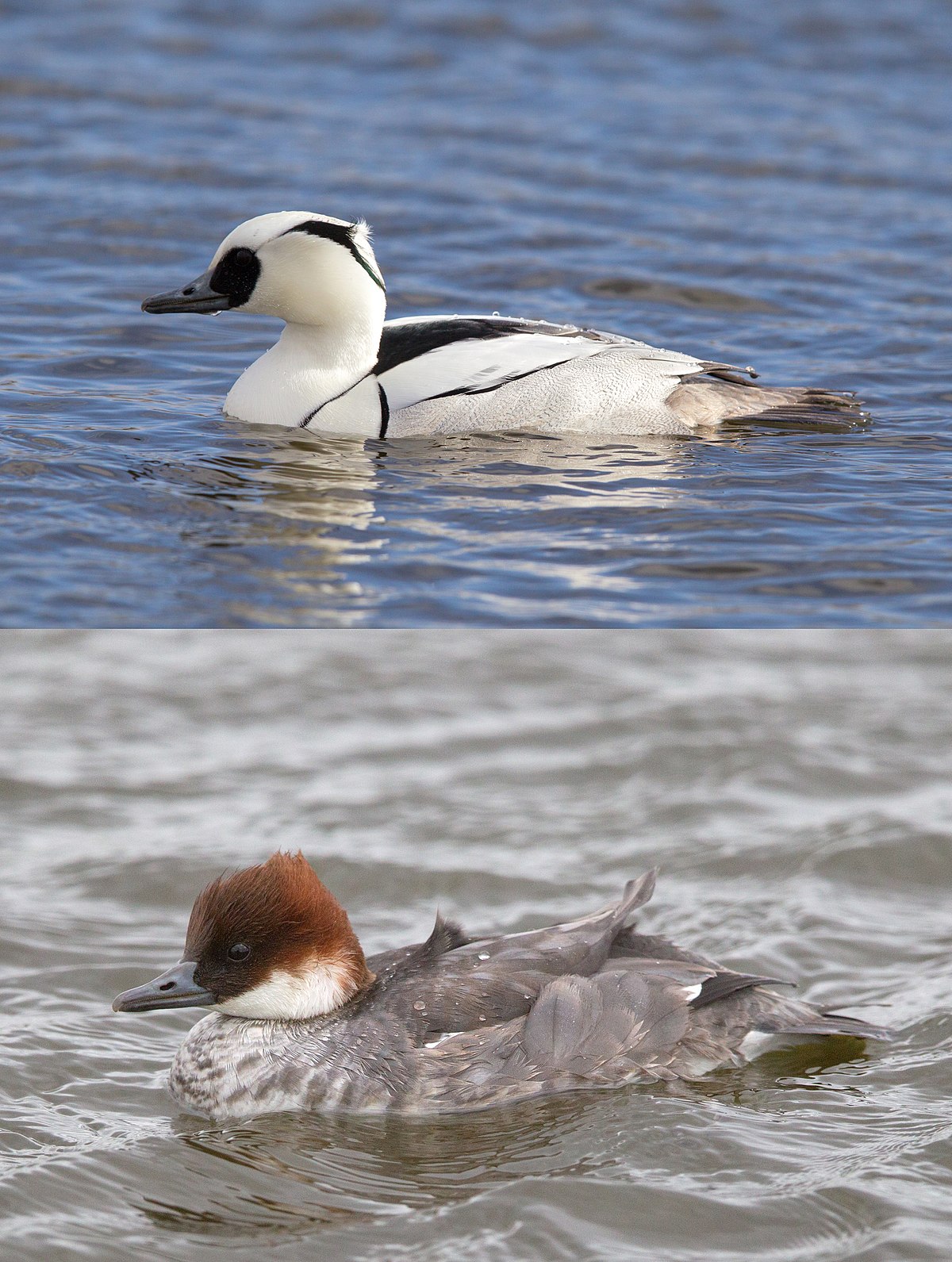
Wikipedia: Smew Source: OTHER
1200px-Zwergsaeger_maenchen_weibchen.jpg
Deutschland: Zugvogel, Wintergast
Vocalization: ![]() Mostly quiet except when displaying, and even then difficult to hear. Male: an ascending, froglike, rattling pulse of clicks. Also various grunting sounds. [Link]
Mostly quiet except when displaying, and even then difficult to hear. Male: an ascending, froglike, rattling pulse of clicks. Also various grunting sounds. [Link]
Calls: ![]() Alarm call a harsh "Kraaa". [Link]
Alarm call a harsh "Kraaa". [Link]
Physical details: length=38-44 cm,
wingspan=55-69 cm,
weight=500-800 g
Habitats:
River and lake
Profile Wikipedia eBird Vogelwarte BirdLife ZH ornitho.ch Audubon AllAboutBirds Xeno-Canto NABU

Wikipedia: Long-tailed duck Source: OTHER
Long-tailed-duck.jpg
This bird appears across the great seas in the following continents:
Europe, North America.
Deutschland: Zugvogel, Wintergast
Habitats:
River and lake
Sieben Samtenten, Durchzuegler die nicht in der Schweiz bleiben. 2023-02-09 16.15.58 Sils
First observed in 🇨🇭 on 2023-02-09.
This bird appears across the great seas in the following continents:
Europe, North America.
Deutschland: Zugvogel, Wintergast
Vocalization: ![]() Seldom heard. [Link]
Seldom heard. [Link]
Calls: ![]() Calls: Short accented "tup tup tup" and a shivering "gahhahahaha". [Link]
Calls: Short accented "tup tup tup" and a shivering "gahhahahaha". [Link]
Physical details: length=51-58 cm,
wingspan=90-99 cm,
weight=1100-2000 g
Habitats:
River and lake

Wikipedia: Common scoter Source: OTHER
1200px-Eurasian_common_scoter.jpg
This bird appears across the great seas in the following continents:
Europe, North America, Africa.
General: ![]() Anas nigra Linnaeus, 1758
[more]
Anas nigra Linnaeus, 1758
[more]
Vocalization: ![]() More vocal than other Scoters. Short, whistling sounds, sometimes reminiscent of a male teal, but a little bit deeper in pitch. [Link]
More vocal than other Scoters. Short, whistling sounds, sometimes reminiscent of a male teal, but a little bit deeper in pitch. [Link]
Physical details: length=44-54 cm,
wingspan=79-90 cm,
weight=650-1300 g
Habitats:
River and lake
Graugans paar. 2021-03-07 12.23.32
First observed in 🇨🇭 on 2021-02-26.
Found on practically all Swiss lakes, especially north of the alps.
Appearance and identification: ![]() Grösste europäische Wildgans. [Link]
Grösste europäische Wildgans. [Link]
Vocalization: ![]() Various cackling and honking sounds "gaiiiaia-ga-ga". [Link]
Various cackling and honking sounds "gaiiiaia-ga-ga". [Link]
Calls: ![]() Typically the first syllable is accented, and given with a register break into higher pitch (at 0:18 in recording). [Link]
Typically the first syllable is accented, and given with a register break into higher pitch (at 0:18 in recording). [Link]
Physical details: length=75-90 cm,
wingspan=147-180 cm,
weight=2100-4300 g
Habitats:
River and lake

Wikipedia: Taiga bean goose Source: OTHER
Bean.goose.600pix.jpg
This bird appears across the great seas in the following continents:
Europe, North America, Africa.
Deutschland: Zugvogel, Wintergast Bruten gehen auf entflogene Tiere zurück
Calls: ![]() Do not call as much as other grey geese. Sounds similar to the lower sounds of Pink-footed goose, with various reedy calls, but harder, less nasal and more of a "sore throat". [Link]
Do not call as much as other grey geese. Sounds similar to the lower sounds of Pink-footed goose, with various reedy calls, but harder, less nasal and more of a "sore throat". [Link]
Physical details: length=66-84 cm,
wingspan=142-175 cm,
weight=2220-4060 g
Habitats:
River and lake
White-fronted goose closeup, on the way home from Laphroiag? 2023-08-11 13.38.38 Islay
First observed in Islay on 2023-08-11.
This bird appears across the great seas in the following continents:
Europe, North America, Africa.
Deutschland: Zugvogel, Wintergast Bruten gehen auf entflogene Tiere zurück
Habitats:
River and lake
On the frozen Pfäffikersee with coots After a week of freezing temperatures, the lake developed a thin layer of ice. 2021-02-15 08.28.58
First observed in 🇨🇭 on 2021-02-12.
This bird appears across the great seas in the following continents:
Europe, North America, Africa.
Common waterbird at Pfäffikersee, very common on Lake Zurich.
Vocalization: ![]() Silent compared to other swans. A repertoire of snorting, grunting and hissing sound when interacting. No far carrying sounds. [Link]
Silent compared to other swans. A repertoire of snorting, grunting and hissing sound when interacting. No far carrying sounds. [Link]
Calls: ![]() Wings produce prominent singing sound which may function as a flight contact-call. [Link]
Wings produce prominent singing sound which may function as a flight contact-call. [Link]
Physical details: length=145-160 cm,
wingspan=208-238 cm,
weight=7000-14000 g
Habitats:
River and lake
Whooper swan, Iceland. 2015-06-03 16.01.16 Iceland
First observed in Iceland on 2015-06-03.
This bird appears across the great seas in the following continents:
Europe, North America.
Deutschland: Zugvogel, Wintergast RL R
Vocalization: ![]() Quite vocal. Trumpet-like clear honks of half a second length most frequent in flight and take-off/landing. Often voiced with a register break. [Link]
Quite vocal. Trumpet-like clear honks of half a second length most frequent in flight and take-off/landing. Often voiced with a register break. [Link]
Physical details: length=145-160 cm,
wingspan=218-243 cm,
weight=8500-10000 g
Habitats:
River and lake

Wikipedia: Tundra swan Source: OTHER
1200px-Cygnus_bewickii_01.jpg
This bird appears across the great seas in the following continents:
Europe, North America.
General: ![]() The tundra swan (Cygnus columbianus) is a small Holarctic swan. The two taxa within it are usually regarded as conspecific, but are also sometimes[2][3] split into two species: Bewick's swan (Cygnus bewickii) of the Palaearctic and the whistling swan (C. columbianus) proper of the Nearctic. Birds from eastern Russia (roughly east of the Taimyr Peninsula) are sometimes separated as the subspecies C. c. jankowskii, but this is not widely accepted as distinct, with most authors including them in C. c. bewickii. Tundra swans are sometimes separated in the subgenus Olor together with the other Arctic swan species.
[more]
The tundra swan (Cygnus columbianus) is a small Holarctic swan. The two taxa within it are usually regarded as conspecific, but are also sometimes[2][3] split into two species: Bewick's swan (Cygnus bewickii) of the Palaearctic and the whistling swan (C. columbianus) proper of the Nearctic. Birds from eastern Russia (roughly east of the Taimyr Peninsula) are sometimes separated as the subspecies C. c. jankowskii, but this is not widely accepted as distinct, with most authors including them in C. c. bewickii. Tundra swans are sometimes separated in the subgenus Olor together with the other Arctic swan species.
[more]
Vocalization: ![]() More vocal than other swans. Both higher pitched and deeper sounds. Birds on the water often gives crooning, crane-like notes with less defined pitch. [Link]
More vocal than other swans. Both higher pitched and deeper sounds. Birds on the water often gives crooning, crane-like notes with less defined pitch. [Link]
Calls: ![]() Tone is less full-bodied in these calls. Flight call a deep, yelping, soft barking sound. Each call short, with a "helpless" quality. [Link]
Tone is less full-bodied in these calls. Flight call a deep, yelping, soft barking sound. Each call short, with a "helpless" quality. [Link]
Physical details: length=115-127 cm,
wingspan=180-211 cm,
weight=3400-7800 g
Garganey (alternate) / Spatula querquedula (alternate) (Spatula querquedula)
General: ![]() Die Knäkente (Spatula querquedula, Syn.: Anas querquedula) ist eine kleine Entenart, die unter anderem in Mitteleuropa brütet. Sie ist ein wenig größer als die in Mitteleuropa häufigere Krickente, jedoch in ihrer Gestalt insgesamt etwas schlanker und zierlicher. Auffälliges Unterscheidungsmerkmal des Erpels im Prachtkleid ist der breite bogenförmige Streifen über dem Auge, der bis in den Nacken reicht und der sich deutlich vom rötlichbraunen Kopf sowie dem dunklen Nacken abhebt. Im Flug kann die Knäkente anhand ihres hellblaugrauen Vorderflügels identifiziert werden.
[more]
Die Knäkente (Spatula querquedula, Syn.: Anas querquedula) ist eine kleine Entenart, die unter anderem in Mitteleuropa brütet. Sie ist ein wenig größer als die in Mitteleuropa häufigere Krickente, jedoch in ihrer Gestalt insgesamt etwas schlanker und zierlicher. Auffälliges Unterscheidungsmerkmal des Erpels im Prachtkleid ist der breite bogenförmige Streifen über dem Auge, der bis in den Nacken reicht und der sich deutlich vom rötlichbraunen Kopf sowie dem dunklen Nacken abhebt. Im Flug kann die Knäkente anhand ihres hellblaugrauen Vorderflügels identifiziert werden.
[more]
Vocalization: ![]() Male display sound a characteristic dry rattling, like the sound of running fingernails along the teeth of a comb. A bit similar to Ptarmigan. Also heard at other times than when courting. [Link]
Male display sound a characteristic dry rattling, like the sound of running fingernails along the teeth of a comb. A bit similar to Ptarmigan. Also heard at other times than when courting. [Link]
Calls: ![]() Female: like female Teal, but typically a bit deeper and shorter calls. [Link]
Female: like female Teal, but typically a bit deeper and shorter calls. [Link]
Physical details: length=37-41 cm,
wingspan=60-63 cm,
weight=250-450 g
Great cormorant / Kormoran (Phalacrocorax carbo)
Profile Wikipedia eBird Vogelwarte BirdLife ZH ornitho.ch Audubon AllAboutBirds Xeno-Canto BirdID NABU
Cormorant Cormorants' feathers lack the waterproofing that ducks have,
so you often see them drying their wings on a convenient perch. 2021-01-26 15.56.30 Pfäffikersee
First observed in 🇨🇭 on 2021-01-26.
This bird appears across the great seas in the following continents:
Europe, North America, Africa, Asia.
Seasonal Behavior: ![]() Lokaler Brutvogel, regelmässiger, häufiger Durchzügler und Wintergast.[Brutpaare am Zuerichsee und Greifensee bei Moenchaltorf] [Link]
Lokaler Brutvogel, regelmässiger, häufiger Durchzügler und Wintergast.[Brutpaare am Zuerichsee und Greifensee bei Moenchaltorf] [Link]
Vocalization: ![]() Mostly heard at breeding ground. Also deep, rattling and creaking sounds. [Link]
Mostly heard at breeding ground. Also deep, rattling and creaking sounds. [Link]
Calls: ![]() Coarse, vibrating calls "hahahahaharo". [Link]
Coarse, vibrating calls "hahahahaharo". [Link]
Physical details: length=80-100 cm,
wingspan=130-160 cm,
weight=1700-3000 g
Habitats:
River and lake
Call:
Automatically generated from Xeno-Canto recording
♫ Source: BirdNet
20210519_073923 birdnet 1559 - Great Cormorant - 2021-05-19 07:39:23 - Great Cormorant - Cudrefin.mp3
2021-05-19 07.39.23 La Sauge (song?)
Grey heron / Graureiher (Ardea cinerea)
Graureiher mit Zöpfchen am Meteorwasserkanal Pfäffikersee 2021-02-15 09.08.30 Pfäffikersee
First observed in 🇨🇭 on 2020-05-07.
Frequent visitor.
Normally in the fields looking for food, also seen flying over or standing in the Luppmen (brook).
Vocalization: ![]() Quite vocal. At breeding ground a varied repertoire of harsh and clattering sounds. [Link]
Quite vocal. At breeding ground a varied repertoire of harsh and clattering sounds. [Link]
Calls: ![]() Most common call a short, far reaching and extremely harsh, rasping sound. [Link]
Most common call a short, far reaching and extremely harsh, rasping sound. [Link]
Physical details: length=90-98 cm,
wingspan=175-195 cm,
weight=1020-2073 g
Habitats:
Wetland
Call:
General: Mechanical-sounding sort-of-a-quack
Call: ![]() Quite vocal. Most common call a short, far reaching and extremely harsh, rasping sound. At breeding ground a varied repertoire of harsh and clattering sounds. [Link]
Quite vocal. Most common call a short, far reaching and extremely harsh, rasping sound. At breeding ground a varied repertoire of harsh and clattering sounds. [Link]
Call attributes:
Call melody: non-musical, slow, Frequency: low (1-3 KHz),
Great egret / Silberreiher (Ardea alba)
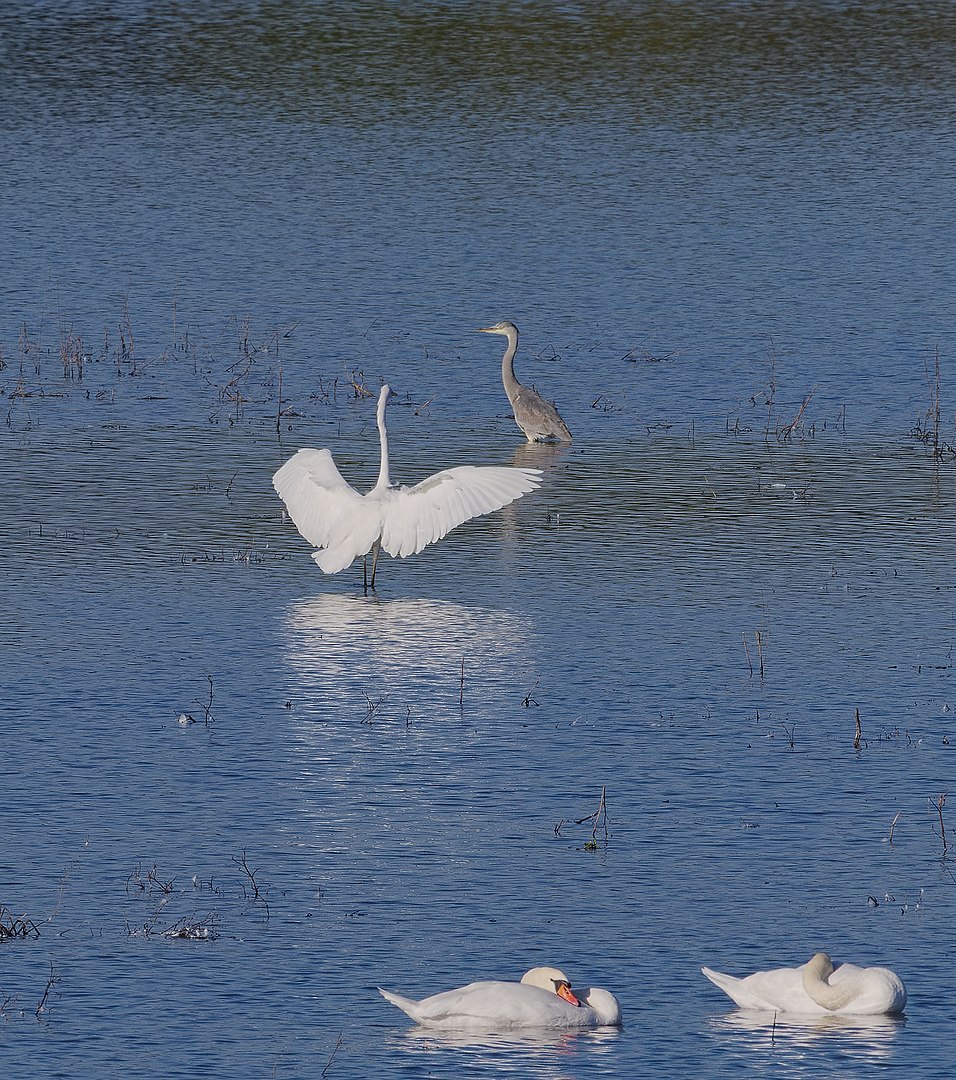
Silberreiher in Deutschland, von WikiCommons Von Andreas Eichler, CC BY-SA 4.0, https://commons.wikimedia.org/w/index.php?curid=59954907 Source: OTHER
Wikicommons 2016.10.30--Silberreiher.jpg
First observed in 🇨🇭 on 2021-02-24.
This bird appears across the great seas in the following continents:
Europe, North America, South America, Africa, Asia.
Auf dem Heimweg von Schwanden haben wir bei Benken ganz weisse Reiher gesehen.
Laut ornitho.ch waren sie Silberreiher.
Bei den meisten Quellen heisst es, sie sind in der Schweiz nur Durchzüger oder Wintergäste.
Aber laut Balzari und Gygax, brüten auch einige Vögel am Lac Neuchatel seit 2013.
Vocalization: ![]() Silent outside breeding ground. [Link]
Silent outside breeding ground. [Link]
Calls: ![]() In colonies various harsh calls like a dry, and mechanical "kerrrrrrr", and a very nasal "geet" or "ga-geet ga-geet" are heard. [Link]
In colonies various harsh calls like a dry, and mechanical "kerrrrrrr", and a very nasal "geet" or "ga-geet ga-geet" are heard. [Link]
Physical details: length=85-102 cm,
wingspan=140-170 cm,
weight=960-1030 g
Habitats:
Wetland
Call:
Partly an awkward quack: uck uck. Rattles. Deep-toned urrr. Higher-toned trill.
Call attributes:
Call melody: non-musical, slow, Frequency: low (1-3 KHz),
Purple heron / Purpurreiher (Ardea purpurea)
Profile Wikipedia eBird Vogelwarte BirdLife ZH ornitho.ch Xeno-Canto BirdID NABU
Purple heron, Phnom Krom. 2024-03-03 06.13.38 Cambodia
First observed in Cambodia on 2024-03-03.
General: ![]() The purple heron (Ardea purpurea) is a wide-ranging species of wading bird in the heron family, Ardeidae. The scientific name comes from Latin ardea "heron", and purpureus, "coloured purple".[2] It breeds in Africa, central and southern Europe, and southern and eastern Asia. The Western Palearctic populations migrate between breeding and wintering habitats whereas the African and tropical-Asian populations are primarily sedentary, except for occasional dispersive movements.
[more]
The purple heron (Ardea purpurea) is a wide-ranging species of wading bird in the heron family, Ardeidae. The scientific name comes from Latin ardea "heron", and purpureus, "coloured purple".[2] It breeds in Africa, central and southern Europe, and southern and eastern Asia. The Western Palearctic populations migrate between breeding and wintering habitats whereas the African and tropical-Asian populations are primarily sedentary, except for occasional dispersive movements.
[more]
Vocalization: ![]() Quite similar to Grey Heron, but not so vocal. [Link]
Quite similar to Grey Heron, but not so vocal. [Link]
Calls: ![]() Pitch slightly higher and remains stable throughout the short call. Volume muffled and timbre drier. [Link]
Pitch slightly higher and remains stable throughout the short call. Volume muffled and timbre drier. [Link]
Physical details: length=78-90 cm,
wingspan=120-150 cm,
weight=525-1218 g
Habitats:
Wetland
Call:
Automatically generated from Xeno-Canto recording
♫ XC878038 - Purple Heron - Ardea purpurea manilensis - flight call - Nonthaburi, Thailand. Source: XENOCANTO
XC878038 - Purple Heron - Ardea purpurea manilensis - flight call - Nonthaburi, Thailand.mp3
Thailand (flight call)
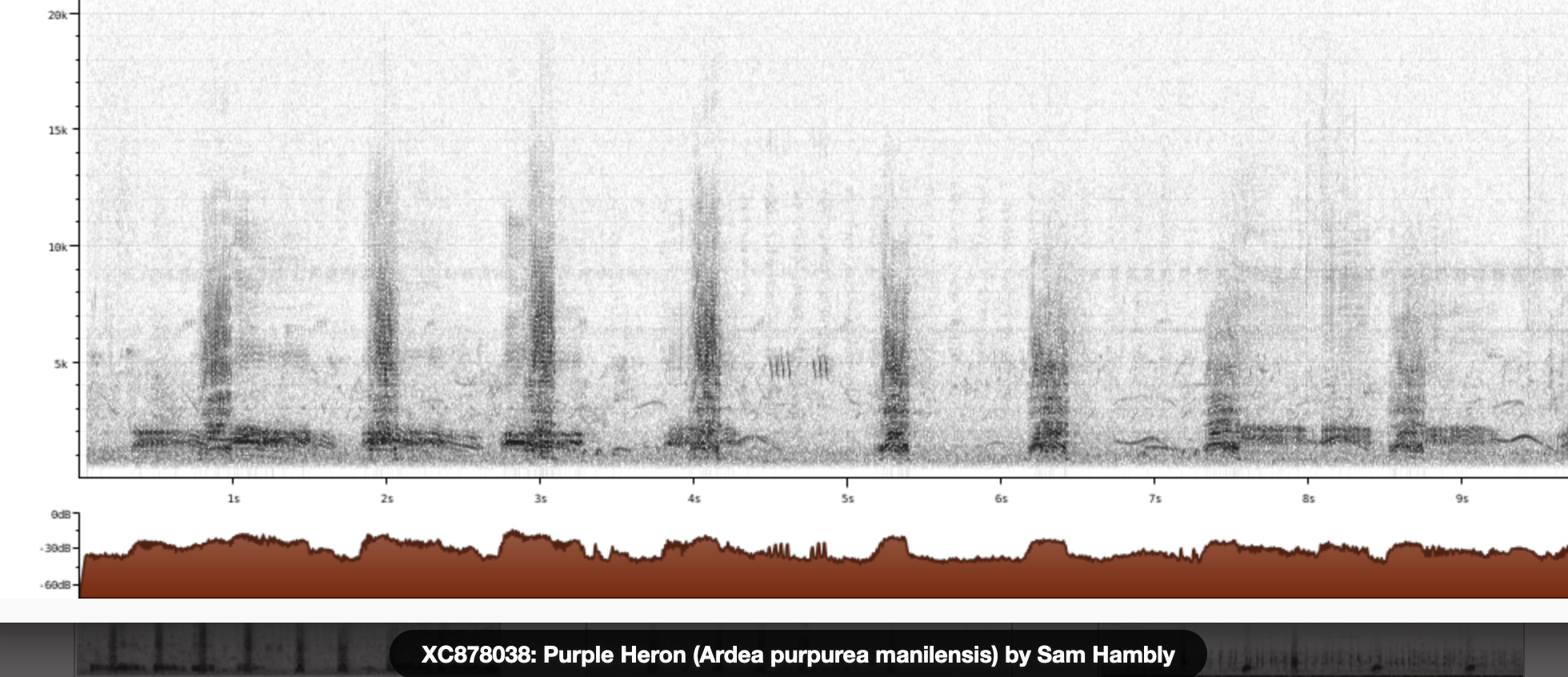
Call attributes:
flight call Frequency: ,
Black-crowned night-heron / Nachtreiher (Nycticorax nycticorax)

Wikipedia: Black-crowned night-heron Source: OTHER
1200px-BCNH_CMCNJ_for_Wiki.png
This bird appears across the great seas in the following continents:
Europe, North America, South America, Africa, Asia.
General: ![]() The black-crowned night heron (Nycticorax nycticorax), or black-capped night heron, commonly shortened to just night heron in Eurasia, is a medium-sized heron found throughout a large part of the world, except in the coldest regions and Australasia (where it is replaced by the closely related nankeen night heron, with which it has hybridized in the area of contact).
[more]
The black-crowned night heron (Nycticorax nycticorax), or black-capped night heron, commonly shortened to just night heron in Eurasia, is a medium-sized heron found throughout a large part of the world, except in the coldest regions and Australasia (where it is replaced by the closely related nankeen night heron, with which it has hybridized in the area of contact).
[more]
Calls: ![]() Most commonly hear call is a nasal, soft croaking "roack", like cross between Raven and frog. [Link]
Most commonly hear call is a nasal, soft croaking "roack", like cross between Raven and frog. [Link]
Physical details: length=58-65 cm,
wingspan=105-112 cm,
weight=500-800 g
Habitats:
Wetland
Little egret / Seidenreiher (Egretta garzetta)
Profile Wikipedia eBird Vogelwarte BirdLife ZH ornitho.ch Xeno-Canto BirdID NABU
Seidenreiher. 2022-02-05 11.42.26 Klingnauer Stausee (man-made lake)
First observed in 🇨🇭 on 2022-02-05.
General: ![]() The little egret (Egretta garzetta) is a species of small heron in the family Ardeidae. The genus name comes from the Provençal French Aigrette, "egret", a diminutive of Aigron," heron". The species epithet garzetta is from the Italian name for this bird, garzetta or sgarzetta.[2]
[more]
The little egret (Egretta garzetta) is a species of small heron in the family Ardeidae. The genus name comes from the Provençal French Aigrette, "egret", a diminutive of Aigron," heron". The species epithet garzetta is from the Italian name for this bird, garzetta or sgarzetta.[2]
[more]
Vocalization: ![]() Sometimes utters a dry, rasping "kerrr" when flushed, but is mostly silent away from breeding ground. In colonies a peculiar gurgling and vibrating sound is heard; "ghala-la-la-la". [Link]
Sometimes utters a dry, rasping "kerrr" when flushed, but is mostly silent away from breeding ground. In colonies a peculiar gurgling and vibrating sound is heard; "ghala-la-la-la". [Link]
Physical details: length=55-65 cm,
wingspan=88-95 cm,
weight=350-550 g
Habitats:
Wetland
Call:
Sort of a quack, brighter and higher than grey heron, with a bit of wawa.
Call attributes:
Call melody: non-musical, slow, Frequency: low (1-3 KHz),
Great bittern / Rohrdommel (Botaurus stellaris)
Rohrdommel - ausgestopft - von Silberweide Naturzentrum. 2021-10-30 13.24.28 Um Naturzentrum Silberweide am Greifensee
First observed in 🇨🇭 on 2021-10-30.
General: ![]() The Eurasian bittern or great bittern (Botaurus stellaris) is a wading bird in the bittern subfamily (Botaurinae) of the heron family Ardeidae. There are two subspecies, the northern race (B. s. stellaris) breeding in parts of Europe and across the Palearctic, as well as on the northern coast of Africa, while the southern race (B. s. capensis) is endemic to parts of southern Africa. It is a secretive bird, seldom seen in the open as it prefers to skulk in reed beds and thick vegetation near water bodies. Its presence is apparent in the spring, when the booming call of the male during the breeding season can be heard. It feeds on fish, small mammals, fledgling birds, amphibians, crustaceans and insects.
[more]
The Eurasian bittern or great bittern (Botaurus stellaris) is a wading bird in the bittern subfamily (Botaurinae) of the heron family Ardeidae. There are two subspecies, the northern race (B. s. stellaris) breeding in parts of Europe and across the Palearctic, as well as on the northern coast of Africa, while the southern race (B. s. capensis) is endemic to parts of southern Africa. It is a secretive bird, seldom seen in the open as it prefers to skulk in reed beds and thick vegetation near water bodies. Its presence is apparent in the spring, when the booming call of the male during the breeding season can be heard. It feeds on fish, small mammals, fledgling birds, amphibians, crustaceans and insects.
[more]
Song: ![]() Song unmistakable and far reaching (up to 5 km). Pitch very deep, with timbre similar to blowing on a big empty bottle. At close range an "inbreath" is also audible (1-3 dampened, higher pitched introductory notes). [Link]
Song unmistakable and far reaching (up to 5 km). Pitch very deep, with timbre similar to blowing on a big empty bottle. At close range an "inbreath" is also audible (1-3 dampened, higher pitched introductory notes). [Link]
Calls: ![]() Flight call a deep croaking "graat". [Link]
Flight call a deep croaking "graat". [Link]
Physical details: length=70-80 cm,
wingspan=125-135 cm,
weight=867-1940 g
Habitats:
Wetland
Call:
A little buzz/beep that sounds more like an appliance or app.
Call attributes:
Call melody: non-musical, slow, Frequency: low (1-3 KHz),
Cattle egret / Kuhreiher (Bubulcus ibis)
Cow-plus-cattle egret. 2020-03-07 15.17.34 Panama
First observed in Costa Rica on 2018-02-27.
This bird appears across the great seas in the following continents:
Europe, North America, South America, Africa, Asia.
General: ![]() The cattle egret (Bubulcus ibis) is a cosmopolitan species of heron (family Ardeidae) found in the tropics, subtropics, and warm-temperate zones. It is the only member of the monotypic genus Bubulcus, although some authorities regard two of its subspecies as full species, the western cattle egret and the eastern cattle egret. Despite the similarities in plumage to the egrets of the genus Egretta, it is more closely related to the herons of Ardea. Originally native to parts of Asia, Africa, and Europe, it has undergone a rapid expansion in its distribution and successfully colonised much of the rest of the world in the last century.
[more]
The cattle egret (Bubulcus ibis) is a cosmopolitan species of heron (family Ardeidae) found in the tropics, subtropics, and warm-temperate zones. It is the only member of the monotypic genus Bubulcus, although some authorities regard two of its subspecies as full species, the western cattle egret and the eastern cattle egret. Despite the similarities in plumage to the egrets of the genus Egretta, it is more closely related to the herons of Ardea. Originally native to parts of Asia, Africa, and Europe, it has undergone a rapid expansion in its distribution and successfully colonised much of the rest of the world in the last century.
[more]
Vocalization: ![]() Usually silent away from breeding ground. In the colonies a chorus of various coarse sounds can be heard. Most distinct is a disyllabic "rick-rack". Other sounds includes short, guttural utterings, or drawn, harsh shrieks. [Link]
Usually silent away from breeding ground. In the colonies a chorus of various coarse sounds can be heard. Most distinct is a disyllabic "rick-rack". Other sounds includes short, guttural utterings, or drawn, harsh shrieks. [Link]
Physical details: length=48-53 cm,
wingspan=90-96 cm,
weight=300-400 g
Call:
Automatically generated from Xeno-Canto recording
♫ XC353848 - Western Cattle Egret - Bubulcus ibis - flight call - sevilla, andalucía, Spain. Source: XENOCANTO
XC353848 - Western Cattle Egret - Bubulcus ibis - flight call - sevilla, andalucía, Spain.mp3
Spain (flight call)
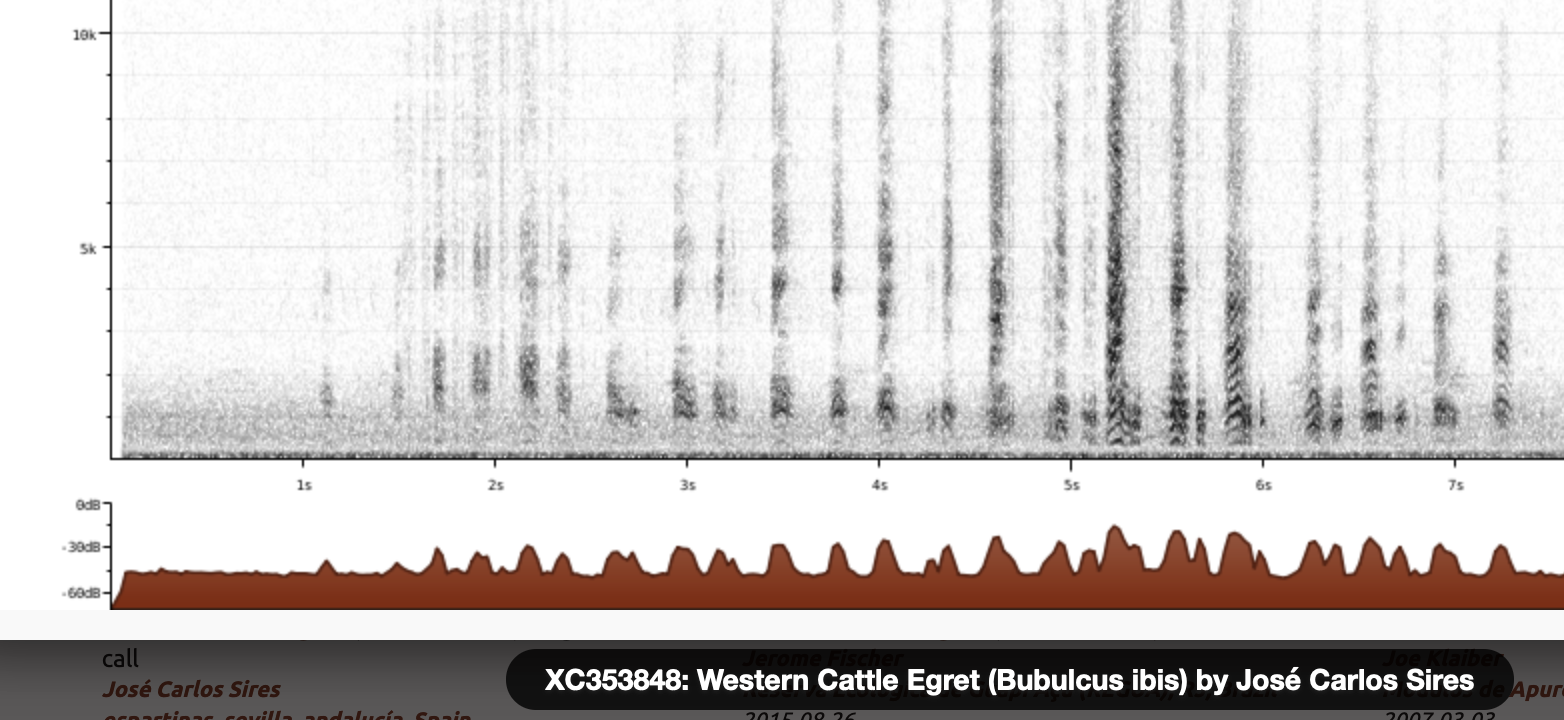
Call attributes:
flight call Frequency: ,
Little bittern / Zwergdommel (Ixobrychus minutus)
Profile Wikipedia eBird Vogelwarte BirdLife ZH ornitho.ch bird-song.ch Xeno-Canto BirdID NABU
Zwergdommel Weibchen (gestreift), Neeracherried. 2022-09-04 09.00.22 Neeracherried
First observed in 🇨🇭 on 2022-09-04.
General: ![]() The little bittern or common little bittern (Ixobrychus minutus) is a wading bird in the heron family, Ardeidae. Ixobrychus is from Ancient Greek ixias, a reed-like plant and brukhomai, to bellow, and minutus is Latin for "small".[2]
[more]
The little bittern or common little bittern (Ixobrychus minutus) is a wading bird in the heron family, Ardeidae. Ixobrychus is from Ancient Greek ixias, a reed-like plant and brukhomai, to bellow, and minutus is Latin for "small".[2]
[more]
Vocalization: ![]() Mostly silent except in breeding season. [Link]
Mostly silent except in breeding season. [Link]
Song: ![]() Song is a series of short, deep, frog-like "gorrk", repeated every 2 seconds. Tone is muffled and hollow, but far-carrying. [Link]
Song is a series of short, deep, frog-like "gorrk", repeated every 2 seconds. Tone is muffled and hollow, but far-carrying. [Link]
Calls: ![]() Flight-call a sharp "ki-ke-ke" or a nasal "ke". [Link]
Flight-call a sharp "ki-ke-ke" or a nasal "ke". [Link]
Physical details: length=33-38 cm,
wingspan=52-58 cm,
weight=140-150 g
Habitats:
Wetland
Call:
Almost a bark, low-pitched, little treble.
Call attributes:
Call melody: non-musical, slow, Frequency: low (1-3 KHz),
Squacco heron / Rallenreiher (Ardeola ralloides)
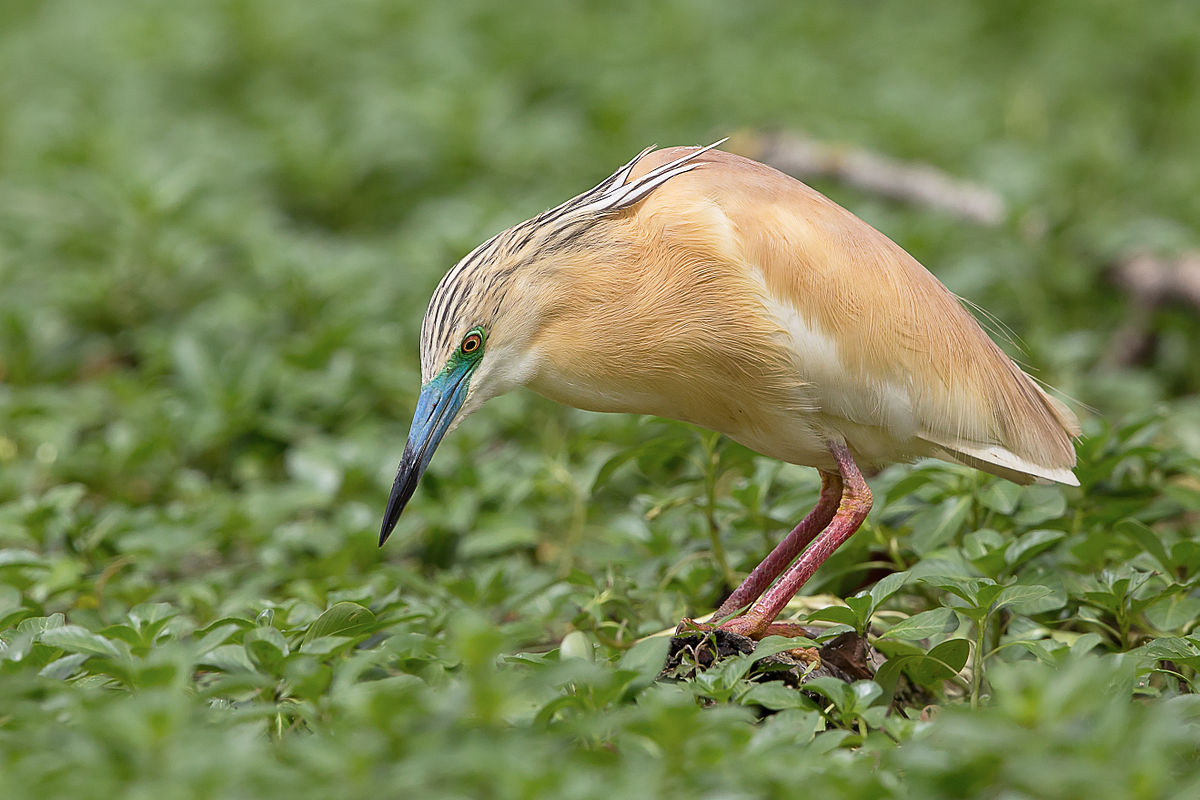
Wikipedia: Squacco heron Source: OTHER
1200px-Crabier_chevelu.jpg
General: ![]() The squacco heron (Ardeola ralloides) is a small heron, 44–47 cm (17–19 in) long, of which the body is 20–23 cm (7.9–9.1 in), with 80–92 cm (31–36 in) wingspan.[2] It is of Old World origins, breeding in southern Europe and the Greater Middle East.
[more]
The squacco heron (Ardeola ralloides) is a small heron, 44–47 cm (17–19 in) long, of which the body is 20–23 cm (7.9–9.1 in), with 80–92 cm (31–36 in) wingspan.[2] It is of Old World origins, breeding in southern Europe and the Greater Middle East.
[more]
Habitats:
Wetland
Eurasian spoonbill / Löffler (Platalea leucorodia)
Profile Wikipedia eBird Vogelwarte BirdLife ZH ornitho.ch Xeno-Canto BirdID NABU

Wikipedia: Eurasian spoonbill Source: OTHER
1200px-Eurasian_Spoonbill.jpg
Deutschland: Brut-, Zugvogel RL R
Vocalization: ![]() Mostly silent, and of little use for identification. Soft utterances can be heard when feeding, and when interacting at nest. [Link]
Mostly silent, and of little use for identification. Soft utterances can be heard when feeding, and when interacting at nest. [Link]
Physical details: length=80-90 cm,
wingspan=115-130 cm,
weight=1130-1960 g
Northern bald ibis / Waldrapp (Geronticus eremita)
Profile Wikipedia eBird Xeno-Canto

Wikipedia: Northern bald ibis Source: OTHER
1200px-Waldrapp_Geronticus_eremita.jpg
General: ![]() Die offizelle Website des europaeischen Waldrapp Auswilderungsproject ist . [Link]
Die offizelle Website des europaeischen Waldrapp Auswilderungsproject ist . [Link]
Where to find it: ![]() Dieser Vogel brütet zum ersten Mal seit 400 Jahren in der Schweiz. Auf einem Fenstersims im Industriegebiet Rümlang nistet seit Ende April ein Waldrapp-Paar. Vielleicht der Grundstein einer neuen Kolonie? [Tages Anzeiger Artikel, 16.06.2023]
Dieser Vogel brütet zum ersten Mal seit 400 Jahren in der Schweiz. Auf einem Fenstersims im Industriegebiet Rümlang nistet seit Ende April ein Waldrapp-Paar. Vielleicht der Grundstein einer neuen Kolonie? [Tages Anzeiger Artikel, 16.06.2023]
Vocalization: ![]() Mostly silent. [Link]
Mostly silent. [Link]
Calls: ![]() Vocal at breeding ground, where a range of guttural calls can be heard, "yarrp, yarrp" etc. [Link]
Vocal at breeding ground, where a range of guttural calls can be heard, "yarrp, yarrp" etc. [Link]
Physical details: length=70-80 cm,
wingspan=125-135 cm,
weight=1080-1230 g
Schwanzmeise am Pfäffikersee 2021-02-05 13.32.24 Pfäffikersee
First observed in 🇨🇭 on 2020-04-13.
Quite surprised to identify this bird at the Hungerseeli,
but have since realized they can be found here in the woods and in the reeds.
They're small birds that look bigger because they fluff up their feathers and have a very long tail,
which is just what I saw when I first sighted a pair June 3, 2020 at the Hungerseeli.
Appearance and identification: ![]() The subspecies europaeus occurs in Switzerland; it has a broad dark stripe over each eye,
whereas the nominate caudatus has a pure white head.
'The long-tailed tit was first classified as a true tit of the Parus group. Parus has since been split from the Aegithalidae.' [Link]
The subspecies europaeus occurs in Switzerland; it has a broad dark stripe over each eye,
whereas the nominate caudatus has a pure white head.
'The long-tailed tit was first classified as a true tit of the Parus group. Parus has since been split from the Aegithalidae.' [Link]
Song: high tsee-tsee; funny downhill trill
Habitats:
Forest
Song:
General: Meistens hoert man das Pfief...chk..chk..Pfief von den Rufen, siehe dort.
Song: Nabu: Der Gesang ist ein feines Trillern und selten zu hören (someone at XenoCanto compares it to a blue tit trill). [Link]
Song attributes:
Mnemnoic: Diddly doot-doot-doot-doot Melody: stereotype melodic, slow, Frequency: high (3-9 KHz)
♫ Source: XENOCANTO
XC572437 - Long-tailed Tit - Aegithalos caudatus - song.mp3
(song)

Call:
![]() Die fast ständig geäusserten, hohen Rufe verraten die kleinen, rastlosen Turner im Gezweig meist schon, bevor sie zu sehen sind. [Link]
Die fast ständig geäusserten, hohen Rufe verraten die kleinen, rastlosen Turner im Gezweig meist schon, bevor sie zu sehen sind. [Link]
Flight call from XenoCanto
♫ Flight call from XenoCanto Source: XENOCANTO
XC517804 Long-tailed tit flight call.mp3
(flight call)

Call attributes:
flight call Call melody: simple rhythmic, slow, Frequency: high (3-9 KHz),
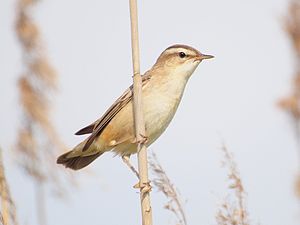
Plainish brown-white bird with black accents usually hidden in the reeds. Source: WIKIPEDIA
Wikipedia Schilfrohrsaenger.jpg
First observed in 🇨🇭 on 2020-05-20.
Bruetet hier nicht, darum eher selten, Durchzuegler.
Song: ![]() Gesang sehr ähnlich dem Teichrohrsänger. Aber nicht so im Takt. Bevorzugte Tongebilde werden mehrmals wiederholt. Des öftern Singflug über dem Schilf.
[Link]
Gesang sehr ähnlich dem Teichrohrsänger. Aber nicht so im Takt. Bevorzugte Tongebilde werden mehrmals wiederholt. Des öftern Singflug über dem Schilf.
[Link]
![]() Song vigorous and varied. [Link]
Song vigorous and varied. [Link]
Calls: ![]() Rufe:“zäck“, „zieck“, „err“.
[Link]
Rufe:“zäck“, „zieck“, „err“.
[Link]
![]() Alarm call a hard "check". Anxiety call a dry and rolling "rrrrr". A mixture of musical sounds, expert mimicry and characteristic harsh and strident calls. Not as rhythmic and evenly paced as Reed Warbler, but varies tempo a lot. [Link]
Alarm call a hard "check". Anxiety call a dry and rolling "rrrrr". A mixture of musical sounds, expert mimicry and characteristic harsh and strident calls. Not as rhythmic and evenly paced as Reed Warbler, but varies tempo a lot. [Link]
Physical details: length=13 cm,
wingspan=17-21 cm,
weight=9-15 g
Habitats:
Wetland
Song:
Constant stream of equally spaced sounds.
vogelwarte.ch has a sample that churrs and trills,
similar rhythm to reed warbler / Teichrohrsänger, so maybe that's what it was.
Listening on YouTube videos, you'd call it percussion rather than song!
Song attributes:
Melody: sings 30 seconds or longer, slow, Frequency: medium (1-5 KHz) Special sounds: mimicry
♫ Source: XENOCANTO
XC661577 - Sedge Warbler - Acrocephalus schoenobaenus - song.mp3
(song)

Call:
Automatically generated from Xeno-Canto recording
♫ Pfäffikersee schilfrohrsänger vielleicht. 2020-05-20 09.50.48 Pfäffikersee (song?)
Brown-white bird usually hidden in the reeds. 2022-05-21 10.39.42
First observed in 🇨🇭 on 2020-05-20.
Zuerst in Bolle Magadino gesehen und gehoert.
50% groesser als der ähnlich aussehende Teichrohrsänger
Behavior: ![]() In der Sonntagszeitung von 23. Mai 2021 wurde über neue Erkenntnisse zum Zug von Drosselrohrsängern geschrieben. Durch neue, leichte Messgeräte konnte man sehen, dass die Vögel in der Nacht auf 2 km Höhe fliegen, beim Sonnenaufgang über eine Stunde hoch bis 5.5 km fliegen. Da sie das Mittlemeer und die Saharawüste überfliegen, wo sie nicht landen können, fliegen sie bis 34 Stunden non-stop. Das Fliegen erzeugt viel Körperwärme und die Höhe hilft ihnen abzukühlen. [(Abo erforderlich)]
In der Sonntagszeitung von 23. Mai 2021 wurde über neue Erkenntnisse zum Zug von Drosselrohrsängern geschrieben. Durch neue, leichte Messgeräte konnte man sehen, dass die Vögel in der Nacht auf 2 km Höhe fliegen, beim Sonnenaufgang über eine Stunde hoch bis 5.5 km fliegen. Da sie das Mittlemeer und die Saharawüste überfliegen, wo sie nicht landen können, fliegen sie bis 34 Stunden non-stop. Das Fliegen erzeugt viel Körperwärme und die Höhe hilft ihnen abzukühlen. [(Abo erforderlich)]
Song: ![]() Gesang ähnlich Teichrohrsänger, aber viel lauter, Tonhöhenunterschiede 2-3 Oktaven. Karre-Kit-Sänger.. Sehr taktmässig.
[Link]
Gesang ähnlich Teichrohrsänger, aber viel lauter, Tonhöhenunterschiede 2-3 Oktaven. Karre-Kit-Sänger.. Sehr taktmässig.
[Link]
![]() Song similar to Reed Warbler in timbre, but much deeper and slower. [Link]
Song similar to Reed Warbler in timbre, but much deeper and slower. [Link]
Calls: ![]() Rufe:“kerr“ (tief), „ tek“
[Link]
Rufe:“kerr“ (tief), „ tek“
[Link]
![]() Contact call a grating, dry "kirrrat", where each rolling r is discernable. Fairly concise motifs typically consisting of two deep mono- or disyllabic notes followed by a few higher tones. I.e: "kerek kerek, trii trii trii". Clamorous Reed Warbler differs in more diffuse motifs. [Link]
Contact call a grating, dry "kirrrat", where each rolling r is discernable. Fairly concise motifs typically consisting of two deep mono- or disyllabic notes followed by a few higher tones. I.e: "kerek kerek, trii trii trii". Clamorous Reed Warbler differs in more diffuse motifs. [Link]
Physical details: length=19-20 cm,
wingspan=24-29 cm,
weight=29-36 g
Habitats:
Wetland
Song:
General: Sounds to me like croak cheep cheep!
Listening on YouTube videos, you'd call it percussion rather than song!
Song: ![]() In Vergleich zu Teichrohrsänger langsamer und lauter. [Link]
In Vergleich zu Teichrohrsänger langsamer und lauter. [Link]
Song attributes:
Melody: sings 30 seconds or longer, slow, Frequency: medium (1-5 KHz) Special sounds: rasp
♫ Source: XENOCANTO
XC661392 - Great Reed Warbler - Acrocephalus arundinaceus - song.mp3
(song)

Call:
Automatically generated from Xeno-Canto recording
♫ Drosselrohrsänger. 2020-05-20 09.42.29 Pfäffikersee (song?)
Teichrohrsaenger wahrscheinlich. 2021-05-04 09.21.14
First observed in 🇨🇭 on 2020-04-27.
2-5 repetitions of each sound. Is the tone a bit lower than the other reed warblers?
Song: ![]() Gleichmässiges Tempo! Man kann den Takt schlagen dazu.(Metronomsänger) Oft 2-3x wiederholte kurze Motive. Viele schnarrende Töne.
[Link]
Gleichmässiges Tempo! Man kann den Takt schlagen dazu.(Metronomsänger) Oft 2-3x wiederholte kurze Motive. Viele schnarrende Töne.
[Link]
![]() By far easiest to identify by song: Characteristic, almost metric and even rhythm, very different from Sedge Warbler. Squeaky timbre with many, almost bizarre, harmonics. Phrases generally repeated 2-3 times. [Link]
By far easiest to identify by song: Characteristic, almost metric and even rhythm, very different from Sedge Warbler. Squeaky timbre with many, almost bizarre, harmonics. Phrases generally repeated 2-3 times. [Link]
Calls: ![]() Rufe:“tsche, tschkt , schreeh, tschrä“,“err“
[Link]
Rufe:“tsche, tschkt , schreeh, tschrä“,“err“
[Link]
![]() Alarm call a harsh, dry and rolling "kraaaat". [Link]
Alarm call a harsh, dry and rolling "kraaaat". [Link]
Physical details: length=13 cm,
wingspan=17-21 cm,
weight=10-16 g
Habitats:
Wetland
Song:
Weird, squeaky, urgent. Slower than Sumpfrohrsaenger.
Song attributes:
Melody: sings 30 seconds or longer, fast, Frequency: medium (1-5 KHz) Special sounds: weird
♫ Source: XENOCANTO
XC653035 - Eurasian Reed Warbler - Acrocephalus scirpaceus - song.mp3
(song)

Call:
Automatically generated from Xeno-Canto recording
♫ Teichrohrsänger wahrscheinlich, siehe Foto. 2021-05-04 09.26.55 Flachsee am Reuss (song?)
Sumpfrohrsaenger wahrscheinlich. 2021-05-04 08.12.50 Flachsee am Reuss
First observed in 🇨🇭 on 2021-05-04.
Appearance and identification: Other: Sumpfis und Teichis im Feld optisch zu unterscheiden ist nicht ganz trivial, noch schwieriger auf Fotos. Am besten sind die beiden am Gesang auseinander zu dividieren.
Teichrohrsänger haben manchmal einen klaren Kontrast zw. Krallen und Bein. Wenn man die Viecher in der Hand hat, wirken Teichrohrsänger oft etwas rötlich [oft nicht klar auf Fotos]. Last but not least ist die Wahrscheinlichkeit einen Sumpfi zu sehen einfach höher. Gruß & GB Heinrich
[Link]
Song: ![]() Der Virtuose unter den Rohrsängern! Meisterhafter Imitator anderer Vogelstimmen. Viele wirbelnde und zwirlende Laute, wenig schnarrende. Variable Tempi.
[Link]
Der Virtuose unter den Rohrsängern! Meisterhafter Imitator anderer Vogelstimmen. Viele wirbelnde und zwirlende Laute, wenig schnarrende. Variable Tempi.
[Link]
![]() Song extremely varied and full of mimicry of both European and African species. Up to 75 species imitated by the same bird. Phrases often repeated 2-4 times, and different phrases may overlap. Nevertheless, clearly defined phrases with marked pauses. Sometimes more flowing streams of notes, but less so than Icterine Warbler. Most similar to Icterine and Blyth's Reed Warbler. Softer timbre than Icterine, and not so loud. [Link]
Song extremely varied and full of mimicry of both European and African species. Up to 75 species imitated by the same bird. Phrases often repeated 2-4 times, and different phrases may overlap. Nevertheless, clearly defined phrases with marked pauses. Sometimes more flowing streams of notes, but less so than Icterine Warbler. Most similar to Icterine and Blyth's Reed Warbler. Softer timbre than Icterine, and not so loud. [Link]
Calls: ![]() Sehr ähnlich der obigen Art [Teichrohrsänger].
[Link]
Sehr ähnlich der obigen Art [Teichrohrsänger].
[Link]
![]() More defined pauses and staccato tempo, and lacks Icterine Warbler's nasal high-pitched calls. Differs from Blyth's Reed Warbler in fewer repetitions of each phrase, and lack of said species' whistling, arpeggio-like calls. Typical sequence is a hoarse, drawn "ti-chaaa". Alarm call a short "chepp" with clipped ending. [Link]
More defined pauses and staccato tempo, and lacks Icterine Warbler's nasal high-pitched calls. Differs from Blyth's Reed Warbler in fewer repetitions of each phrase, and lack of said species' whistling, arpeggio-like calls. Typical sequence is a hoarse, drawn "ti-chaaa". Alarm call a short "chepp" with clipped ending. [Link]
Physical details: length=13 cm,
wingspan=18-21 cm,
weight=10-15 g
Habitats:
Wetland
Song:
Weird, squeaky, urgent, more variable than reed warbler, with imitations of European and African birds.
Song attributes:
Melody: sings 30 seconds or longer, fast, Frequency: medium (1-5 KHz) Special sounds: mimicry, weird
♫ Source: XENOCANTO
XC728884 - Marsh Warbler - Acrocephalus palustris - song.mp3
(song)

Call:
Automatically generated from Xeno-Canto recording
♫ Sumpfrohrsaenger, Kaltbrunnerriet. ![]() Source: Zoom H6 2022-06-04 12.04.18 Kaltbrunner-Riet (song?)
Source: Zoom H6 2022-06-04 12.04.18 Kaltbrunner-Riet (song?)
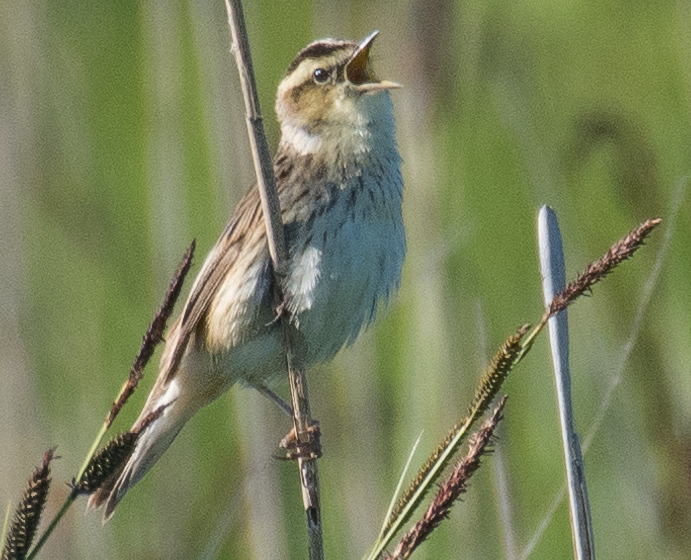
Wikipedia: Aquatic warbler Source: OTHER
Acrocephalus_paludicola_Bagno_Lawki.jpg
Deutschland: Brut-, seltener Zugvogel RL 1

Wikipedia: Icterine warbler Source: OTHER
1200px-Hippolais_icterina2.jpg
Looking for it in Kaltbrunnenriet - didn't find it in June 2022.
Etymology: ![]() Ihren Namen [Spötter] tragen sie, weil sie in ihren Gesang den anderer Vögel nachahmend aufnehmen („spotten“). [Link]
Ihren Namen [Spötter] tragen sie, weil sie in ihren Gesang den anderer Vögel nachahmend aufnehmen („spotten“). [Link]
Yellow belly, brown back, very similar to melodious warbler. Sometimes has the punky ruffled head feathers.
Appearance and identification: Ebird: Distinctive features include longish, daggerlike bill, long primary projection in the wings, and square tail. Told from similar Melodious Warbler by usually conspicuous pale wing panel, longer wings, and marginally shorter bill. Usually difficult to see when singing except during song flights, when long wings are apparent. Found in tall forest with oaks and birch, mixed forest, gardens, and parks. [Link]
Geography: ![]() Es gibt nur 100-150 Paare in der Schweiz, darum steht es auf der Rote Liste CH as stark gefährdet - und ist sicher schwierig zu finden. [Link]
Es gibt nur 100-150 Paare in der Schweiz, darum steht es auf der Rote Liste CH as stark gefährdet - und ist sicher schwierig zu finden. [Link]
Song: ![]() Sein lauter, lebhafter und variabler Gesang setzt sich aus flötenden, zwitschernden und nasalen Tönen sowie Imitationen anderer Vogelarten wie Drosseln, Meisen, Schwalben oder Pirol zusammen. [Scheint mir aus Segmente von ~2 Sekunden zu bestehen.] [Link]
Sein lauter, lebhafter und variabler Gesang setzt sich aus flötenden, zwitschernden und nasalen Tönen sowie Imitationen anderer Vogelarten wie Drosseln, Meisen, Schwalben oder Pirol zusammen. [Scheint mir aus Segmente von ~2 Sekunden zu bestehen.] [Link]
![]() Song very virtuous and varied. Most similar to Marsh Warbler, but timbre and attack harder and more powerful. Tempo varied with many pauses, but includes longer, and more flowing sequences than Marsh Warbler. Song frequently interrupted by characteristic, nasal, high-pitched squeaks unlike Marsh Warbler. Master of mimicry. Imitations are often repeated several times before changing to melodious motifs or more "noisy" phrases. [Link]
Song very virtuous and varied. Most similar to Marsh Warbler, but timbre and attack harder and more powerful. Tempo varied with many pauses, but includes longer, and more flowing sequences than Marsh Warbler. Song frequently interrupted by characteristic, nasal, high-pitched squeaks unlike Marsh Warbler. Master of mimicry. Imitations are often repeated several times before changing to melodious motifs or more "noisy" phrases. [Link]
Calls: ![]() Contact call distinct. A hard, trisyllabic "che-che-fink" , or "che-che-weet" with upward inflection. [Link]
Contact call distinct. A hard, trisyllabic "che-che-fink" , or "che-che-weet" with upward inflection. [Link]
Physical details: length=13 cm,
wingspan=20-24 cm,
weight=10-15 g
Habitats:
Agricultural
Song:
Short bits 4-8 notes, sometimes with a little pause, overall a greenfinch feel. Some whoops, some chucks like a great tit, some bits like a house sparrow, even a meow. BirdLife Schweiz says full of vigor, includes some mis-tones and creaky calls; eBird says Song is fast, loud, and melodious with lots of mimicry.Can sing low (2k) or high (10k)
Song attributes:
Melody: improvised melodic, fast, Frequency: 2-10 KHz Special sounds: mimicry
Profile Wikipedia eBird Vogelwarte BirdLife ZH ornitho.ch bird-song.ch Xeno-Canto NABU

Wikipedia: Melodious warbler Source: OTHER
1200px-Hippolais_polyglotta.jpg
First observed in 🇨🇭 on 2022-06-04.
Looking for it in Kaltbrunnenriet - didn't find it in June 2022.
Etymology: ![]() polyglotta is from Ancient Greek polus, "many", and glossa, "tongue" and means "harmonious". [Link]
polyglotta is from Ancient Greek polus, "many", and glossa, "tongue" and means "harmonious". [Link]
Yellow belly, brown back, very similar to Icterine warbler.
Appearance and identification: Ebird: Compared to Icterine Warbler, wings are shorter and lack the pale panel. [Link]
Habitats:
Agricultural
Song:
Repeats bits 6-9 times, makes pauses, but also sings like mad with a distorted chirpy voice. Sometimes sings a descending trill that could be a giveaway. Can sing low (2k) or fairly high (8k)
Song attributes:
Melody: improvised melodic, very fast, Frequency: 2-8 KHz Special sounds: trill
♫ Source: XENOCANTO
XC572815 - Melodious Warbler - Hippolais polyglotta - song recorded in the Netherlands .mp3
(song)
Call:
Automatically generated from Xeno-Canto recording
♫ Source: BirdNet
20220604_134205 birdnet - Orpheusspötter wrong - Uznach.mp3
2022-06-04 13.42.05 Uznach (song?)
This fellow is singing in a bush across the street from us, at Bahnhofstrasse 18 They seldom like to show themselves, so I was pleased to see him. 2020-04-15 09.20.34 Bahnhofstrasse 18
First observed in 🇨🇭 on 2019-08-30.
On a tree branch, but not usually on the treetop.
Etymology: ![]() Grayish bird with black cap (or brown in the case of females), for which reason the German
name refers to them as monks. [Link]
Grayish bird with black cap (or brown in the case of females), for which reason the German
name refers to them as monks. [Link]
Song: ![]() Mit schwätzendem Vorgesang, (kann auch kurz sein oder ganz fehlen) der dann in klare, kräftige, zum Ende hin in wehmütige Flötentöne übergeht (Überschlag)
[Link]
Mit schwätzendem Vorgesang, (kann auch kurz sein oder ganz fehlen) der dann in klare, kräftige, zum Ende hin in wehmütige Flötentöne übergeht (Überschlag)
[Link]
![]() Song pleasing, varied and loud. Sometimes very similar to Garden Warbler. A typical phrase starts with soft, staccato chattering and mimicry, which after a few seconds changes to a much louder, pure and resonant stream of notes for about 3-5 seconds. No fixed motif, but may end phrases with recurring notes. Often deviates from the characteristic type of song, and identification from song alone may be impossible. May sing first part of song for extended periods without ever reaching the characteristic ending. [Link]
Song pleasing, varied and loud. Sometimes very similar to Garden Warbler. A typical phrase starts with soft, staccato chattering and mimicry, which after a few seconds changes to a much louder, pure and resonant stream of notes for about 3-5 seconds. No fixed motif, but may end phrases with recurring notes. Often deviates from the characteristic type of song, and identification from song alone may be impossible. May sing first part of song for extended periods without ever reaching the characteristic ending. [Link]
Calls: ![]() „täck“ oft wiederholt
[Link]
„täck“ oft wiederholt
[Link]
![]() Alarm call a hard "check", similar to Lesser White-throat. Sometimes with an additional hoarse and nasal "cherrrr". [Link]
Alarm call a hard "check", similar to Lesser White-throat. Sometimes with an additional hoarse and nasal "cherrrr". [Link]
Physical details: length=13 cm,
wingspan=20-23 cm,
weight=16-25 g
Habitats:
Forest
Song:
They sometimes sing like a blackbird on speed - also non-stereotypic, seemingly improvised,
in short bursts.
Our local guy ends most of his songs with the same seven notes, which I find a good way to confirm the identification. In Ticino we often heard the 'Leiern' sound - the warblers would sing just the first 3 notes of a longer song, then stop. The order varied; high-medium-low I call 'Figaro' as in the opera, low-high-medium 'whiskey bar', as it sounded to me like the Kurt Weill lyrics, 'O-oh-show me-the-way to-the-next whis-ke-bar' - but the warbler usually stopped after 'way' or 'next' The British authors of The Sound Approach claim to hear 'a warblel and a whistle'.
Song attributes:
Melody: improvised melodic, fast, Frequency: 2-5 KHz Special sounds: mimicry Singing season: 03-01 - 07-31 Dawn chorus start, 45 minutes before dawn.
Call:
General: Sputtery/stoney, but may have other calls too.
Call: ![]() The Blackcap may generate a perplexing variety of territorial calls, though the typical contact call is a hard, tongue-clicking "teck teck" which has a scolding quality to it. It's not dissimilar to the 'pebble-clacking' call of the Stonechat. [Suffex Wildlife Trust]
The Blackcap may generate a perplexing variety of territorial calls, though the typical contact call is a hard, tongue-clicking "teck teck" which has a scolding quality to it. It's not dissimilar to the 'pebble-clacking' call of the Stonechat. [Suffex Wildlife Trust]
Call attributes:
Call melody: one note, slow, Frequency: high (3-9 KHz), Special sounds: sputter/pebble-clatter.
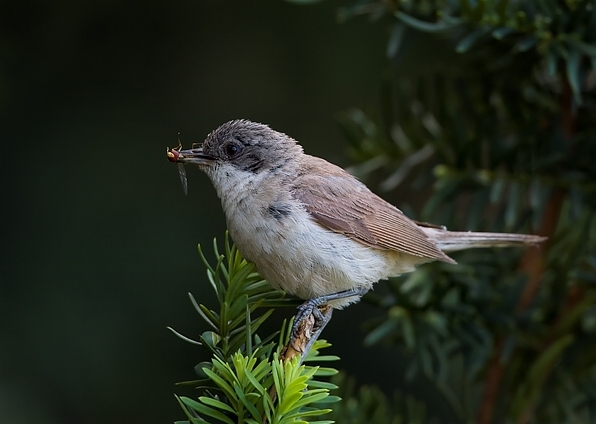
Wikipedia: Lesser whitethroat Source: OTHER
Sylvia_curruca_1_%28Martin_Mecnarowski%29.jpg
First observed in 🇨🇭 on 2023-05-27.
Wollte diese in Klettgau suchen 2023, bin darueber gestolpert bei Bad Vilbel, Deutschland.
Seasonal Behavior: ![]() Nach ihrer Ankunft im April oder Mai verrät sich diese rastlose und geschickt durch das Geäst hüpfende Grasmücke am ehesten durch ihren Gesang. Das eintönige Klappern ist weithin hörbar und hat ihr den deutschen Artnamen eingebracht. Das Männchen versucht, ein im Revier erscheinendes Weibchen durch Vorausfliegen zu einem Wahlnest zu locken. [Link]
Nach ihrer Ankunft im April oder Mai verrät sich diese rastlose und geschickt durch das Geäst hüpfende Grasmücke am ehesten durch ihren Gesang. Das eintönige Klappern ist weithin hörbar und hat ihr den deutschen Artnamen eingebracht. Das Männchen versucht, ein im Revier erscheinendes Weibchen durch Vorausfliegen zu einem Wahlnest zu locken. [Link]
Song: ![]() Klappernd. (Müllerchen) An Berglaubsänger erinnernd. Klappertöne (5-8) Aber oft mit leisem schwatzendem Vorgesang, der fehlen kann. Kann auch an Sumpfmeise erinnern, doch sind bei dieser die Klappertöne mehr von oben her angeschlagen.
[Link]
Klappernd. (Müllerchen) An Berglaubsänger erinnernd. Klappertöne (5-8) Aber oft mit leisem schwatzendem Vorgesang, der fehlen kann. Kann auch an Sumpfmeise erinnern, doch sind bei dieser die Klappertöne mehr von oben her angeschlagen.
[Link]
![]() Song typically consists of two parts. An indistinct chattering and warbling, subsong-like part similar to Whitethroat, which is usually followed by a dry, fast and rattling trill. The trill carries much further than the chattering part. May be difficult to identify if trill is omitted. [Link]
Song typically consists of two parts. An indistinct chattering and warbling, subsong-like part similar to Whitethroat, which is usually followed by a dry, fast and rattling trill. The trill carries much further than the chattering part. May be difficult to identify if trill is omitted. [Link]
Calls: ![]() „tze“ oder „tett“
[Link]
„tze“ oder „tett“
[Link]
![]() Warning call a hard "check" similar to Blackcap but slightly softer. [Link]
Warning call a hard "check" similar to Blackcap but slightly softer. [Link]
Physical details: length=12-13 cm,
wingspan=16-20 cm,
weight=10-14 g
Habitats:
Agricultural
Song:
![]() Song typically consists of two parts. An indistinct chattering and warbling, subsong-like part similar to [common] Whitethroat, which is usually followed by a dry, fast and rattling trill. The trill carries much further than the chattering part. May be difficult to identify if trill is omitted. [Link]
Song typically consists of two parts. An indistinct chattering and warbling, subsong-like part similar to [common] Whitethroat, which is usually followed by a dry, fast and rattling trill. The trill carries much further than the chattering part. May be difficult to identify if trill is omitted. [Link]
Song attributes:
Melody: simple rhythmic, slow, Frequency: 3-5 KHz Special sounds: trill
♫ Source: XENOCANTO
XC652419 - Lesser Whitethroat - Sylvia curruca - song.mp3
(song)

Call:
BirdID says: Warning call a hard "check" similar to Blackcap but slightly softer
♫ Source: OTHER
575779
(call)
Call attributes:
Call melody: one note, slow, Frequency: 2-7 KHz, Special sounds: sputter/pebble-clatter.

Wikipedia: Common whitethroat Source: OTHER
1200px-Common_Whitethroat.jpg
First observed in 🇨🇭 on 2023-07-16.
General: ![]() The common whitethroat (Curruca communis) is a common and widespread typical warbler which breeds throughout Europe and across much of temperate western Asia. This small passerine bird is strongly migratory, and winters in tropical Africa, Arabia, and Pakistan.
[more]
The common whitethroat (Curruca communis) is a common and widespread typical warbler which breeds throughout Europe and across much of temperate western Asia. This small passerine bird is strongly migratory, and winters in tropical Africa, Arabia, and Pakistan.
[more]
Vocalization: ![]() Variable. Usually recognized by fairly concise phrase, usually with three ascending and descending parts. [Link]
Variable. Usually recognized by fairly concise phrase, usually with three ascending and descending parts. [Link]
Song: ![]() Gesang kurz und rau (Kürzester Name).Oft im Singflug aber auch ab Warte. Wenn im Singflug dann Strophe etwas länger.
[Link]
Gesang kurz und rau (Kürzester Name).Oft im Singflug aber auch ab Warte. Wenn im Singflug dann Strophe etwas länger.
[Link]
![]() Often ends with more indistinct mimicry, or subsong. May omit characteristic phrase and sing more cryptic for periods of time, and may be more difficult to identify. [Link]
Often ends with more indistinct mimicry, or subsong. May omit characteristic phrase and sing more cryptic for periods of time, and may be more difficult to identify. [Link]
Calls: ![]() heiser, etwas nasal „wäd“ warnt m.“tschähr“.
[Link]
heiser, etwas nasal „wäd“ warnt m.“tschähr“.
[Link]
![]() Warning call a harsh, drawn "weeet", usually with accented ending, sometimes rising abruptly in pitch. [Link]
Warning call a harsh, drawn "weeet", usually with accented ending, sometimes rising abruptly in pitch. [Link]
Physical details: length=14 cm,
wingspan=18-23 cm,
weight=13-18 g
Habitats:
Agricultural
Song:
Song: ![]() Often ends with more indistinct mimicry, or subsong. May omit characteristic phrase and sing more cryptic for periods of time, and may be more difficult to identify. [Link]
Often ends with more indistinct mimicry, or subsong. May omit characteristic phrase and sing more cryptic for periods of time, and may be more difficult to identify. [Link]
![]() Relativ kurzer gesang, an Anfang fallend, dann entweder weiter oder steigend. 7-14 notes. [Link]
Relativ kurzer gesang, an Anfang fallend, dann entweder weiter oder steigend. 7-14 notes. [Link]
Song attributes:
Melody: simple rhythmic, fast, Frequency: 3-7 KHz Special sounds: mimicry
♫ Source: XENOCANTO
XC344648 - Common Whitethroat - Sylvia communis communis - song, recorded in Germany.mp3
Germany (song)
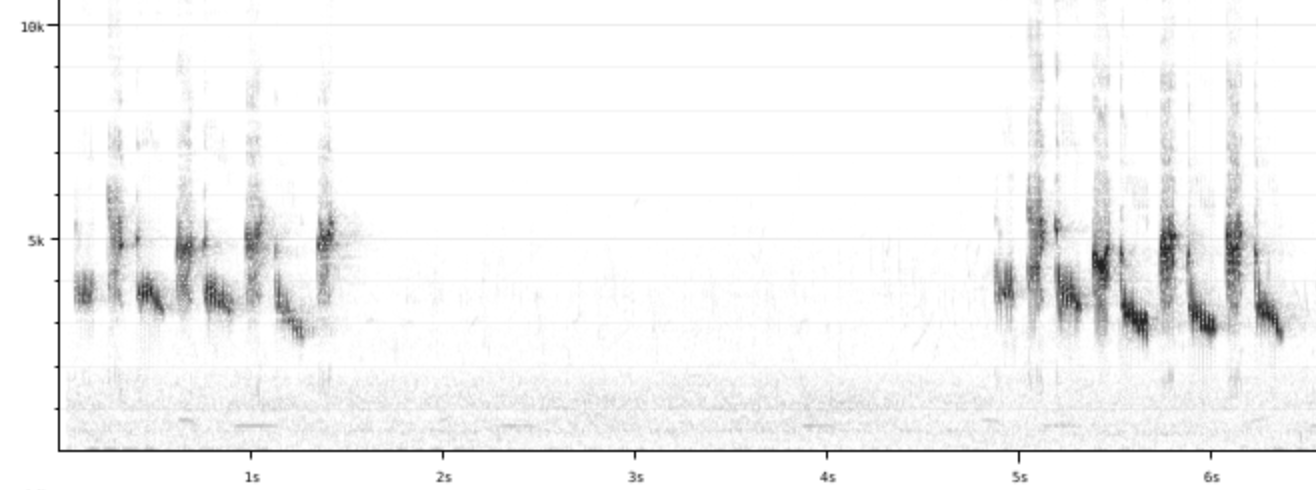
Call:
Automatically generated from Xeno-Canto recording
♫ Dorngrasmücke buzzy calls. 2023-07-16 10.03.00 Neunkirch, Schaffhausen (call)
Call attributes:
Frequency: ,
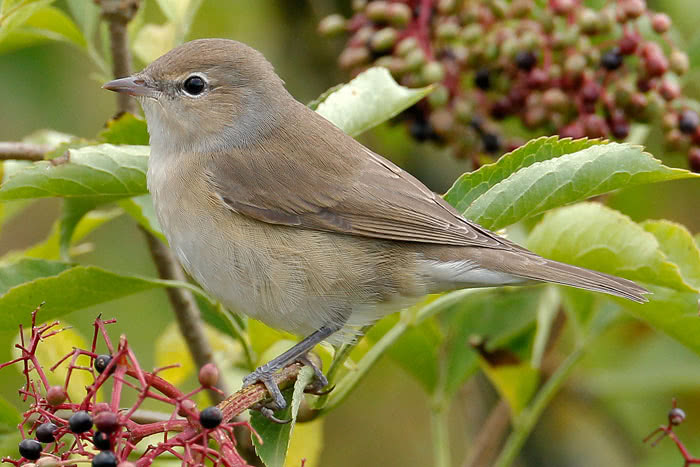
Vogelwarte Gartengrasmuecke. Source: VOGELWARTE
Vogelwarte Gartengrasmuecke.jpg
First observed in 🇨🇭 on 2020-04-27.
Nondescript, shy.
Hidden in the branches. Does change trees though.
Appearance and identification: Nabu: Das Hauptbestimmungsmerkmal dieser sehr unauffällig gefärbten Grasmücke ist,
dass sie kein besonderes Merkmal besitzt.
Im gegensatz zu ihrem Namen kommt die Gartengrasmücke
eher seltener in Gärten vor, häufiger ist sie in Hecken und grossen Büschen in waldrandlage anzutreffen, wo sie recht versteckt lebt. [Aus der NABU Android-App]
Song: ![]() Sprudelnd, orgelnd, die längsten Strophen aller hiesigen Grasmücken. Mit vielen reinen, volltönenden Tönen. Ohne Überschlag der Mönchsgrasmücke.
[Link]
Sprudelnd, orgelnd, die längsten Strophen aller hiesigen Grasmücken. Mit vielen reinen, volltönenden Tönen. Ohne Überschlag der Mönchsgrasmücke.
[Link]
![]() Song: a full bodied, flowing, melodious stream of notes, distinguished by its almost constant, warbled quality and lack of clear whistling notes (see Blackcap). Tempo is fairly even. Beware confusion possibility with occasional subsong of Blackcap that never reaches the whistling part! Call a nasal "che". [Link]
Song: a full bodied, flowing, melodious stream of notes, distinguished by its almost constant, warbled quality and lack of clear whistling notes (see Blackcap). Tempo is fairly even. Beware confusion possibility with occasional subsong of Blackcap that never reaches the whistling part! Call a nasal "che". [Link]
Calls: ![]() Alarm call a hard "check", and a hoarse "tcherr". [Link]
Alarm call a hard "check", and a hoarse "tcherr". [Link]
Physical details: length=14 cm,
wingspan=20-24 cm,
weight=16-22 g
Habitats:
Forest
Song:
Hard to distinguish from mönchsgrasmücke/black cap.
Song attributes:
Melody: improvised melodic, fast, Frequency: medium (1-5 KHz)
♫ Source: XENOCANTO
XC728379 - Garden Warbler - Sylvia borin - song.png
(song)
Call:
Automatically generated from Xeno-Canto recording
♫ Gartengrasmuecke, Kaltbrunnerriet. ![]() Source: Zoom H6 2022-06-04 11.13.02 Kaltbrunner-Riet (song?)
Source: Zoom H6 2022-06-04 11.13.02 Kaltbrunner-Riet (song?)
Presence: 04-15 - 10-05
Breeding: 04-30 - 08-10
Migration in: 04-15 - 05-30
Migration out: 08-01 - 10-05
Profile Wikipedia eBird Vogelwarte BirdLife ZH ornitho.ch Xeno-Canto BirdID NABU

Wikipedia: Barred warbler Source: OTHER
Sylvia_nisoria.jpg
Deutschland: Brut-, Zugvogel RL 3
Vocalization: ![]() Varied repertoire, but mostly silent when not breeding. Phrases usually quite short, with rapid alternations between sequences of squeaky, high-pitched sounds and warbling, fluty (often disyllabic) notes. This creates a slightly bouncing rhythm, different from Garden Warbler. [Link]
Varied repertoire, but mostly silent when not breeding. Phrases usually quite short, with rapid alternations between sequences of squeaky, high-pitched sounds and warbling, fluty (often disyllabic) notes. This creates a slightly bouncing rhythm, different from Garden Warbler. [Link]
Song: ![]() Song varies among individuals and location, but is generally quite similar to Garden Warbler. Often contains mimicry of Red-backed Shrike, and other species. Sometimes includes contact call in song, which makes ID easier. [Link]
Song varies among individuals and location, but is generally quite similar to Garden Warbler. Often contains mimicry of Red-backed Shrike, and other species. Sometimes includes contact call in song, which makes ID easier. [Link]
Calls: ![]() Contact call a rolling, dry "trrrrrrrrr-r-r-t, often with ritardando ending, of 1-2 seconds length. Also a Blackcap-like "check". [Link]
Contact call a rolling, dry "trrrrrrrrr-r-r-t, often with ritardando ending, of 1-2 seconds length. Also a Blackcap-like "check". [Link]
Physical details: length=15 cm,
wingspan=23-27 cm,
weight=22-28 g
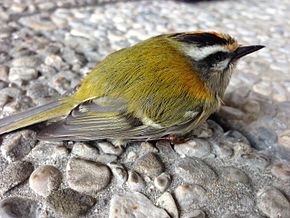
Wikipedia Sommergoldhaehnchen (Regulus ignicapilla) weiblich. Source: WIKIPEDIA
Wikipedia Sommergoldhaehnchen_(Regulus_ignicapilla) weiblich.jpg
First observed in 🇨🇭 on 2021-07-28.
General: ![]() The common firecrest (Regulus ignicapilla), also known as the firecrest, is a very small passerine bird in the kinglet family. It breeds in most of temperate Europe and northwestern Africa, and is partially migratory, with birds from central Europe wintering to the south and west of their breeding range. Firecrests in the Balearic Islands and north Africa are widely recognised as a separate subspecies, but the population on Madeira, previously also treated as a subspecies, is now treated as a distinct species, the Madeira firecrest, Regulus madeirensis. A fossil ancestor of the firecrest has been identified from a single wing bone.
[more]
The common firecrest (Regulus ignicapilla), also known as the firecrest, is a very small passerine bird in the kinglet family. It breeds in most of temperate Europe and northwestern Africa, and is partially migratory, with birds from central Europe wintering to the south and west of their breeding range. Firecrests in the Balearic Islands and north Africa are widely recognised as a separate subspecies, but the population on Madeira, previously also treated as a subspecies, is now treated as a distinct species, the Madeira firecrest, Regulus madeirensis. A fossil ancestor of the firecrest has been identified from a single wing bone.
[more]
Vocalization: ![]() A slow crescendo of short "tze" sounds in a phrase rising slightly in pitch, without the repeated arpeggiated movements of goldcrest. [Link]
A slow crescendo of short "tze" sounds in a phrase rising slightly in pitch, without the repeated arpeggiated movements of goldcrest. [Link]
Song: ![]() Wie [beim Wintergoldhähnchen] aber auf gleicher Tonhöhe bleibend. [Link]
Wie [beim Wintergoldhähnchen] aber auf gleicher Tonhöhe bleibend. [Link]
![]() Song: Similar in timbre to Goldcrest, but much more monotonous. [Link]
Song: Similar in timbre to Goldcrest, but much more monotonous. [Link]
Calls: ![]() „sisisi“ [Link]
„sisisi“ [Link]
![]() Call: a thin "tsi tsi tsi" similar to Goldcrest, but not so sharp. [Link]
Call: a thin "tsi tsi tsi" similar to Goldcrest, but not so sharp. [Link]
Physical details: length=9 cm,
wingspan=13-16 cm,
weight=4-6 g
Habitats:
Forest
Song:
Very high rhythmic repetition of about 3 seconds
Song attributes:
Melody: simple rhythmic, fast, Frequency: 6-8 KHz
Profile Wikipedia eBird Vogelwarte BirdLife ZH ornitho.ch bird-song.ch Xeno-Canto BirdID NABU
Wintergoldhähnchen beim Meteorwasserkanal am Pfäffikersee. Endlich habe ich einen bei uns gesehen! 2020-10-30 16.44.10 Pfäffikersee
First observed in 🇨🇭 on 2020-07-13.
I'd often heard the high-pitched song and call in the woods by Fehraltorf
but had doubts I'd ever see one (they're the smallest bird in Switzerland,
fairly shy, and I seemed to only hear them in very tall trees).
I didn't see one until hiking at the Pragelpass.
And finally in October 2020, I saw them near Rumlikon and at the
Pfaeffikersee, where I took the new profile picture.
In December I saw give of them cruise through the bushes beside our house,
hopping from branch to branch, snapping up insects - something I'd never have
believe in spring 2020.
Song: ![]() Kurze Reihe von sehr hohen, leisen Tönen in auf-absteigender Tonhöhe, an das „W“-im Namen erinnernd. [Link]
Kurze Reihe von sehr hohen, leisen Tönen in auf-absteigender Tonhöhe, an das „W“-im Namen erinnernd. [Link]
![]() Song: a very high-pitched, undulating series of arpeggiated notes moving down and up again, repeated 4-5 times ending with a marked "conclusion" (like "trying to start a tiny motor and failing"). Timbre of song similar to contact call. [Link]
Song: a very high-pitched, undulating series of arpeggiated notes moving down and up again, repeated 4-5 times ending with a marked "conclusion" (like "trying to start a tiny motor and failing"). Timbre of song similar to contact call. [Link]
Calls: ![]() 'sisisi' [Link]
'sisisi' [Link]
![]() Contact call a very high pitched "zit zit zit", only similar to Firecrest and treecreepers. Treecreepers usually calls with longer "zzzziiiiit" repeated at regular intervals, while Goldcrest calls in phrases with two to four calls in series in an uneven rhythm. Firecrest contact calls lower pitched than Goldcrest, and in a softer tone (but quite similar). [Link]
Contact call a very high pitched "zit zit zit", only similar to Firecrest and treecreepers. Treecreepers usually calls with longer "zzzziiiiit" repeated at regular intervals, while Goldcrest calls in phrases with two to four calls in series in an uneven rhythm. Firecrest contact calls lower pitched than Goldcrest, and in a softer tone (but quite similar). [Link]
Physical details: length=9 cm,
wingspan=13-15 cm,
weight=4-7 g
Habitats:
Forest
Song:
![]() Vogelwarte.ch says high-pitched song that gently rises and falls. This song starts out with a repeated note. [Link]
Vogelwarte.ch says high-pitched song that gently rises and falls. This song starts out with a repeated note. [Link]
Song attributes:
Melody: stereotype melodic, slow, Frequency: 6-8 KHz
Call:
Automatically generated from Xeno-Canto recording
♫ Source: BirdNet
20201022_154807 birdnet 1036 almost certain Oberreitenbachholzweg - Goldcrest - Fehraltorf.mp3
2020-10-22 15.48.07 Fehraltorf (song?)
Profile Wikipedia eBird Vogelwarte BirdLife ZH ornitho.ch bird-song.ch Xeno-Canto BirdID NABU

Wikipedia: Bearded reedling Source: OTHER
1200px-Panurus_biarmicus_-Oare_Marshes%2C_Kent%2C_England_-male-8_%283%29.jpg
General: ![]() The bearded reedling (Panurus biarmicus) is a small, sexually dimorphic reed-bed passerine bird. It is frequently known as the bearded tit, due to some similarities to the long-tailed tit, or the bearded parrotbill. It is the only species in the family Panuridae.
[more]
The bearded reedling (Panurus biarmicus) is a small, sexually dimorphic reed-bed passerine bird. It is frequently known as the bearded tit, due to some similarities to the long-tailed tit, or the bearded parrotbill. It is the only species in the family Panuridae.
[more]
Vocalization: ![]() More often heard than seen. [Link]
More often heard than seen. [Link]
Song: ![]() Song a primitive, 3-syllable phrase, consisting of contact call-like sounds. [Link]
Song a primitive, 3-syllable phrase, consisting of contact call-like sounds. [Link]
Calls: ![]() Usually identified by contact call; a ringing, explosive "tschin" with a characteristic "dirty" timbre. Also a hard and very short "pit", often mixed with the previous. [Link]
Usually identified by contact call; a ringing, explosive "tschin" with a characteristic "dirty" timbre. Also a hard and very short "pit", often mixed with the previous. [Link]
Physical details: length=12 cm,
wingspan=16-18 cm,
weight=12-18 g
Habitats:
Wetland
Call:
Chirping
♫ Source: XENOCANTO
XC765306 - Bearded Reedling - Panurus biarmicus - two types of calls, one-note and two-note.mp3
(song)

Call attributes:
Melody: simple rhythmic, fast, Frequency: 3-7 KHz
Profile Wikipedia eBird A-Z Animals Vogelwarte BirdLife ZH ornitho.ch bird-song.ch Audubon AllAboutBirds Xeno-Canto BirdID NABU
Barn swallow. 2022-05-05 09.41.44 Maryland
First observed in 🇨🇭 on 2020-04-16.
This bird appears across the great seas in the following continents:
Europe, North America, South America, Africa, Asia.
Die langen Schwanzfedern vom Rauchschwalbe und anderen geben auch dem Schmetterling Schwalbenschwanz seine deutschen Namen.
Etymology: ![]() In früheren Jahrhunderten flogen sie vielfach durch die Öffnungen im Giebel ein und aus, durch die auch der Rauch des Herdfeuers abzog. So erhielten sie den Namen Rauchschwalben. [Link]
In früheren Jahrhunderten flogen sie vielfach durch die Öffnungen im Giebel ein und aus, durch die auch der Rauch des Herdfeuers abzog. So erhielten sie den Namen Rauchschwalben. [Link]
Appearance and identification: ![]() Rauchschwalbes Bauch ist etwas braun rot, nicht weiss wie der von der Mehlschwalbe - was wahrscheinlich Quelle der zwei Namen ist. [Link]
Rauchschwalbes Bauch ist etwas braun rot, nicht weiss wie der von der Mehlschwalbe - was wahrscheinlich Quelle der zwei Namen ist. [Link]
Song: ![]() Characteristic calls and song. Song a sparkling, squeaky energetic improvisation with interspersed contact calls, often with diagnostic ending; an electric and drawn-out "su-eerrrrrrrrrrrrrrr". [Link]
Characteristic calls and song. Song a sparkling, squeaky energetic improvisation with interspersed contact calls, often with diagnostic ending; an electric and drawn-out "su-eerrrrrrrrrrrrrrr". [Link]
Calls: ![]() Contact call a short and sharp "weet" or "kee-weet". [Link]
Contact call a short and sharp "weet" or "kee-weet". [Link]
Physical details: length=17-19 cm,
wingspan=32-34 cm,
weight=16-22 g
Habitats:
Settlement
Looks similar to:
Common house martin.
Song:
General: Squeaky with occasional buzzes, usually heard in flock.
Song: ![]() Kann melodisch sein wenn einzeln gehört statt viele zusammen. [Link]
Kann melodisch sein wenn einzeln gehört statt viele zusammen. [Link]
Song attributes:
Melody: stereotype melodic, fast, Frequency: 2-6 KHz
Call:
Automatically generated from Xeno-Canto recording
♫ Barn swallows on the hunt, some quite high. 2020-08-18 13.01.00 Luppmen (song?)

Wikipedia: Red-rumped swallow Source: OTHER
Red-rumped_Swallow_%28Cecropis_daurica%29_Photograph_by_Shantanu_Kuveskar.jpg
General: ![]() The red-rumped swallow (Cecropis daurica) is a small passerine bird in the swallow family. It breeds in open hilly country of temperate southern Europe and Asia from Portugal and Spain to Japan, India, Sri Lanka and tropical Africa. The Indian and African birds are resident, but European and other Asian birds are migratory. They winter in Africa or India and are vagrants to Christmas Island and northern Australia.
[more]
The red-rumped swallow (Cecropis daurica) is a small passerine bird in the swallow family. It breeds in open hilly country of temperate southern Europe and Asia from Portugal and Spain to Japan, India, Sri Lanka and tropical Africa. The Indian and African birds are resident, but European and other Asian birds are migratory. They winter in Africa or India and are vagrants to Christmas Island and northern Australia.
[more]
Bank swallow. 2024-01-26 15.58.58 Thailand
First observed in Thailand on 2024-01-26.
This bird appears across the great seas in the following continents:
Europe, North America, South America, Africa, Asia.
![]() The sand martin (Riparia riparia) or European sand martin, bank swallow, and collared sand martin in India, is a migratory passerine bird in the swallow family. It has a wide range in summer, embracing practically the whole of Europe and the Mediterranean countries and across the Palearctic to the Pacific Ocean. It is a Holarctic species also found in North America. It winters in eastern and southern Africa, South America, and the Indian Subcontinent.
[more]
The sand martin (Riparia riparia) or European sand martin, bank swallow, and collared sand martin in India, is a migratory passerine bird in the swallow family. It has a wide range in summer, embracing practically the whole of Europe and the Mediterranean countries and across the Palearctic to the Pacific Ocean. It is a Holarctic species also found in North America. It winters in eastern and southern Africa, South America, and the Indian Subcontinent.
[more]
Song: ![]() Song a primitive improvisation on the contact call. [Link]
Song a primitive improvisation on the contact call. [Link]
Calls: ![]() Contact call a mono- or disyllabic "trrrrt". Similar to House Martin but more raucous and less crisp, with less rolling r's, and with stable pitch throughout. Alarm call similar to House Martin; a sharp plaintive "tseep", but somewhat purer and more drawn. [Link]
Contact call a mono- or disyllabic "trrrrt". Similar to House Martin but more raucous and less crisp, with less rolling r's, and with stable pitch throughout. Alarm call similar to House Martin; a sharp plaintive "tseep", but somewhat purer and more drawn. [Link]
Physical details: length=12 cm,
wingspan=26-29 cm,
weight=11-16 g
Habitats:
Wetland
Song:
Fast raspy one-noter.
Song attributes:
Melody: non-musical, fast, Frequency: 1-7 KHz Special sounds: rasp
♫ Source: XENOCANTO
XC344092 - Sand Martin - Riparia riparia - raspy song but note, does not sing often.mp3
(song)


Wikipedia: Eurasian crag-martin Source: OTHER
Ptyonoprogne_rupestris_-Europe-8.jpg
Europe
Deutschland: Brut-, Zugvogel RL R
Vocalization: ![]() Most heard is a House Martin-like, but less rolling, "prit" or "check". Other contact sounds include a plaintive "peeuuu". [Link]
Most heard is a House Martin-like, but less rolling, "prit" or "check". Other contact sounds include a plaintive "peeuuu". [Link]
Song: ![]() Song an inconspicuous, staccato series of twittering notes, with a wagtail-like timbre. [Link]
Song an inconspicuous, staccato series of twittering notes, with a wagtail-like timbre. [Link]
Physical details: length=14 cm,
wingspan=32-34 cm,
weight=17-30 g
Habitats:
Mountain
Mehlschwalben in Maienfeld. 2021-05-29 08.11.14 Maienfeld
First observed in 🇨🇭 on 2020-08-10.
This one is a swallow in German but a martin in English.
Song: ![]() Song a merry improvisation of chirping, contact call-like sounds (sometimes recalling a budgerigar). [Link]
Song a merry improvisation of chirping, contact call-like sounds (sometimes recalling a budgerigar). [Link]
Calls: ![]() Contact call a rolling "krreet". Similar to Sand Martin but noticeably dryer, more rolling and less raucous. Typically varies the pitch of the call more. Warning call a sharp and plaintive "tsreee". [Link]
Contact call a rolling "krreet". Similar to Sand Martin but noticeably dryer, more rolling and less raucous. Typically varies the pitch of the call more. Warning call a sharp and plaintive "tsreee". [Link]
Physical details: length=12 cm,
wingspan=26-29 cm,
weight=15-23 g
Habitats:
Settlement
Looks similar to:
Barn swallow.
Song:
Song: ![]() Mehlschwalbe klingt weniger melodisch als der Rauchschwalbe [Link]
Mehlschwalbe klingt weniger melodisch als der Rauchschwalbe [Link]
![]() Merry improv of chirping, contact call [Link]
Merry improv of chirping, contact call [Link]
Song attributes:
Melody: stereotype melodic, fast, Frequency: 2-7 KHz
♫ Source: XENOCANTO
XC730813 - Common House Martin - Delichon urbicum - song and call according to recordist Fernando Aranguren Jiménez, recorded in Spain.mp3
Spain (song)

Call:
Automatically generated from Xeno-Canto recording
♫ Source: BirdNet
20200810_144528 birdnet 864 flight call - Common house martin.mp3
2020-08-10 14.45.28 Luppmen (flight call)
Call attributes:
flight call Frequency: ,
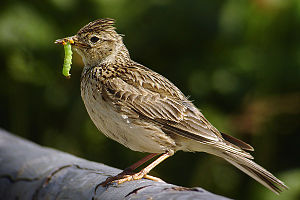
Wikipedia Eurasian Skylark (Alauda arvensis). Source: WIKIPEDIA
Wikipedia Eurasian Skylark (Alauda_arvensis).jpg
First observed in 🇨🇭 on 2022-06-25.
This bird appears across the great seas in the following continents:
Europe, North America (introduced), Africa.
Good to know: ![]() Aus dem Kurzjahresbericht BirdLife Schweiz 2022: Die Feldlerche, vogel der Jahres 2022..., ist eihne dieser bredrohten Arten, welche durch die Industrialisierung der Landwirtschaft ausgerottet wird. [Link]
Aus dem Kurzjahresbericht BirdLife Schweiz 2022: Die Feldlerche, vogel der Jahres 2022..., ist eihne dieser bredrohten Arten, welche durch die Industrialisierung der Landwirtschaft ausgerottet wird. [Link]
Appearance and identification: ![]() Somewhat like a house sparrow but 18-19 cm long, not 14-15, kleiner als Star. Ruffled head feathers. NABU says streaks on breast contrast with white belly. [Link]
Somewhat like a house sparrow but 18-19 cm long, not 14-15, kleiner als Star. Ruffled head feathers. NABU says streaks on breast contrast with white belly. [Link]
Geography: ![]() Introduced population in North America is gradually declining. [Link]
Introduced population in North America is gradually declining. [Link]
Stark gefährdet durch Verlust von geeignetem Lebensraum. Eine Massnahme ist die Erstellung von Lerchenfenstern auf den Feldern - eine kleine Fläche mitten im Feld, die nicht bepflanzt oder gemäht wird. So was sieht man bei uns, z.B. zwischen Freudwil und Gutenswil, wobei ich nicht genau weiss, ob Feldlerchen das Ziel davon sind. Die Infos habe ich vom FOK Kurs 2021-2022 von Christina Ebneter.
Song: ![]() Song a pleasing energetic stream of chirping, merry trills, interspersed with mimicry. Trills quite resonant with fairly full tone. Song usually given in flight high in the air. Less characteristic, shorter, weaker and more varied song when given from ground. [Link]
Song a pleasing energetic stream of chirping, merry trills, interspersed with mimicry. Trills quite resonant with fairly full tone. Song usually given in flight high in the air. Less characteristic, shorter, weaker and more varied song when given from ground. [Link]
Calls: ![]() Most typical flight call a short trilling "chirrup", with the end note noticeably lower pitched than the start. Also several other more cryptic calls. [Link]
Most typical flight call a short trilling "chirrup", with the end note noticeably lower pitched than the start. Also several other more cryptic calls. [Link]
Physical details: length=18-19 cm,
wingspan=30-36 cm,
weight=26-50 g
Habitats:
Agricultural
Song:
Fast chirpy improvization without a break, not very high, reminds me of a nightingale or a Eurasian reed warbler/Teichrohrsänger with the exact rhythm, but most likely sung in a cornfield. Or a Singdrossel that repeats its elements longer that that guy. Repeats elements 1-8 times. Sometimes buzzy/trilly. Can go on for minutes at a time. Ich habe es auch mit einem Amsel verwechselt, da er lang und melodisch, fast wie Amsel aber hört nicht auf.
Song attributes:
Melody: sings 30 seconds or longer, slow, Frequency: 2-6 KHz Special sounds: mimicry
♫ Source: XENOCANTO
XC685846 - Eurasian Skylark - Alauda arvensis - song, recorded in France.mp3
(song)

Call:
Automatically generated from Xeno-Canto recording
♫ Source: BirdNet
20220625_082224 birdnet - Feldlerche im Maisfeld bei La Sauge - birdnet_mobile_5867288364_recording_3659.mp3
2022-06-25 08.22.24 La Sauge (song?)

Wikipedia: Greater short-toed lark Source: OTHER
Greater_short-toed_lark_%28Calandrella_brachydactyla%29_Photograph_by_Shantanu_Kuveskar.jpg
General: ![]() The greater short-toed lark (Calandrella brachydactyla) is a small passerine bird. The current scientific name is from Ancient Greek. The genus name, Calandrella, is a diminutive of kalandros, the calandra lark, and brachydactila is from brakhus, "short", and daktulos, "toe".[2]
[more]
The greater short-toed lark (Calandrella brachydactyla) is a small passerine bird. The current scientific name is from Ancient Greek. The genus name, Calandrella, is a diminutive of kalandros, the calandra lark, and brachydactila is from brakhus, "short", and daktulos, "toe".[2]
[more]
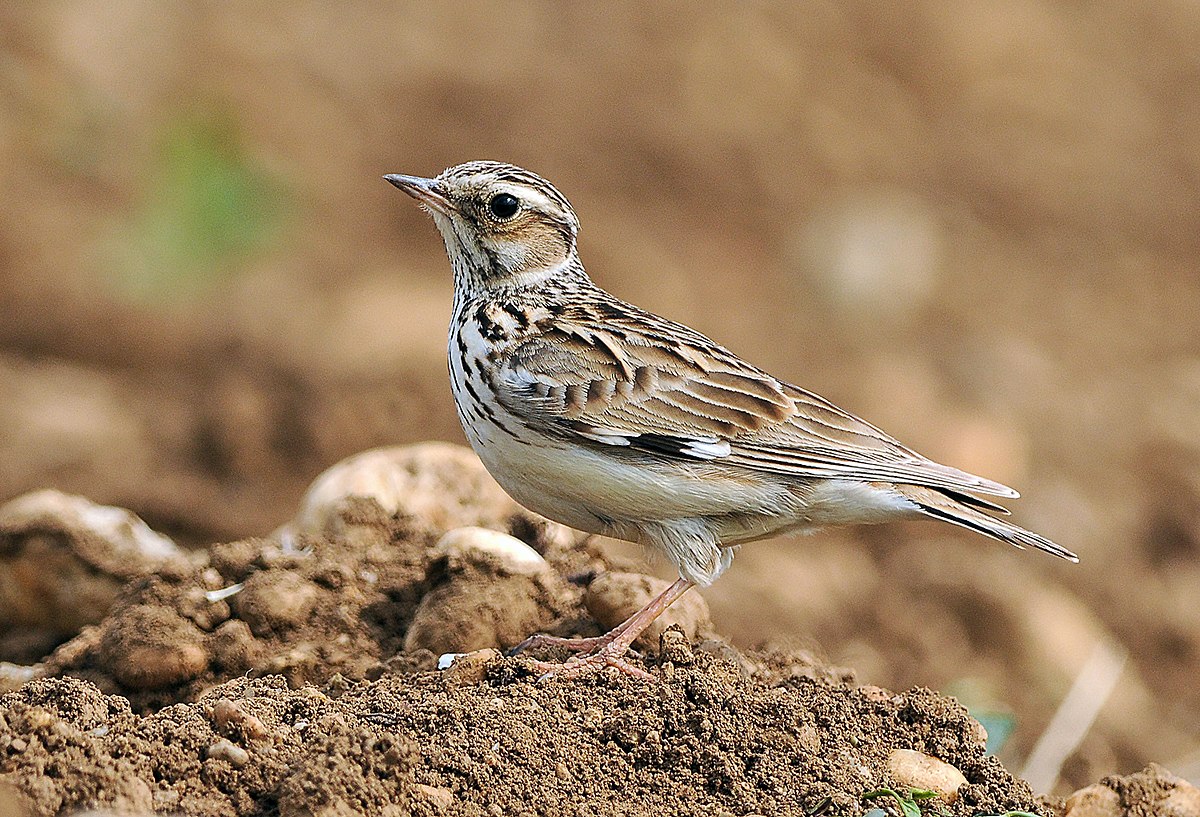
Wikipedia: Wood lark Source: OTHER
1200px-Lullula_arborea_%28J%C3%A1n_Svetl%C3%ADk%29.jpg
Appearance and identification: ![]() Sieht aus wie ein braun-weisser Drossel mit heller Überaugenstreife/Maske. [Link]
Sieht aus wie ein braun-weisser Drossel mit heller Überaugenstreife/Maske. [Link]
Song: ![]() Song: Distinct and quite slow for a lark. Consists mainly of varied, disyllabic elements, or single syllables repeated in descending, accelerated phrases. Starting soft and hesitantly, then gaining in strength and speed. [Link]
Song: Distinct and quite slow for a lark. Consists mainly of varied, disyllabic elements, or single syllables repeated in descending, accelerated phrases. Starting soft and hesitantly, then gaining in strength and speed. [Link]
Physical details: length=15 cm,
wingspan=27-30 cm,
weight=25-35 g
Habitats:
Agricultural
Song:
General: Slow for a lark? Fast to me.
Song: ![]() Fallend dadui dadui. Or figaro figaro - picture Heidi in an opera. Wenig Variation. [Link]
Fallend dadui dadui. Or figaro figaro - picture Heidi in an opera. Wenig Variation. [Link]
![]() Der flötende Gesang der Heidelerche gehört zu den schönsten der Vogelwelt und ist tagsüber wie auch nachts zu hören. [Link]
Der flötende Gesang der Heidelerche gehört zu den schönsten der Vogelwelt und ist tagsüber wie auch nachts zu hören. [Link]
Song attributes:
Melody: two notes, fast, Frequency: 3-5 KHz
♫ Source: XENOCANTO
XC769994 - Woodlark - Lullula arborea - 2-note song recorded in the Netherlands.mp3
(song)

Call:
Automatically generated from Xeno-Canto recording
♫ XC741579 - Woodlark - Lullula arborea - four note call recorded in Sweden. Source: XENOCANTO
XC741579 - Woodlark - Lullula arborea - four note call recorded in Sweden.mp3
(call)

Call attributes:
Frequency: ,
In our back yard in Fehraltorf 2020-10-03 12.44.50 Luppmen
First observed in 🇨🇭 on 2019-06-04.
In the survey of 2008, there was only 1 Chiffchaff in Fehraltorf for every 7 blackbirds, and it was ranked 19th in the village.
Yet in summer 2020 I heard them in nearly every recording I make, whether at home by the brook (Luppmen) or in the woods.
I presume their population has exploded in the last 10 years.
I see them in middle branches, but not in particularly exposed places.
Song: ![]() [Translated from German:] From the middle of August till the end of September the chiffchaff offers regular autumn song. [Link]
[Translated from German:] From the middle of August till the end of September the chiffchaff offers regular autumn song. [Link]
![]() Lange Reihen (6-20) von „zilp-zalp“-Rufen, meist abwechselnd in Tonhöhe. (Als bemühe sich der Sänger vergeblich den ersten Ton wieder zu treffen , ohne jedoch weit zu verfehlen.) „Zins zahl, Zins zahl, zahl Zins, Zins Zins zahl“ („Zins“ etwas höher als „zahl“) [Link]
Lange Reihen (6-20) von „zilp-zalp“-Rufen, meist abwechselnd in Tonhöhe. (Als bemühe sich der Sänger vergeblich den ersten Ton wieder zu treffen , ohne jedoch weit zu verfehlen.) „Zins zahl, Zins zahl, zahl Zins, Zins Zins zahl“ („Zins“ etwas höher als „zahl“) [Link]
![]() Song a very distinct: "chiff-chaff-chiff-chiff-chaff-chiff", in a regular clock-like rhythm. Each syllable at seemingly random pitch, but no large intervals tonally. Sometimes "get stuck" at one note. [Link]
Song a very distinct: "chiff-chaff-chiff-chiff-chaff-chiff", in a regular clock-like rhythm. Each syllable at seemingly random pitch, but no large intervals tonally. Sometimes "get stuck" at one note. [Link]
Calls: ![]() Rufe :einsilbiges „hüid“, hinaufgezogen, wandelbar. [Link]
Rufe :einsilbiges „hüid“, hinaufgezogen, wandelbar. [Link]
![]() Contact/alarm call a soft, plaintive ascending "hooeet". Similar to W.Warbler, but shorter with a monosyllabic feel. [Link]
Contact/alarm call a soft, plaintive ascending "hooeet". Similar to W.Warbler, but shorter with a monosyllabic feel. [Link]
Physical details: length=10-11 cm,
wingspan=15-21 cm,
weight=6-10 g
Habitats:
Forest
Song:
Seems to consist of 3 notes repeated randomly, occasionally just 2 notes.
Though NABU.de says they stop singing at the end of July, I do hear their 3-note song occasionally in October,
but just one or two repetitions.
Song attributes:
Melody: simple rhythmic, slow, Frequency: high (3-9 KHz) Singing season: 03-01 - 07-31 Dawn chorus start, 35 minutes before dawn.
Call:
Repeated rising note, not too loud
♫ Source: XENOCANTO
XC656913 - Common Chiffchaff - Phylloscopus collybita - call recorded in Belgium.mp3
(contact call)

Call attributes:
Call melody: one note, slow, Frequency: 2-4 KHz, Special sounds: whoop.
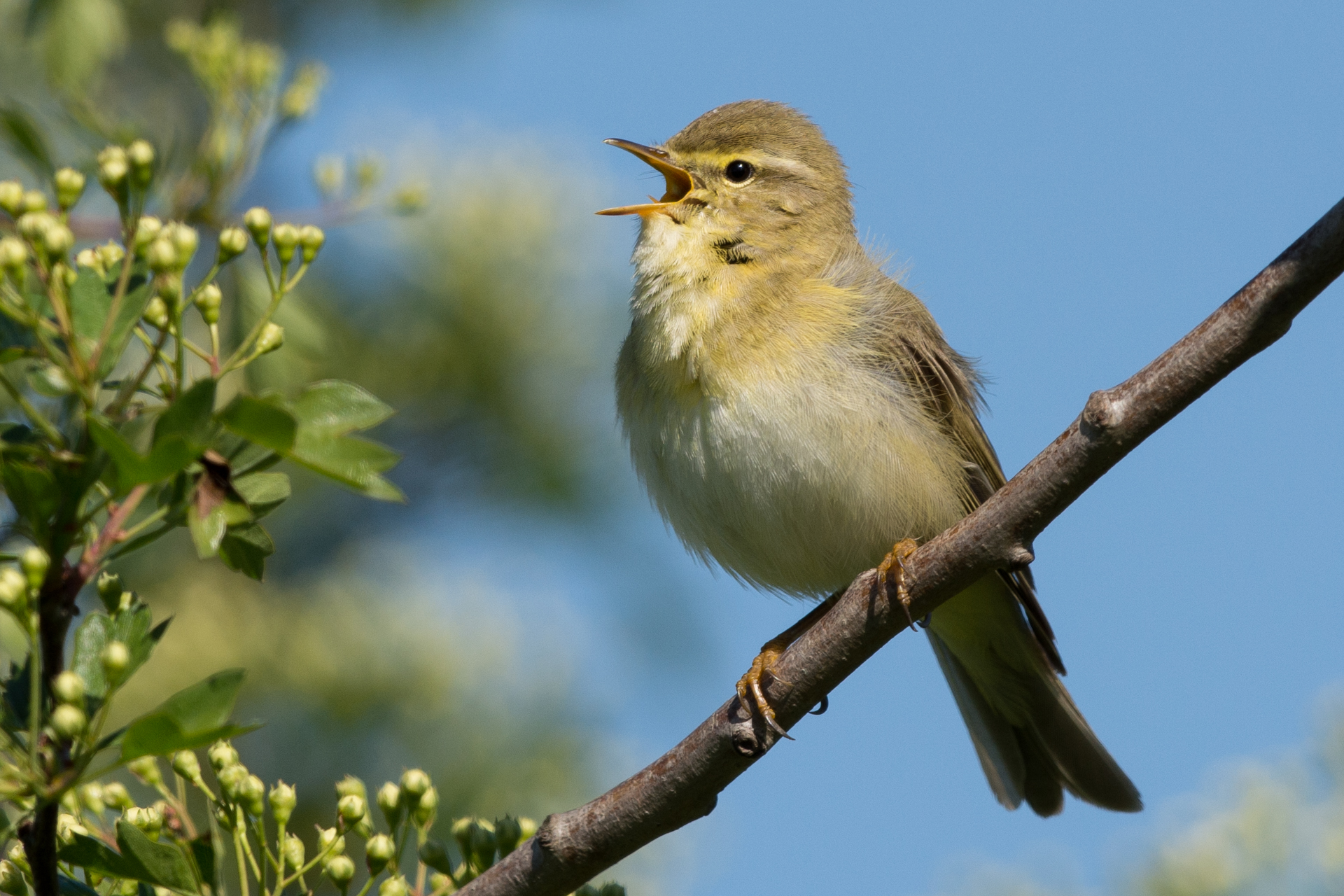
WikiCommons Fitis 13901013023. Source: WIKIPEDIA
WikiCommons Fitis 13901013023.jpg
First observed in 🇨🇭 on 2020-04-24.
General: ![]() The willow warbler (Phylloscopus trochilus) is a very common and widespread leaf warbler which breeds throughout northern and temperate Europe and the Palearctic, from Ireland east to the Anadyr River basin in eastern Siberia. It is strongly migratory, with almost all of the population wintering in Sub-Saharan Africa.[2][3]
[more]
The willow warbler (Phylloscopus trochilus) is a very common and widespread leaf warbler which breeds throughout northern and temperate Europe and the Palearctic, from Ireland east to the Anadyr River basin in eastern Siberia. It is strongly migratory, with almost all of the population wintering in Sub-Saharan Africa.[2][3]
[more]
Song: ![]() Reihe v. Pfeiflauten (ca 12) etwas abfallend. Klingt ähnlich Buchfink, aber etwas traurig, melancholisch, wie in moll-Tonart. [Link]
Reihe v. Pfeiflauten (ca 12) etwas abfallend. Klingt ähnlich Buchfink, aber etwas traurig, melancholisch, wie in moll-Tonart. [Link]
![]() By far most easily identified by it's call or song. Song: A 3-5 second, falling phrase of soft, rippling "svi-svi" sounds, starting high with some attack, and then falling in a mellow manner. The phrase lacks any conclusion, and diminishes both in strength and tempo. [Link]
By far most easily identified by it's call or song. Song: A 3-5 second, falling phrase of soft, rippling "svi-svi" sounds, starting high with some attack, and then falling in a mellow manner. The phrase lacks any conclusion, and diminishes both in strength and tempo. [Link]
Calls: ![]() ähnlich oben, aber mehr zweisilbig [Link]
ähnlich oben, aber mehr zweisilbig [Link]
![]() Contact/alarm call a soft, plaintive ascending "hoo-eet". Similar to Chiff-chaff, but first part more drawn, giving it a disyllabic feel. [Link]
Contact/alarm call a soft, plaintive ascending "hoo-eet". Similar to Chiff-chaff, but first part more drawn, giving it a disyllabic feel. [Link]
Physical details: length=10-11 cm,
wingspan=16-22 cm,
weight=7-12 g
Habitats:
Forest
Song:
Song similar to common chaffinch but higher, faster, tendency to descend but with more ups and downs.
Song attributes:
Mnemnoic: Buchfink diva Melody: stereotype melodic, fast, Frequency: high (3-9 KHz) Singing season: 04-01 - 06-30 Dawn chorus start, 22 minutes before dawn.
Call:
Whoop very similar to chiffchaff, etc. but starts at an even level, then ascends.
Call recorded in UK, sounds typical to me, and spiced up by a yellowhammer in the background and several other birds
♫ Call recorded in UK, sounds typical to me, and spiced up by a yellowhammer in the background and several other birds Source: XENOCANTO
XC444002 - Willow Warbler - Phylloscopus trochilus trochilus - call in UK, with yellowhammer in background.mp3
(call)

Call attributes:
contact call Call melody: simple rhythmic, slow, Frequency: 2-4 KHz, Special sounds: whoop.
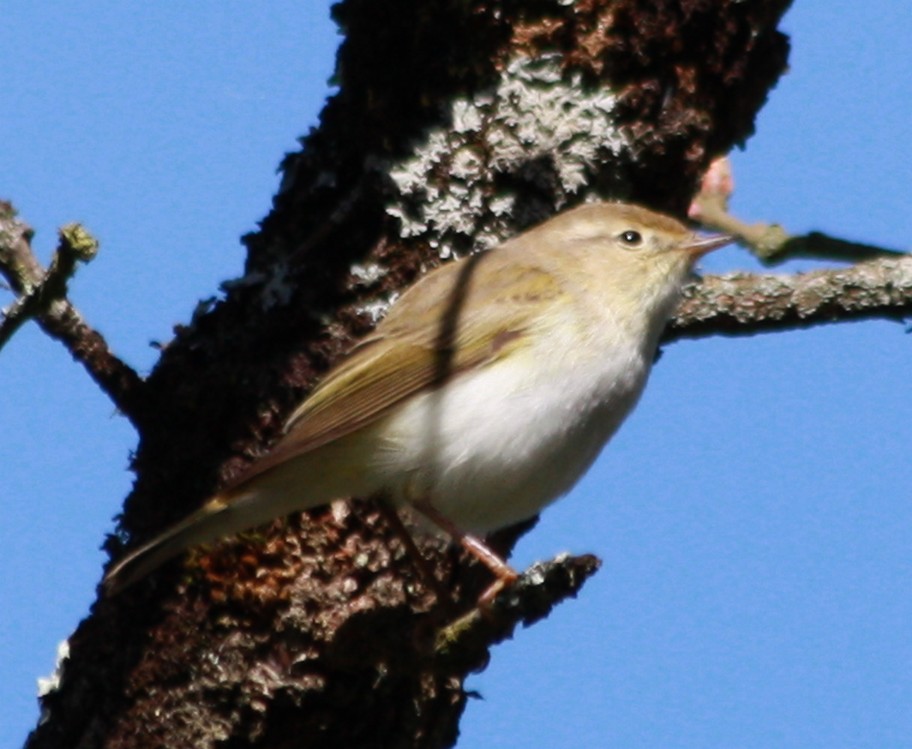
Wikipedia Berglaubsaenger Phylloscopus bonelli. From Sébastien Bertru - https://www.flickr.com/photos/aigledayres/5911604938/, CC BY-SA 2.0, Link Source: WIKIPEDIA
Wikipedia Berglaubsaenger Phylloscopus_bonelli.jpg
First observed in 🇨🇭 on 2020-06-08.
Roman von Sury likes them, but notes that their habitat is increasingly disappearing in Switzerland.
Song: ![]() Reihe(5-10) von gleichhohen Schlägen, ähnlich dem Schwirren der obigen Art [Waldlaubsänger], aber langsamer, einzelne Töne deutlich getrennt, etwas scheppernd. Kann mit Klappergrasmücke verwechselt werden) [Link]
Reihe(5-10) von gleichhohen Schlägen, ähnlich dem Schwirren der obigen Art [Waldlaubsänger], aber langsamer, einzelne Töne deutlich getrennt, etwas scheppernd. Kann mit Klappergrasmücke verwechselt werden) [Link]
Habitats:
Forest
Song:
Single note repeated 6 or 8 times quickly in half a second
Song attributes:
Melody: one note, fast, Frequency: 3-7 KHz
♫ Source: XENOCANTO
XC720128 - Western Bonelli's Warbler - Phylloscopus bonelli - song, recorded in France.mp3
(song)

Call:
Automatically generated from Xeno-Canto recording
♫ Source: BirdNet
20200608_163439 birdnet 585 - Western Bonelli's warbler.mp3
2020-06-08 16.34.39 Sils (song?)
Profile Wikipedia eBird Vogelwarte BirdLife ZH ornitho.ch bird-song.ch Xeno-Canto BirdID NABU
Wahrscheinlich Waldlaubsänger. 2022-05-22 09.52.22 Leuk and surroundings
First observed in 🇨🇭 on 2022-05-22.
General: ![]() The wood warbler (Phylloscopus sibilatrix) is a common and widespread leaf warbler which breeds throughout northern and temperate Europe, and just into the extreme west of Asian Russia in the southern Ural Mountains.
[more]
The wood warbler (Phylloscopus sibilatrix) is a common and widespread leaf warbler which breeds throughout northern and temperate Europe, and just into the extreme west of Asian Russia in the southern Ural Mountains.
[more]
Song: ![]() kurze Reihe (4-10) v. Stakkatotönen, gefolgt von abfallendem Schwirrroller. (Tönt wie das Anlassen eines Velosolex) Während des Gesanges schwebender Schwirrflug. Dazu hört man eine Reihe angenehmer Pfeiflaute wie „djü“ [Link]
kurze Reihe (4-10) v. Stakkatotönen, gefolgt von abfallendem Schwirrroller. (Tönt wie das Anlassen eines Velosolex) Während des Gesanges schwebender Schwirrflug. Dazu hört man eine Reihe angenehmer Pfeiflaute wie „djü“ [Link]
![]() Song distinct. An accelerating series of sharp, metallic "swee-swee-swee-swee". Alternative (piping) song a series of 4-6 piping, plaintive and descending "pew - pew" calls. Resembles Willow Tit's song, but is softer with each note more evenly pitched. Contact call similar to individual syllables of piping song, but with heavier accent on the ending. [Link]
Song distinct. An accelerating series of sharp, metallic "swee-swee-swee-swee". Alternative (piping) song a series of 4-6 piping, plaintive and descending "pew - pew" calls. Resembles Willow Tit's song, but is softer with each note more evenly pitched. Contact call similar to individual syllables of piping song, but with heavier accent on the ending. [Link]
Calls: ![]() „düü“ [Link]
„düü“ [Link]
![]() Typically with a staccato beginning. Pitch drops as the speed increases and the syllables fuses into a continuous trill. Often described as the sound of a spinning coin coming to rest on a glass table. Some phrases may be given in an almost even tempo, and may recall Bonelli's Warbler. [Link]
Typically with a staccato beginning. Pitch drops as the speed increases and the syllables fuses into a continuous trill. Often described as the sound of a spinning coin coming to rest on a glass table. Some phrases may be given in an almost even tempo, and may recall Bonelli's Warbler. [Link]
Physical details: length=12 cm,
wingspan=19-24 cm,
weight=8-12 g
Habitats:
Forest
Song:
Sid-sid-sid-sirrrr. 3 secs, then 5 secs pause. At bird-song.ch I hear a slow-fast one-noter, about 8 slow ones in 1.5 seconds, then a trill of 25 fast ones.
Song attributes:
Melody: simple rhythmic, fast, Frequency: 5-8 KHz Special sounds: trill
♫ Source: XENOCANTO
XC727564 - Wood Warbler - Phylloscopus sibilatrix - song.mp3
(song)
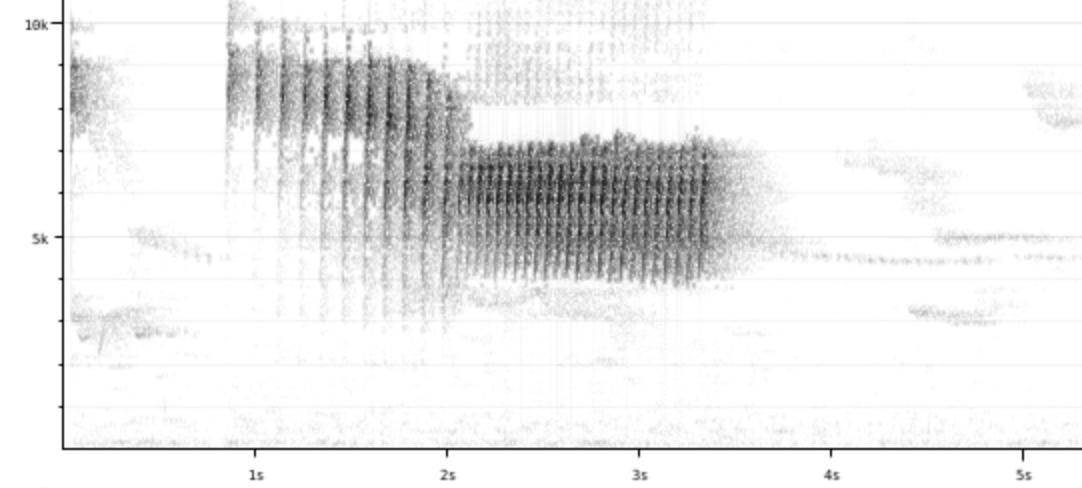
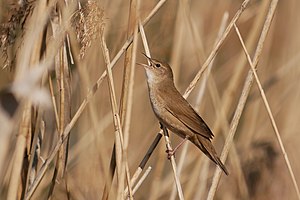
Wikipedia - Rohrschwirl Chiemgau. Source: WIKIPEDIA
Wikipedia - Rohrschwirl_Chiemgau.jpg
First observed in 🇨🇭 on 2022-06-04.
General: ![]() Savi's warbler (Locustella luscinioides) is a species of Old World warbler in the grass warbler genus Locustella. It breeds in Europe and the western Palearctic. It is migratory, wintering in northern and sub-Saharan Africa.
[more]
Savi's warbler (Locustella luscinioides) is a species of Old World warbler in the grass warbler genus Locustella. It breeds in Europe and the western Palearctic. It is migratory, wintering in northern and sub-Saharan Africa.
[more]
Song: ![]() Gesang ähnlich obiger Art [Feldschwirl]. Tiefere Tonlage, höhere Frequenz. Strophen meist kürzer
[Link]
Gesang ähnlich obiger Art [Feldschwirl]. Tiefere Tonlage, höhere Frequenz. Strophen meist kürzer
[Link]
Habitats:
Wetland
Song or calls similar to:
Common grasshopper warbler, Nightjar.
Song:
Endless buzzing like an insect or machinery. Lower tone than Feldschwirl.
Song attributes:
Melody: simple rhythmic, fast, Frequency: 3-5 KHz
♫ Source: XENOCANTO
XC710242 - Savi's Warbler - Locustella luscinioides - song.mp3
(song)
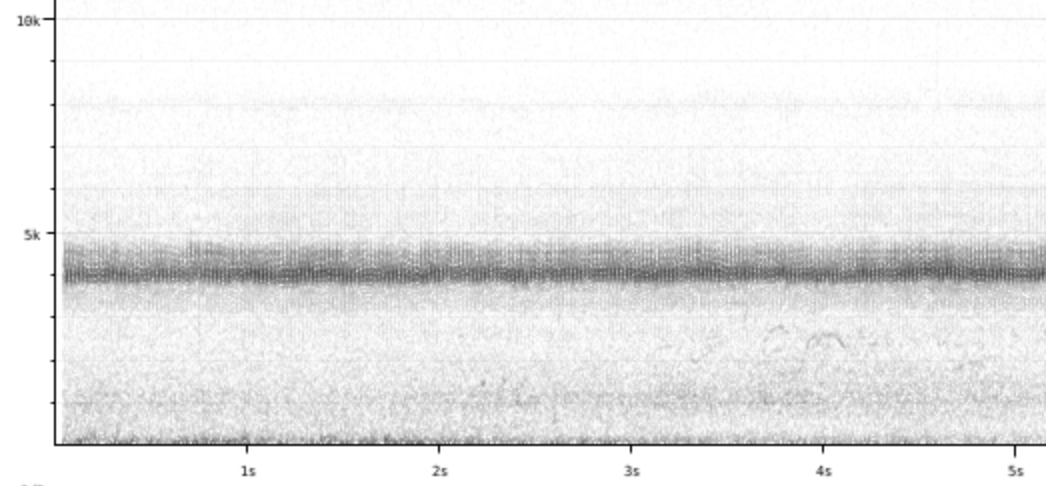
Call:
Automatically generated from Xeno-Canto recording
♫ Source: BirdNet
20220604_135303 birdnet - Rohrschwirl - 2022-06-04 13:53:03 - Rohrschwirl - Uznach.mp3
2022-06-04 13.53.03 Uznach (song?)

Wikipedia: Common grasshopper warbler Source: OTHER
Grashoppsangare-070512.jpg
General: ![]() The common grasshopper warbler (Locustella naevia) is a species of Old World warbler in the grass warbler genus Locustella. It breeds across much of temperate Europe and the western Palearctic. It is migratory, wintering in north and west Africa.
[more]
The common grasshopper warbler (Locustella naevia) is a species of Old World warbler in the grass warbler genus Locustella. It breeds across much of temperate Europe and the western Palearctic. It is migratory, wintering in north and west Africa.
[more]
Song: ![]() Sehr lang anhaltendes Schwirren. Die einzelnen Schlage noch zu erkennen. Der Klang erinnert etwas an Heuschreckenzirpen (alter Name Heuschreckenrohrsänger, langer Name, lange Strophe) und klingt etwas blechern., d.h. Mit Oberton. (fast wie ein Wecker bei dem man den Finger etwas auf die Glocke hält)
[Link]
Sehr lang anhaltendes Schwirren. Die einzelnen Schlage noch zu erkennen. Der Klang erinnert etwas an Heuschreckenzirpen (alter Name Heuschreckenrohrsänger, langer Name, lange Strophe) und klingt etwas blechern., d.h. Mit Oberton. (fast wie ein Wecker bei dem man den Finger etwas auf die Glocke hält)
[Link]
![]() Song insect-like and high-pitched. A monotonous stream of even clicks similar to a running fishing line. Maintained for seemingly endless periods, and often hard to locate. Song most similar to Savi's Warbler but is slower (each click more separated), and higher pitched with a metallic, ringing quality. Short sequences of song also functions as contact call. Also a Robin-like "tick". [Link]
Song insect-like and high-pitched. A monotonous stream of even clicks similar to a running fishing line. Maintained for seemingly endless periods, and often hard to locate. Song most similar to Savi's Warbler but is slower (each click more separated), and higher pitched with a metallic, ringing quality. Short sequences of song also functions as contact call. Also a Robin-like "tick". [Link]
Calls: ![]() Rufe:“pswitt“ (spitz)
[Link]
Rufe:“pswitt“ (spitz)
[Link]
Physical details: length=12-13 cm,
wingspan=15-19 cm,
weight=11-16 g
Habitats:
Wetland
Song or calls similar to:
Savi's warbler.
Song:
Buzzing like an insect or machinery. BirdLife Schweiz says like a grasshopper (which is after all the English name).
Song attributes:
Melody: simple rhythmic, fast, Frequency: 5-8 KHz
Profile Wikipedia eBird Vogelwarte BirdLife ZH ornitho.ch bird-song.ch Audubon AllAboutBirds Xeno-Canto BirdID NABU
Pair of house sparrows in a tree near Zürichstrasse, Fehraltorf 2020-04-11 07.54.30 Luppmen
First observed in 🇨🇭 on 2019-05-14.
This bird appears across the great seas in the following continents:
Europe, North America (introduced), South America, Africa, Asia.
One of the most common birds anywhere in Europe and North America.
In Fehraltorf there are 5 house sparrows for every one tree sparrow.
Eugene Schieffelin brought house sparrows and starlings to North Ameria.
As a Shakespeare fan, it is often claimed that he wanted to introduce all species to North America that are mentioned in Shakespeare,
but apparently this is not supported by any records
Found practically everywhere. Often on the ground or on your table in a cafe (they're very bold)
or in groups in bushes and hedges
Song: ![]() Song a primitive, monosyllabic, or slightly disyllabic "chilp", hard to distinguish from Tree Sparrow. [Link]
Song a primitive, monosyllabic, or slightly disyllabic "chilp", hard to distinguish from Tree Sparrow. [Link]
Calls: ![]() Most calls very similar to Tree Sparrow, but lacks said species' distinct high pitched call (chew-itt), and alarm call is less dry and raucous. [Link]
Most calls very similar to Tree Sparrow, but lacks said species' distinct high pitched call (chew-itt), and alarm call is less dry and raucous. [Link]
Physical details: length=14-15 cm,
wingspan=21-25 cm,
weight=24-38 g
not sexually dimporphic.
No breeding plumage
Identifying characteristics:
Youth:
beak = yellow (Makes it look like a finch)
Habitats:
Settlement
Song:
An monotone chirping. Mainly 2-5 KHz with higher overtones.
Song attributes:
Melody: simple rhythmic, slow, Frequency: 2-5 KHz Singing season: 01-01 - 08-31 Dawn chorus start, 30 minutes before dawn.
Call:
Automatically generated from Xeno-Canto recording
♫ Source: BirdNet
20200507_071255 birdnet 457 - good one note recording - House sparrow.mp3
2020-05-07 07.12.55 Luppmen (song?)
Profile Wikipedia eBird Vogelwarte BirdLife ZH ornitho.ch bird-song.ch Audubon AllAboutBirds Xeno-Canto BirdID NABU

In tree by First, ZH. 2020-05-04 17.33.32 Luppmen
First observed in 🇨🇭 on 2020-04-10.
This bird appears across the great seas in the following continents:
Europe, North America (introduced), Africa, Asia.
Similar to the house sparrow, but with the black cheek patch seen here.
in Fehraltorf there are 5 times as many house sparrows as tree sparrows.
Geography: ![]() Brought from Germany, about 20 of these birds were released in St. Louis in 1870. The population took hold there, and they might have spread except that the House Sparrow, seemingly more aggressive and adaptable, reached the St. Louis area at about the same time. Eurasian Tree Sparrows are still found in parts of Missouri and Illinois, and have reached southeastern Iowa, but they are fairly local in farmland and suburbs. The tougher House Sparrow may keep them out of other areas. [Link]
Brought from Germany, about 20 of these birds were released in St. Louis in 1870. The population took hold there, and they might have spread except that the House Sparrow, seemingly more aggressive and adaptable, reached the St. Louis area at about the same time. Eurasian Tree Sparrows are still found in parts of Missouri and Illinois, and have reached southeastern Iowa, but they are fairly local in farmland and suburbs. The tougher House Sparrow may keep them out of other areas. [Link]
Vocalization: ![]() Most other sounds similar to House Sparrow, and may be difficult to identify. [Link]
Most other sounds similar to House Sparrow, and may be difficult to identify. [Link]
Song: ![]() Chattering sounds are generally harder, and song slightly higher pitched than House Sparrow. [Link]
Chattering sounds are generally harder, and song slightly higher pitched than House Sparrow. [Link]
Calls: ![]() Distinct, high-pitched and explosive contact-call; "che-witt" typically given in flight. Second syllable rising rapidly in pitch. [Link]
Distinct, high-pitched and explosive contact-call; "che-witt" typically given in flight. Second syllable rising rapidly in pitch. [Link]
Physical details: length=14 cm,
wingspan=20-22 cm,
weight=18-29 g
Habitats:
Settlement
Song:
Monotone chirping, rougher than that of the house sparrow. Most 2-7 KHz mit many overtones,
i.e. somewhat higher than the house sparrow.
Song attributes:
Melody: simple rhythmic, slow, Frequency: 2-7 KHz
Call:
Automatically generated from Xeno-Canto recording
♫ XC558751-Feldsperling. Source: XENOCANTO
XC558751-Feldsperling.mp3
(song?)

Italiensperling gerumpelt. 2023-06-19 10.26.08 Bolle di Magadino
First observed in 🇨🇭 on 2021-04-06.
Classification: ![]() It is intermediate between the house sparrow, and the Spanish sparrow, a species of the Mediterranean and Central Asia closely related to the house sparrow. [Link]
It is intermediate between the house sparrow, and the Spanish sparrow, a species of the Mediterranean and Central Asia closely related to the house sparrow. [Link]
Within Switzerland it's mostly seen in Ticino.
Appearance and identification: ![]() Männchen ähnlich wie Haussperlng, doch mit braunem Scheitel, hellen Wangen und ausgedehnt schwarzer Kehle und Brust, die bis zu den Schultern reicht, angedeuteter weisser Augenstreif; Weibchen sind kaum von denjenigen des Haussperlings zu unterscheiden. [Link]
Männchen ähnlich wie Haussperlng, doch mit braunem Scheitel, hellen Wangen und ausgedehnt schwarzer Kehle und Brust, die bis zu den Schultern reicht, angedeuteter weisser Augenstreif; Weibchen sind kaum von denjenigen des Haussperlings zu unterscheiden. [Link]
Habitats:
Settlement
Song:
Sounds like house sparrow to me
Song attributes:
Melody: stereotype melodic, slow, Frequency: 2-5 KHz
Call:
Automatically generated from Xeno-Canto recording
♫ XC729736 - Italian Sparrow - Passer italiae - typical sparrowish swoop or fast falling 3-note call. Source: XENOCANTO
XC729736 - Italian Sparrow - Passer italiae - typical sparrowish swoop or fast falling 3-note call.mp3
(call)

Call attributes:
Frequency: ,
Profile Wikipedia eBird Vogelwarte BirdLife ZH ornitho.ch bird-song.ch Xeno-Canto BirdID NABU
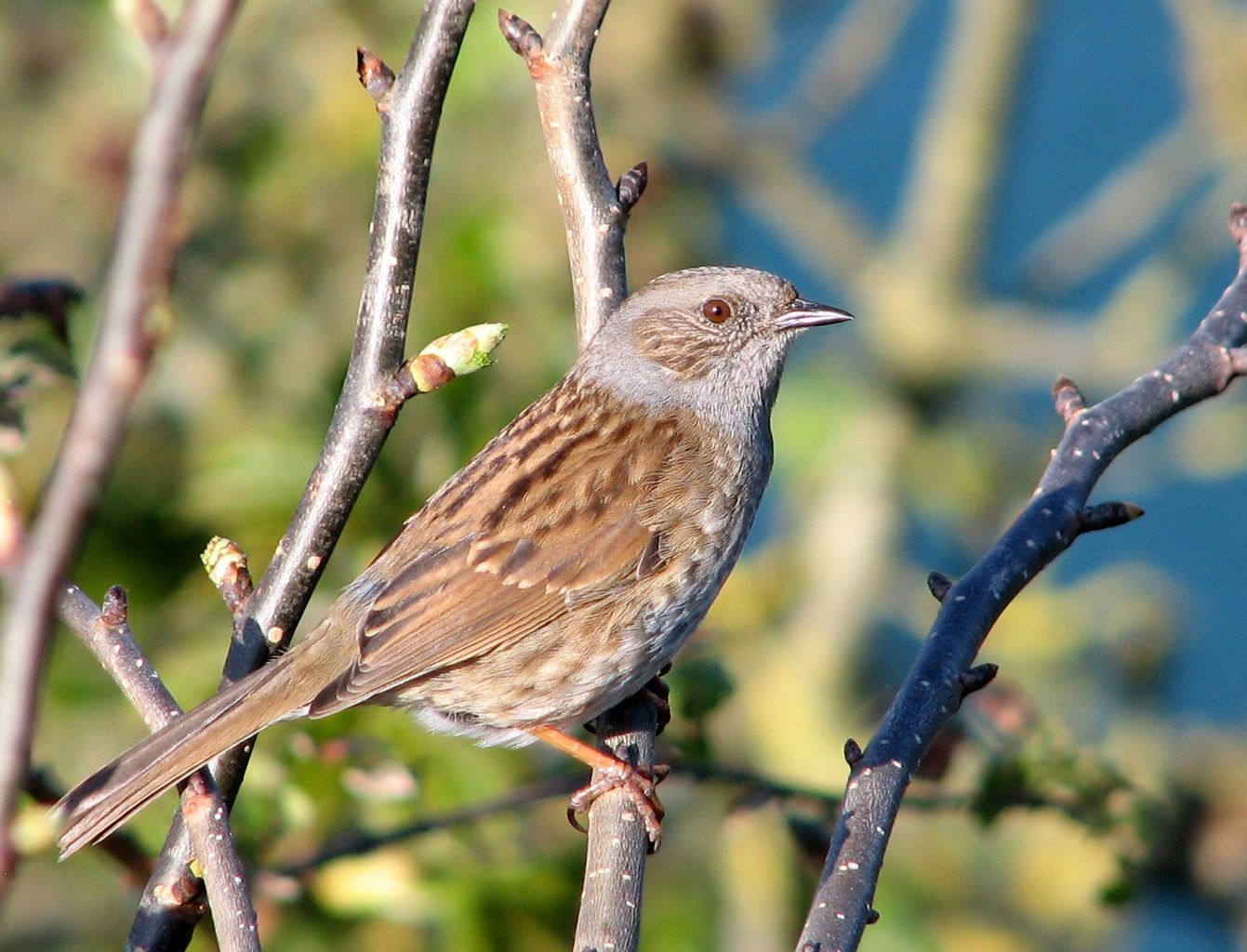
Wikpedia photo because mine is poor. Source: WIKIPEDIA
Dunnock oder Heckenbraunelle aus Wikipedia weil nur gehört.jpg
First observed in 🇨🇭 on 2020-04-16.
Heard at Hungerseeli and near Lendikon according to BirdNET. Finally seen near Amden 2023.
Song: ![]() Singt schon im Vorfrühling. Klangfarbe ähnlich Gartenbaumläufer. Aufbau ähnlich Zaunkönig, aber ohne Triller. Viel leiser und dünner.
[Link]
Singt schon im Vorfrühling. Klangfarbe ähnlich Gartenbaumläufer. Aufbau ähnlich Zaunkönig, aber ohne Triller. Viel leiser und dünner.
[Link]
![]() Song a fast and evenly paced, high pitched stream of clear notes. No consistent phrasing. Similar in timbre to Robin, but does not vary tempo or pitch nearly as much. Often compared to the sound of a squeaky wheelbarrow. [Link]
Song a fast and evenly paced, high pitched stream of clear notes. No consistent phrasing. Similar in timbre to Robin, but does not vary tempo or pitch nearly as much. Often compared to the sound of a squeaky wheelbarrow. [Link]
Calls: ![]() Hohe „zi“ „tsi“. Auf dem Zug „zieht“. Etwas absinkend..
[Link]
Hohe „zi“ „tsi“. Auf dem Zug „zieht“. Etwas absinkend..
[Link]
![]() Contact call a dry, thick trill "trrr", and a short King Fisher-like, high-pitched "zeep". [Link]
Contact call a dry, thick trill "trrr", and a short King Fisher-like, high-pitched "zeep". [Link]
Physical details: length=14 cm,
wingspan=19-21 cm,
weight=16-25 g
Habitats:
Forest
Song:
General: High-pitched, repetitive but complex little tune.
Song: ![]() Melodisch, slowly rising, roughly like black-cap warbler, which I guessed in the bird-song.ch quiz. [Link]
Melodisch, slowly rising, roughly like black-cap warbler, which I guessed in the bird-song.ch quiz. [Link]
Song attributes:
Melody: stereotype melodic, fast, Frequency: 4-8 KHz Singing season: 02-15 - 07-31 Dawn chorus start, 45 minutes before dawn.
Call:
Swooping staccato call 0.5 seconds long heard near Lendikon. Repeated irregularly after 1-3.5 seconds.
♫ Source: XENOCANTO
XC594397 - Dunnock - Prunella modularis modularis - call recorded in Poland.mp3
(call)
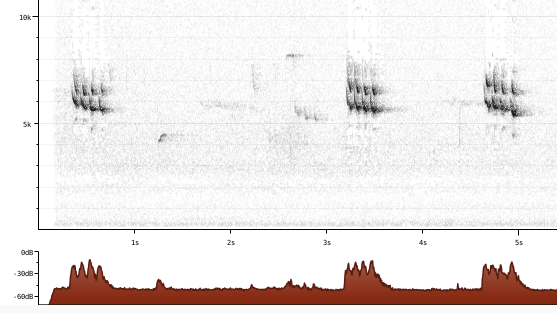
Call attributes:
Call melody: one note, fast, Frequency: 5-7 KHz, Special sounds: swoop.
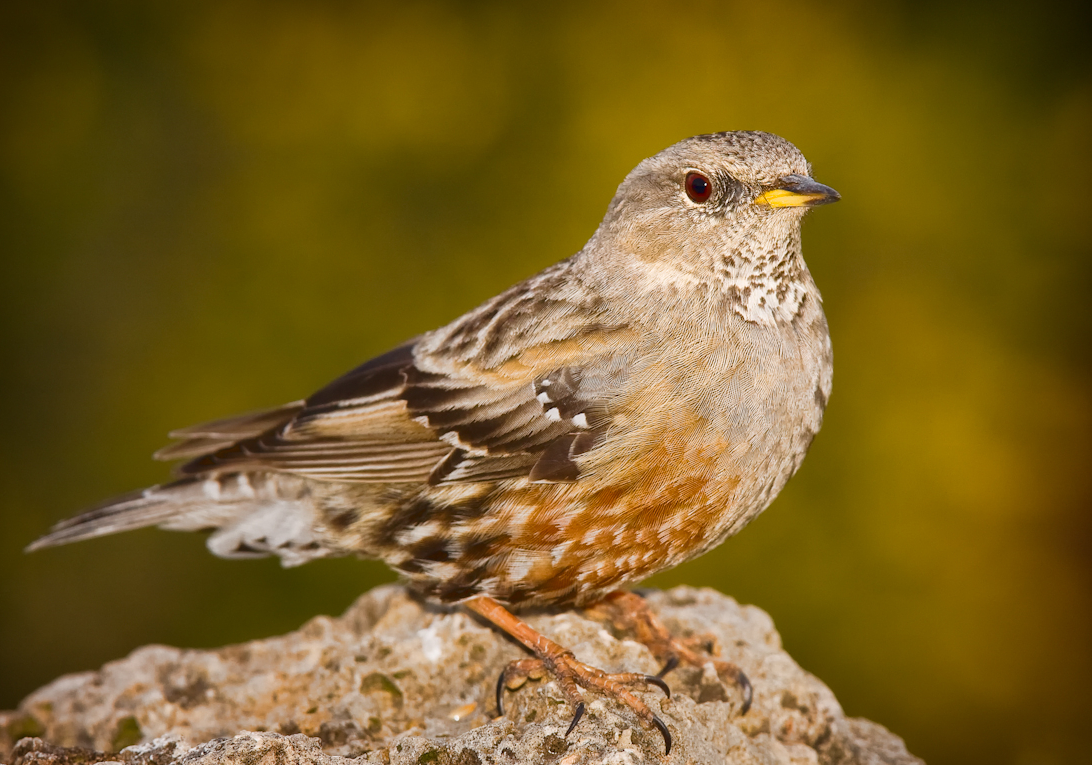
Wikipedia: Alpine accentor Source: OTHER
Alpine_accentor_saganta.jpg
General: ![]() The alpine accentor (Prunella collaris) is a small passerine bird in the family Prunellidae, which is native to Eurasia and North Africa.
[more]
The alpine accentor (Prunella collaris) is a small passerine bird in the family Prunellidae, which is native to Eurasia and North Africa.
[more]
Song: ![]() Song is a varied stream of melodious and chattering notes, more resembling skylark than the much higher pitched Dunnock. [Link]
Song is a varied stream of melodious and chattering notes, more resembling skylark than the much higher pitched Dunnock. [Link]
Calls: ![]() Most common call a noisy "tchrt", often repeated in short, retarding series. Also has a more pleasant, ringing Snow Bunting-like "prrrriitt". [Link]
Most common call a noisy "tchrt", often repeated in short, retarding series. Also has a more pleasant, ringing Snow Bunting-like "prrrriitt". [Link]
Physical details: length=18 cm,
wingspan=30-32 cm,
weight=37-43 g
Habitats:
Mountain
Song:
Fast, long, chirpy
Song attributes:
Melody: sings 30 seconds or longer, fast, Frequency: 1-8 KHz
♫ Source: XENOCANTO
XC688398 - Alpine Accentor - Prunella collaris - long song recorded in France.mp3
(song)

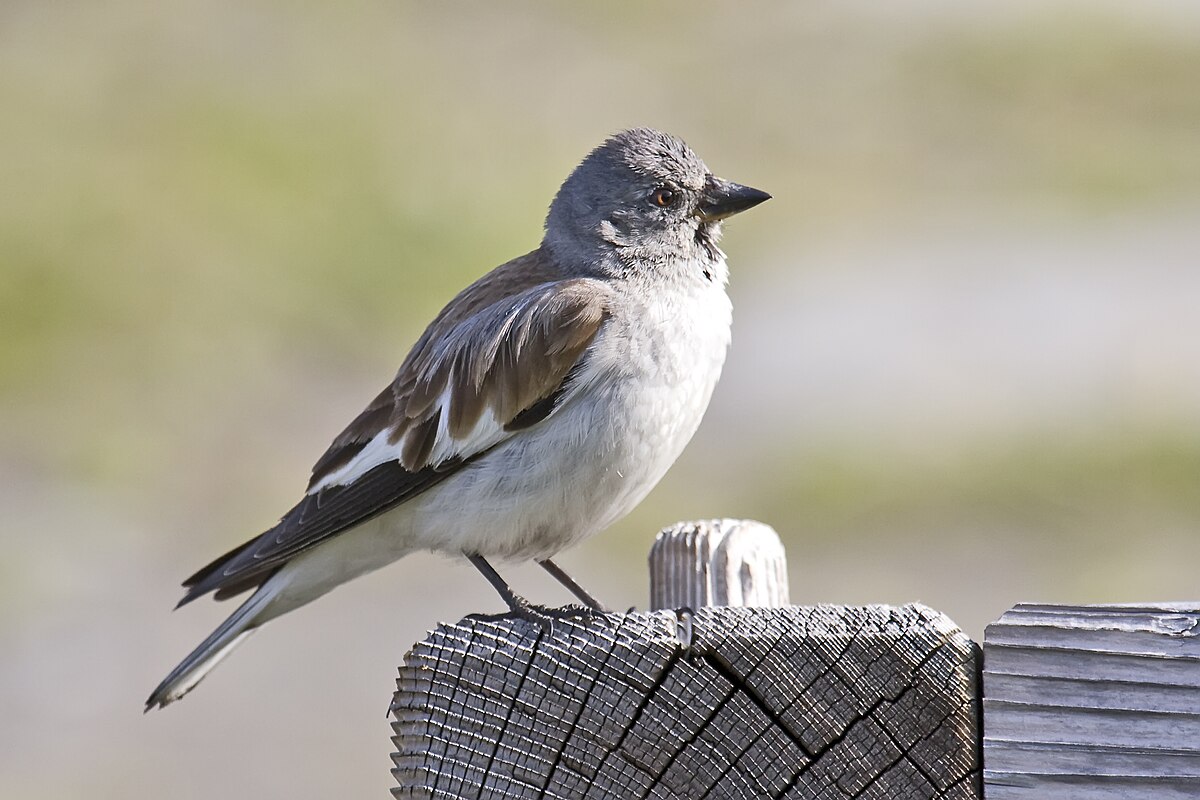
Wikipedia: White-winged snowfinch Source: OTHER
1200px-Snowfinch.jpg
More white and gray than other sparrows, bronw only on back (wings), v. white when flying. almost always 1500m+, eher im Sueden inkl Graubuenden
Vocalization: ![]() Rich repertoire. [Link]
Rich repertoire. [Link]
Song: ![]() Song a staccato, variable phrase, consisting of short burst of sharp chattering in uneven tempo. The timbre is ringing, rich in harmonics and partly rolling. [Link]
Song a staccato, variable phrase, consisting of short burst of sharp chattering in uneven tempo. The timbre is ringing, rich in harmonics and partly rolling. [Link]
Calls: ![]() Among the various contact call the commonest are a high-pitched, sharp "zeet", a deeper, Brambling-like "veet, or a sparrow-like "peea". Alarm call a rolling "trr-r-r-rt", resembling Crested Tit. [Link]
Among the various contact call the commonest are a high-pitched, sharp "zeet", a deeper, Brambling-like "veet, or a sparrow-like "peea". Alarm call a rolling "trr-r-r-rt", resembling Crested Tit. [Link]
Physical details: length=17 cm,
wingspan=34-38 cm,
weight=35-45 g
Habitats:
Mountain
Song:
The XC song I downloaded is a faint chirping. Should follow up on song - most talk about calls.
Song attributes:
Melody: simple rhythmic, slow, Frequency: 4-6 KHz
Profile Wikipedia eBird Vogelwarte BirdLife ZH ornitho.ch bird-song.ch Xeno-Canto BirdID NABU
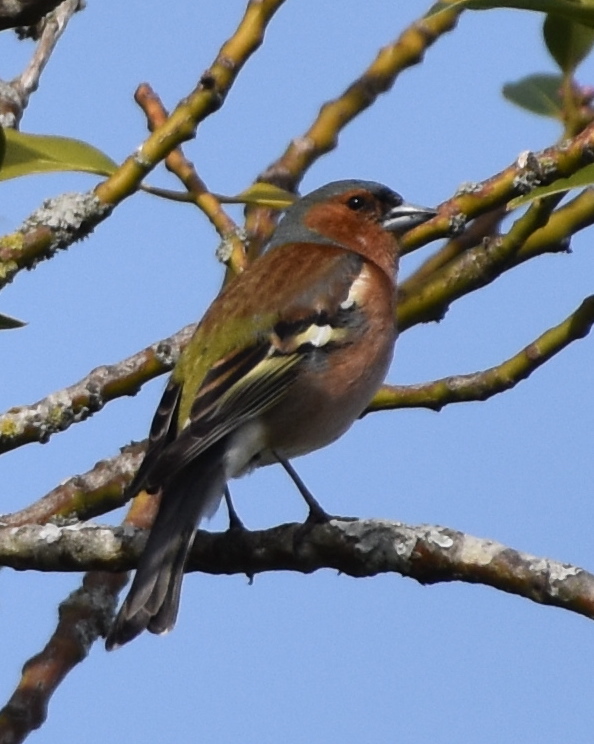
In tree by First, ZH. 2020-05-04 17.33.36 Luppmen
First observed in 🇨🇭 on 2019-06-04.
Heard everywhere locally but less often seen.
In winter 2020-2021 it often accompanied tits to our feeder (2021-2022 less often). While they grabbed
sunflower seeds, the chaffinch would hunt for food on the ground or in bushes.
On Dec 8 2021, was surprised to see flocks of collared doves, chaffinches and a few sparrows in a harvested corn field as it was snowing. I wasn't aware that chaffinches formed flocks, but the Merlin BirdID app told me 'forms flocks in winter'.
I've caught it on stubby branches of an evergreen, in a lone tree in a farmyard, and in Brittany even on
a lightpost. And I seem to see one every time I go to Zurich, so they're happy in an urban setting.
Etymology: ![]() Als Kontakt- und Alarmruf dient «pink», von dem wahrscheinlich die deutsche Bezeichnung «Fink» herkommt. [Von BirdLifes Schweizer 'bird song' Website]
Als Kontakt- und Alarmruf dient «pink», von dem wahrscheinlich die deutsche Bezeichnung «Fink» herkommt. [Von BirdLifes Schweizer 'bird song' Website]
Appearance and identification: ![]() Interesting tidbit: the chaffinch is one bird
that can change colors without molting. Its new feathers in autumn are grayish, but by late spring
the edges of the feathers have worn away, revealing the chaffinch's brightest colors of the year. [Lovette and Fitzpatrick's Handbook of Bird Biology]
Interesting tidbit: the chaffinch is one bird
that can change colors without molting. Its new feathers in autumn are grayish, but by late spring
the edges of the feathers have worn away, revealing the chaffinch's brightest colors of the year. [Lovette and Fitzpatrick's Handbook of Bird Biology]
Song: ![]() Song a falling 5 sec. phrase "zitt-zitt-chep-chepp-chu-chu-churrurrwitt". Structurally similar to Willow Warbler, but with a conclusive, ascending and accented ending, and with a much harder, finch-like, timbre. [Link]
Song a falling 5 sec. phrase "zitt-zitt-chep-chepp-chu-chu-churrurrwitt". Structurally similar to Willow Warbler, but with a conclusive, ascending and accented ending, and with a much harder, finch-like, timbre. [Link]
Physical details: length=14 cm,
wingspan=24-28 cm,
weight=18-29 g
Habitats:
Forest
Social groups can include up to 10 members.
Song:
General: A medium long phrase that slowly descends (I think of it bouncing down a staircase), then usually takes a
jump up before a final descent.
Song: ![]() In Bavaria the mnemonic for the typical chaffinch song is: „Ich hätte gerne ein Weizenbier“,
i.e. "I'd like another Weizenbier". [DasHaus]
In Bavaria the mnemonic for the typical chaffinch song is: „Ich hätte gerne ein Weizenbier“,
i.e. "I'd like another Weizenbier". [DasHaus]
Song attributes:
Melody: stereotype melodic, slow, Frequency: medium (1-5 KHz) Singing season: 02-01 - 07-31 Dawn chorus start, 10 minutes before dawn.
Calls:
1:
General: Repeated ascending note, faster than the long starling whoops, but compare with the black redstart.
There are many different calls, the Marler book describes the 'chink' call as functioning as a mobbing and separation call.
At XenoCanto I find calls described as "ping", "pik" (same thing?), "pchew", "duit", "huit", "ti-huit".
Call: ![]() Der sogenannte Regenruf der Männchen, „schrrüt“, der selbst in benachbarten Ortsteilen deutlich variieren kann, erklingt nur während der Brutzeit. Als Regenruf wird er bezeichnet, weil er kurz vor oder sogar während des Regens zu hören ist, wenn die anderen Vögel verstummen. [DasHaus]
Der sogenannte Regenruf der Männchen, „schrrüt“, der selbst in benachbarten Ortsteilen deutlich variieren kann, erklingt nur während der Brutzeit. Als Regenruf wird er bezeichnet, weil er kurz vor oder sogar während des Regens zu hören ist, wenn die anderen Vögel verstummen. [DasHaus]
Rain call from XenoCanto
♫ Rain call from XenoCanto Recorded by Paul Driver in Mundford, Norfolk, UK Source: XENOCANTO
XC71019 common chaffinch rain call.mp3
(rain call)
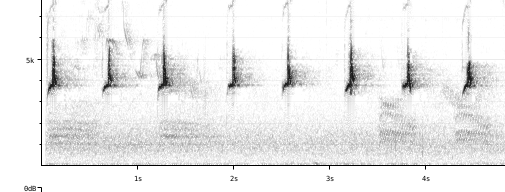
2:
Call: ![]() Als Alarmsignal dient ein mehrsilbiges „pink“. [DasHaus]
Als Alarmsignal dient ein mehrsilbiges „pink“. [DasHaus]
Ping call from XenoCanto
♫ Ping call from XenoCanto Source: XENOCANTO
XC460303 common chaffinch ping call.mp3
(alarm call)

Call attributes:
rain call Call melody: one note, slow, Frequency: 3-5 KHz, Special sounds: whoop.
Presence: 01-01 - 12-31
Breeding: 04-01 - 07-31
Migration in: 02-20 - 04-15
Migration out: 09-10 - 11-15
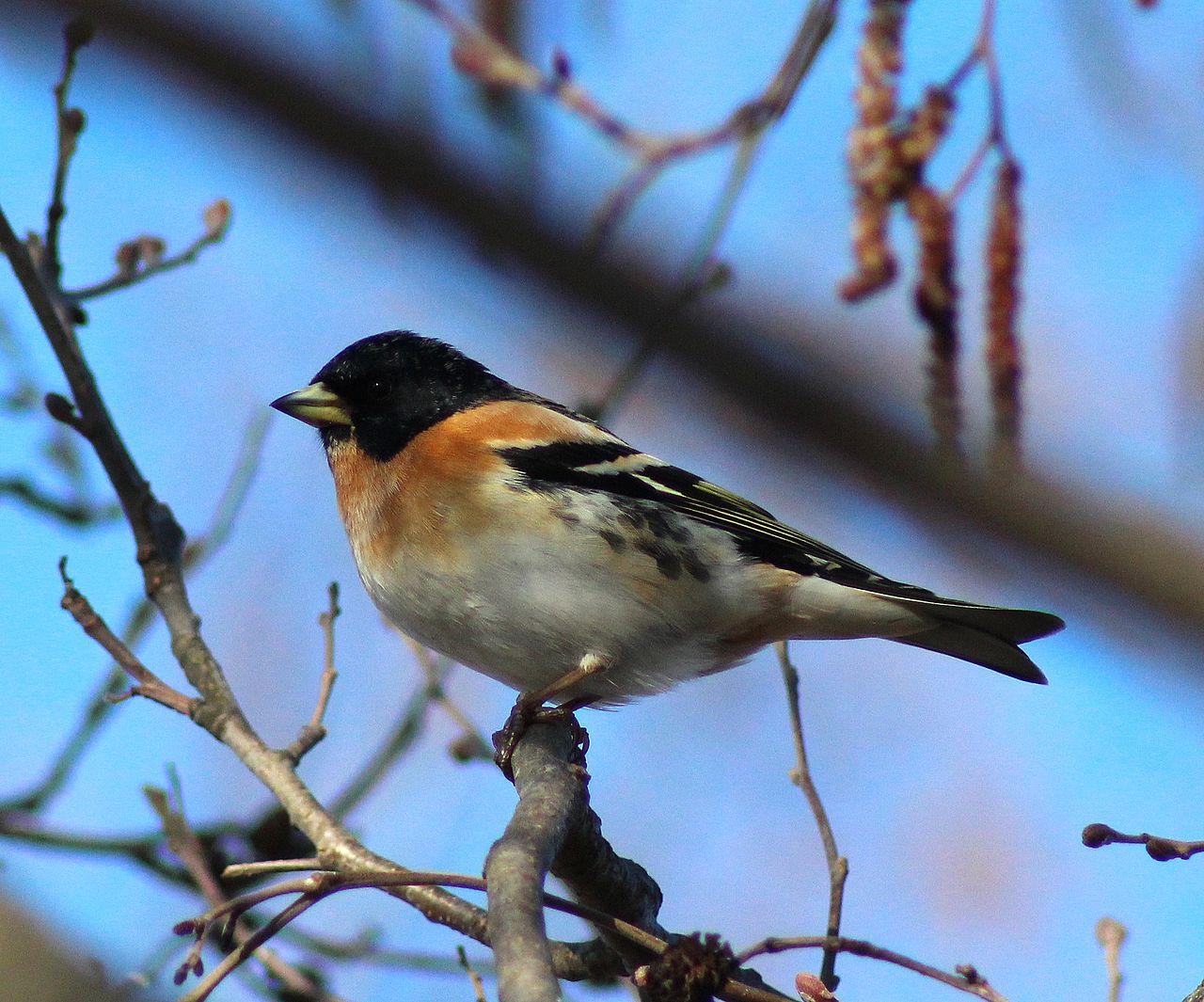
Wikipedia Bergfink. Foto: Source: WIKIPEDIA
Wikipedia Bergfink.jpg
This bird appears across the great seas in the following continents:
Europe, North America, Africa.
Geography: ![]() the Brambling appears regularly in small numbers in Alaska during migration, straying the short distance across the Bering Sea. Some of those that stray across in autumn apparently then continue south on the American side, and there have been winter records for numerous states and provinces east to the Atlantic Coast and south to Colorado. Many of these vagrant Bramblings have been found visiting bird feeders. [Link]
the Brambling appears regularly in small numbers in Alaska during migration, straying the short distance across the Bering Sea. Some of those that stray across in autumn apparently then continue south on the American side, and there have been winter records for numerous states and provinces east to the Atlantic Coast and south to Colorado. Many of these vagrant Bramblings have been found visiting bird feeders. [Link]
Vocalization: ![]() Large repertoire of mostly characteristic sounds. [Link]
Large repertoire of mostly characteristic sounds. [Link]
Song: ![]() Song very distinct; a soft, wheezing, drawn-out single note. Repeated at the same pitch in a monotonous manner. [Link]
Song very distinct; a soft, wheezing, drawn-out single note. Repeated at the same pitch in a monotonous manner. [Link]
Calls: ![]() Contact calls include a short, nasal, ascending "keeaa", a short high-pitched, piercing "tzeet" and a linnet-like "chepp". May be mistaken for Greenfinch, but note softer timbre and stable pitch throughout the call. [Link]
Contact calls include a short, nasal, ascending "keeaa", a short high-pitched, piercing "tzeet" and a linnet-like "chepp". May be mistaken for Greenfinch, but note softer timbre and stable pitch throughout the call. [Link]
Physical details: length=14 cm,
wingspan=25-26 cm,
weight=17-30 g
Habitats:
Forest
Song:
General: Bergfink - call cheep plus two ascending Grünfink squawks. Song? Grünfink squawk but not descending, every 3-4 seconds.
Song: ![]() Song very distinct; a soft, wheezing, drawn-out single note. Repeated at the same pitch in a monotonous manner. [Link]
Song very distinct; a soft, wheezing, drawn-out single note. Repeated at the same pitch in a monotonous manner. [Link]
Song attributes:
Melody: simple rhythmic, slow, Frequency: medium (1-5 KHz) Special sounds: rasp Singing season: 04-14 - 09-15
♫ Source: XENOCANTO
XC731031 - Brambling - Fringilla montifringilla.mp3
(song)
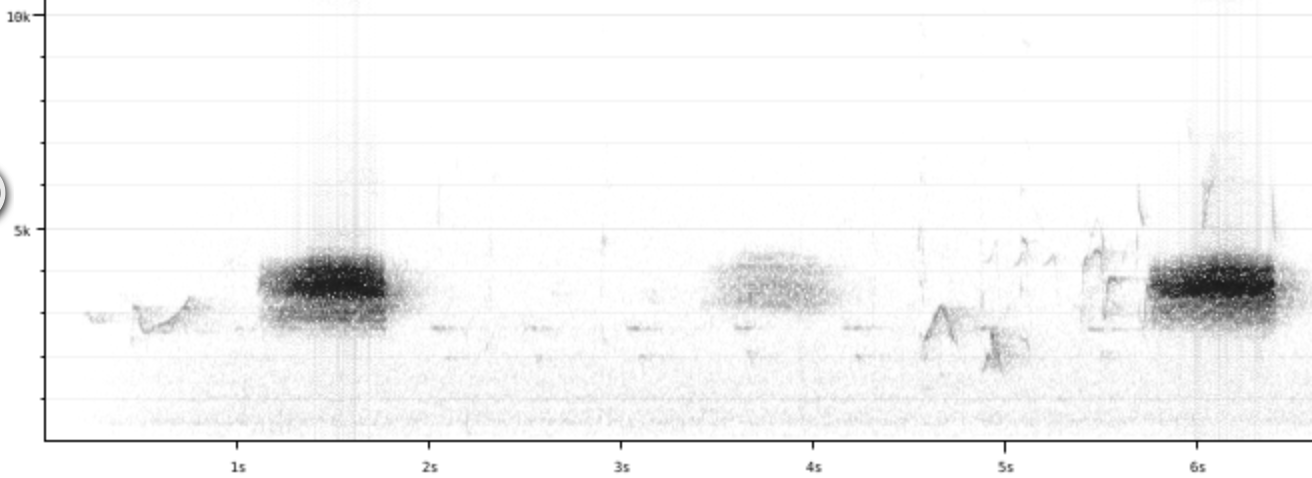
Call:
Automatically generated from Xeno-Canto recording
♫ XC731031 - Brambling - Fringilla montifringilla. Source: XENOCANTO
XC731031 - Brambling - Fringilla montifringilla.mp3
(song?)

Profile Wikipedia eBird Vogelwarte BirdLife ZH ornitho.ch bird-song.ch Xeno-Canto BirdID NABU

Wikipedia Girlitz Serinus serinus. Von Andreas Trepte - Eigenes Werk, CC BY-SA 2.5, Link Source: WIKIPEDIA
Wikipedia Girlitz_Serinus_serinus.jpg
First observed in 🇨🇭 on 2020-06-14.
I'm doubtful that all the recordings below are really serin...better check them out.
Song: ![]() Song a hectic, jingling, continuous trill, like the pouring of broken glass. The highest notes are constantly modulated to form vague motifs. Timbre comparable to Corn Bunting. [Link]
Song a hectic, jingling, continuous trill, like the pouring of broken glass. The highest notes are constantly modulated to form vague motifs. Timbre comparable to Corn Bunting. [Link]
Calls: ![]() Ringing trill also used as contact call, with slightly falling pitch "trrilrlitlitlit". Alarm call a short, redpoll-like "weee-eeet", with an accented high-pitched middle part. [Link]
Ringing trill also used as contact call, with slightly falling pitch "trrilrlitlitlit". Alarm call a short, redpoll-like "weee-eeet", with an accented high-pitched middle part. [Link]
Physical details: length=11 cm,
wingspan=20-23 cm,
weight=11-14 g
Habitats:
Settlement
Song:
Song: Weird hectic song, and you'll probably hear them but not see them, which is a shame, because they're a colorful yellow bird. The song seems to defy description - described variously as the jingling of a bunch of keys, like crushing glass or the pouring of broken glass (the German Wikipedia refers to a nickname 'Glasscutter'), the sound of a cork twising in a bottle (Thomas Seilnacht on digitalefolien.ch), and one source I can no longer find talked about a ruined cassette tape. A Portuguese web site aptly calls it 'a high-pitched and fast rambled sum of indistinctive elements', and U. Cornell's ebird.org calls it frantically fast, oiseaux-birds.com 'a prolonged, wheezy, chirping', beautyofbirds.com 'a buzzing trill'.
![]() Das Gesangsrepertoire umfasst über 50 komplexe Silben, die in einem sehr schnellen Tempo und einer sehr stereotypen Reihenfolge eigene Lieder bilden. Starke Variationen finden sich im Übergang von einer Tour (zusammenhängenden Abfolge von Silben, also (Teil-)Strophe) in eine andere (Modulation). Das Gesangsrepertoire ist unter den Stieglitzartigen (Carduelinae) einzigartig.[1] Zudem umfasst es eine variable Menge an Silben, die auch im Gesang anderer Vögel verwendet werden. Es konnte bewiesen werden, dass die Komposition des Repertoires geographisch variiert. [Wikipedia setzt sich ernsthaft mit dem Gesang auseinander]
Das Gesangsrepertoire umfasst über 50 komplexe Silben, die in einem sehr schnellen Tempo und einer sehr stereotypen Reihenfolge eigene Lieder bilden. Starke Variationen finden sich im Übergang von einer Tour (zusammenhängenden Abfolge von Silben, also (Teil-)Strophe) in eine andere (Modulation). Das Gesangsrepertoire ist unter den Stieglitzartigen (Carduelinae) einzigartig.[1] Zudem umfasst es eine variable Menge an Silben, die auch im Gesang anderer Vögel verwendet werden. Es konnte bewiesen werden, dass die Komposition des Repertoires geographisch variiert. [Wikipedia setzt sich ernsthaft mit dem Gesang auseinander]
Song attributes:
Melody: sings 5-19 seconds, very fast, Frequency: 4-10 KHz
♫ Source: XENOCANTO
XC637940 - European Serin - Serinus serinus - song, recorded in France.mp3
(song)

Call:
Automatically generated from Xeno-Canto recording
♫ Source: BirdNet
20200614_173558 birdnet 656 - European serin.mp3
2020-06-14 17.35.58 Locarno (song?)
Zitronenzeisig. 2023-05-27 09.55.48 Amden Hinder Hoechi
First observed in 🇨🇭 on 2023-05-27.
Gelb wie Erlenzeisig aber kopf gelbes gesicht, grau weiter hinten
Wikipedia sagt ähnelt dem Gesang des Stieglitzes, in Aufbau und Tonfolge auch dem Girlitz.
Scheint nicht viel zu singen - XenoCanto hat nur 6 Seiten von Aufnahmen!
Habitats:
Mountain
Song:
Wild warbling of about 7 seconds
Song attributes:
Melody: sings 5-19 seconds, fast, Frequency: 2-10 KHz
♫ Source: XENOCANTO
XC372554 - Citril Finch - Carduelis citrinella - song.mp3
(song)


Wikipedia: Common rosefinch Source: OTHER
Common_Rosefinch_Neora_Valley_National_Park_Darjeeling_West_Bengal_India_30.04.2016.jpg
General: ![]() The common rosefinch (Carpodacus erythrinus) or scarlet rosefinch is the most widespread and common rosefinch of Asia and Europe.
[more]
The common rosefinch (Carpodacus erythrinus) or scarlet rosefinch is the most widespread and common rosefinch of Asia and Europe.
[more]
Song: ![]() Song very characteristic. A melodious, pure and short whistle, often rendered as "pleased to meet you". Each note with a smooth gliding change of pitch. Number of syllables may vary. [Link]
Song very characteristic. A melodious, pure and short whistle, often rendered as "pleased to meet you". Each note with a smooth gliding change of pitch. Number of syllables may vary. [Link]
Calls: ![]() Contact call a short ascending "hueet" resembling Siskin in timbre. [Link]
Contact call a short ascending "hueet" resembling Siskin in timbre. [Link]
Physical details: length=14-15 cm,
wingspan=24-26 cm,
weight=19-27 g
Habitats:
Wetland
Song:
![]() Einfacher, flötender Gesang: variations on a slurring hHmML. [Link]
Einfacher, flötender Gesang: variations on a slurring hHmML. [Link]
Song attributes:
Melody: stereotype melodic, fast, Frequency: 2-6 KHz
Nach Disteln mögen sie Sonnenblumenkerne 2020-10-13 09.21.10 Luppmen
First observed in 🇨🇭 on 2019-09-22.
One of the more colorful birds in our area, but fairly shy and skittish, so you don't see them much.
Supposedly a bit smaller than a sparrow or a great tit, but to me they look bigger and heavier?
Well hidden in the tree branches; at thistles or sunflowers.
Name stammt angeblich vom Gesang: ein steigernder sti-ge-litt.
My first (multilingual) notes: Stieglitz like Grünfink, fast, high, occasional trills. Occasionally ends a bit with falling note like buchfink
Mir wurde erst in St. Moritz in Juli 2021 bewusst wie aehnlich der Steiglitz wie ein Gruenfink klingt - beide koennen lange Gesang mit Trillern und rauhen sinkenden Toenen singen, und ich habe Stieglitz v.a. durch dieses Stoehnen fuer Gruenfink gehalten.
Song: ![]() Contact-call distinct, and also constitutes a major part of the song. A sharp and explosive "witt", or "tzee-witt". Sometimes given as a single syllable, di- or trisyllabic, or as continuous series. The song is comprised of rapid series of the contact call, interrupted by drawn-out melodic notes and trills. [Link]
Contact-call distinct, and also constitutes a major part of the song. A sharp and explosive "witt", or "tzee-witt". Sometimes given as a single syllable, di- or trisyllabic, or as continuous series. The song is comprised of rapid series of the contact call, interrupted by drawn-out melodic notes and trills. [Link]
Calls: ![]() Other calls: A harsh budgerigar or house martin-like "trrrtt-trrrrt". [Link]
Other calls: A harsh budgerigar or house martin-like "trrrtt-trrrrt". [Link]
Physical details: length=12 cm,
wingspan=21-25 cm,
weight=14-19 g
Habitats:
Settlement
Song:
General: Hectic sing-song, quite chaotic in feeding groups. But kept as songbird, so I guess more melodic when singing solo. A bit like a black cap warbler (Mönchsgrasmücke).
Gesang hat eine Struktur (und ist langsamer als der Girlitz): Zuerst eine kleine Melodie hoch und runter; dann vielleicht ein Gruenfink-Triller, dann 4 wiederholte Noten oder ein neues Melodiechen. (Oder kommen diese Elemente eher zufaellig?)
Song attributes:
Melody: stereotype melodic, fast, Frequency: 2-7 KHz Special sounds: fluting, rattle Singing season: year round Only pauses singing while molting and thus endangered. Dawn chorus start, 20 minutes before dawn.
♫ Source: XENOCANTO
XC638230 - European Goldfinch - Carduelis carduelis.mp3
(song)

Call:
![]() Wild melody (remember these birds are also kept as songbirds in cages.
the German name Stieglitz imitates its call (sti-ge-lit) - though I don't hear that! [Link]
Wild melody (remember these birds are also kept as songbirds in cages.
the German name Stieglitz imitates its call (sti-ge-lit) - though I don't hear that! [Link]
Xeno-Canto recording
♫ Xeno-Canto recording Adult call recorded in the UK. Source: XENOCANTO
XC468566 European Goldfinch call in UK.mp3
(call)
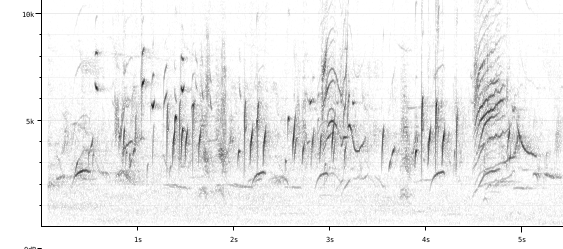 Xeno-Canto recording
Xeno-Canto recording
♫ Xeno-Canto recording Record in Lège-Cap-Ferret, France byStanislas Wroza and described by him as a 'tik' call and a flight call. Source: XENOCANTO
XC526383 European Goldfinch flight call.mp3
(call)
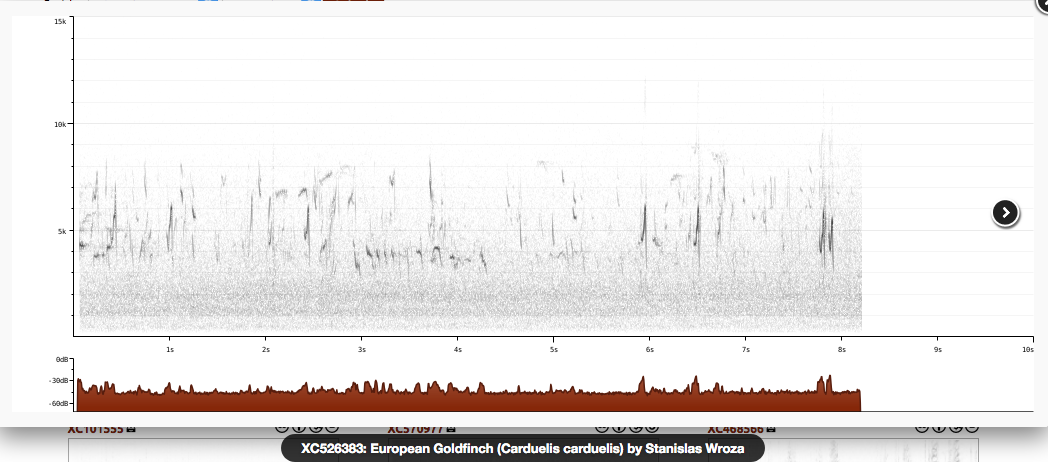
Call attributes:
Call melody: stereotype melodic, fast, Frequency: 2-8 KHz,

Wikipedia: Common redpoll Source: OTHER
1200px-Carduelis_flammea_CT6.jpg
This bird appears across the great seas in the following continents:
Europe, North America.
roter Punkt auf Kopf, sonst weiss+braun, teilweise hell-rot auf brust.
Behavior: ![]() Trotz Ihrer roten Abzeichen sind die bräunlich-weiss gestreiften Vögel wenig auffällig, und wenn sie nicht gerade rufen, bleiben sie meist unentdeckt. Oft fliegen sie unvermittelt auf, drehen im Schwarm eine Runde und fallen wieder ein. [Link]
Trotz Ihrer roten Abzeichen sind die bräunlich-weiss gestreiften Vögel wenig auffällig, und wenn sie nicht gerade rufen, bleiben sie meist unentdeckt. Oft fliegen sie unvermittelt auf, drehen im Schwarm eine Runde und fallen wieder ein. [Link]
Song: ![]() Song an improvised chattering on various contact calls with no apparent phrasing. [Link]
Song an improvised chattering on various contact calls with no apparent phrasing. [Link]
Calls: ![]() Contact call diagnostic. A chattering "Chutt-utt-utt", with a more metallic and nasal timbre than Linnet and Twite. Other sound includes plaintive call mostly given when perched. Uttered as a continuous sound, but with a disyllabic feel. First part ascending slowly, then faster before it is cut off "tsooeet". [Link]
Contact call diagnostic. A chattering "Chutt-utt-utt", with a more metallic and nasal timbre than Linnet and Twite. Other sound includes plaintive call mostly given when perched. Uttered as a continuous sound, but with a disyllabic feel. First part ascending slowly, then faster before it is cut off "tsooeet". [Link]
Physical details: length=11-14 cm,
wingspan=20-25 cm,
weight=9-16 g
Habitats:
Mountain
Song:
A few chirps and a trill, then repeat.
Song attributes:
Melody: simple rhythmic, fast, Frequency: 2-6 KHz Special sounds: trill

Wikipedia: Lesser redpoll Source: OTHER
Carduelis_cabaret1.jpg
introduced
Profile Wikipedia eBird Vogelwarte BirdLife ZH ornitho.ch bird-song.ch Xeno-Canto BirdID NABU
Gimpel gesehen das erste Mal, Ammler Höhenweg. 2021-08-02 15.55.56
First observed in 🇨🇭 on 2021-02-21.
General: ![]() The Eurasian bullfinch, common bullfinch or bullfinch (Pyrrhula pyrrhula) is a small passerine bird in the finch family, Fringillidae. In Anglophone Europe it is known simply as the bullfinch, as it is the original bird to bear the name bullfinch.
[more]
The Eurasian bullfinch, common bullfinch or bullfinch (Pyrrhula pyrrhula) is a small passerine bird in the finch family, Fringillidae. In Anglophone Europe it is known simply as the bullfinch, as it is the original bird to bear the name bullfinch.
[more]
Song: ![]() Song a quiet, modest mix of contact call and various chirping sounds, with peculiar harmonics. [Link]
Song a quiet, modest mix of contact call and various chirping sounds, with peculiar harmonics. [Link]
Calls: ![]() Contact call a soft, full-bodied, descending, pure whistle; "peeuu". [Link]
Contact call a soft, full-bodied, descending, pure whistle; "peeuu". [Link]
Physical details: length=14-16 cm,
wingspan=22-29 cm,
weight=27-38 g
Habitats:
Forest
Song:
3-note long M, pause, HL (somewhat falling)...Gim! Gim-peeel! Sounds a bit like a pirol.
Song attributes:
Melody: stereotype melodic, slow, Frequency: 2-8 KHz
♫ Source: XENOCANTO
XC637392 - Eurasian Bullfinch - Pyrrhula pyrrhula - song, recorded in France.mp3
(song)

Call:
laconic 1 note call w slight dip? Song NABU 1 parakeet like puppy-dog whining, NABU 2 whistles, 2-syllable peek-a-boo, ...
♫ Source: XENOCANTO
XC214867 - Eurasian Bullfinch - Pyrrhula pyrrhula - contact call, recorded in Germany.mp3
Germany (contact call)

Call attributes:
contact call Call melody: one note, slow, Frequency: 2-3 KHz,
Profile Wikipedia eBird Vogelwarte BirdLife ZH ornitho.ch bird-song.ch Xeno-Canto BirdID NABU

Wikipedia: Hawfinch Source: OTHER
1200px-Coccothraustes_coccothraustes_Parco_Della_Piana_around_Firenze%2C_Italy.jpg
General: ![]() The hawfinch (Coccothraustes coccothraustes) is a passerine bird in the finch family Fringillidae. It is the only species placed in the genus Coccothraustes. Its closest living relatives are the Chinese grosbeak (Eophona migratoria) and Japanese grosbeak (Eophona personata) of East Asia, and the evening grosbeak (Hesperiphona vespertina) and hooded grosbeak (Hesperiphona abeillei) of North America.
[more]
The hawfinch (Coccothraustes coccothraustes) is a passerine bird in the finch family Fringillidae. It is the only species placed in the genus Coccothraustes. Its closest living relatives are the Chinese grosbeak (Eophona migratoria) and Japanese grosbeak (Eophona personata) of East Asia, and the evening grosbeak (Hesperiphona vespertina) and hooded grosbeak (Hesperiphona abeillei) of North America.
[more]
Calls: ![]() Most typical call a sharp and explosive "tzek", with abrupt, emphasized, cut-off ending. Quite similar to Robin, but harder, with each syllable marginally longer with a slightly wheezing timbre. Repetitions are slower and more singular than Robin. Diagnostic when interspersed with high frequency notes. [Link]
Most typical call a sharp and explosive "tzek", with abrupt, emphasized, cut-off ending. Quite similar to Robin, but harder, with each syllable marginally longer with a slightly wheezing timbre. Repetitions are slower and more singular than Robin. Diagnostic when interspersed with high frequency notes. [Link]
Physical details: length=18 cm,
wingspan=29-33 cm,
weight=46-70 g
Habitats:
Forest
Call:
Found no references to song
♫ Source: XENOCANTO
XC712663 - Hawfinch - Coccothraustes coccothraustes - whit whit tsirp, recorded in Sweden, redubbed by me to a call.mp3
(song)

Call attributes:
Call melody: one note, fast, Frequency: 4-8 KHz,

Wikimedia Red Crossbills (Male). Source: WIKIPEDIA
Wikimedia Red_Crossbills_(Male).jpg
First observed in 🇨🇭 on 2020-06-13.
This bird appears across the great seas in the following continents:
Europe, North America, Africa.
Forests with conifers. Some spend the winter in Switzerland, others are here year-round.
Appearance and identification: ![]() Nabu.de: das Männchen schon von weitem durch seine ziegelrote Farbe auf. Das Weibchen dagegen ist unscheinbar graugrün gefärbt.Größe: 15 bis 17 Zentimeter
Zugtyp: Teilzieher
Beobachtungszeitraum: Oktober bis April, im Mittelgebirge und Alpenraum ganzjährig. [Link]
Nabu.de: das Männchen schon von weitem durch seine ziegelrote Farbe auf. Das Weibchen dagegen ist unscheinbar graugrün gefärbt.Größe: 15 bis 17 Zentimeter
Zugtyp: Teilzieher
Beobachtungszeitraum: Oktober bis April, im Mittelgebirge und Alpenraum ganzjährig. [Link]
![]() New research suggests that there may be as many as eight different full species of Red Crossbills on [North America]. [Link]
New research suggests that there may be as many as eight different full species of Red Crossbills on [North America]. [Link]
Behavior: ![]() Wikipedia: a small passerine bird in the finch family Fringillidae, also known as the Common Crossbill in Eurasia. Crossbills have distinctive mandibles, crossed at the tips, which enable them to extract seeds from conifer cones and other fruits. [Link]
Wikipedia: a small passerine bird in the finch family Fringillidae, also known as the Common Crossbill in Eurasia. Crossbills have distinctive mandibles, crossed at the tips, which enable them to extract seeds from conifer cones and other fruits. [Link]
Song: ![]() The song consist of improvised, resonant twittering, and series of contact calls with no apparent phrases. It is generally faster, with less marked pauses than in Parrot Crossbill, and the phrasing seems more random. [Link]
The song consist of improvised, resonant twittering, and series of contact calls with no apparent phrases. It is generally faster, with less marked pauses than in Parrot Crossbill, and the phrasing seems more random. [Link]
Calls: ![]() Contact call similar to Parroy Crossbill's "tupp", but is on average higher and less powerful, with a "cut-off" ending. In sum: Parrot Crossbill; hard attack, soft ending, Crossbill: softer attack, cut-off ending. Beware regional variations and overlap in pitch of calls with Parrot. [Link]
Contact call similar to Parroy Crossbill's "tupp", but is on average higher and less powerful, with a "cut-off" ending. In sum: Parrot Crossbill; hard attack, soft ending, Crossbill: softer attack, cut-off ending. Beware regional variations and overlap in pitch of calls with Parrot. [Link]
Physical details: length=16 cm,
wingspan=27-30 cm,
weight=35-50 g
Habitats:
Forest
Song:
Repeated hi-low pattern...well, doesn't always sound like that.
The very short beginning of my Stazersee recording before the static sets in does,
as well as a song found online.
One recording reminds me of cicada sounds.
Song attributes:
Melody: stereotype melodic, slow, Frequency: 2-10 KHz
Call:
Automatically generated from Xeno-Canto recording
♫ Source: BirdNet
20200613_122851 birdnet 641 near stazersee - Red crossbill.mp3
2020-06-13 12.28.51 Sils (song?)
Erlenzeisig bei Rapperswil. 2021-02-12 13.07.42 Rapperswil
First observed in 🇨🇭 on 2021-02-12.
Also lives in North America!
Gelb aber schwarz/weiss auf dem Kopf, bauch/fluegel wie weiss mit schwarzen Streifen, mehr braun bei weibchen?
Song: ![]() Distinct calls and song. The contact call is also prominent in the improvised song. Other typical sounds in the song includes a peculiar wheeze, like someone sucking their teeth, and lots of expert mimicry. [Link]
Distinct calls and song. The contact call is also prominent in the improvised song. Other typical sounds in the song includes a peculiar wheeze, like someone sucking their teeth, and lots of expert mimicry. [Link]
Calls: ![]() Most often heard is the sharp and disyllabic contact call: "doo-lee", with both notes descending. Sometimes given a in monosyllabic manner "dlyy". [Link]
Most often heard is the sharp and disyllabic contact call: "doo-lee", with both notes descending. Sometimes given a in monosyllabic manner "dlyy". [Link]
Physical details: length=12 cm,
wingspan=20-23 cm,
weight=11-18 g
Habitats:
Mountain
Song:
![]() bird-song.ch sagt Gesang zwitschernd und trillernd und aehnlich wie Girlitz - ich finde auch, es hat das hohe chaotische von den mit ab und zu was rohem. [Link]
bird-song.ch sagt Gesang zwitschernd und trillernd und aehnlich wie Girlitz - ich finde auch, es hat das hohe chaotische von den mit ab und zu was rohem. [Link]
Song attributes:
Melody: sings 30 seconds or longer, fast, Frequency: high (3-9 KHz) Special sounds: mimicry
♫ Source: XENOCANTO
XC714393 - Eurasian Siskin - Spinus spinus.mp3
(song)

Call:
Automatically generated from Xeno-Canto recording
♫ Source: BirdNet
20210221_120830 birdnet 1209 - Eurasian Siskin - Adelboden.mp3
2021-02-21 12.08.30 Adelboden (song?)
A rare visitor by our bird feeder in Fehraltorf 2023-01-16 10.54.12 Fehraltorf
First observed in 🇨🇭 on 2019-08-01.
Vogelewarte.ch: Neben Haussperling und Amsel ist er einer der zahlreichsten Vögel der Städte und Dörfer.
Ich habe Monate lang nur eins in Pfäffikon gehört,
dann ein Schwarm im Fehraltorfer Industriegebiet.
Endlich in Juli 2020 ist eine Gruppe zu uns gezogen und entweder im Birkenbaum
oder hinter der Kinderkrippe zu hören gewesen.
Im Birkenbaum habe ich endlich eins fotografieren können.
In Laubbäumen
Song: ![]() Song composed of various sequences of linked sounds, repeated in a vibrating manner; "trrrrrrrrr", "chechechecheche". Sometimes resembles Brambling when making the wheezy "rrrrrrrrr" sound, but differs in being harsher and by "pulling" the pitch downwards (or sometimes upwards) at the end. [Link]
Song composed of various sequences of linked sounds, repeated in a vibrating manner; "trrrrrrrrr", "chechechecheche". Sometimes resembles Brambling when making the wheezy "rrrrrrrrr" sound, but differs in being harsher and by "pulling" the pitch downwards (or sometimes upwards) at the end. [Link]
Calls: ![]() Contact call a fairly resonant "chep-chep", resembling Redpoll, but less nasal and with a fuller tone. Also a sharp, drawn, ascending "kooeee", (perhaps not obviously recognized as a finch). [Link]
Contact call a fairly resonant "chep-chep", resembling Redpoll, but less nasal and with a fuller tone. Also a sharp, drawn, ascending "kooeee", (perhaps not obviously recognized as a finch). [Link]
Physical details: length=15 cm,
wingspan=24-27 cm,
weight=17-34 g
Habitats:
Settlement
Song or calls similar to:
Tree pipit.
Song:
General: Sequence of 4-6 rhythmic elements at different pitches.
A sort of trill is often start or end of the sequence,
there are slides.
Song attributes:
Melody: stereotype melodic, fast, Frequency: 2-7 KHz Special sounds: trill, rasp Singing season: 01-01 - 07-31 Dawn chorus start, 15 minutes before dawn.
Call:
Raspy descending note
Call attributes:
Call melody: one note, slow, Frequency: medium (1-5 KHz), Special sounds: rasp, swoop.
Bluthänfling. 2023-05-27 13.11.50 Amden Hinder Hoechi
First observed in Mallorca on 2022-04-15.
Etymology: ![]() Herkunft: von der Hanf-Pflanze (Cánnabis), deren Samen zu seiner Nahrung gehören [Link]
Herkunft: von der Hanf-Pflanze (Cánnabis), deren Samen zu seiner Nahrung gehören [Link]
Rote Stirn, Bauch; Kopf grau, Kinn weiss.
Appearance and identification: ![]() The summer male has a grey nape, red head-patch and red breast. Females and young birds lack the red and have white underparts, the breast streaked buff. [Link]
The summer male has a grey nape, red head-patch and red breast. Females and young birds lack the red and have white underparts, the breast streaked buff. [Link]
Gesang fuer mich aehnlich wie Gruenfink.
Song: ![]() Song a varied, sweet stream of contact calls, mimicry and trills with a staccato feel. [Link]
Song a varied, sweet stream of contact calls, mimicry and trills with a staccato feel. [Link]
Calls: ![]() Flight-call a quick and "bouncing" "gig-gig" or "tchett-tchett". Most often disyllabic utterances, while Twite seems to vary more the number of syllables. Tone harder and more bouncing. Most easily recognized by the frequently interwoven, disyllabic contact calls. [Link]
Flight-call a quick and "bouncing" "gig-gig" or "tchett-tchett". Most often disyllabic utterances, while Twite seems to vary more the number of syllables. Tone harder and more bouncing. Most easily recognized by the frequently interwoven, disyllabic contact calls. [Link]
Physical details: length=13 cm,
wingspan=21-25 cm,
weight=15-22 g
Habitats:
Agricultural
Song:
General: Aehnlich wie ein Rohrsaenger aber nur kurze Segmente mit klaren Pausen.
Song: Nabu: Sein Gesang umfasst trillernde, kurze und musikalische pfeifende Laute, unter anderem „piUU“, „trrüh“ und „tu-ki-jüüh“. [Link]
Song: ![]() Gesang ist fast Rohrsänger-artig, relativ hoch und zirpend. Manchmal mit kleinen Pausen. bird-song Aufnahme where kurz, llll mhllll [Link]
Gesang ist fast Rohrsänger-artig, relativ hoch und zirpend. Manchmal mit kleinen Pausen. bird-song Aufnahme where kurz, llll mhllll [Link]
Song attributes:
Melody: stereotype melodic, fast, Frequency: 2-7 KHz Special sounds: mimicry
♫ Source: XENOCANTO
XC705526 - Common Linnet - Linaria cannabina cannabina - song, recorded in England.mp3
(song)

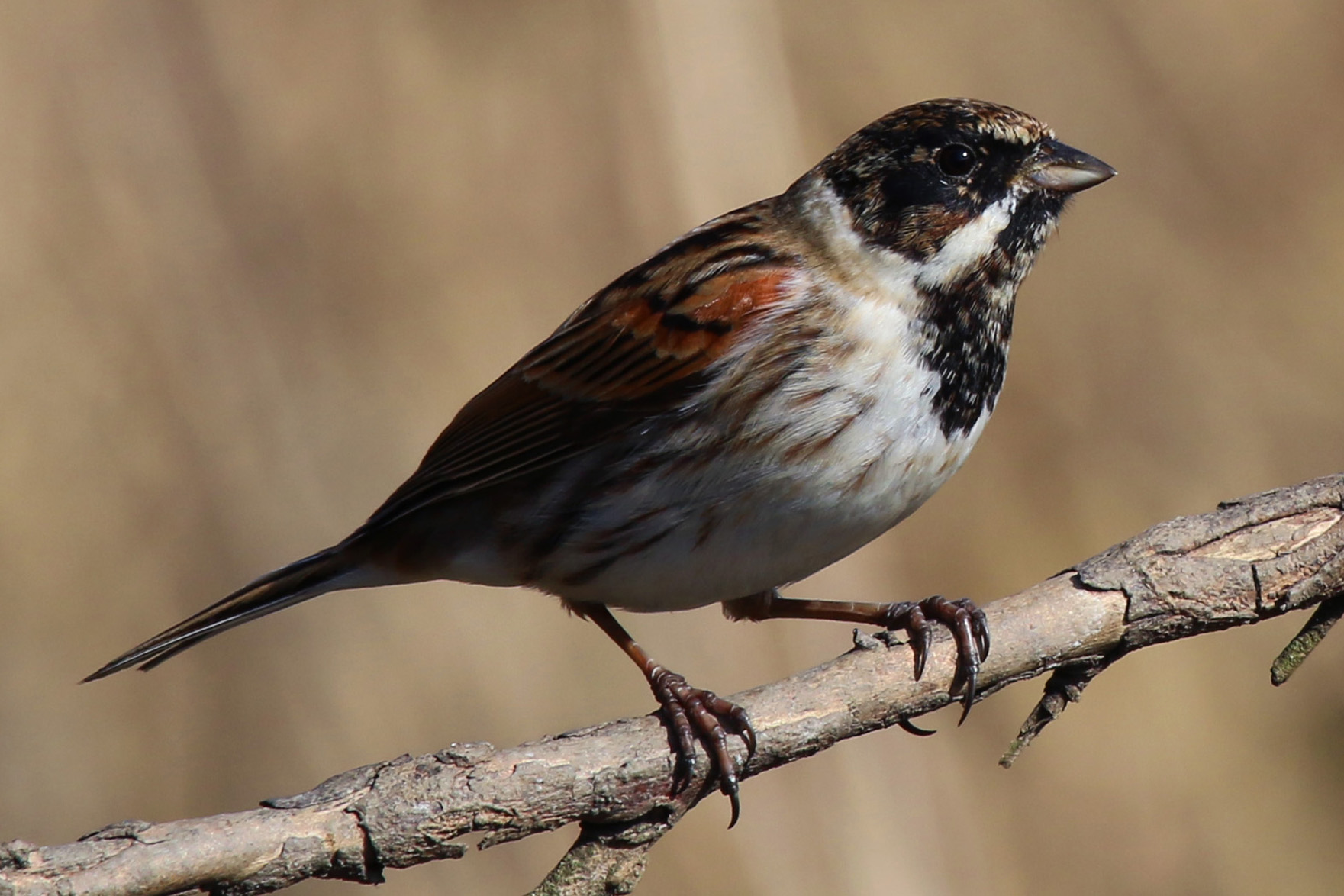
Wikipedia Common reed bunting (emberiza schoeniclus) m. By Charles J. Sharp - Own work, from Sharp Photography, sharpphotography, CC BY-SA 3.0, https://commons.wikimedia.org/w/index.php?curid=31607772 Source: WIKIPEDIA
Wikipedia Common_reed_bunting_(emberiza_schoeniclus)_m.jpg
First observed in 🇨🇭 on 2020-04-27.
Appearance and identification: ![]() A bit like General Burnsides: white sideburns, here curling back around a black head. [Link]
A bit like General Burnsides: white sideburns, here curling back around a black head. [Link]
Song: ![]() Song variable between individuals and breeding status: A short sequence of 3-5 brittle and buzzing sounds, repeated consistently with marked pauses. Last sound in phrase often has a conclusive feel, but not always. Paired males sing slower than unpaired. Unpaired male song also more contracted, making the pauses between each phrase stand out. [Link]
Song variable between individuals and breeding status: A short sequence of 3-5 brittle and buzzing sounds, repeated consistently with marked pauses. Last sound in phrase often has a conclusive feel, but not always. Paired males sing slower than unpaired. Unpaired male song also more contracted, making the pauses between each phrase stand out. [Link]
Calls: ![]() Contact call a sharp, descending and drawn "tseeeoo". A bit similar to Yellow Wagtail, but not as sharp and explosive. In migration a thick, and unmusical "chong" is often heard. [Link]
Contact call a sharp, descending and drawn "tseeeoo". A bit similar to Yellow Wagtail, but not as sharp and explosive. In migration a thick, and unmusical "chong" is often heard. [Link]
Physical details: length=15-16 cm,
wingspan=21-28 cm,
weight=16-25 g
Habitats:
Wetland
Song:
General: At Fanel I heard sequences of whistles and trills (buzzes?), just a few notes, but wandering up and down: m h lll, or l m hhh m. Listen to recording of 2022-06-25 13.37.28
Song: ![]() BirdID: A short sequence of 3-5 brittle and buzzing sounds, repeated consistently with marked pauses. Last sound in phrase often has a conclusive feel, but not always. [Link]
BirdID: A short sequence of 3-5 brittle and buzzing sounds, repeated consistently with marked pauses. Last sound in phrase often has a conclusive feel, but not always. [Link]
Song attributes:
Melody: stereotype melodic, slow, Frequency: 3-7 KHz Special sounds: trill
♫ Source: XENOCANTO
XC723277 - Common Reed Bunting - Emberiza schoeniclus - song.mp3
(song)

♫ Source: BirdNet
20220625_133728 birdnet - Rohrammer - Rohrammer - Neuchâtel.mp3
2022-06-25 13.37.28 (song)
♫ Source: XENOCANTO
XC665288 - Common Reed Bunting - Emberiza schoeniclus schoeniclus - song.mp3
(song)
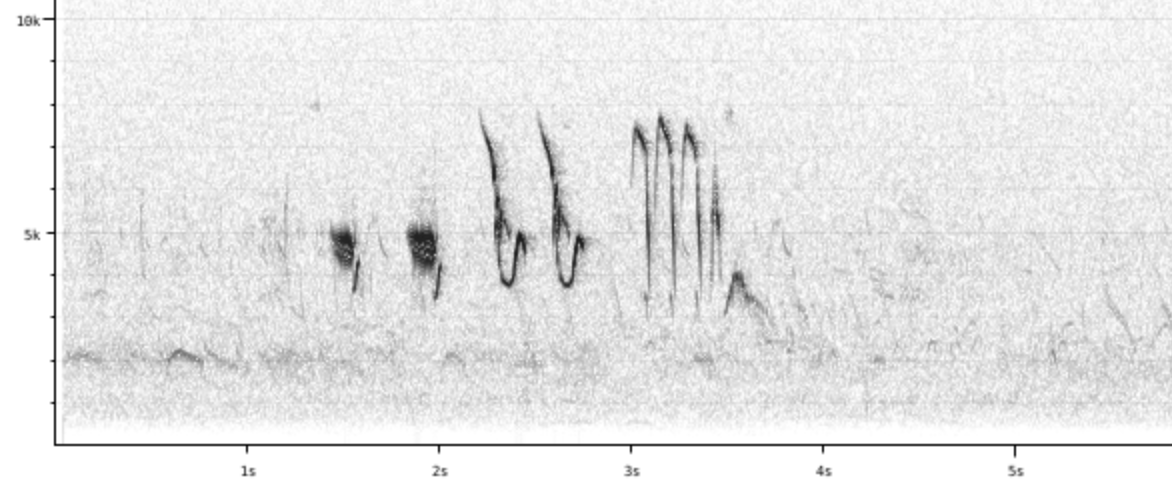
♫ Source: XENOCANTO
XC694863 - Common Reed Bunting - Emberiza schoeniclus - song.mp3
(song)

♫ Source: XENOCANTO
XC719864 - Common Reed Bunting - Emberiza schoeniclus - song.mp3
(song)
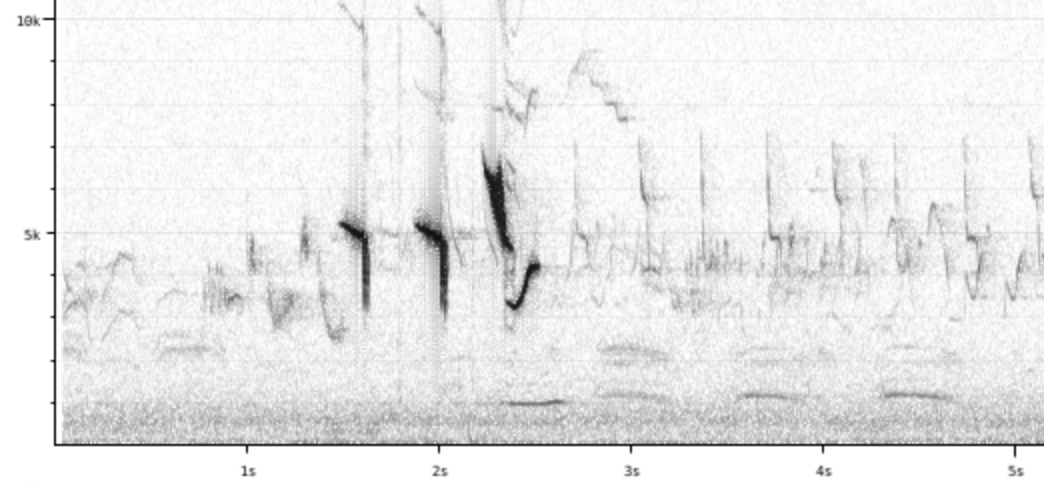
♫ Source: XENOCANTO
XC656275 - Common Reed Bunting - Emberiza schoeniclus - song.mp3
(song)

♫ Source: XENOCANTO
XC572969 - Common Reed Bunting - Emberiza schoeniclus - song.mp3
(song)

Call:
Automatically generated from Xeno-Canto recording
♫ Source: BirdNet
20210310_102526 birdnet 1276 - Reed Bunting - 2021-03-10 10:25:26 - Reed Bunting - Wetzikon.mp3
2021-03-10 10.25.26 Wetzikon (song?)
Grauammer im gleichen Busch wie Neuntoeter, mit typischem dunklen Brustfleck und dickem Schnabel. 2022-06-25 09.02.26 La Sauge
First observed in Mallorca on 2022-04-08.
Geography: ![]() Eher selten in CH. [Link]
Eher selten in CH. [Link]
Vocalization: ![]() Repeated in a monotonous manner, to form a typical soundscape of fields where it is numerous. Often compared to the sound of a chain of small keys. The phrase starts with a few staccato, ticking sounds that progress into a dry trill, followed by a short ritardando. [Link]
Repeated in a monotonous manner, to form a typical soundscape of fields where it is numerous. Often compared to the sound of a chain of small keys. The phrase starts with a few staccato, ticking sounds that progress into a dry trill, followed by a short ritardando. [Link]
Song: ![]() Sieht für mich eher braun aus als der Grau im Namen, mit einem Finken-Schnabel und Striche oben auf der Brust wie ein Drossel [Link]
Sieht für mich eher braun aus als der Grau im Namen, mit einem Finken-Schnabel und Striche oben auf der Brust wie ein Drossel [Link]
![]() Song diagnostic. A brittle, jingling and accelerating phrase of about 2 seconds duration. [Link]
Song diagnostic. A brittle, jingling and accelerating phrase of about 2 seconds duration. [Link]
Calls: ![]() Calls with a dry "chep" or a brittle "vitt". [Link]
Calls with a dry "chep" or a brittle "vitt". [Link]
Physical details: length=17-18 cm,
wingspan=26-32 cm,
weight=35-63 g
Habitats:
Agricultural
Song:
General: Song is an ascending trill or buzz that climbs about an octave - 4-8 KHz.
Song: ![]() Gesang steigend und immer schneller wie .... was? [Link]
Gesang steigend und immer schneller wie .... was? [Link]
Song attributes:
Melody: stereotype melodic, fast, Frequency: 4-8 KHz Special sounds: whoop, trill
♫ Source: XENOCANTO
XC632949 - Corn Bunting - Emberiza calandra - song.mp3
(song)

Call:
Automatically generated from Xeno-Canto recording
♫ Source: BirdNet
20220408_153709 birdnet - Grauammer - Grauammer - El Palmer.mp3
2022-04-08 15.37.09 Mallorca (song?)
Profile Wikipedia eBird Vogelwarte BirdLife ZH ornitho.ch Xeno-Canto BirdID NABU

Wikipedia: Ortolan bunting Source: OTHER
1200px-Ortolan_bunting_in_Sierra_de_Guara%2C_Aragon%2C_Spain.jpg
Nur 1-5 Brutpaare in der Schweiz nach Vogelwarte.ch
Vocalization: ![]() Distinct bunting-like timbre with very prominent harmonics. [Link]
Distinct bunting-like timbre with very prominent harmonics. [Link]
Song: ![]() Song simple, but varies from region to region. Sometimes structurally similar to yellowhammer, but slower, more melancholic, and with more clearly audible harmonics f.ex. "tze-ti tze-ti tze-ti tweeeee". Beginning with repeated alternating notes (tze-ti) and ending on a lower note fading out with a rising pitch. Sometimes without the ending note (like yellowhammer). [Link]
Song simple, but varies from region to region. Sometimes structurally similar to yellowhammer, but slower, more melancholic, and with more clearly audible harmonics f.ex. "tze-ti tze-ti tze-ti tweeeee". Beginning with repeated alternating notes (tze-ti) and ending on a lower note fading out with a rising pitch. Sometimes without the ending note (like yellowhammer). [Link]
Calls: ![]() Calls: a vaguely House Sparrow-like "chepp", with a ringing quality, and a sharper cut-off "zeep". [Link]
Calls: a vaguely House Sparrow-like "chepp", with a ringing quality, and a sharper cut-off "zeep". [Link]
Physical details: length=16-17 cm,
wingspan=23-29 cm,
weight=81-96 g
Habitats:
Agricultural
Song:
First about 4 hlhlhlhl then a single higher or lower note
Song attributes:
Melody: stereotype melodic, fast, Frequency: 3-5 KHz
♫ Source: XENOCANTO
XC726530 - Ortolan Bunting - Emberiza hortulana - song recorded in Spain, first 4 hlhlhlhl then a single higher note.mp3
Spain (song)

♫ Source: XENOCANTO
XC727606 - Ortolan Bunting - Emberiza hortulana - song, first 4 hlhlhlhl, then 1 or 2 swoops.mp3
(song)

♫ Source: XENOCANTO
XC652668 - Ortolan Bunting - Emberiza hortulana - first 4 or so hl, then a lower note - seems the close is highly variable.mp3
(song)

Call:
Automatically generated from Xeno-Canto recording
♫ XC652668 - Ortolan Bunting - Emberiza hortulana - first 4 or so hl, then a lower note - seems the close is highly variable. Source: XENOCANTO
XC652668 - Ortolan Bunting - Emberiza hortulana - first 4 or so hl, then a lower note - seems the close is highly variable.mp3
(song?)

Profile Wikipedia eBird Vogelwarte BirdLife ZH ornitho.ch Xeno-Canto BirdID NABU

Wikipedia: Rock bunting Source: OTHER
1200px-Rock_Bunting_%28Cochem%29.jpg
General: ![]() The rock bunting (Emberiza cia) is a passerine bird in the bunting family Emberizidae, a group now separated by most modern authors from the finches, Fringillidae.
[more]
The rock bunting (Emberiza cia) is a passerine bird in the bunting family Emberizidae, a group now separated by most modern authors from the finches, Fringillidae.
[more]
Song: ![]() Song variable, but usually distinct. [Link]
Song variable, but usually distinct. [Link]
Calls: ![]() Recalls stuttering Dunnock. Jerky, uneven thythm and tempo, with fairly large register and recognizible bunting timbre. May include mimicry. Alarm call a thin, short "seeeep", with clipped ending, similar to Cirl Bunting. [Link]
Recalls stuttering Dunnock. Jerky, uneven thythm and tempo, with fairly large register and recognizible bunting timbre. May include mimicry. Alarm call a thin, short "seeeep", with clipped ending, similar to Cirl Bunting. [Link]
Physical details: length=16 cm,
wingspan=21-27 cm,
weight=21-29 g
Habitats:
Mountain
Song:
AppearanceAndIdentification: orange-brauner bauch, weisse brust+kopf mit 3 schwarzen streifen am kopf (unter/am/ueber Augen), braun+dunkelbraun auf Fluegeln; aber Weibchen eher braun
Song: Notes from 2022: Short song, relatively long pause, repeated with slight variation? Has a very short triller of just 3 notes.
May have heard and seen one walking parallel to the Aa on the way to Pfaeffikersee today, though the visual ID is very uncertain; the Xeno-Canto song here sounds different than my 2022 description - musical like a chaffinch but rising, not falling.
Song attributes:
Melody: stereotype melodic, fast, Frequency: 2-9 KHz Special sounds: mimicry, trill
♫ Source: XENOCANTO
XC653755 - Rock Bunting - Emberiza cia - song, recorded in Spain.mp3
Spain (song)

Profile Wikipedia eBird Vogelwarte BirdLife ZH ornitho.ch bird-song.ch Xeno-Canto BirdID NABU
Goldammer am Aabach, Wetzikon. 2021-03-10 10.36.28 Wetzikon
First observed in 🇨🇭 on 2020-05-26.
Habe ihn im Fehraltorfer-Wald endlich gesehen
als er von einem Baum in die Spitze eines anderen geflogen ist.
The English language Wikipedia page for bunting says: The genus name Emberiza is from Old German Embritz, a bunting.[6] The origin of the English "bunting" is unknown. I always though it makes little sense that these birds are Ammer in German and Hammer in English, though neither seems logical. Ammer is just a corruption of Embritz, and Hammer presumably a folk etymology - 'oh, this sounds a bit like hammer, let's call it that!'.
vogelwarte.ch says it prefers areas around agriculture: hedges, orchards, fields, meadows.
Heard in the woods next to farmer's fields in Fehraltorf. (Weidholzweg, next farm is Tuschacher.
The breast has a checkerd pattern apparently typical of buntings (Emberizidae),
that to me resembles that of many thrushes - but this seems to be coincidence.
Song: ![]() Kurzes Liedchen. „ Wie wie wie hab ich dich liiieb“ Das „Lieb“ ist meist etwas tiefer, kann aber auch höher sein oder doppelt, dabei das eine höher und das andere tiefer. Sehr variabel!
[Link]
Kurzes Liedchen. „ Wie wie wie hab ich dich liiieb“ Das „Lieb“ ist meist etwas tiefer, kann aber auch höher sein oder doppelt, dabei das eine höher und das andere tiefer. Sehr variabel!
[Link]
![]() Song a series of 6-8 (or more) slightly ascending "tze" 's, rising in volume and ending on a sustained note, which may be lower or higher than the others. Often rendered as "little-bit-of-cheese-and-no-bread". Last note is often omitted, which may lead to confusion with Cirl Bunting. Timbre with prominent harmonics as in other bunting songs. [Link]
Song a series of 6-8 (or more) slightly ascending "tze" 's, rising in volume and ending on a sustained note, which may be lower or higher than the others. Often rendered as "little-bit-of-cheese-and-no-bread". Last note is often omitted, which may lead to confusion with Cirl Bunting. Timbre with prominent harmonics as in other bunting songs. [Link]
Calls: ![]() „zick“ „zeck“
[Link]
„zick“ „zeck“
[Link]
![]() Distinct contact call: A short and brittle "zeet", rich in harmonics. [Link]
Distinct contact call: A short and brittle "zeet", rich in harmonics. [Link]
Physical details: length=16 cm,
wingspan=23-29 cm,
weight=25-36 g
Habitats:
Agricultural
Song:
High-pitched, two notes that sound like one, repeated 10-12 times, with a higher tweet and then a whistle that sounds higher to me but usually shows up on the sonogram as the same range.
The mnemonic for the staccato song in German is: «Wie, wie, wie, wie hab ich dich lieb». See the image for dialects noted by yellowhammers.net - the most common Swiss dialect is said to be XlB, though I don't always hear the second note myself (and interestingly enough, it doesn't play on my Bose headphones). Pavel Pipek of the yellowhammers project kindly explained to me: 'Regarding the XlB and other dialects, these codes were defined by a Danish scientist Poul Hansen in his paper from 1985. In this case Xl stands for a syllable with high frequency (and long) and B for a syllable with low frequency.'
Song attributes:
Melody: simple rhythmic, fast, Frequency: 4-8 KHz Singing season: 03-01 - 09-30 Dawn chorus start, 45 minutes before dawn.
Call:
Automatically generated from Xeno-Canto recording
♫ Source: BirdNet
20210421_083716 birdnet 1456 - Yellowhammer, I said Song Thrush - Yellowhammer - Fehraltorf.mp3
2021-04-21 08.37.16 Fehraltorf (song?)
Profile Wikipedia eBird Vogelwarte BirdLife ZH ornitho.ch Xeno-Canto BirdID NABU
Zaunammer in den Reben bei Maienfeld. 2021-05-29 08.48.26 Maienfeld
First observed in 🇨🇭 on 2021-05-29.
Als Anfänger, hätte ich gedacht, dies wäre eine Goldammer, da beide gelb mit braunen Details sind; BirdID meint sie sind kompakter. Das Männchen ist eher gelb und hat was für mich wie drei brauen Streifen im Gesicht aussehen. Die Goldammer hat kaum braun am Kopf. Das Weibchen ist weniger gelb und mehr braun. Siehe BirdID für gute Bilder und Beschreibung der Erkennungsmerkmale.
BirdID says song like yellowhammer with no ending. I see what they mean - it's more like 16 or so trilled repetitions of the same note, and no leap up to 'lieb' as in the German Goldammer mnemonic.
Song: ![]() Wie Goldammer, aber ohne das „lieb“.und etwas tiefer. Ähnlich Klappergrasmücke.
[Link]
Wie Goldammer, aber ohne das „lieb“.und etwas tiefer. Ähnlich Klappergrasmücke.
[Link]
![]() Song variable, but can generally be described as a Yellowhammer phrase with no ending, or an Arctic Warbler with bunting timbre. Tempo also variable, but rhythm always even. [Link]
Song variable, but can generally be described as a Yellowhammer phrase with no ending, or an Arctic Warbler with bunting timbre. Tempo also variable, but rhythm always even. [Link]
Calls: ![]() Sehr ähnlich denen der obigen Art [Goldammer].
[Link]
Sehr ähnlich denen der obigen Art [Goldammer].
[Link]
![]() Alarm call a thin "tseeep", similar to Rock Bunting, but more drawn out. [Link]
Alarm call a thin "tseeep", similar to Rock Bunting, but more drawn out. [Link]
Physical details: length=15 cm,
wingspan=22-25 cm,
weight=21-29 g
Habitats:
Agricultural
Song:
biologie-wissen.info: sings beg Feb to mid July; me: long trill similar to yellowhammer
Song attributes:
Melody: simple rhythmic, fast, Frequency: 3-6 KHz
Call:
Automatically generated from Xeno-Canto recording
♫ Source: BirdNet
20220410_143737 birdnet - Zaunammer, eventuell auch Girlitz, Zippammer - Zaunammer.mp3
2022-04-10 14.37.37 Mallorca (song?)
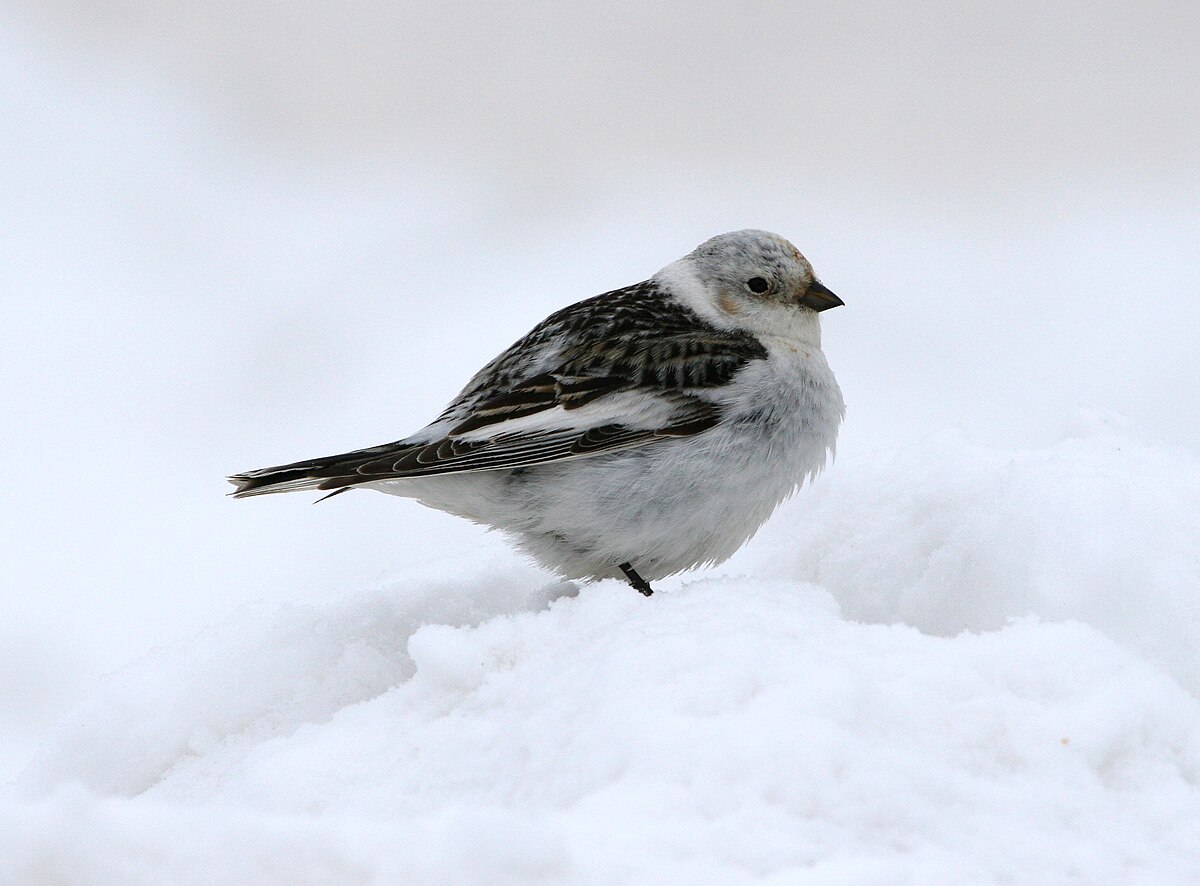
Wikipedia: Snow bunting Source: OTHER
1200px-Plectrophenax_nivalis1.jpg
This bird appears across the great seas in the following continents:
Europe, North America.
Deutschland: Wintergast
Song: ![]() Song simple and melodic. 2-5 syllable motifs with fairly wide tonal range. Can be confused with Lapland Bunting, but is much purer in tone with a less jingling timbre. Local dialects. [Link]
Song simple and melodic. 2-5 syllable motifs with fairly wide tonal range. Can be confused with Lapland Bunting, but is much purer in tone with a less jingling timbre. Local dialects. [Link]
Calls: ![]() Contact call a short, melodic and rapidly descending "peeuu". Often alternating with a rattling "trrreet". "Peeuu"-call quite similar to Lapland Bunting, but harder, purer in tone and less nasal. [Link]
Contact call a short, melodic and rapidly descending "peeuu". Often alternating with a rattling "trrreet". "Peeuu"-call quite similar to Lapland Bunting, but harder, purer in tone and less nasal. [Link]
Physical details: length=16-17 cm,
wingspan=32-38 cm,
weight=28-50 g
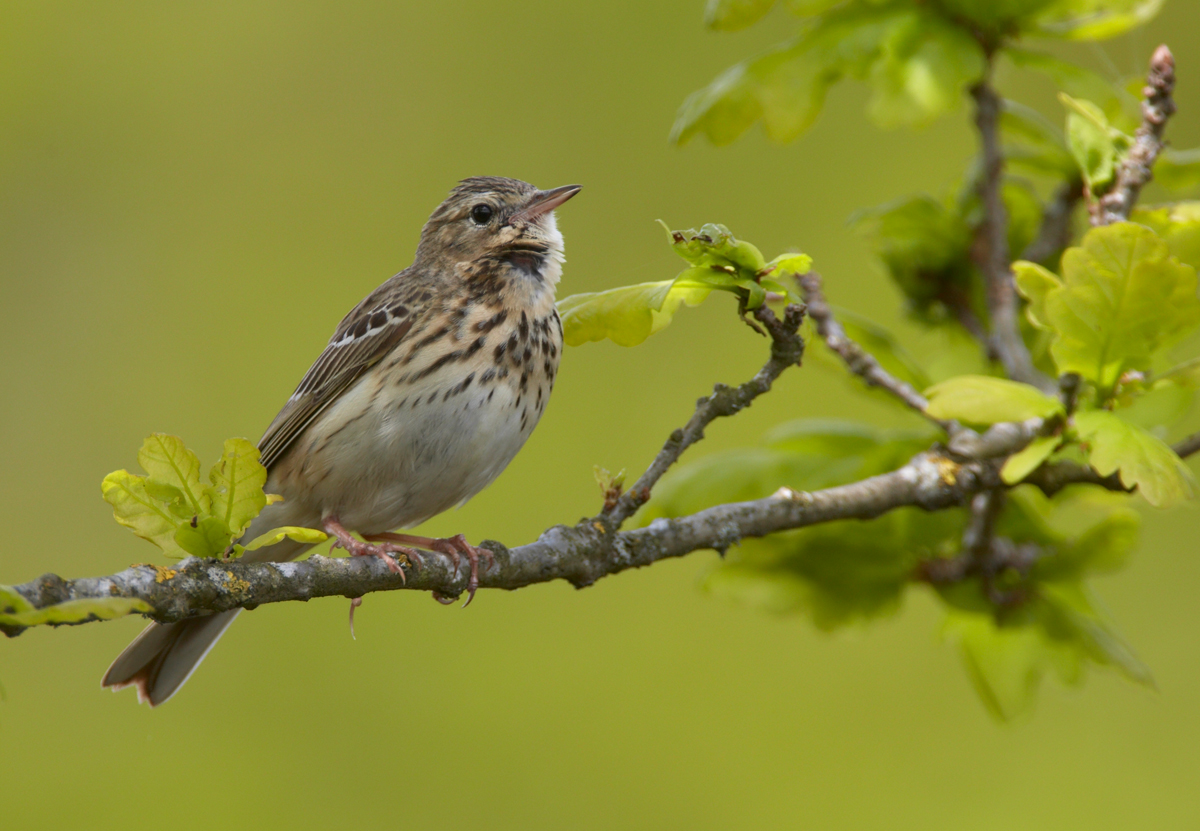
Wikipedia baumpieper Anthus trivialis. Von Vogelartinfo - Eigenes Werk, GFDL 1.2, Link Source: WIKIPEDIA
Wikipedia baumpieper Anthus_trivialis.jpg
First observed in 🇨🇭 on 2020-06-12.
Sieht aus wie ein Drossel
Song: ![]() Mehrere unterschiedliche Tonreihen aneinandergefügt. Zuletzt „zia zia zia ziah“. Zuerst auf Baum sitzend, dann im Singflug, Zia-Rufe während Gleitflug (Fallschirmvogel) [Link]
Mehrere unterschiedliche Tonreihen aneinandergefügt. Zuletzt „zia zia zia ziah“. Zuerst auf Baum sitzend, dann im Singflug, Zia-Rufe während Gleitflug (Fallschirmvogel) [Link]
![]() Song characteristic. Starts with a series of Chaffinch-like "che-che-che" which gives way to long, descending, "ricocheting" whistling notes (especially at the end of song-flight). [Link]
Song characteristic. Starts with a series of Chaffinch-like "che-che-che" which gives way to long, descending, "ricocheting" whistling notes (especially at the end of song-flight). [Link]
Calls: ![]() “psiet“ etwas nach unten gezogen. Auch „zieh“
[Link]
“psiet“ etwas nach unten gezogen. Auch „zieh“
[Link]
![]() Flight call a short buzzing "tzzzeet". Given at even pitch, and in a fuller tone than Red-Throated Pipit. [Link]
Flight call a short buzzing "tzzzeet". Given at even pitch, and in a fuller tone than Red-Throated Pipit. [Link]
Physical details: length=15 cm,
wingspan=25-27 cm,
weight=18-29 g
Habitats:
Mountain
Song or calls similar to:
European greenfinch, European greenfinch.
Song:
Reminds me of a greenfinch - series of trills, whoops and other sounds with a long pause
Song attributes:
Melody: simple rhythmic, slow, Frequency: medium (1-5 KHz) Special sounds: whoop, trill
♫ Source: XENOCANTO
XC570506 - Tree Pipit - Anthus trivialis - song.mp3
(song)

♫ Source: XENOCANTO
XC649035 - Tree Pipit - Anthus trivialis - song.mp3
(song)

Call:
Automatically generated from Xeno-Canto recording
♫ Source: BirdNet
20200612_130218 birdnet 628 - Tree pipit.mp3
2020-06-12 13.02.18 Sils (song?)
Profile Wikipedia eBird Vogelwarte BirdLife ZH ornitho.ch bird-song.ch Xeno-Canto BirdID NABU
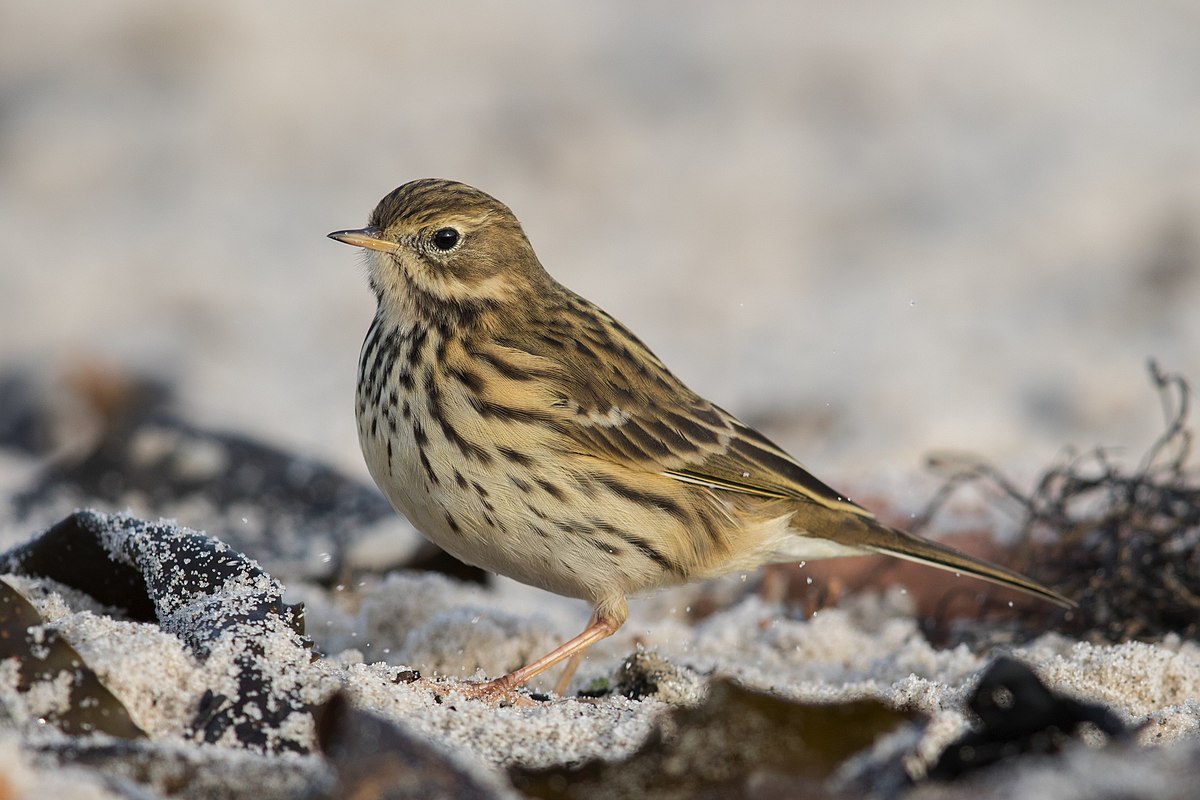
Wikipedia: Meadow pipit Source: OTHER
1200px-Wiesenpieper_Meadow_pipit.jpg
First observed in 🇨🇭 on 2021-06-27.
Looks like Misteldrossel
Song: ![]() Ähnlich Baumpieper, aber ohne Zia-Rufe. Vollständiger Gesang nur in flatterndem Singflug. Lange Strophen. Mittelstück meist zart und hoch [Link]
Ähnlich Baumpieper, aber ohne Zia-Rufe. Vollständiger Gesang nur in flatterndem Singflug. Lange Strophen. Mittelstück meist zart und hoch [Link]
![]() Song very similar to Rock Pipit, but tone less full and more brittle. Lacks Rock Pipit's closing trill, and beginning is less "hammering". [Link]
Song very similar to Rock Pipit, but tone less full and more brittle. Lacks Rock Pipit's closing trill, and beginning is less "hammering". [Link]
Calls: ![]() fast tonlos „ist, ist.“
[Link]
fast tonlos „ist, ist.“
[Link]
![]() Contact call a short "eest". Similar to Rock Pipit but shorter,cleaner and most often in quick series. Warning call a sharp, high pitched "tzeet". Also a rattling "trrrrt". [Link]
Contact call a short "eest". Similar to Rock Pipit but shorter,cleaner and most often in quick series. Warning call a sharp, high pitched "tzeet". Also a rattling "trrrrt". [Link]
Physical details: length=14 cm,
wingspan=22-25 cm,
weight=15-22 g
Habitats:
Mountain
Looks similar to:
Mistle thrush.
Song:
Single note, possibly rising at the end. (Or: long 4 second phrases, gradually louder then softer; swoopy or whoopy.) Sings in flight. BirdID: Song very similar to Rock Pipit, but tone less full and more brittle. Lacks Rock Pipit's closing trill, and beginning is less "hammering". - but what does a rock pipit sound like?
Song attributes:
Melody: one note, fast, Frequency: medium (1-5 KHz)
♫ Source: XENOCANTO
XC722919 - Meadow Pipit - Anthus pratensis - song.mp3
(song)

Call:
Automatically generated from Xeno-Canto recording
♫ Source: BirdNet
20210627_113544 birdnet 1779 - Meadow Pipit - 2021-06-27 11:35:44 - Meadow Pipit - Grabs.mp3
2021-06-27 11.35.44 Grabs (song?)
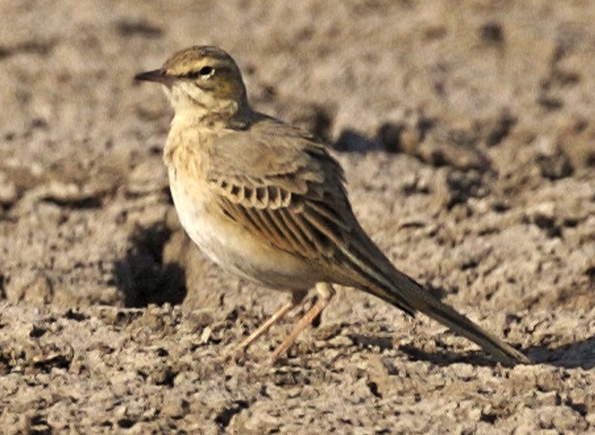
Wikipedia: Tawny pipit Source: OTHER
AnthusCampestris_cropped.jpg
First observed in 🇨🇭 on 2022-10-02.
Langer schlanker Vogel, man sagt aehnlicher wie eine Schafstelze
Song: ![]() Song simple. Consists of three notes merged in a short, continuous and ringing "tsee-ro-ee", given every 1-2 seconds. Timbre is wagtail-like and intonation variable, but consistent in each song. Flight call similar in timbre, like a cross between Yellow Wagtail and House Sparrow (song). Thinner and more wagtail-like than Richard's Pipit. [Link]
Song simple. Consists of three notes merged in a short, continuous and ringing "tsee-ro-ee", given every 1-2 seconds. Timbre is wagtail-like and intonation variable, but consistent in each song. Flight call similar in timbre, like a cross between Yellow Wagtail and House Sparrow (song). Thinner and more wagtail-like than Richard's Pipit. [Link]
Physical details: length=16 cm,
wingspan=25-28 cm,
weight=24-32 g
Habitats:
Agricultural
Looks similar to:
Western yellow wagtail.
Song:
Song simple. Consists of three notes merged in a short, continuous and ringing "tsee-ro-ee", given every 1-2 seconds.
Song attributes:
Melody: stereotype melodic, slow, Frequency: 2-6 KHz
♫ Source: XENOCANTO
XC726515 - Tawny Pipit - Anthus campestris - song.mp3
(song)

Bergpieper glaube ich. 2023-05-27 09.38.16 Amden Hinder Hoechi
First observed in 🇨🇭 on 2020-07-19.
Saw in Toggenburg on our FOK weekend 2021.
Appearance and identification: ![]() wie ein grauer Fink. [Link]
wie ein grauer Fink. [Link]
Vocalization: ![]() Similar to Rock Pipit. [Link]
Similar to Rock Pipit. [Link]
Song: ![]() Monoton, GAR NICHT BERGIG. Tsilp tsilp, gleich note, wiederholt sich über 10+ Sekunden, leicht schneller aber nicht zu viel. [Link]
Monoton, GAR NICHT BERGIG. Tsilp tsilp, gleich note, wiederholt sich über 10+ Sekunden, leicht schneller aber nicht zu viel. [Link]
![]() Meist drei nicht scharf abgesetzte lange Tonreihen. Singflug. Mittelteilstück rauer und geräuschhafter als bei obiger Art [Wiesenpieper]. [Link]
Meist drei nicht scharf abgesetzte lange Tonreihen. Singflug. Mittelteilstück rauer und geräuschhafter als bei obiger Art [Wiesenpieper]. [Link]
![]() Song slightly more melodious, often with Tree Pipit like glissandi at end of phrase. [Link]
Song slightly more melodious, often with Tree Pipit like glissandi at end of phrase. [Link]
Calls: ![]() „fist“, etwas rauer als bei obiger Art [Wiesenpieper].
[Link]
„fist“, etwas rauer als bei obiger Art [Wiesenpieper].
[Link]
![]() Contact call sharper and more drawn. [Link]
Contact call sharper and more drawn. [Link]
Physical details: length=17 cm,
wingspan=24-29 cm,
weight=19-27 g
Habitats:
Mountain
Song:
![]() Er singt überwiegend fliegend ein ein- bis zweisilbiges „zip“ oder „tsi tsi“. [Link]
Er singt überwiegend fliegend ein ein- bis zweisilbiges „zip“ oder „tsi tsi“. [Link]
Song attributes:
Melody: one note, fast, Frequency: 3-7 KHz
♫ Source: XENOCANTO
XC716570 - Water Pipit - Anthus spinoletta - song, recorded in Spain.mp3
Spain (song)

Call:
Automatically generated from Xeno-Canto recording
♫ Source: BirdNet
20200719_140813 birdnet 814 nahe Bergstation Urnerboden - Water pipit.mp3
2020-07-19 14.08.13 Bergstation Urnerboden (song?)

Wikipedia: Red-throated pipit Source: OTHER
1200px-Red-throated_Pipit.jpg
This bird appears across the great seas in the following continents:
Europe, North America, Africa, Asia.
General: ![]() The red-throated pipit (Anthus cervinus) is a small passerine bird which breeds in the far north of Europe and the Palearctic, with a foothold in northern Alaska. It is a long-distance migrant moving in winter to Africa, south and east Asia and west coast United States. It is a vagrant to western Europe.
[more]
The red-throated pipit (Anthus cervinus) is a small passerine bird which breeds in the far north of Europe and the Palearctic, with a foothold in northern Alaska. It is a long-distance migrant moving in winter to Africa, south and east Asia and west coast United States. It is a vagrant to western Europe.
[more]
Profile Wikipedia eBird Vogelwarte BirdLife ZH ornitho.ch bird-song.ch Audubon AllAboutBirds Xeno-Canto BirdID NABU
White wagtail at edge of field near Mesikon 2020-04-25 07.21.02 Luppmen
First observed in Iceland on 2015-06-05.
This bird appears across the great seas in the following continents:
Europe, North America, Africa, Asia.
![]() The white wagtail (Motacilla alba) is a small passerine bird in the family Motacillidae, which also includes pipits and longclaws. The species breeds in much of Europe and the Asian Palearctic and parts of North Africa. It has a toehold in Alaska as a scarce breeder. It is resident in the mildest parts of its range, but otherwise migrates to Africa. In Ireland and Great Britain, the darker subspecies, the pied wagtail or water wagtail[2] (M. a. yarrellii) predominates. In total, there are between 9 and 11 subspecies.
[more]
The white wagtail (Motacilla alba) is a small passerine bird in the family Motacillidae, which also includes pipits and longclaws. The species breeds in much of Europe and the Asian Palearctic and parts of North Africa. It has a toehold in Alaska as a scarce breeder. It is resident in the mildest parts of its range, but otherwise migrates to Africa. In Ireland and Great Britain, the darker subspecies, the pied wagtail or water wagtail[2] (M. a. yarrellii) predominates. In total, there are between 9 and 11 subspecies.
[more]
Song: ![]() Song either slow and primitive, consisting of sharp falling notes given by perched birds, or longer fast and energic bursts in excited song-flight. [Link]
Song either slow and primitive, consisting of sharp falling notes given by perched birds, or longer fast and energic bursts in excited song-flight. [Link]
Calls: ![]() Contact calls short and sharp. Usually with disyllabic, "bouncing" quality, and with each syllable only accented, not clearly separated from the other (see Grey Wagtail). [Link]
Contact calls short and sharp. Usually with disyllabic, "bouncing" quality, and with each syllable only accented, not clearly separated from the other (see Grey Wagtail). [Link]
Physical details: length=18 cm,
wingspan=25-30 cm,
weight=17-25 g
Habitats:
Settlement
Song:
General: Usually just calls. This song is just a few chirpy slurs, sometimes rising-rising-falling.
Song: ![]() Zirpt wie ein Sperling aber weniger Noten. Lh lh lh [Link]
Zirpt wie ein Sperling aber weniger Noten. Lh lh lh [Link]
Song attributes:
Melody: stereotype melodic, slow, Frequency: 2-7 KHz
♫ Source: XENOCANTO
XC694995 - White Wagtail - Motacilla alba - song recorded in Spain.mp3
Spain (song)

Call:
bird-song.ch: zweisilbig «zilipp» oder einsilbig «zipp»
♫ Source: XENOCANTO
XC644775 - White Wagtail - Motacilla alba alba - call, recorded in Estonia.mp3
(call)

Call attributes:
Call melody: one note, slow, Frequency: 3-7 KHz,
Presence: 03-01 - 10-28
Schafstelze. 2024-02-02 16.00.54 Laos
First observed in Mallorca on 2022-04-12.
Yellow, gray head, white mask.
Song: ![]() Song primitive and less striking. Beware differences in calls and songs between different subspecies. [Link]
Song primitive and less striking. Beware differences in calls and songs between different subspecies. [Link]
Calls: ![]() Contact call characteristic and widely used; a sharp, drawn out "pseeeoo" with an accented ending falling in pitch. A variable phrase with two or three notes resembling the contact call in timbre. [Link]
Contact call characteristic and widely used; a sharp, drawn out "pseeeoo" with an accented ending falling in pitch. A variable phrase with two or three notes resembling the contact call in timbre. [Link]
Physical details: length=17 cm,
wingspan=23-27 cm,
weight=14-21 g
Habitats:
Wetland
Looks similar to:
Tawny pipit.
Song:
Just a few notes, call seems to be common but song rare. Very short chirp of ~ 1 sec, long pause of 3 secs. At Wauwilermoos it seemed to be 'Twee tweetwee (higher note:) twee!'
Song attributes:
Melody: stereotype melodic, slow, Frequency: 3-9 KHz
♫ Source: XENOCANTO
XC721189 - Western Yellow Wagtail - Motacilla flava cinereocapilla - song.mp3
(song)
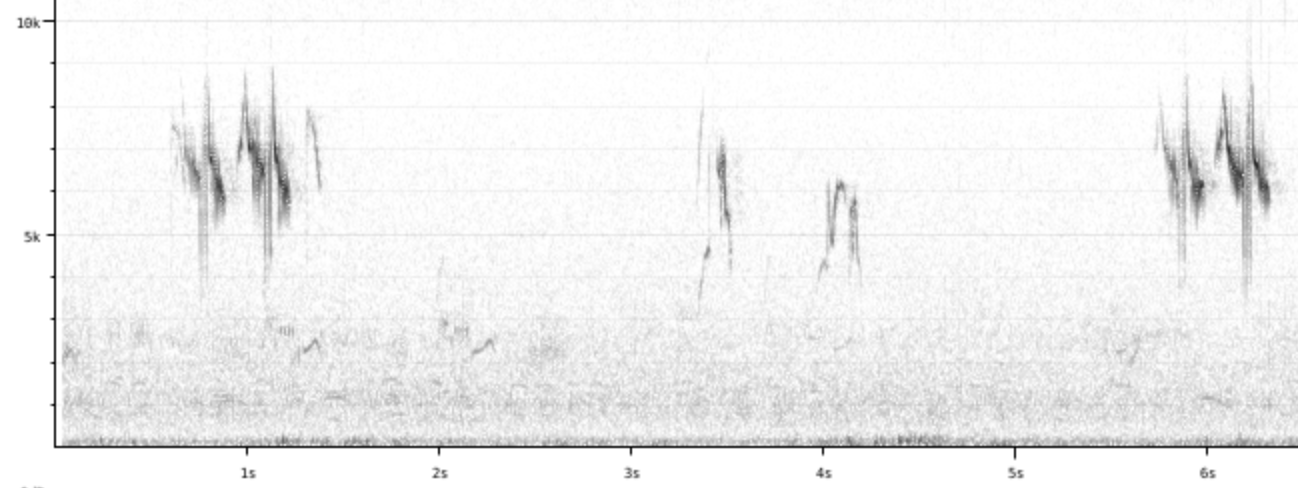
Call:
General: Single note repeated
Song: ![]() sperling ähnliches lh lh lh. Dachte die wären melodisch?? Nein. BL chirpy ml ml [Link]
sperling ähnliches lh lh lh. Dachte die wären melodisch?? Nein. BL chirpy ml ml [Link]
♫ Source: XENOCANTO
XC653784 - Western Yellow Wagtail - Motacilla flava flavissima - call.mp3
(call)
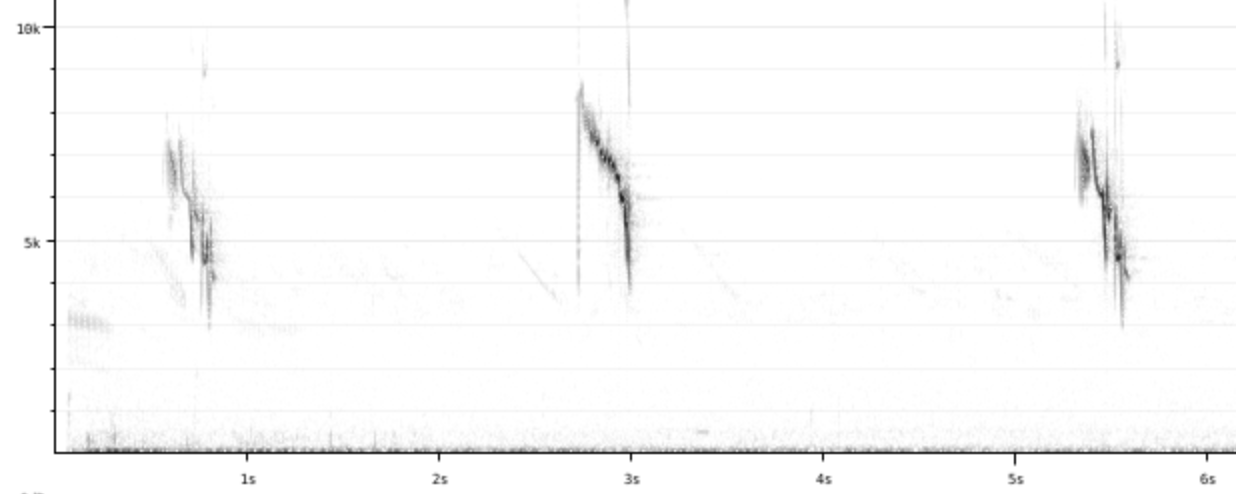
Call attributes:
Call melody: one note, slow, Frequency: 3-9 KHz, Special sounds: swoop.
Gebirgsstelze am Bach beim Klingnauer Stausee. 2022-02-05 14.16.30 Klingnauer Stausee (man-made lake)
First observed in 🇨🇭 on 2022-02-05.
Yellow breast and butt end, white belly, light grey head and back, white eye stripe and stripe above black beard, dark wings with 3 white V's, long tail.
Song: ![]() Song simple but variable. Sometimes with more elaborate song-flight like White Wagtail. [Link]
Song simple but variable. Sometimes with more elaborate song-flight like White Wagtail. [Link]
Calls: ![]() Contact call short, metallic and with a clipped ending. Often disyllabic, "tzeet-tzeet", with each syllable more separated than in White Wagtail, and timbre more "dirty". Often starts with the contact call, followed by short melodic phrases. [Link]
Contact call short, metallic and with a clipped ending. Often disyllabic, "tzeet-tzeet", with each syllable more separated than in White Wagtail, and timbre more "dirty". Often starts with the contact call, followed by short melodic phrases. [Link]
Physical details: length=18-19 cm,
wingspan=25-27 cm,
weight=14-22 g
Habitats:
Wetland
Song:
![]() BirdID says Song simple but variable. I hear trills up to 2 seconds long and chirps. Another description says a series of calls, not very melodic. I noted zwitx3, sometimes hhhhhll. [Link]
BirdID says Song simple but variable. I hear trills up to 2 seconds long and chirps. Another description says a series of calls, not very melodic. I noted zwitx3, sometimes hhhhhll. [Link]
Song attributes:
Melody: stereotype melodic, fast, Frequency: high (3-9 KHz) Special sounds: trill
♫ Source: XENOCANTO
XC767550 - Grey Wagtail - Motacilla cinerea - song with trills and a cheek-cheek.mp3
(song)

♫ Source: XENOCANTO
XC757193 - Grey Wagtail - Motacilla cinerea - one-note song recorded in Germany.mp3
Germany (song)

Great tit / Kohlmeise (Parus major)
Profile Wikipedia eBird Vogelwarte BirdLife ZH ornitho.ch bird-song.ch Xeno-Canto BirdID NABU
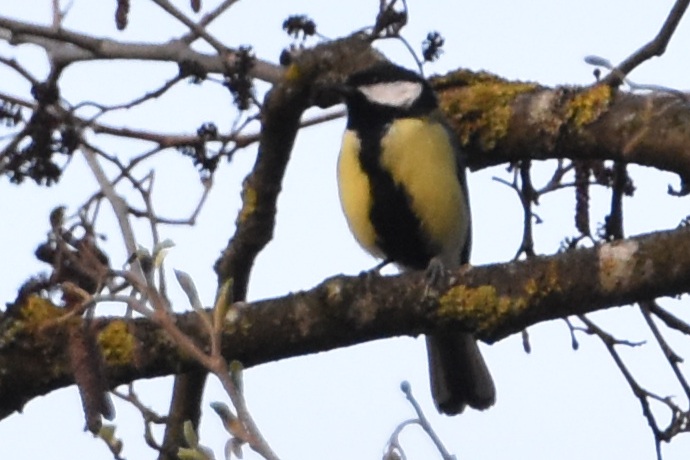
Kohlmeise auf ast. 2020-04-13 10.29.27 Luppmen
First observed in 🇨🇭 on 2019-04-22.
Most common year-round bird at our house.
Often seen at the suet balls we hang out, or in fall at our sunflowers.
It's said that they will sound a false alarm at a feeding source, knowing that other birds listen for
their alarms and flee!
There are many entertaining stories in the Norwegian book 'The Secret Life of Small Birds'.
It's a favorite food of the Eurasian sparrowhawk, though I'm sure cats are the greater danger.
They flit from tree to tree in small scattered groups,
and often avail themselves of the seeds on our sunflowers. They can be heard on the Luppman
in Fehraltorf at any time of year and day.
Etymology: ![]() (Conrad) Gessner also notes that the coal tit was known as Kohlmeiß in German – the literal equivalent of its English name, though in its modern orthography Kohlmeise it refers to the great tit (Parus major). That bird was in Gessner's day usually called Spiegelmeiß ("multicoloured tit"[5]), Brandtmeiß ("burnt tit") or grosse Meiß ("great tit") in German. [Link]
(Conrad) Gessner also notes that the coal tit was known as Kohlmeiß in German – the literal equivalent of its English name, though in its modern orthography Kohlmeise it refers to the great tit (Parus major). That bird was in Gessner's day usually called Spiegelmeiß ("multicoloured tit"[5]), Brandtmeiß ("burnt tit") or grosse Meiß ("great tit") in German. [Link]
Behavior: ![]() 'Studies in Europe on tits showed a 2-way doubly asymmetric interaction: the great tit (Parus major) is dominant over the blue tit (Cyanistes caeruleus)
during the nonbreeding season (Haftorn 1993), and the smaller blue tit is competitively dominant during the breeding season (Dhondt 1989).'
Another cited work notes that the coal tit is considered the bottom of the hierarchy in Scandinavia. [Interspecific dominance relationships and hybridization between black-capped and mountain chickadees | Behavioral Ecology]
'Studies in Europe on tits showed a 2-way doubly asymmetric interaction: the great tit (Parus major) is dominant over the blue tit (Cyanistes caeruleus)
during the nonbreeding season (Haftorn 1993), and the smaller blue tit is competitively dominant during the breeding season (Dhondt 1989).'
Another cited work notes that the coal tit is considered the bottom of the hierarchy in Scandinavia. [Interspecific dominance relationships and hybridization between black-capped and mountain chickadees | Behavioral Ecology]
![]() Like all tits it is a cavity nester, usually nesting in a hole in a tree. [Link]
Like all tits it is a cavity nester, usually nesting in a hole in a tree. [Link]
![]() Sie lernen voneinander und sogar von den verwandten Blaumeisen und finden neue Nahrungsquellen. Aber sie merken es sich auch, wenn sie sehen das andere Vögel etwas fressen, was ihnen nicht zukömmlich ist. [Schlaue Kohlmeisen gucken voneinander ab]
Sie lernen voneinander und sogar von den verwandten Blaumeisen und finden neue Nahrungsquellen. Aber sie merken es sich auch, wenn sie sehen das andere Vögel etwas fressen, was ihnen nicht zukömmlich ist. [Schlaue Kohlmeisen gucken voneinander ab]
Song: Nabu: Die erste Vogelart, die wir im Jahr hören, ist meistens die Kohlmeise mit ihrem typischen Läuten: "Zip Zäh" oder "Zip zip Zäh". [NABU Experte Lars Lachmann bei Deutschlandfunk Nova]
![]() Song highly variable, but usually consisting of two to three notes repeated in a motif. Same birds have many different motifs but generally repeat them many times before switching. Identified by its timbre and often metallic resonant quality, more than by actual phrasing (which is very variable). Often includes buzzing sounds in song. [Link]
Song highly variable, but usually consisting of two to three notes repeated in a motif. Same birds have many different motifs but generally repeat them many times before switching. Identified by its timbre and often metallic resonant quality, more than by actual phrasing (which is very variable). Often includes buzzing sounds in song. [Link]
Calls: ![]() Generally more full-bodied and resonant calls than blue tit, and not so high-pitched. Characteristic Chaffinch-like "tink tink tink" often uttered by male. [Link]
Generally more full-bodied and resonant calls than blue tit, and not so high-pitched. Characteristic Chaffinch-like "tink tink tink" often uttered by male. [Link]
Physical details: length=14 cm,
wingspan=22-25 cm,
weight=14-22 g
Habitats:
Settlement
Song:
Said to have a repertoire as a species of 50 or more different songs, albeit simple ones, up to 10 per individual.
Females prefer a male with a large repertoire. One two-note song sounds like a squeaky bed.
Song attributes:
Melody: simple rhythmic, slow, Frequency: medium (1-5 KHz) Singing season: 01-01 - 06-30 Dawn chorus start, 30 minutes before dawn.
Call:
Chuck-a-chuck-a-chuck, sometimes preceded by higher 'wheat!'
Call from Xeno-Canto
♫ Call from Xeno-Canto Illustrates higher 'wheat' before the 'chuck-a-chuck' Source: XENOCANTO
XC586723 great tit call wheat chuck-a-chuck.mp3
(call)
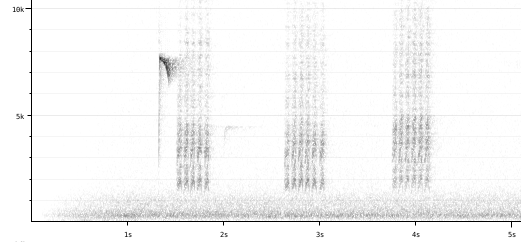 Call from Xeno-Canto
Call from Xeno-Canto
♫ Call from Xeno-Canto Source: XENOCANTO
XC592152 great tit call.mp3
(call)

Call attributes:
Call melody: simple rhythmic, fast, Frequency: 1-7 KHz,
European crested tit / Haubenmeise (Lophophanes cristatus)
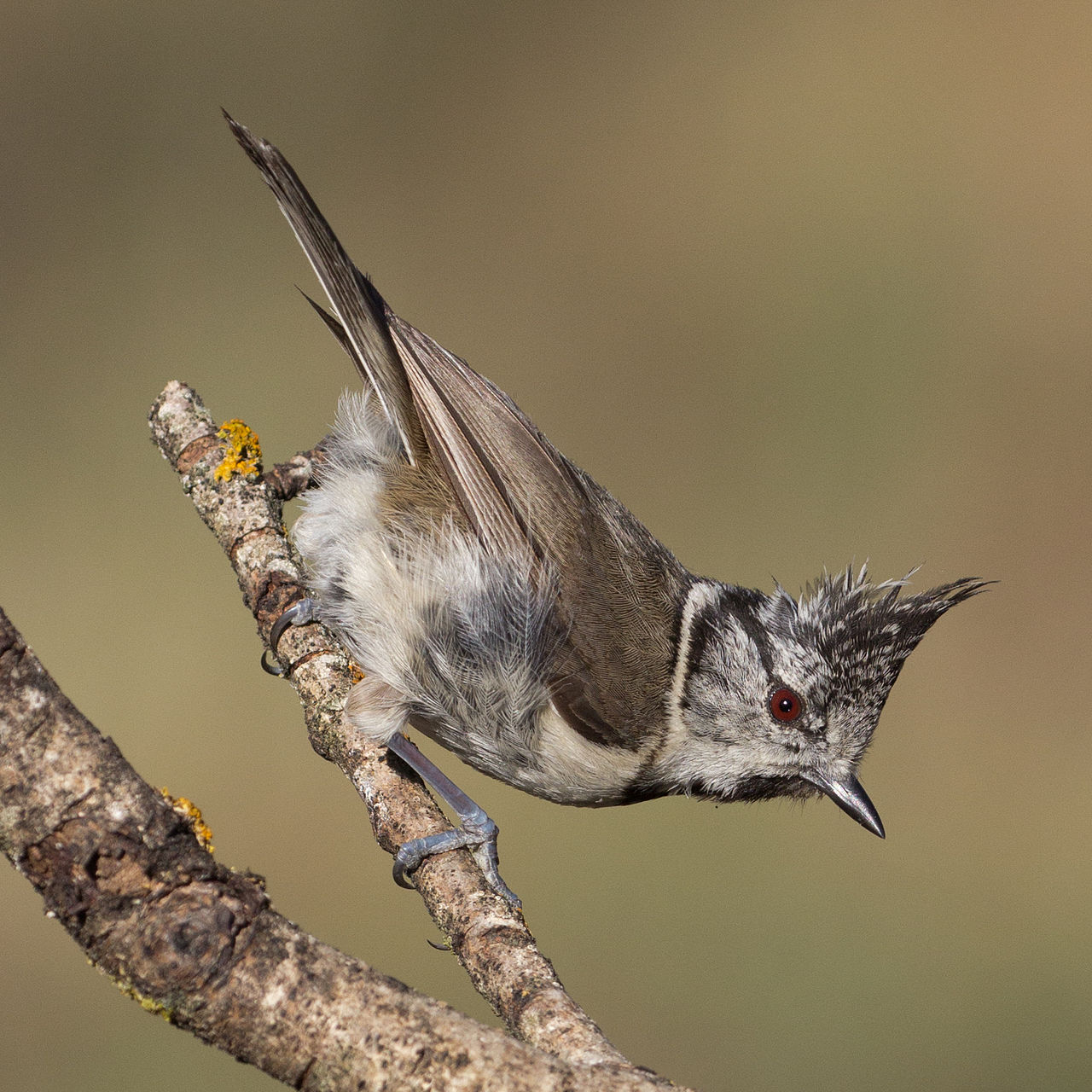
Wikipedia - Haubenmeise - Lophophanes cristatus - 01 - Carlos Delgado. Source: WIKIPEDIA
Wikipedia - Haubenmeise - Lophophanes_cristatus_-_01 - Carlos Delgado.jpg
First observed in 🇨🇭 on 2020-07-31.
General: ![]() The European crested tit, or simply crested tit (Lophophanes cristatus) (formerly Parus cristatus), is a passerine bird in the tit family Paridae. It is a widespread and common resident breeder in coniferous forests throughout central and northern Europe and in deciduous woodland in France and the Iberian peninsula. In Great Britain, it is chiefly restricted to the ancient pinewoods of Inverness and Strathspey in Scotland, and seldom strays far from its haunts. A few vagrant crested tits have been seen in England. It is resident, and most individuals do not migrate.
[more]
The European crested tit, or simply crested tit (Lophophanes cristatus) (formerly Parus cristatus), is a passerine bird in the tit family Paridae. It is a widespread and common resident breeder in coniferous forests throughout central and northern Europe and in deciduous woodland in France and the Iberian peninsula. In Great Britain, it is chiefly restricted to the ancient pinewoods of Inverness and Strathspey in Scotland, and seldom strays far from its haunts. A few vagrant crested tits have been seen in England. It is resident, and most individuals do not migrate.
[more]
Song: ![]() Song: an improvisation over previously described calls. [Link]
Song: an improvisation over previously described calls. [Link]
Calls: ![]() Call a characteristic vibrating rolling trill "Trrrrurrrurrrit", with last syllable emphasized and ending with ascending pitch. Often preceded by a couple of introductory "tzi tzi". [Link]
Call a characteristic vibrating rolling trill "Trrrrurrrurrrit", with last syllable emphasized and ending with ascending pitch. Often preceded by a couple of introductory "tzi tzi". [Link]
Physical details: length=11 cm,
wingspan=17-20 cm,
weight=10-13 g
Habitats:
Forest
Song:
Higher-pitched than great tit - how distinguish from coal tit, etc?
Song attributes:
Melody: simple rhythmic, fast, Frequency: high (3-9 KHz) Special sounds: slur
Eurasian blue tit / Blaumeise (Cyanistes caeruleus)
Erste Blaumeise aufgenommen in Fehraltorf Ich hatte sie lange gehoert aber als Kohlmeise miserkannt (es ist oft aehnlich und ich war Anfaenger. Dann habe ich diesen auf einem Baum gesehen, und es wurde klar, dass sie wirklich auch bei uns leben. 2020-04-15 19.12.31 Luppmen
First observed in 🇨🇭 on 2020-04-05.
Ich habe das erste mal eine Blaumeise bei uns daheim erkannt in April 2020, eine junge erst Juni 2020, und den Unterschied zwischen Jugendkleid und Schlicht/Prachtkleid erst in Juli 2021 kennengelertn.
In How to be a Bad Birdwatcher, Simon Barnes nicely explains hierarchies in feeding groups and how niches prevent blue tits from being starved by the larger, more dominant great tits. Normally they forage differently, he says, and at feeders it's simply clear to both that the great tit goes first. However in May 2021, we watched a blue tit repeatedly chase off a great tit that landed at the feeder where he was already enjoying some sunflower seeds! There are always exceptions to the rules!
Song: ![]() Song: Characteristic, clear, high-pitched, vibrating call. Usually introduced by a couple of accenting syllables, followed by ringing vibrating notes: "ti ti chuhuhuhuhuhuhuhuhuhu". [Link]
Song: Characteristic, clear, high-pitched, vibrating call. Usually introduced by a couple of accenting syllables, followed by ringing vibrating notes: "ti ti chuhuhuhuhuhuhuhuhuhu". [Link]
Calls: ![]() Scolding alarm call: "tee-tee-tee-chirruwitt" similar to Great Tit. [Link]
Scolding alarm call: "tee-tee-tee-chirruwitt" similar to Great Tit. [Link]
Physical details: length=11 cm,
wingspan=17-20 cm,
weight=9-12 g
Habitats:
Settlement
Social groups can include up to 12 members.
Can appear in social groups with other species: Great tit.
Song:
General: High-pitched, often descending (hhll), occasionally ascending. "Christina compares it to a ping-pong ball dropping.
[In Januar singt die Kohlmeise als erster Vogel in Deutschland], dann kommt die Blaumeise dazu.
Song attributes:
Melody: simple rhythmic, slow, Frequency: 3-9 KHz Special sounds: trill Singing season: 01-01 - 06-30 Dawn chorus start, 35 minutes before dawn.
Call:
Low-high-high, with lightly raspy start, rather high.
Call attributes:
Call melody: simple rhythmic, slow, Frequency: high (3-9 KHz),
Marsh tit / Sumpfmeise (Poecile palustris)
Photographed on the Luppmen in September 2019 I didn't recognize it then but I'm pretty sure now. 2019-09-22 18.45.30 Luppmen
First observed in 🇨🇭 on 2020-05-04.
I see them occasionally at the Luppmen or our house, but maybe 1% as often as Kohlmeisen and Blaumeisen.
BirdNet suggested a Wiesenmeise, but those are rare here and Sumpfmeisen not uncommon
according to BirdLife Zurich
Etymology: ![]() Auch Nonnenmeise genannt - weil es auch eine Moenchmeise gibt? [Link]
Auch Nonnenmeise genannt - weil es auch eine Moenchmeise gibt? [Link]
Vocalization: ![]() Most easily identified by sound. Especially in areas where plumage is less distinct compared to Willow Tit, like in Britain. [Link]
Most easily identified by sound. Especially in areas where plumage is less distinct compared to Willow Tit, like in Britain. [Link]
Klapperlied - 6-8 Noten 'angeschlagen'
Song: ![]() Klapperlied. Reihe (6-8) weich angeschlagene Töne mittlerer Höhe. Ähnlich der Klappergrasmücke aber weicher. (Sumpf ist weich) Oft auch Rufe wie „psja“ zu hören. Ziemlich scharf u. gepresst. [Link]
Klapperlied. Reihe (6-8) weich angeschlagene Töne mittlerer Höhe. Ähnlich der Klappergrasmücke aber weicher. (Sumpf ist weich) Oft auch Rufe wie „psja“ zu hören. Ziemlich scharf u. gepresst. [Link]
Calls: ![]() Most typical call an explosive, sneeze-like "pee-choo", starting high-pitched and ending on a lower note.
Most typical call an explosive, sneeze-like "pee-choo", starting high-pitched and ending on a lower note.
. [Link]
Physical details: length=11 cm,
wingspan=18-19 cm,
weight=10-13 g
Habitats:
Forest
Song:
Higher-pitched than great tit, sometimes repetitive 1- and 2-note tunes like them, sometimes simple melodies, usually pure, sometimes chirpy or raspy. BirdID at Nord U says 'Song: A simple one or two note call repeated in series. Usually rising slightly in pitch, and with a "liquid" quality.'. At bird-song.ch it's hl-rest-hl, or 7-8 2-noter swoops. bird-song.ch names lh-break-hl as a pistjä call and also has a series of 7 or 8 falling 'swoops'.
Song attributes:
Melody: simple rhythmic, fast, Frequency: 2-10 KHz
♫ Source: XENOCANTO
XC727754 - Marsh Tit - Poecile palustris.mp3
(song)

♫ Source: XENOCANTO
XC778730 - Marsh Tit - Poecile palustris - the two-note song BirdID, recorded in France.mp3
(song)

Calls:
1:
Falling note, relatively long, sometimes repeated - like the pee below without the choo?
Call from Xeno-Canto
♫ Call from Xeno-Canto Source: XENOCANTO
XC594764 marsh tit call.mp3
(call)
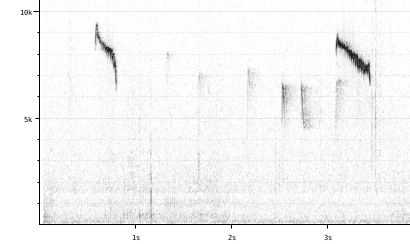 'Swooping' call on the Luppmen
'Swooping' call on the Luppmen
♫ 'Swooping' call on the Luppmen Chiffchaff calls go up, marsh tit calls down! Source: BirdNet
20201021_083851 birdnet 1019 am Luppmen - Marsh tit - Fehraltorf.mp3
2020-10-21 08.38.51 Luppmen (call)
2:
BirdID (at Nord U.) says an explosive, sneeze-like "pee-choo",, similar to Blaumeise with clear note followed by rough ones, but hll
Call from Xeno-Canto
♫ Call from Xeno-Canto Source: XENOCANTO
XC733901 - Marsh Tit - Poecile palustris - pee-choo call, sometimes just pee - recorded in Germany.mp3
Germany (call)

Call attributes:
Call melody: one note, slow, Frequency: 6-9 KHz, Special sounds: swoop.
Willow tit / Weidenmeise (Poecile montanus)
Willow tit. 2020-04-25 08.51.40 Luppmen
First observed in 🇨🇭 on 2020-04-25.
Vogelwarte.ch says, Two forms of Poecile montanus exist in Switzerland: the Willow Tit occurs in the Jura, the Pre-Alps and locally on the Central Plateau, while the Alpine Tit is confined to the Alps. The two forms have a distinct song as well as different ecological requirements, and could evolve into two species over time.
Since I've heard them in St. Moritz, they're more properly alpine tits than willow tits.
I should verify the audio recordings vs xenocanto, etc, as it was BirdNet that identified
them as willow tits, and it is not infallible.
Vocalization: ![]() Other sounds: high pitced "zi zi" similar to other tits. [Link]
Other sounds: high pitced "zi zi" similar to other tits. [Link]
Song: ![]() 1.Gesangstyp: „ziü ziü ziü „ etwas wehmütig, die einzelnen Töne leicht absinkend, nicht klappernd. Bei Unterart Alpenmeise auf gleicher Höhe bleibend. 2.Gesangstyp: variable, schwätzende, helle Folge m. trillerndem Schluss. [Link]
1.Gesangstyp: „ziü ziü ziü „ etwas wehmütig, die einzelnen Töne leicht absinkend, nicht klappernd. Bei Unterart Alpenmeise auf gleicher Höhe bleibend. 2.Gesangstyp: variable, schwätzende, helle Folge m. trillerndem Schluss. [Link]
![]() Song: One or two soft, clear, melancholic notes repeated in a slow, even rhythm. At first rising slightly in pitch, then gradually falling. In some areas song is evenly pitched. [Link]
Song: One or two soft, clear, melancholic notes repeated in a slow, even rhythm. At first rising slightly in pitch, then gradually falling. In some areas song is evenly pitched. [Link]
Calls: ![]() Folge v. etwas heiser näselnden „zi zi dääh dääh. (einmalige Laute)
[Link]
Folge v. etwas heiser näselnden „zi zi dääh dääh. (einmalige Laute)
[Link]
![]() Call: Most characteristic call a frequently uttered, nasal "ti ti chaa chaa chaa". First notes high pitched and the following lower, coarse, nasal and drawn. Sometimes uttered without the introductory high pitched notes. [Link]
Call: Most characteristic call a frequently uttered, nasal "ti ti chaa chaa chaa". First notes high pitched and the following lower, coarse, nasal and drawn. Sometimes uttered without the introductory high pitched notes. [Link]
Physical details: length=11 cm,
wingspan=17-20 cm,
weight=8-14 g
Habitats:
Forest
Song:
Songs I've heard alternate two notes and look like a sine wave on the sonogram.
Vogelwarte.ch: Apart from minor differences in diet and size, Alpine Tit and Willow Tit can only be identified by their song. The Willow Tit utters a series of long, descending notes («tyoo tyoo tyoo tyoo»), whereas the Alpine Tit’s territorial song consists of short notes on an even pitch («dee dee dee dee dee»).
See more here.
Song attributes:
Melody: simple rhythmic, slow, Frequency: 3-7 KHz
♫ Source: OTHER
509229
(song)
Call:
Automatically generated from Xeno-Canto recording
♫ Willow tit st moritz. 2020-06-09 16.09.28 Sils (song?)
Coal tit / Tannenmeise (Periparus ater)
Coal tit in Wikipedia. Source: WIKIPEDIA
Coal tit in Wikipedia.JPG
First observed in 🇨🇭 on 2020-04-18.
Periparus ater at Xeno-Canto - a small classification fight
Etymology: ![]() The German Wikipedia page says 'ater' from the genus 'Periparus ater' is Latin for 'düster' meaning dark or even gloomy. [Link]
The German Wikipedia page says 'ater' from the genus 'Periparus ater' is Latin for 'düster' meaning dark or even gloomy. [Link]
![]() In German the name means fir tit - so obviously found in woods with many firs [Link]
In German the name means fir tit - so obviously found in woods with many firs [Link]
Appearance and identification: Nabu: Mit ihrem schwarzen Kopf und den weißen Wangen erinnert sie an eine kleine Kohlmeise, jedoch ist die Unterseite der Tannenmeise eher beige statt gelb, und ihr fehlt der dunkle Längsstreifen an der Unterseite. [Link]
Song: ![]() Song: Various repeated motifs, consisting of two to three notes with alternating accents. Slightly similar to Great Tit, but faster, not so metallic and with a less full tone. Can be mistaken for Marsh Tit when singing single or double notes, but tone is softer and notes more clearly separated (if disyllabic). [Link]
Song: Various repeated motifs, consisting of two to three notes with alternating accents. Slightly similar to Great Tit, but faster, not so metallic and with a less full tone. Can be mistaken for Marsh Tit when singing single or double notes, but tone is softer and notes more clearly separated (if disyllabic). [Link]
Calls: ![]() Call: short soft and clear "piu", first rapidly rising and then falling in pitch. [Link]
Call: short soft and clear "piu", first rapidly rising and then falling in pitch. [Link]
Physical details: length=11 cm,
wingspan=17-21 cm,
weight=8-10 g
Habitats:
Forest
Song:
Higher-pitched than great tit,
with more slurs instead of pure notes.
Usually 2 or 3 notes in varied order.
To me it seems they have a repertoire of songs, like their 'big brothers', the great tits.
Song attributes:
Melody: simple rhythmic, fast, Frequency: 3-9 KHz Special sounds: slur
Call:
Analyze stuff at XC vs my BirdNet 962 - several notes, not sure if all coal tit as BirdNet suggested. XC has two-note high-low alarm call but simple song-like calls too
Call attributes:
Call melody: simple rhythmic, slow, Frequency: high (3-9 KHz),
Eurasian penduline-tit / Beutelmeise (Remiz pendulinus)
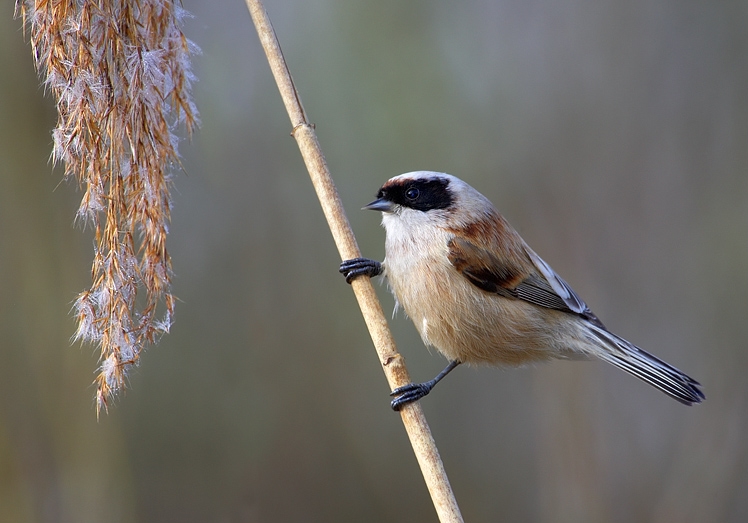
Wikipedia: Eurasian penduline-tit Source: OTHER
Remiz_pendulinus_3_%28Martin_Mecnarowski%29.jpg
Seasonal Behavior: ![]() Regelmässiger Durchzügler [Link]
Regelmässiger Durchzügler [Link]
Calls: ![]() Call a sharp clear high pitched whistle "pju-eee-uu", with the middle part accented and with a raised pitch Or just an all descending whistle "pjuuuuuuu". [Link]
Call a sharp clear high pitched whistle "pju-eee-uu", with the middle part accented and with a raised pitch Or just an all descending whistle "pjuuuuuuu". [Link]
Physical details: length=11 cm,
wingspan=16-17 cm,
weight=8-10 g
Habitats:
Wetland
Song:
Nabu: In den Gesang werden viele Pausen, Triller und Rufe eingebaut. [Link]
Song attributes:
Melody: sings 5-19 seconds, fast, Frequency: 1-8 KHz
Call:
Automatically generated from Xeno-Canto recording
♫ XC770243 - Eurasian Penduline Tit - Remiz pendulinus - call with a single swoop repeated about every 2 seconds. Source: XENOCANTO
XC770243 - Eurasian Penduline Tit - Remiz pendulinus - call with a single swoop repeated about every 2 seconds.mp3
(call)

Call attributes:
Frequency: ,
Common starling / Star (Sturnus vulgaris)
Im richtigen Licht schimmern die Federn. 2020-04-11 07.54.52 Luppmen
First observed in 🇨🇭 on 2020-04-11.
This bird appears across the great seas in the following continents:
Europe, North America (introduced), Africa.
Learned on BBC's Winterwatch: the movement of a swarm of starlings is called a murmuration! Check out this this video or even an entire half hour
In trees or in the fields by the cows.
Frequently seen here, for instance by their nests under the eaves of one of the Toblerone houses.
Introduced to North America from Europe by Eugene Schieffelin.
Eine der Vogelarten, die gleichzeitig zwei Töne singen kann!
Vocalization: ![]() Among the best of imitators. Mimics birds, animals and mechanical noises. Often makes several sounds at the same time. [Link]
Among the best of imitators. Mimics birds, animals and mechanical noises. Often makes several sounds at the same time. [Link]
Song: ![]() Song a highly varied mix of falling whistles, bill-clappering and various masterful mimicry. [Link]
Song a highly varied mix of falling whistles, bill-clappering and various masterful mimicry. [Link]
Calls: ![]() Other calls; a harsh "chaee" and a short sharp "tink". [Link]
Other calls; a harsh "chaee" and a short sharp "tink". [Link]
Physical details: length=21 cm,
wingspan=37-42 cm,
weight=60-90 g
Habitats:
Agricultural
Song:
I find their individual song amusing, with its (long) whoops and weird noises.
As a group, they're just noisy!
Song attributes:
Melody: improvised melodic, slow, Frequency: medium (1-5 KHz) Special sounds: mimicry, whoop, weird Singing season: 01-01 - 09-30 Dawn chorus start, 15 minutes before dawn.
Call:
I hear this occasionally and really enjoy it - a long rising 'whoop', as I call it', starting low at 1 1/2 KHz and rising to 6 1/2 KHz!
♫ Source: BirdNet
20210823_172609 birdnet 1968 - European Starling long whoop call - 2021-08-23 17:26:09 - European Starling - Fehraltorf.mp3
2021-08-23 17.26.09 Fehraltorf (call)
Call attributes:
Call melody: one note, slow, Frequency: 1-6 KHz, Special sounds: whoop.
Common blackbird / Amsel (Turdus merula)

Amsel bei friedliweid. 2020-04-13 10.28.42 Friedliweid
First observed in Australia on 2008-01-01.
The first bird I loved listening to
Song: ![]() Melodisch flötend dazwischen auch zerquetschte Töne. Die Elemente werden nicht wiederholt. Singt von Singwarte aus. Ca. 100 verschiedene Strophentypen.
[Link]
Melodisch flötend dazwischen auch zerquetschte Töne. Die Elemente werden nicht wiederholt. Singt von Singwarte aus. Ca. 100 verschiedene Strophentypen.
[Link]
![]() One of the most appreciated song birds. Very melodious and resonant, with long mellow notes and a large register. Less high pitched sounds than Song Thrush, and seldom repeats a phrase. Timbre fuller than both Song Thrush and Mistle Thrush. Well defined pauses between phrases, giving the song a relaxed pace. [Link]
One of the most appreciated song birds. Very melodious and resonant, with long mellow notes and a large register. Less high pitched sounds than Song Thrush, and seldom repeats a phrase. Timbre fuller than both Song Thrush and Mistle Thrush. Well defined pauses between phrases, giving the song a relaxed pace. [Link]
Calls: ![]() Je nach Situation, „duck duck duck“, „tix-tix-tix“ in rascher Folge, „srieh“ (auch als Flugwarnruf)
[Link]
Je nach Situation, „duck duck duck“, „tix-tix-tix“ in rascher Folge, „srieh“ (auch als Flugwarnruf)
[Link]
![]() Large repertoire of calls. Most characteristic is a hysterical rattle often given when flushed. Sometimes preceded by a hard "tok tok", which then accelerates into a panicky arpeggio-like crescendo. Contact call a thin redwing-like "srrreee". Alarm calls: a sharp "tink, tink" or a very high pitch falling whistle. [Link]
Large repertoire of calls. Most characteristic is a hysterical rattle often given when flushed. Sometimes preceded by a hard "tok tok", which then accelerates into a panicky arpeggio-like crescendo. Contact call a thin redwing-like "srrreee". Alarm calls: a sharp "tink, tink" or a very high pitch falling whistle. [Link]
Physical details: length=24-25 cm,
wingspan=34-38 cm,
weight=80-125 g
Habitats:
Settlement
Song:
Other: Gut zu erkennen ist die Amsel.
Sie singt melodiös, erklärt Heller, «zuerst flötend und dann gegen Schluss so schnirpslig».
Die Amsel singe gerne dort, wo sie gut gehört werde, etwa vor Hauswänden, die den Schall nicht schlucken.
Ich wollte schauen was schnirpslig heisst, aber diese ist diese einzige Verwendung, die Google kennt!
Der flötende Teil ist relativ tief, 1.5-3 KHz, der schnirpslige aber 2.5-7 KHz.
(Schnirpslig ist ein schones Wort das der Redner erfunden hat - Google findet nur diese eine Webseite mit dem Wort!) [Von der SRF Webseite:]
Song attributes:
Melody: improvised melodic, slow, Frequency: 1-7 KHz Special sounds: flourish Singing season: 02-01 - 07-31 Dawn chorus start, 45 minutes before dawn.
Call:
Loud falling series of notes, unlike anything else you hear from a blackbird
Call attributes:
alarm call Call melody: simple rhythmic, slow, Frequency: medium (1-5 KHz),
Song thrush / Singdrossel (Turdus philomelos)
Profile Wikipedia eBird Vogelwarte BirdLife ZH ornitho.ch bird-song.ch Xeno-Canto BirdID NABU
Singdrossel Isle de Brehat, Brittany. 2019-06-16 15.35.33 Île-de-Bréhat
First observed in Brittany on 2019-06-16.
General: ![]() The song thrush (Turdus philomelos) is a thrush that breeds across the West Palearctic. It has brown upper-parts and black-spotted cream or buff underparts and has three recognised subspecies. Its distinctive song, which has repeated musical phrases, has frequently been referred to in poetry.
[more]
The song thrush (Turdus philomelos) is a thrush that breeds across the West Palearctic. It has brown upper-parts and black-spotted cream or buff underparts and has three recognised subspecies. Its distinctive song, which has repeated musical phrases, has frequently been referred to in poetry.
[more]
Vocalization: ![]() Very melodious, varied and a master imitator. Still easily distinguished by its tendency to repeat introductory motives two or more times, and its many high pitched themes. Each phrase is loud and penetrating and the tempo deliberate. [Link]
Very melodious, varied and a master imitator. Still easily distinguished by its tendency to repeat introductory motives two or more times, and its many high pitched themes. Each phrase is loud and penetrating and the tempo deliberate. [Link]
Song: ![]() Klangfarbe ähnlich obiger Art [Amsel], aber jedes Element 2-4mal wiederholt, Pausen zwischen den Phrasen.(klingt oft wie „Philipp“, oder „Judith“) Einzige Drossel unseres Gebietes die diese Wiederholungen macht. Singt oft nicht von Baumspitze aus, sondern aus dem Geäst.
[Link]
Klangfarbe ähnlich obiger Art [Amsel], aber jedes Element 2-4mal wiederholt, Pausen zwischen den Phrasen.(klingt oft wie „Philipp“, oder „Judith“) Einzige Drossel unseres Gebietes die diese Wiederholungen macht. Singt oft nicht von Baumspitze aus, sondern aus dem Geäst.
[Link]
Calls: ![]() Rufe :“zipp“, oft beim abfliegen.
[Link]
Rufe :“zipp“, oft beim abfliegen.
[Link]
![]() Most heard (but easily overlooked) contact call is a dry and very short "zip", sometimes given as a two syllable call "zip-ip". [Link]
Most heard (but easily overlooked) contact call is a dry and very short "zip", sometimes given as a two syllable call "zip-ip". [Link]
Physical details: length=23 cm,
wingspan=33-36 cm,
weight=65-100 g
Habitats:
Forest
Song:
Paced like a blackbird, humorous mix of elements like a nightingale. Huge range, elements from 2-5 KHz, others 6.5-9 KHz. Can sing for up to 50 minutes, and a male may know 100 melodies in its repertoire.
Song attributes:
Melody: improvised melodic, slow, Frequency: 2-9 KHz Special sounds: swoop Singing season: 02-01 - 07-31 Dawn chorus start, 60 minutes before dawn.
Call:
One or two high chirps followed by long pause of 1-2 seconds
Call attributes:
contact call Call melody: one note, slow, Frequency: 7-10 KHz,
Redwing / Rotdrossel (Turdus iliacus)
Profile Wikipedia eBird Vogelwarte BirdLife ZH ornitho.ch bird-song.ch Xeno-Canto BirdID NABU
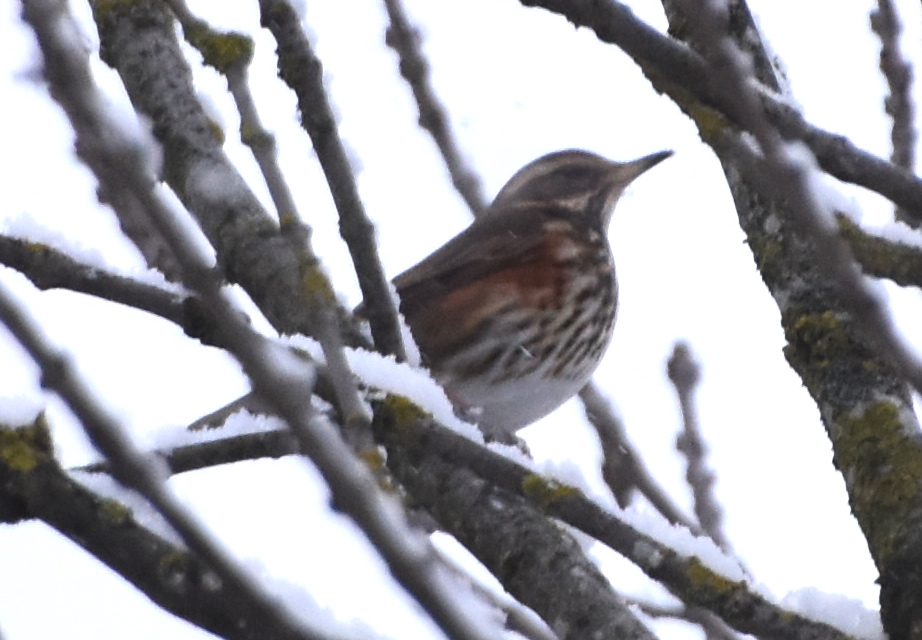
Rotdrossel in einem baum neben dem Luppmen, rot unter den Fluegeln gut erkennbar, auch weisser Ueberaugenstreif. 2020-12-30 10.33.36 Luppmen
First observed in Iceland on 2015-06-05.
In Switzerland these are migrants or winter guests that breed in Scandinavia.
I saw a group that landed in a tree by the Luppmen.
Some sang an odd song that I didn't recognize but unfortunately couldn't record.
They were rather nervous and quickly flew off.
I had an interesting educational experience with fieldfares!
At the end of December 2020 I saw redwings in Fehraltorf for the first time.
They're a winter guest that breeds in Scandinavia.
Jan 2021 I saw one from our dining room window, and two days later
saw 31 of them land in four trees along the Luppmen brook,
and spontaneously decided to report them via the eBird app.
The next day I got an automated response saying this was an unusually high number,
and that I should document the sighting further. I added pictures of the group in the trees
pus one of an individual close up. Then I got a nice e-mail from eBird volunteer Raphaël Nussbaumer,
an Earth Science PhD and postdoc at the Swiss Ornithological Institute, saying that my redwings were fieldfares.
I checked the guide books and apps, and that seemed plausible. I was surprised that none of them mentioned the danger
of confusing the two, which are actually quite similar (and related). I checked the closeup I took on December 31
and asked Raphaël if it was actually a redwing, and he confirmed it. So I actually found two (to me) new thrushes
within 3 weeks. He noted 'they are often found mixed with fieldfare or mistle thrush, so one has to be careful to check the entire group and not assume that all are redwings.
I saw 8 similar looking birds when I saw the actual redwing, and while I think there's more than one redwing there,
I can't see the whole flock well enough to be sure.
Appearance and identification: ![]() Vogelwarte.ch describes just what I saw. In translation, somewhat smaller than a song thrush and distinguishable from them by the prominent white stripe above the eye and the rust-red feathers under the wings. [Link]
Vogelwarte.ch describes just what I saw. In translation, somewhat smaller than a song thrush and distinguishable from them by the prominent white stripe above the eye and the rust-red feathers under the wings. [Link]
Vocalization: ![]() First a simple, melodic phrase of 3 - 6 notes, usually followed by a more silent, indistinct, fast and less melodic, chattering sequence. First part highly variable from place to place, but constant in individuals. Often causes confusion when a new dialect is heard at a distance, since only the first part is far-reaching, and the diagnostic two-part structure gets lost. [Link]
First a simple, melodic phrase of 3 - 6 notes, usually followed by a more silent, indistinct, fast and less melodic, chattering sequence. First part highly variable from place to place, but constant in individuals. Often causes confusion when a new dialect is heard at a distance, since only the first part is far-reaching, and the diagnostic two-part structure gets lost. [Link]
Song: ![]() Song delivered in two parts. [Link]
Song delivered in two parts. [Link]
Calls: ![]() Contact call a thin, drawn and sharp "sreee". Often heard at night during migration. Alarm call harder, dryer and more raucous than other thrushes. [Link]
Contact call a thin, drawn and sharp "sreee". Often heard at night during migration. Alarm call harder, dryer and more raucous than other thrushes. [Link]
Physical details: length=21 cm,
wingspan=33-34 cm,
weight=50-75 g
Habitats:
Forest
Song:
![]() Song delivered in two parts. First a simple, melodic phrase of 3 - 6 notes, usually followed by a more silent, indistinct, fast and less melodic, chattering sequence. First part highly variable from place to place, but constant in individuals. [Link]
Song delivered in two parts. First a simple, melodic phrase of 3 - 6 notes, usually followed by a more silent, indistinct, fast and less melodic, chattering sequence. First part highly variable from place to place, but constant in individuals. [Link]
Song attributes:
Mnemnoic: down 6+chattering Melody: stereotype melodic, slow, Frequency: 3-5 KHz
♫ Source: XENOCANTO
XC320315 - Redwing - Turdus iliacus.mp3
(song)

Call:
Automatically generated from Xeno-Canto recording
♫ XC320315 - Redwing - Turdus iliacus. Source: XENOCANTO
XC320315 - Redwing - Turdus iliacus.mp3
(song?)

Mistle thrush / Misteldrossel (Turdus viscivorus)
Profile Wikipedia eBird Vogelwarte BirdLife ZH ornitho.ch bird-song.ch Xeno-Canto BirdID NABU
Misteldrossel. 2020-05-07 12.56.02 Hungerseeli
First observed in 🇨🇭 on 2020-05-07.
After a long outing in the woods with no 'new' discoveries where I hoped there might be,
I followed a woodpecker-like rattle deep into the woods,
and eventually managed a clear view of a mistle thrush (German Misteldrossel)
while standing directly under the tree where I heard it.
I believe it was a pair, but I only got a picture of one.
The breast has that checkerboard look that thrushes have.
I initially saw them in the woods but later by Neschwil they came
out of the woods into the fields to feed.
Song: ![]() Gesang ähnlich dem der Amsel, aber weniger abwechslungsreich und melancholisch, fast weinerlich klingend. Meist von Tannenspitze aus.
[Link]
Gesang ähnlich dem der Amsel, aber weniger abwechslungsreich und melancholisch, fast weinerlich klingend. Meist von Tannenspitze aus.
[Link]
![]() Song loud, far reaching and melodic. Most similar to Blackbird, but pitch is higher, phrases shorter (3-6 notes) and most notably, pauses between phrases are much shorter. All which gives the song a much more hurried feel than that of the Blackbird. Timbre is thinner and slightly shivering, and tonal range more limited. May have recurring favourite motifs, but does not repeat phrases like Song Thrush. Sometimes adds higher pitched parts and imitations. [Link]
Song loud, far reaching and melodic. Most similar to Blackbird, but pitch is higher, phrases shorter (3-6 notes) and most notably, pauses between phrases are much shorter. All which gives the song a much more hurried feel than that of the Blackbird. Timbre is thinner and slightly shivering, and tonal range more limited. May have recurring favourite motifs, but does not repeat phrases like Song Thrush. Sometimes adds higher pitched parts and imitations. [Link]
Calls: ![]() Rufe:schnarrend „kerr“, daneben „tück-tück-tück“
[Link]
Rufe:schnarrend „kerr“, daneben „tück-tück-tück“
[Link]
![]() Other calls; a dry rattle, likened to the sound of a piece of wood drawn over a coarse comb, and a Fieldfare-like "chuck". [Link]
Other calls; a dry rattle, likened to the sound of a piece of wood drawn over a coarse comb, and a Fieldfare-like "chuck". [Link]
Physical details: length=27 cm,
wingspan=42-47 cm,
weight=100-150 g
Habitats:
Forest
Looks similar to:
Meadow pipit.
Song:
Song: ![]() Gesang ähnlich Amsel, aber eintöniger mit geringerem Tonumfang [auch kürzer, kein schnirpsliges Ende -- Bill] [Link]
Gesang ähnlich Amsel, aber eintöniger mit geringerem Tonumfang [auch kürzer, kein schnirpsliges Ende -- Bill] [Link]
Song attributes:
Melody: non-musical, fast, Frequency: 2-9 KHz Special sounds: rattle
Call:
General: I mistook this one for a woodpecker the first time I heard it,
partly because BirdNet also did!
Rattle generated in vocal tract, not with the beak!
Call attributes:
Call melody: non-musical, fast, Frequency: 2-9 KHz, Special sounds: rattle.
Fieldfare / Wacholderdrossel (Turdus pilaris)
Profile Wikipedia eBird Vogelwarte BirdLife ZH ornitho.ch bird-song.ch Xeno-Canto BirdID NABU
Wacholderdrossel am Luppmen in Fehraltorf 2021-01-16 14.28.10
First observed in 🇨🇭 on 2021-01-16.
I had an interesting educational experience with fieldfares!
Check it out under Redwing.
Appearance and identification: ![]() The fieldfare is 25 cm (10 in) long, with a grey crown, neck and rump, a plain brown back, dark wings and tail and white underwings. [Link]
The fieldfare is 25 cm (10 in) long, with a grey crown, neck and rump, a plain brown back, dark wings and tail and white underwings. [Link]
Geography: Nabu: 'Die ursprüngliche Heimat dieser nordischen Drossel ist die Sibirische Taiga.
Vor etwa 200 Jahren begann ihre Ausbreitung in den südwestlichen Raum Europas.'Wie der Misteldrossel vertreibt der Wacholderdrossel Feinde wie Elster, Rabenkrähe oder Bussard
vom Nestgebiet mit Kotbomben. ['Die Wacholderdrossel - Turdus pilaris
Ein Wintergast wird heimisch', von Paul Laakmann aus Buntspecht 3/1986]
Behavior: ![]() Misteldrossel greifen Vögel an die ihr Nest bedrohen koennten.
Das nennt man eine Kopropolemische Reaktion - vom griechischen für Kot under Krieg.
Mester meint Hauptziel der Angriffe waere meistens der Kopf.
Woanders wurde erwahnt, dass der Kot der Misteldrosseln besonders klebrig ist,
eben weil der Vogel viele Mistelbeeren frisst, und wenn die Feder zusammenkleben,
koennt das Opfer nicht optimal fliegen. [Artikel 'Defensive Defaekation in der Vogelwelt' von Horst Mester, erschienen Oktober 1976 in 'Der Ornithologische Beobachter']
Misteldrossel greifen Vögel an die ihr Nest bedrohen koennten.
Das nennt man eine Kopropolemische Reaktion - vom griechischen für Kot under Krieg.
Mester meint Hauptziel der Angriffe waere meistens der Kopf.
Woanders wurde erwahnt, dass der Kot der Misteldrosseln besonders klebrig ist,
eben weil der Vogel viele Mistelbeeren frisst, und wenn die Feder zusammenkleben,
koennt das Opfer nicht optimal fliegen. [Artikel 'Defensive Defaekation in der Vogelwelt' von Horst Mester, erschienen Oktober 1976 in 'Der Ornithologische Beobachter']
Vocalization: ![]() Very vocal. [Link]
Very vocal. [Link]
Song: ![]() Gesang nicht melodisch,aus gepressten, quietschenden Tönen bestehend, fast nur im Flug vorgetragen.
[Link]
Gesang nicht melodisch,aus gepressten, quietschenden Tönen bestehend, fast nur im Flug vorgetragen.
[Link]
![]() Song a mix of dry contact calls; "trrrt trrrrt", and high pitched, drawn out, chattering improvisations. [Link]
Song a mix of dry contact calls; "trrrt trrrrt", and high pitched, drawn out, chattering improvisations. [Link]
Calls: ![]() Schackernd, ähnlich obiger Art [Misteldrossel], aber weicher. Am Brutplatz raue krächzende Rufe.
[Link]
Schackernd, ähnlich obiger Art [Misteldrossel], aber weicher. Am Brutplatz raue krächzende Rufe.
[Link]
![]() Scolding call a hard "check", often given in decelerating series. Contact call in migration a soft, pleasant but, buzzy "weet". Typically bursts into continuos, squeaky chattering at takeoff. [Link]
Scolding call a hard "check", often given in decelerating series. Contact call in migration a soft, pleasant but, buzzy "weet". Typically bursts into continuos, squeaky chattering at takeoff. [Link]
Physical details: length=25 cm,
wingspan=39-42 cm,
weight=80-120 g
Habitats:
Forest
Song:
BirdID says song a mix of dry contact calls, BirdLife that it's almost only heard in flight. The XC recording is a bit of a chuckle to me.
Song attributes:
Melody: non-musical, slow, Frequency: 1-6 KHz Special sounds: rasp
♫ Source: XENOCANTO
XC769296 - Fieldfare - Turdus pilaris - song, a series of contactcalls.mp3
(song)

Call:
Automatically generated from Xeno-Canto recording
♫ Source: BirdNet
20220622_155937 birdnet - Wacholderdrossel bei Wauwilermoos - Wacholderdrossel - Alberswil.mp3
2022-06-22 15.59.37 Wauwilermoos (song?)
Ring ouzel / Ringdrossel (Turdus torquatus)
Profile Wikipedia eBird Vogelwarte BirdLife ZH ornitho.ch bird-song.ch Xeno-Canto BirdID NABU
Ringdrossel. 2023-05-27 11.28.22 Amden Hinder Hoechi
First observed in 🇨🇭 on 2021-06-27.
Song: ![]() Habe mit dem Buntspecht verwechselt - Ringdrossel singt 2-3 Noten - hilft das? [Link]
Habe mit dem Buntspecht verwechselt - Ringdrossel singt 2-3 Noten - hilft das? [Link]
![]() Song a primitive, plaintive series of short phrases. Often with only one or two syllables. Interspersed with eerie, higher pitched sounds, reminiscent of Song Thrush. [Link]
Song a primitive, plaintive series of short phrases. Often with only one or two syllables. Interspersed with eerie, higher pitched sounds, reminiscent of Song Thrush. [Link]
Calls: ![]() Alarm call a series of "chok-chok". Thicker and more resonant than Redwing. [Link]
Alarm call a series of "chok-chok". Thicker and more resonant than Redwing. [Link]
Physical details: length=23-24 cm,
wingspan=38-42 cm,
weight=92-138 g
Habitats:
Mountain
Song or calls similar to:
Great spotted woodpecker.
Song:
BirdID says Song a primitive, plaintive series of short phrases, often with only 1-2 syllables (I heard 2-3 in Amden, sometimes chirpy, sometimes less musical).
Song attributes:
Melody: simple rhythmic, slow, Frequency: 1-5 KHz
♫ Source: XENOCANTO
XC721589 - Ring Ouzel - Turdus torquatus - song.mp3
(song)

European robin / Rotkehlchen (Erithacus rubecula)
Profile Wikipedia eBird Vogelwarte BirdLife ZH ornitho.ch bird-song.ch Xeno-Canto BirdID NABU
Rotkehlchen. 2020-04-02 09.39.00 Luppmen
First observed in 🇨🇭 on 2020-04-02.
Red face and breast, light colored belly, brown and gray back and wings.
Singing in a tree, searching for food on the ground.
Song: ![]() Song medium to very high pitched, with mostly clear tones with a liquid quality. Timbre reminiscent of Wren or Dunnock, but with a much more varied structure and tempo. Pitch ranges from very high to low, almost thrush-like, notes. No recognizable motifs. Often ends on a rising or falling pitch, giving it a "Chinese" accent. [Link]
Song medium to very high pitched, with mostly clear tones with a liquid quality. Timbre reminiscent of Wren or Dunnock, but with a much more varied structure and tempo. Pitch ranges from very high to low, almost thrush-like, notes. No recognizable motifs. Often ends on a rising or falling pitch, giving it a "Chinese" accent. [Link]
Calls: ![]() Alarm call a thin, electric "tick", often in series with decelerating tempo. [Link]
Alarm call a thin, electric "tick", often in series with decelerating tempo. [Link]
Physical details: length=14 cm,
wingspan=20-22 cm,
weight=14-21 g
Habitats:
Forest
Song:
General: High pitched but also going low, e.g. 2.9-7.7 KHz.
Song: ![]() Only for a short period in late summer while they are moulting and inconspicuous do robins stop singing. Both sexes sing. [RSPB article]
Only for a short period in late summer while they are moulting and inconspicuous do robins stop singing. Both sexes sing. [RSPB article]
Song attributes:
Melody: improvised melodic, fast, Frequency: high (3-9 KHz) Special sounds: fluting Singing season: 02-01 - 07-31 Only pauses singing while molting and thus endangered. Dawn chorus start, 50 minutes before dawn.
Calls:
1:
"ticking call", "tik", "tek", .
Personal: A single note usually repeated twice. Somewhat sputtery. BirdID refers to 'a thin, electric "tick". In one source said to be used as alarm call.
Call: ![]() A variety of calls is also made at any time of year, including a ticking note indicating anxiety or mild alarm. [Link]
A variety of calls is also made at any time of year, including a ticking note indicating anxiety or mild alarm. [Link]
I heard 3 or 4 scattered birds calling it in woods with underbrush but saw no birds. BirdNet told me they were robins, which I found hard to believe, but on comparing it with recordings at XenoCanto, I was convinced! Maybe they were telling each other "Don't show yourself to that alarming guy!".
♫ I heard 3 or 4 scattered birds calling it in woods with underbrush but saw no birds. BirdNet told me they were robins, which I found hard to believe, but on comparing it with recordings at XenoCanto, I was convinced! Maybe they were telling each other "Don't show yourself to that alarming guy!". 2021-07-03 08.05.14 (call)
2:
"srii".
Low chirpy to sputtery monotone
Xeno-Canto recording by Stanislas Wroza noted as 'srii' call
♫ Xeno-Canto recording by Stanislas Wroza noted as 'srii' call Source: XENOCANTO
XC496627 European robin srii call.mp3
(call)
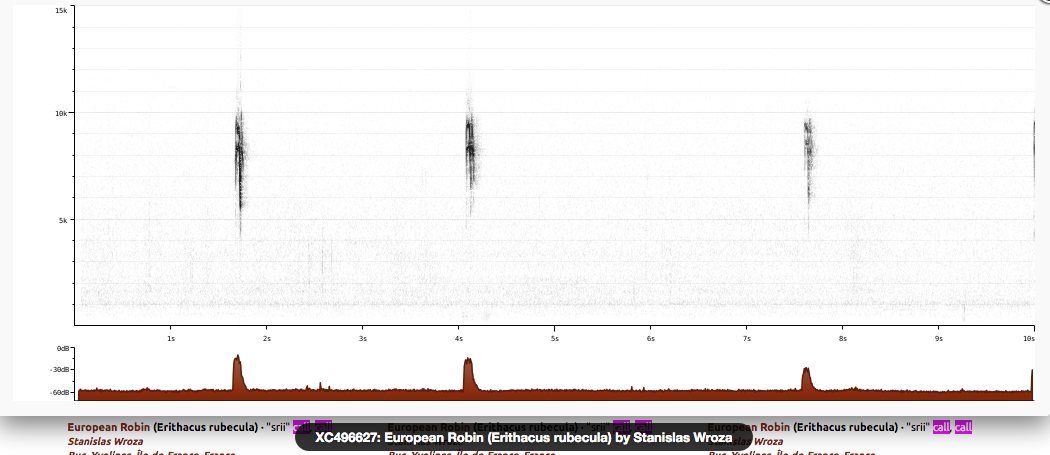
3:
"tsii".
General: A longer falling note (9Khz-7Khz) called a tsii by the recordist.
Call: ![]() Sound Approach: If you listen carefully you may notice that in the daytime, apart from the ubiquitous tik call, Robins also give a shrill tsi rather frequently. It is this tsi that they adapt for use as a nocturnal flight call. Nfc=night flight call. [Link]
Sound Approach: If you listen carefully you may notice that in the daytime, apart from the ubiquitous tik call, Robins also give a shrill tsi rather frequently. It is this tsi that they adapt for use as a nocturnal flight call. Nfc=night flight call. [Link]
In the sonogram it's a longer, falling note.
♫ In the sonogram it's a longer, falling note. Source: XENOCANTO
XC512416 - European Robin - Erithacus rubecula - named tsii or alarm call by recordist Marcin Solowiej in Poland.mp3
(call)
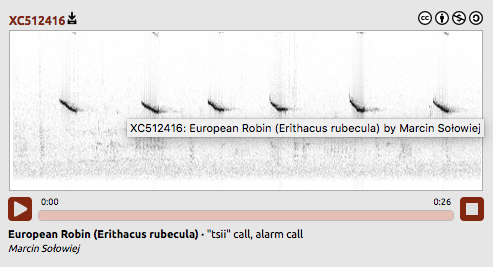
4:
Here is an audio of a high-pitched hawk call (7.5-8.5 KHz). See also a YouTube video comparing ground threats from aerial threats.
♫ Source: XENOCANTO
XC139085 - European Robin - Erithacus rubecula - hawk alarm call from Paul Driver.mp3
(alarm call)
Call attributes:
Call melody: one note, slow, Frequency: 4-9 KHz, Special sounds: sputter/pebble-clatter.
Common rock thrush / Steinrötel (Monticola saxatilis)
Steinroetel. 2022-05-21 15.36.14
First observed in 🇨🇭 on 2022-05-21.
General: ![]() The common rock thrush (Monticola saxatilis),[2] also known as rufous-tailed rock thrush or simply rock thrush, is a chat belonging to the family Muscicapidae. It was formerly placed in the family Turdidae. The scientific name is from Latin. Monticola is from mons, montis "mountain", and colere, "to dwell", and saxatilis means "rock-frequenting", from saxum, "stone" .[3]
[more]
The common rock thrush (Monticola saxatilis),[2] also known as rufous-tailed rock thrush or simply rock thrush, is a chat belonging to the family Muscicapidae. It was formerly placed in the family Turdidae. The scientific name is from Latin. Monticola is from mons, montis "mountain", and colere, "to dwell", and saxatilis means "rock-frequenting", from saxum, "stone" .[3]
[more]
Habitats:
Mountain
Song:
Nabu: Den weichen, melodischen Gesang trägt das Männchen zumeist im Singflug vor. [Link]
Song attributes:
Melody: improvised melodic, slow, Frequency: 2-8 KHz
Blue rock-thrush / Blaumerle (Monticola solitarius)
MerlinBirdID schlaegt Blaumerle vor, koennte aber genauso gut in Kaltbrunnerriet ein Amsel sein. 2022-06-04 12.05.18 Kaltbrunner-Riet
First observed in Mallorca on 2022-04-07.
![]() The blue rock thrush (Monticola solitarius) is a species of chat. This thrush-like Old World flycatcher was formerly placed in the family Turdidae. It breeds in southern Europe, northwest Africa, and from Central Asia to northern China and Malaysia. The blue rock thrush is the official national bird of Malta and was shown on the Lm 1 coins that were part of the country's former currency.
[more]
The blue rock thrush (Monticola solitarius) is a species of chat. This thrush-like Old World flycatcher was formerly placed in the family Turdidae. It breeds in southern Europe, northwest Africa, and from Central Asia to northern China and Malaysia. The blue rock thrush is the official national bird of Malta and was shown on the Lm 1 coins that were part of the country's former currency.
[more]
Habitats:
Mountain
Song:
Pretty short up-and-down song heard in Mallorca
Song attributes:
Melody: stereotype melodic, fast, Frequency: 2-4 KHz
♫ Source: XENOCANTO
XC659831 - Blue Rock Thrush - Monticola solitarius - song is a variable up and down - recorded in France.mp3
(song)

Call:
Automatically generated from Xeno-Canto recording
♫ Source: BirdNet
20220410_113007 birdnet - Blaumerle auf anderer Seite der Bucht in Cal dOr - Blaumerle - Felanitx.mp3
2022-04-10 11.30.07 Mallorca (song?)
Common nightingale / Nachtigall (Luscinia megarhynchos)
Profile Wikipedia eBird Vogelwarte BirdLife ZH ornitho.ch bird-song.ch Xeno-Canto BirdID NABU
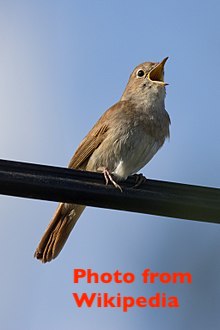
Luscinia megarhynchos - common nightingale in Wikipedia. Source: WIKIPEDIA
Luscinia_megarhynchos - common nightingale in Wikipedia.jpg
First observed in 🇨🇭 on 2020-04-19.
![]() The common nightingale, rufous nightingale or simply nightingale (Luscinia megarhynchos), is a small passerine bird best known for its powerful and beautiful song. It was formerly classed as a member of the thrush family Turdidae, but is now more generally considered to be an Old World flycatcher, Muscicapidae.[2] It belongs to a group of more terrestrial species, often called chats.
[more]
The common nightingale, rufous nightingale or simply nightingale (Luscinia megarhynchos), is a small passerine bird best known for its powerful and beautiful song. It was formerly classed as a member of the thrush family Turdidae, but is now more generally considered to be an Old World flycatcher, Muscicapidae.[2] It belongs to a group of more terrestrial species, often called chats.
[more]
Vocalization: ![]() It consists of extremely resonant, full-bodied notes and lacks the, dry, rolling, rattling sounds of T.N. Most distinct species specific sound is the interwoven series of slightly ascending, plaintive notes (0.04 - 0.10 in recording). May mimic Thrush Nightningale!. [Link]
It consists of extremely resonant, full-bodied notes and lacks the, dry, rolling, rattling sounds of T.N. Most distinct species specific sound is the interwoven series of slightly ascending, plaintive notes (0.04 - 0.10 in recording). May mimic Thrush Nightningale!. [Link]
Song: ![]() The song is the best characteristic to separate it from T. Nightingale. [Link]
The song is the best characteristic to separate it from T. Nightingale. [Link]
Calls: ![]() Alarm call either a thin, flycatcher-like "weeet", or a Chiff-chaff-like "piuu". Also a characteristic (but similar to Thrush Nighitingale) dry, rattling, frog-like "rrrrr". [Link]
Alarm call either a thin, flycatcher-like "weeet", or a Chiff-chaff-like "piuu". Also a characteristic (but similar to Thrush Nighitingale) dry, rattling, frog-like "rrrrr". [Link]
Physical details: length=16 cm,
wingspan=23-26 cm,
weight=17-24 g
Habitats:
Wetland
Song:
Can be a sequence of unrelated weird but musical sounds - trills, churrs, human-like whistles - very amusing.
Song attributes:
Melody: improvised melodic, slow, Frequency: medium (1-5 KHz) Special sounds: trill, whoop, weird Singing season: 04-15 - 06-30
♫ Source: XENOCANTO
XC505897 - Common Nightingale - Luscinia megarhynchos - song, recorded in Spain.mp3
Spain (song)

Call:
Automatically generated from Xeno-Canto recording
♫ Source: BirdNet
20200419_070922 birdnet 302 - Common nightingale.mp3
2020-04-19 07.09.22 Luppmen (song?)
Bluethroat / Blaukehlchen (Luscinia svecica)
I had an ID via app for an immature or female bluethroat - which has no blue throat, but long legs and a relatively short tail in comparison - could be this. 2024-02-17 07.02.22 Laos
First observed in Laos on 2024-02-17.
Looking for it in Kaltbrunnenriet - didn't find it in June 2022.
Sparrow-brown head, then strong blue, orange-brown, blue,dark brown, orange-brown, ending in a white belly!
Song: ![]() Song: Structure slightly similar to Nightingale, but tone much thinner and less full-bodied. A good impersonator and various imitations are interwoven among metallic, ringing sounds to form a complex, intriguing song. [Link]
Song: Structure slightly similar to Nightingale, but tone much thinner and less full-bodied. A good impersonator and various imitations are interwoven among metallic, ringing sounds to form a complex, intriguing song. [Link]
Calls: ![]() Call: "pju-check". Double syllable starting as a descending whistle, and ending on a short "check". [Link]
Call: "pju-check". Double syllable starting as a descending whistle, and ending on a short "check". [Link]
Physical details: length=14 cm,
wingspan=20-22 cm,
weight=15-25 g
Habitats:
Wetland
Song:
Often one little phrase or even a single note repeated, a bit like a nightingale? Occasional figaro?
Song attributes:
Melody: improvised melodic, fast, Frequency: 3-8 KHz Special sounds: trill
Collared flycatcher / Halsbandschnäpper (Ficedula albicollis)
Profile Wikipedia eBird Vogelwarte BirdLife ZH ornitho.ch Xeno-Canto NABU
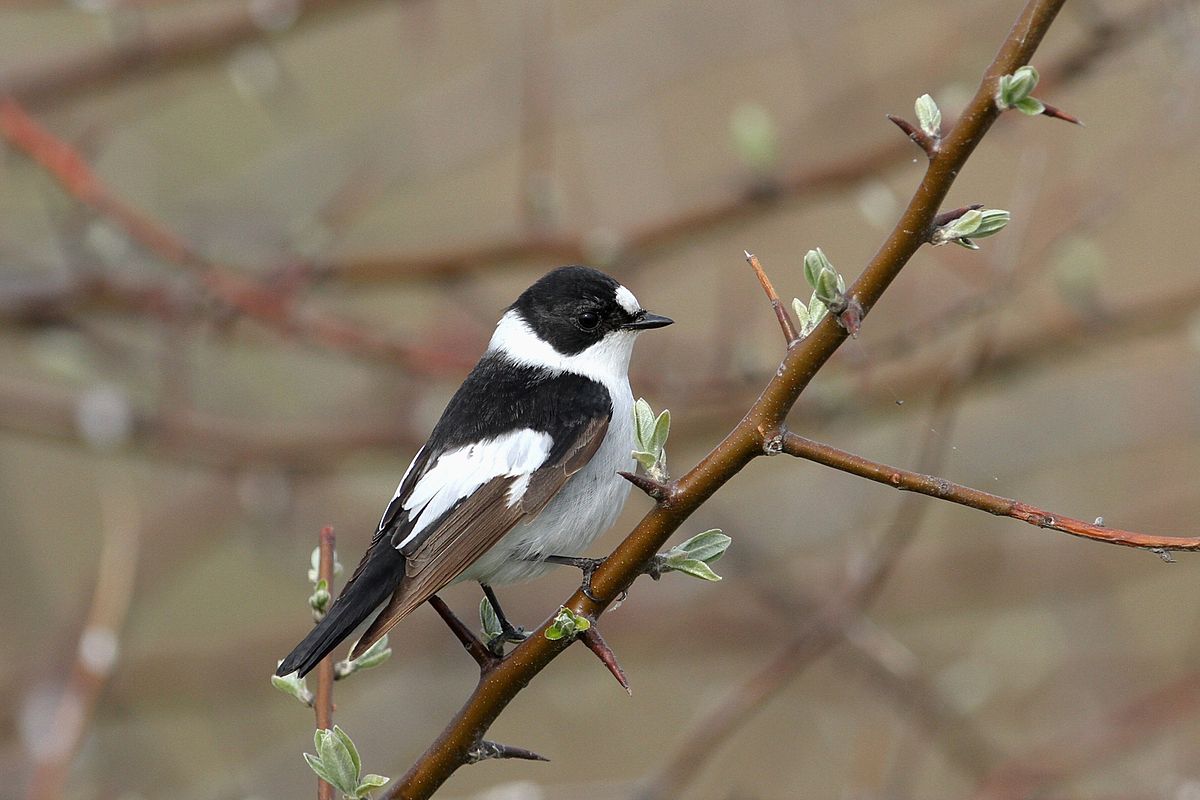
Wikipedia: Collared flycatcher Source: OTHER
1200px-Collared_flycatcher_%28Ficedula_albicollis%29.jpg
General: ![]() The collared flycatcher (Ficedula albicollis) is a small passerine bird in the Old World flycatcher family, one of the four species of Western Palearctic black-and-white flycatchers. It breeds in southeast Europe (isolated populations are present in the islands of Gotland and Öland in the Baltic Sea, Sweden) and Eastern France to the Balkan Peninsula and Ukraine and is migratory, wintering in sub Sahara Africa.[2] It is a rare vagrant in western Europe.
[more]
The collared flycatcher (Ficedula albicollis) is a small passerine bird in the Old World flycatcher family, one of the four species of Western Palearctic black-and-white flycatchers. It breeds in southeast Europe (isolated populations are present in the islands of Gotland and Öland in the Baltic Sea, Sweden) and Eastern France to the Balkan Peninsula and Ukraine and is migratory, wintering in sub Sahara Africa.[2] It is a rare vagrant in western Europe.
[more]
Habitats:
Forest
Song:
Simple tune...
Song attributes:
Mnemnoic: Mein Halsband, mein Halsband, er schnäppt Melody: stereotype melodic, fast, Frequency: 3-7 KHz
♫ Source: XENOCANTO
XC727811 - Collared Flycatcher - Ficedula albicollis - song, recorded in Croatia.mp3
(song)

♫ Source: XENOCANTO
XC727811 - Collared Flycatcher - Ficedula albicollis - song is variable, this improvises on a 4-note theme.mp3
(song)

European pied flycatcher / Trauerschnäpper (Ficedula hypoleuca)
Profile Wikipedia eBird Vogelwarte BirdLife ZH ornitho.ch bird-song.ch Xeno-Canto BirdID NABU
Trauerschnaepper. 2021-05-04 09.33.06 Flachsee am Reuss
First observed in 🇨🇭 on 2020-04-15.
Appearance and identification: ![]() Kleiner SW Vogel, Kopf schwarz mit weissem Punkt an der Stirn, Bauch weiss. Gesang gar nicht traurig! [Link]
Kleiner SW Vogel, Kopf schwarz mit weissem Punkt an der Stirn, Bauch weiss. Gesang gar nicht traurig! [Link]
Song: ![]() Song a pleasant, tuneful, simple but varied phrase. [Link]
Song a pleasant, tuneful, simple but varied phrase. [Link]
Calls: ![]() Alarm call a sharp, energetic "wit", often in combination with a short "tic"; "whit-tic". Typically starts with disyllabic notes being repeated 3-5 times, diminishing in pitch and intensity like an echo of the first two syllables. Occasionally throws in a quick diagnostic ascending scale excercise. Clear notes and well defined pauses between phrases. [Link]
Alarm call a sharp, energetic "wit", often in combination with a short "tic"; "whit-tic". Typically starts with disyllabic notes being repeated 3-5 times, diminishing in pitch and intensity like an echo of the first two syllables. Occasionally throws in a quick diagnostic ascending scale excercise. Clear notes and well defined pauses between phrases. [Link]
Physical details: length=13 cm,
wingspan=21-24 cm,
weight=10-15 g
Habitats:
Forest
Song:
Nice short melody, often with 2-note parts. Blackbird-like but little variation (though differs in dialect).
Song attributes:
Mnemnoic: Schwarzer Kopf aber nicht traurig Melody: stereotype melodic, fast, Frequency: 3-10 KHz
♫ Source: XENOCANTO
XC723965 - European Pied Flycatcher - Ficedula hypoleuca - song.mp3
(song)

Call:
Automatically generated from Xeno-Canto recording
♫ Source: BirdNet
20210504_093346 birdnet - European Pied Flycatcher - Unterlunkhofen.mp3
2021-05-04 09.33.46 Flachsee am Reuss (song?)
Spotted flycatcher / Grauschnäpper (Muscicapa striata)
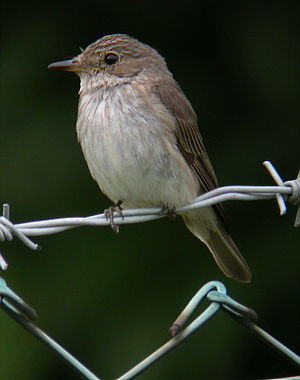
In a pinch barbed wire will do instead of a tree branch. Source: WIKIPEDIA
Wikipedia-300px-SpottedFlycatcheronfence.jpg
First observed in 🇨🇭 on 2020-06-03.
Perches on limbs in forest to swoop for insects and return to perch, specifically heard in woods near Staldenweiher.
Heard in woods near Staldenweiher, seen at Kaltbrunnerriet.
Has streaks on crown and breast, rather than spots.
Medium brown on head and back, light colored belly.
'Pincette-shaped beak'.
Gesang 'unauffaellig' - zirp x 2-3, mal steigender tWIT
Song: ![]() Song a primitive, slow series of various buzzing and very high pitched sounds. No recurring phrases. [Link]
Song a primitive, slow series of various buzzing and very high pitched sounds. No recurring phrases. [Link]
Calls: ![]() The discreet calls often goes unnoticed. Most calls high pitched with a buzzing, "electric" timbre. Alarm call a sharp, drawn "tzreeeee-check", with the second syllable abruptly clipping the sound. [Link]
The discreet calls often goes unnoticed. Most calls high pitched with a buzzing, "electric" timbre. Alarm call a sharp, drawn "tzreeeee-check", with the second syllable abruptly clipping the sound. [Link]
Physical details: length=14 cm,
wingspan=23-25 cm,
weight=14-20 g
Habitats:
Settlement
Song:
High (6-8 KHz?) short sound repeated every half to 5 seconds.
Song attributes:
Melody: simple rhythmic, slow, Frequency: 6-8 KHz
Call:
General: To me something between a one-note and an extremely simple melody, namely med-med chk-hi-med-med, with a very irregular speed, not at all like a metronome.
Call: ![]() Most calls high pitched with a buzzing, "electric" timbre. [Link]
Most calls high pitched with a buzzing, "electric" timbre. [Link]
XC656714 - Spotted Flycatcher - Muscicapa striata - Sounds similar to what I know.
♫ XC656714 - Spotted Flycatcher - Muscicapa striata - Sounds similar to what I know. Source: XENOCANTO
XC656714 - Spotted Flycatcher - Muscicapa striata.mp3
(call)
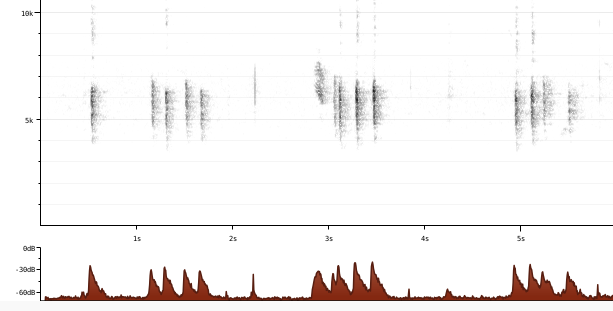
Call attributes:
Call melody: stereotype melodic, slow, Frequency: 4-7 KHz,
Stonechat / Schwarzkehlchen (Saxicola rubicola)
Schwarzkehlchen, Neunkirch. 2023-07-16 10.52.36 Neunkirch, Schaffhausen
First observed in 🇨🇭 on 2021-04-27.
Etymology: Nabu: Der wissenschaftlich Name „rubicola“ bedeutet „Brombeerstrauch-Bewohner“. Einzelne Sträucher auf einer sonst offenen Fläche fliegt das Schwarzkehlchen gerne an.
[Link]
![]() They breed in heathland, coastal dunes and rough grassland with scattered small shrubs and bramble, open gorse, tussocks or heather. [Link]
They breed in heathland, coastal dunes and rough grassland with scattered small shrubs and bramble, open gorse, tussocks or heather. [Link]
Song: ![]() The English name derives from its call, sounding like two stones knocked together. [Link]
The English name derives from its call, sounding like two stones knocked together. [Link]
![]() Gesang ähnlich obiger Art [Braunkehlchen]. Reine und kratzende Laute abwechselnd, wellenförmig
[Link]
Gesang ähnlich obiger Art [Braunkehlchen]. Reine und kratzende Laute abwechselnd, wellenförmig
[Link]
![]() The song is a sweet stream of scratchy notes. Much more even, and less chattering than the Whinchat. Almost like a short and scratchy Dunnock phrase. [Link]
The song is a sweet stream of scratchy notes. Much more even, and less chattering than the Whinchat. Almost like a short and scratchy Dunnock phrase. [Link]
Calls: ![]() hart „track“ oder „fiet-track-track“
[Link]
hart „track“ oder „fiet-track-track“
[Link]
![]() Alarm call an alternation of a high-pitched "weet" and a hard "check", like other chats. The "weet" is much higher pitched than the similar call of Whinchat, and Stonechat repeats the "check" more frequently. [Link]
Alarm call an alternation of a high-pitched "weet" and a hard "check", like other chats. The "weet" is much higher pitched than the similar call of Whinchat, and Stonechat repeats the "check" more frequently. [Link]
Physical details: length=12 cm,
wingspan=18-21 cm,
weight=13-17 g
Habitats:
Agricultural
Song:
General: Series of short, often squawky little bits, sometimes like a house sparrow, often repeated with only small variation. E.g. MmLMH?
Song: ![]() Kurzer Gesang, eher steigend 8-19 slurred notes. Or 21 43 2143 [Link]
Kurzer Gesang, eher steigend 8-19 slurred notes. Or 21 43 2143 [Link]
Song attributes:
Melody: improvised melodic, fast, Frequency: 2-7 KHz
♫ Source: XENOCANTO
XC710467 - European Stonechat - Saxicola rubicola rubicola.mp3
(song)
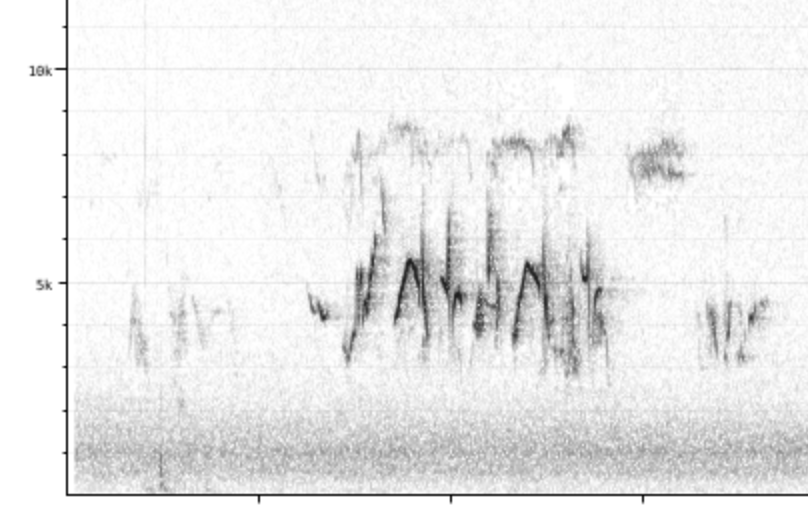
♫ Source: XENOCANTO
XC633658 - European Stonechat - Saxicola rubicola - song.mp3
(song)

Call:
Automatically generated from Xeno-Canto recording
♫ Source: BirdNet
20220604_133307 birdnet - Schwarzkehlchen - Benken.mp3
2022-06-04 13.33.07 Kaltbrunner-Riet (song?)
Whinchat / Braunkehlchen (Saxicola rubetra)
Profile Wikipedia eBird Vogelwarte BirdLife ZH ornitho.ch bird-song.ch Xeno-Canto BirdID NABU
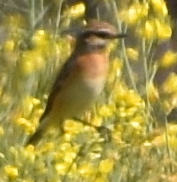
Mysterium im Rapsfeld von Friedliweid 2020-04-27 11.29.08 Luppmen
First observed in 🇨🇭 on 2020-05-07.
Die bauen ein Nest auf dem Boden auf einer Wiese oder Feld und brauchen relativ lang bis die Jungen flugge sind,
darum hoffe ich, dass sie weitergezogen sind. Da Felder selten so lang ungestört bleiben im Mittelland,
sind sie immer mehr in höheren Lagen zu finden.
Diesen Vogel haben wir paarweise in einem Rapsfeld entdeckt.
Von weitem konnte man nur etwas orange Farbe entdecken.
Ich habe ihn 2 Tage später im gleichen Feld gesucht und bin um das ganze Feld gelaufen.
Erst am Ende habe ich ihn gesehen: am Anfang, sicher 100m von mit entfernt und um 2 Ecken.
Da habe ich dieses Foto gemacht und in Büchern, Apps und Internet nach seiner Identität gesucht.
Als ich ein sehr ähnliches Bild auf ornitho.ch gefunden habe, wo er auch auf einer Rapspflanze drauf sitzt,
sah ich es als bestätigt, dass es ein Braunkelchen war.
Vocalization: ![]() The "peeu"-sound is depper and more resonant than similar sounds by Wheatear and Stonechat. [Link]
The "peeu"-sound is depper and more resonant than similar sounds by Wheatear and Stonechat. [Link]
Song: ![]() Kurzes (3-7 Töne) Liedchen mit 1-2 Kreischlauten, (ähnlich der Mittellaute b. Hausrotschwanz) variabel. Ahmt auch andere Vögel nach.
[Link]
Kurzes (3-7 Töne) Liedchen mit 1-2 Kreischlauten, (ähnlich der Mittellaute b. Hausrotschwanz) variabel. Ahmt auch andere Vögel nach.
[Link]
![]() Song variable with lots of mimicry. The short phrases starts with dry, rattling or sneering trills, followed by clear whistling notes and expert mimicry. More varied, both in tone and tempo, than both Stonechat and Wheatear. [Link]
Song variable with lots of mimicry. The short phrases starts with dry, rattling or sneering trills, followed by clear whistling notes and expert mimicry. More varied, both in tone and tempo, than both Stonechat and Wheatear. [Link]
Calls: ![]() „teck, teck“ (ähnlich wie wenn man zwei Steine zusammen schlägt)
[Link]
„teck, teck“ (ähnlich wie wenn man zwei Steine zusammen schlägt)
[Link]
![]() Contact call resembles many of it relatives. A short, soft "peeu", followed by a hard "check" (like hitting two rocks together). [Link]
Contact call resembles many of it relatives. A short, soft "peeu", followed by a hard "check" (like hitting two rocks together). [Link]
Physical details: length=12 cm,
wingspan=21-24 cm,
weight=14-19 g
Habitats:
Agricultural
Song:
General: Short buzzy trilly sounds, 5-8 notes, high.
Song: ![]() Gesang hat zwei Teile wie erster und dritter vom Hausrotschwanz. Steigend, fallend. [Link]
Gesang hat zwei Teile wie erster und dritter vom Hausrotschwanz. Steigend, fallend. [Link]
Song attributes:
Melody: improvised melodic, fast, Frequency: high (3-9 KHz) Special sounds: mimicry
Call:
Automatically generated from Xeno-Canto recording
♫ Source: BirdNet
20210504_074338 birdnet 1496 - Whinchat, review this id, its possible but I didn't see it - Whinchat - Rottenschwil.mp3
2021-05-04 07.43.38 Flachsee am Reuss (song?)
Presence: 03-20 - 10-15
Breeding: 05-10 - 08-10
Migration in: 03-20 - 05-15
Migration out: 07-20 - 10-15
Common stonechat / Afrikanische Schwarzkehlchen (Saxicola torquatus)
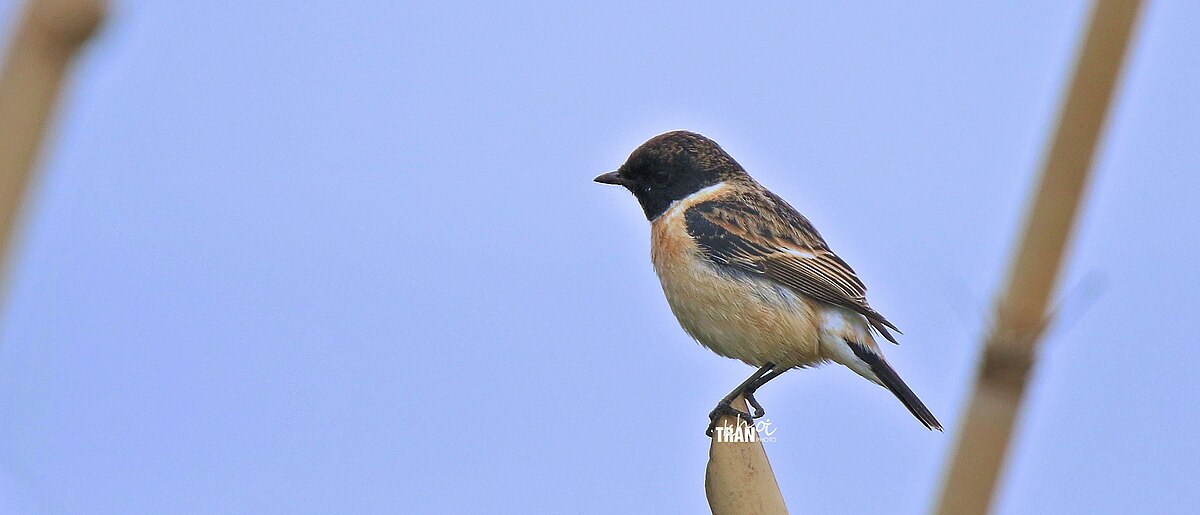
Wikipedia: Common stonechat Source: OTHER
1200px-Saxicola_stejnegeri%2C_Hanoi%2C_Vietnam_4G4A3231.jpg
Song:
Automatically generated from Xeno-Canto recording
Song attributes:
Frequency:
♫ XC633658 - European Stonechat - Saxicola rubicola - song. Source: XENOCANTO
XC633658 - European Stonechat - Saxicola rubicola - song.mp3
(song)

Call:
Automatically generated from Xeno-Canto recording
♫ XC710467 - European Stonechat - Saxicola rubicola rubicola. Source: XENOCANTO
XC710467 - European Stonechat - Saxicola rubicola rubicola.mp3
(song?)

Black redstart / Hausrotschwanz (Phoenicurus ochruros)
Profile Wikipedia eBird Vogelwarte BirdLife ZH ornitho.ch bird-song.ch Xeno-Canto BirdID NABU
Black redstart singing atop a tree This black redstart was singing in the tree by the tennis club behind the train station in Fehraltorf in April 2020 2020-04-23 11.17.18 Fehraltorf
First observed in 🇨🇭 on 2020-04-09.
Look for them in a treetop or the peak of a roof - they like to be heard and don't mind being seen.
Etymology: ![]() The English name Redstart intrigued me. According to Wikipedia, it comes from Middle English stert
meaning tail, so it's a redtail, which makes sense. As to black, they often look rather gray to me. [Link]
The English name Redstart intrigued me. According to Wikipedia, it comes from Middle English stert
meaning tail, so it's a redtail, which makes sense. As to black, they often look rather gray to me. [Link]
Vocalization: ![]() Next part is rather unique, and sounds as if shaking a handful of gravel. The phrase then usually closes with a couple of trills. [Link]
Next part is rather unique, and sounds as if shaking a handful of gravel. The phrase then usually closes with a couple of trills. [Link]
Song: Other: Einige Arten wie der Hausrotschwanz singen zudem im Herbst, bevor sie in ihr Winterquartier ziehen. Die Männchen legen dann ihre Reviere bereits «provisorisch» fest. [Link]
![]() Am Morgen der erste Sänger: Kurzes dreiteiliges Liedchen, meist von Warte aus gesungen. Mittelstück aus rauen gequetschten Tönen. (als ob kurz die Stimme verloren)
[Link]
Am Morgen der erste Sänger: Kurzes dreiteiliges Liedchen, meist von Warte aus gesungen. Mittelstück aus rauen gequetschten Tönen. (als ob kurz die Stimme verloren)
[Link]
![]() Song consists of three parts and is distinct if heard well. It opens with some clear notes that may form a trill, which are then followed by a pause. The "gravel-part" does not carry as far as the rest of the song. [Link]
Song consists of three parts and is distinct if heard well. It opens with some clear notes that may form a trill, which are then followed by a pause. The "gravel-part" does not carry as far as the rest of the song. [Link]
Calls: ![]() „hüid-tze“ das tze deutlich tiefer.
[Link]
„hüid-tze“ das tze deutlich tiefer.
[Link]
![]() Alarm call is a chat-like alternation between short, high-pitched "wit" sounds, and series of hard and dry "teck". [Link]
Alarm call is a chat-like alternation between short, high-pitched "wit" sounds, and series of hard and dry "teck". [Link]
Physical details: length=14 cm,
wingspan=23-26 cm,
weight=13-19 g
Habitats:
Settlement
Song:
The song is two parts and unvarying. If it were a pop song, you'd call it ABABAB... The second part starts with a
sputtering trill. The RSPB in the UK says 'warble with crackling trills.' Vogelwarte.ch says
'Der gepresst knirschende Gesang setzt meist lange vor Sonnenaufgang ein und ist der Auftakt für das Vogelkonzert.'
BirdLife-Zuerich.ch says 'Einziger Sänger morgens um drei in den Häuserschluchten'.
Obwohl NABU.de meint, sie singen nicht mehr nach Juli, war ich angenehm überrascht sie in Oktober im Tessin zu hören.
Song attributes:
Melody: stereotype melodic, slow, Frequency: high (3-9 KHz) Special sounds: churr Singing season: 03-01 - 07-31 Dawn chorus start, 70 minutes before dawn.
Calls:
1:
XC560014 matches exactly what BirdID describes: 'Alarm call is a chat-like alternation between short, high-pitched "wit" sounds, and series of hard and dry "teck".' The high-pitched call I heard recently was between 5 and 6 KHz, which could help to distinguish between other birds with a deeper voice. The whooping call is sometimes listed as an alarm call.
♫ Source: XENOCANTO
XC657510 - Black Redstart - Phoenicurus ochruros - call.mp3
(call)

♫ Very high notes. Source: XENOCANTO
XC560014 black redstart call.mp3
(call)

2:
Begging call sputters
♫ Source: XENOCANTO
XC567747-Black Redstart begging call.mp3
(begging call)
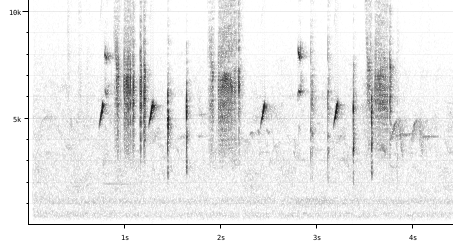
Call attributes:
Call melody: one note, slow, Frequency: 4-5 KHz, Special sounds: whoop, sputter/pebble-clatter.
Common redstart / Gartenrotschwanz (Phoenicurus phoenicurus)
Common redstart on a cable In Locarno-Monti 2020-06-17 14.29.54 Locarno
First observed in 🇨🇭 on 2020-04-27.
I'd only seen them in Locarno - but I liked them! Later in our FOK expediton to cultural areas around Maienfeld, they were quite common. Also heard many near Frankfurt and Mainz.
I'd only seen them in Locarno - but I liked them! Later in our FOK expediton to cultural areas around Maienfeld, they were quite common. Also heard many near Frankfurt and Mainz.
Red-orange belly with white further down, grey back and head, black beard up to eyes with white eyebrows
In Locarno in 2020, they were often hidden in trees but also visible on powerlines. In 2021 one sang every morning at 5:00 in a gingko tree next to our room in Casa Egner.
Song: ![]() Fängt immer mit denselben 3 Tönen an, einem „dih dede“, wobei das dih etwa ein bis zwei Töne höher liegt. Dann folgt eine kurze Strophe mehr oder weniger reine Töne. Das Ganze ist ziemlich individuell.
[Link]
Fängt immer mit denselben 3 Tönen an, einem „dih dede“, wobei das dih etwa ein bis zwei Töne höher liegt. Dann folgt eine kurze Strophe mehr oder weniger reine Töne. Das Ganze ist ziemlich individuell.
[Link]
![]() Song distinct, with three parts: First an ascending single note, immediately followed by a trill, then concluding with a squeaky, rattling improvisation that usually contains some mimicry. [Link]
Song distinct, with three parts: First an ascending single note, immediately followed by a trill, then concluding with a squeaky, rattling improvisation that usually contains some mimicry. [Link]
Calls: ![]() „Füid-tack“ das füid ähnlich dem des Fitislaubsängers, das tack schnalzend. (wie wenn man die Zunge schnell vom Gaumen abzieht)
[Link]
„Füid-tack“ das füid ähnlich dem des Fitislaubsängers, das tack schnalzend. (wie wenn man die Zunge schnell vom Gaumen abzieht)
[Link]
![]() Alarm call a slightly drawn, Willow Warbler-like "huit" with a rising pitch, followed by a short, soft "tuc". [Link]
Alarm call a slightly drawn, Willow Warbler-like "huit" with a rising pitch, followed by a short, soft "tuc". [Link]
Physical details: length=14 cm,
wingspan=20-24 cm,
weight=11-19 g
Habitats:
Settlement
Song:
I though I had these guys figured out after hearing them in Locarno several times, but they're hard to get a handle on! At BirdID they are described the first two parts of a three-part song like this: 'an ascending single note, immediately followed by a trill', whereas in Locarno I heard an initial high-low-high-low, sometimes without the final low, perhaps also a quick middle note, and no trill. Then a relatively short blackbird or warbler-like tune of maybe 5-8 notes. Listening to more recordings at XenoCanto has completely confused me now! BirdID also says the song is similar to the black redstart, which I sometimes hear at XenoCanto, but never did in Locarno! They also note a similarity to the Lesser Whitethroat (Klappergrasmücke), which I hope to hear in Maienfeld.
Song attributes:
Melody: stereotype melodic, slow, Frequency: high (3-9 KHz) Special sounds: mimicry Singing season: 04-01 - 07-31 Dawn chorus start, 80 minutes before dawn.
♫ 2021-05-10 05.07.35 Locarno (song)
Call:
At least in French, this is called the huit call. Not very consistent in tone from one note to another. Some stick to 3-4 or 3-4.5 KHz, others 2.5-5.5.
♫ Source: XENOCANTO
XC551707 - Common Redstart - Phoenicurus phoenicurus.mp3
(call)
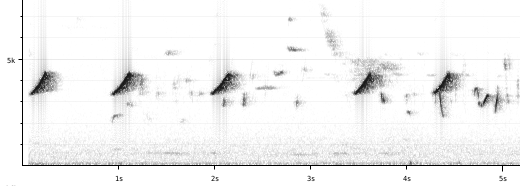
♫ Seine-et-Marne, Île-de-France recorded by Julien Rochefort - perhaps this isn't a good example as he writes 'An independent juvenile. Its calls are quite irregular. Difficult to distinguish from Phylloscopus collybita, when they don't insert the "tec tec" calls between "huit ...... huit"! But it was really a phoenicurus phoenicurus juvenile, easy to see, perched 15m from me.' Source: XENOCANTO
XC146715 common redstart huit call.mp3
(call)

♫ Source: XENOCANTO
XC560039 - Common Redstart - Phoenicurus phoenicurus phoenicurus.mp3
(alarm call)
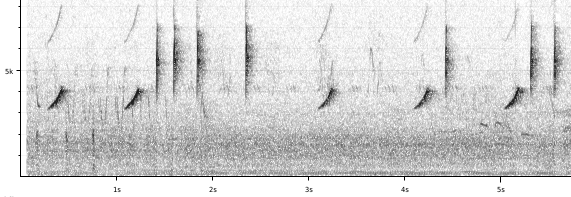
Call attributes:
contact call Call melody: one note, slow, Frequency: 2-5 KHz, Special sounds: whoop.
Presence: 03-20 - 10-25
Breeding: 05-01 - 07-15
Migration in: 03-20 - 05-07
Migration out: 07-15 - 10-25
Northern wheatear / Steinschmätzer (Oenanthe oenanthe)
Profile Wikipedia eBird Vogelwarte BirdLife ZH ornitho.ch Audubon AllAboutBirds Xeno-Canto BirdID NABU

Male northern wheatear, photo by Andreas Trepte - Own work, CC BY-SA 2.5 Source: WIKIPEDIA
Wikimedia Steinschmaetzer_Northern_wheatear_male.jpg
First observed in 🇨🇭 on 2021-07-29.
This bird appears across the great seas in the following continents:
Europe, North America, Africa.
General: I thought after seeing these at over 2700 meters that they must be a typical mountain bird (and in the FOK Zurich materials they were in the mountain section), however Wikipedia explains that such a stony landscape is the key, whether that is high or not:
Geography: ![]() The northern wheatear is a migratory insectivorous species breeding in open stony country in Europe and east across the Palearctic with footholds in northeastern Canada and Greenland as well as in northwestern Canada and Alaska. It nests in rock crevices and rabbit burrows. All birds spend most of their winter in Africa. ... Miniature tracking devices have recently shown that the northern wheatear has one of the longest migratory flights known - 30,000 km (18,640 miles), from sub-Saharan Africa to their Arctic breeding grounds.[15] [Link]
The northern wheatear is a migratory insectivorous species breeding in open stony country in Europe and east across the Palearctic with footholds in northeastern Canada and Greenland as well as in northwestern Canada and Alaska. It nests in rock crevices and rabbit burrows. All birds spend most of their winter in Africa. ... Miniature tracking devices have recently shown that the northern wheatear has one of the longest migratory flights known - 30,000 km (18,640 miles), from sub-Saharan Africa to their Arctic breeding grounds.[15] [Link]
Strangely the residence and migration maps differ greatly by source: in Wikipedia the northern wheatear spends winter in subsaharan Africa, while the authoratitive Kosmos-Vogelführer shows some in northern Africa like Morocco. Most other sources agree with Wikipedia and Sub-Saharan Africa.
I thought the German name Steinschmätzer, presumably stone kisser (no one explains it, oddly enough) to be much more logical than the English northern wheatear. I was greatly amused to look it up and find it to be a 'folk etymology of "white" and "arse"' (Wikipedia).
Etymology: ![]() The genus name Oenanthe is derived from the Greek oenos (οίνος) "wine" and anthos (ανθός) "flower". It refers to the northern wheatear's return to Greece in the spring just as the grapevines blossom. [Link]
The genus name Oenanthe is derived from the Greek oenos (οίνος) "wine" and anthos (ανθός) "flower". It refers to the northern wheatear's return to Greece in the spring just as the grapevines blossom. [Link]
It has an evil-looking black eye stripe like the shrike. (I liked Nici Baiker's description of it in the FOK field ornithology course as 'Zorro look'.) I saw one flying on Muottas Muragl and thought the striking gray oval surrounded by dark feathers has to be typical and seems unique to the northern wheatear.
In den FOK Unterlagen werden die Zugrouten von Alaska und von nordosten Kanada gezeigt, die beide fuer Winter nach Afrika ziehen. Die aus Alaska fliegen ueber Asien unglaubliche 15000 Kilometer! Die in Kanada haben es auch nicht leicht, da sie zuerst ueber den Atlantik nach Spanien fliegen!
Vocalization: ![]() Each phrase is often introduced by the "weet" sound, then followed by hastened, creaking, rattling and warbling sounds of 1-2 seconds duration. [Link]
Each phrase is often introduced by the "weet" sound, then followed by hastened, creaking, rattling and warbling sounds of 1-2 seconds duration. [Link]
Song: ![]() Kurze, wechselvolle Strophe mit vielen unreinen Tönen. Meist von erhöhter Warte aus oder in kurzem Singflug vorgetragen.
[Link]
Kurze, wechselvolle Strophe mit vielen unreinen Tönen. Meist von erhöhter Warte aus oder in kurzem Singflug vorgetragen.
[Link]
![]() The Wheatear song consists of short phrases with marked pauses. The "check" sound is also often included in the song. [Link]
The Wheatear song consists of short phrases with marked pauses. The "check" sound is also often included in the song. [Link]
Calls: ![]() „Tschack“ auch „hiit“ (saugend)
[Link]
„Tschack“ auch „hiit“ (saugend)
[Link]
![]() Contact and alarm call a high pitched, sharp "weet", followed by a hard "check", like hitting two rocks together. The "weet" sound is much sharper than the similar sound in Whinchat and Stonechat. Wheater usually repeats the "weet" sound more frequently than the "check" sound. The "check" of Stonechat is less pure and more gritty. [Link]
Contact and alarm call a high pitched, sharp "weet", followed by a hard "check", like hitting two rocks together. The "weet" sound is much sharper than the similar sound in Whinchat and Stonechat. Wheater usually repeats the "weet" sound more frequently than the "check" sound. The "check" of Stonechat is less pure and more gritty. [Link]
Physical details: length=14-15 cm,
wingspan=26-32 cm,
weight=18-29 g
Habitats:
Mountain
Looks similar to:
Red-backed shrike.
Song:
![]() The Wheatear song consists of short phrases with marked pauses. Each phrase is often introduced by the "weet" sound, then followed by hastened, creaking, rattling and warbling sounds of 1-2 seconds duration. The "check" sound is also often included in the song. [Link]
The Wheatear song consists of short phrases with marked pauses. Each phrase is often introduced by the "weet" sound, then followed by hastened, creaking, rattling and warbling sounds of 1-2 seconds duration. The "check" sound is also often included in the song. [Link]
Song attributes:
Melody: improvised melodic, fast, Frequency: 2-6 KHz Special sounds: rasp, rattle
♫ Source: XENOCANTO
XC730221 - Northern Wheatear - Oenanthe oenanthe - song recorded in France, just 2-3 notes, then long pause.mp3
(song)

♫ Source: XENOCANTO
XC764932 - Northern Wheatear - Oenanthe oenanthe - song recorded in Sweden with lots of whoops and swoops, about 2 seconds long, then 3-4 seconds pause.mp3
(song)

♫ Source: XENOCANTO
XC319898 - Northern Wheatear - Oenanthe oenanthe - song recorded in Scotland and includes creaking or rattling mentioned at Nord U BirdID.mp3
Scotland (song)

♫ Source: XENOCANTO
XC769228 - Northern Wheatear - Oenanthe oenanthe - song recorded in the Netherlands.mp3
(song)

Call:
Automatically generated from Xeno-Canto recording
♫ Source: BirdNet
20210729_130731 birdnet 1864 - Northern Wheatear at lej muragl - Northern Wheatear - Samedan.mp3
2021-07-29 13.07.31 Lej muragl (song?)
European nuthatch / Kleiber (Sitta europaea)
Kleiber schwaendi. 2020-04-04 15.28.00 Luppmen
First observed in 🇨🇭 on 2020-04-04.
Maybe 8 or 10 short loud notes, a bit of a whoop on the sonogram
Vocalization: Other: Eurasian Nuthatch is very vocal. [Link]
![]() Very varied voice. [Link]
Very varied voice. [Link]
Song: Other: The song is very variable, with rising and falling notes, sometimes with repetition of excitement calls. [Link]
![]() The song is a slow whistled pee-pee-pee with many variants, including a faster version, and may be intermingled with the call. [Link]
The song is a slow whistled pee-pee-pee with many variants, including a faster version, and may be intermingled with the call. [Link]
Other: Song a simple series of loud notes. [Link]
![]() Song a simple series of loud notes. [Link]
Song a simple series of loud notes. [Link]
Calls: Other: It gives loud calls when excited, an abrupt ‘twit”, only one, or in slow series, but often in phrases of 3-4 notes in rapid succession. But in great excitement, it utters phrases of about ten notes per second!
We can also hear some shrill “sirrrr”, becoming harsher in alarm call. The contact call is a thin “tsit” uttered before to take off.
[Link]
![]() The Eurasian nuthatch calls frequently, usually with a loud, sharp dwip normally repeated twice, sometimes more often if excited. It has a shrill sirrrr or tsi-si-si alarm call, and a thin tsit pre-flight call. [Link]
The Eurasian nuthatch calls frequently, usually with a loud, sharp dwip normally repeated twice, sometimes more often if excited. It has a shrill sirrrr or tsi-si-si alarm call, and a thin tsit pre-flight call. [Link]
Other: Very varied voice. Ranging from very high pitched whistles and melodic resonant calls, to chattering and nasal mocking sounds. Characteristic warning call a hard "check" or "chwit", often in rapid series, like a pebble bouncing on hollow ice. [Link]
![]() Ranging from very high pitched whistles and melodic resonant calls, to chattering and nasal mocking sounds. Characteristic warning call a hard "check" or "chwit", often in rapid series, like a pebble bouncing on hollow ice. [Link]
Ranging from very high pitched whistles and melodic resonant calls, to chattering and nasal mocking sounds. Characteristic warning call a hard "check" or "chwit", often in rapid series, like a pebble bouncing on hollow ice. [Link]
Physical details: length=14 cm,
wingspan=22-27 cm,
weight=21-26 g
Habitats:
Forest
Song:
Song: ![]() Song a simple series of loud notes [Link]
Song a simple series of loud notes [Link]
Song attributes:
Melody: one note, fast, Frequency: medium (1-5 KHz) Singing season: 02-01 - 07-31 Dawn chorus start, 10 minutes before dawn.
♫ Is the brevity what makes it a song, whereas calls seem to go on endlessly? Source: XENOCANTO
XC777051 - Eurasian Nuthatch - Sitta europaea, recorded in France and designated as song - a series of 5-6 whoops, pause and repeat, hard for me to distinguish from a ca-ll.mp3
(song)
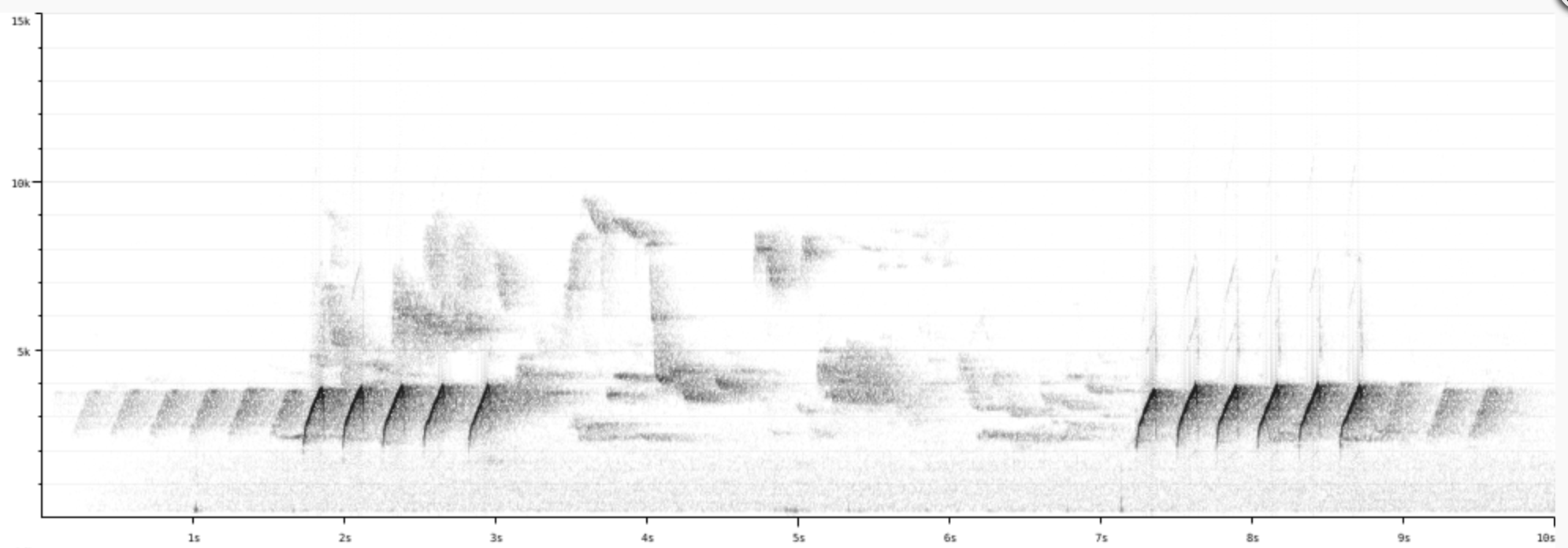
Calls:
1:
Twit, dwip.
A long fast sequence of notes - is it the 'twit' call mentioned above?
Long fast sequence of identical whoops, possibly 'twit' call.
♫ Long fast sequence of identical whoops, possibly 'twit' call. Source: XENOCANTO
XC129686 - Eurasian Nuthatch - Sitta europaea caesia.mp3
(call)
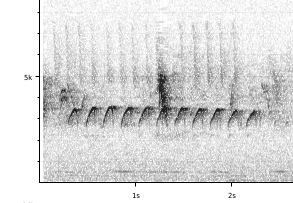 Similar to XC423335 but very regular rhythm
Similar to XC423335 but very regular rhythm
♫ Similar to XC423335 but very regular rhythm Source: XENOCANTO
XC781193 - Eurasian Nuthatch - Sitta europaea - call, one note, regular rhythm, 2 per second, recorded in Spain.mp3
Spain (call)
 One note, irregular rhythm. A bird calling while moving up a pine tree (says recordist Nick Talbot).
One note, irregular rhythm. A bird calling while moving up a pine tree (says recordist Nick Talbot).
♫ One note, irregular rhythm. A bird calling while moving up a pine tree (says recordist Nick Talbot). Source: XENOCANTO
XC423335 - Eurasian Nuthatch - Sitta europaea caesia.mp3
(call)

2:
The Nuthatch whoop call is similar to that of the chaffinch.
It repeats it about 4 times.
3:
Tsit.
Recordist Stanislav Wroz says flight call.
Flight call in Dampierre-en-Yvelines, Yvelines, Île-de-France. Wikipedia describes a 'thin tsit pre-flight call'.
♫ Flight call in Dampierre-en-Yvelines, Yvelines, Île-de-France. Wikipedia describes a 'thin tsit pre-flight call'. Source: XENOCANTO
XC522601 - Eurasian Nuthatch - Sitta europaea.mp3
(flight call)
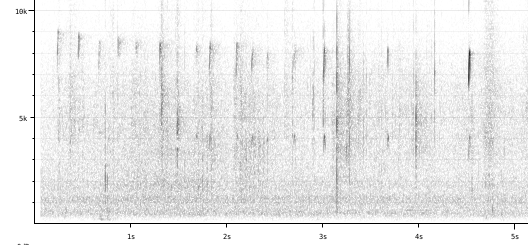
Call attributes:
Call melody: one note, fast, Frequency: 2-3 KHz,
Wallcreeper / Mauerläufer (Tichodroma muraria)
Profile Wikipedia eBird Vogelwarte BirdLife ZH ornitho.ch Xeno-Canto BirdID NABU

Wikipedia: Wallcreeper Source: OTHER
1200px-Wallcreeper_%28Tichodroma_muraria%29_female_Piatra_Craiului.jpg
General: ![]() The wallcreeper (Tichodroma muraria) is a small passerine bird found throughout the high mountains of the Palearctic from southern Europe to central China. It is the only extant member of both the genus Tichodroma and the family Tichodromidae.
[more]
The wallcreeper (Tichodroma muraria) is a small passerine bird found throughout the high mountains of the Palearctic from southern Europe to central China. It is the only extant member of both the genus Tichodroma and the family Tichodromidae.
[more]
Song: ![]() Song variable in length, but main characteristic a sequence of 4-6 long, ascending whistles with timbre recalling whistling kettle. More complex and varied phrases are mixed with the long whistles. Both male and female sings. [Link]
Song variable in length, but main characteristic a sequence of 4-6 long, ascending whistles with timbre recalling whistling kettle. More complex and varied phrases are mixed with the long whistles. Both male and female sings. [Link]
Calls: ![]() Alarm call a thin trilling "vuiirrrrrrr". Flight call one or several soft whistles, often with (very) short trill as attack or tail. [Link]
Alarm call a thin trilling "vuiirrrrrrr". Flight call one or several soft whistles, often with (very) short trill as attack or tail. [Link]
Physical details: length=16 cm,
wingspan=27-32 cm,
weight=15-19 g
Habitats:
Mountain
Song:
5-notes LlmHh with pirol-like slowness and tone.
Song attributes:
Melody: stereotype melodic, fast, Frequency: 1-5 KHz
Eurasian Wren foraging in the reeds at the frozen Lake Pfaeffikon 2021-02-15 08.41.30 Pfäffikersee
First observed in 🇨🇭 on 2019-07-07.
Etymology: ![]() The scientific name is taken from the Greek word "troglodytes" (from trogle a hole, and dyein to creep), meaning "cave-dweller",[4] and refers to its habit of disappearing into cavities or crevices whilst hunting arthropods or to roost. [Link]
The scientific name is taken from the Greek word "troglodytes" (from trogle a hole, and dyein to creep), meaning "cave-dweller",[4] and refers to its habit of disappearing into cavities or crevices whilst hunting arthropods or to roost. [Link]
Song: ![]() Auffällig laut für den kleinen Vogel. Singt auch im Winter! Schmetternd, mit einem bis zwei Trillern als letztes oder vorletztes Glied.
[Link]
Auffällig laut für den kleinen Vogel. Singt auch im Winter! Schmetternd, mit einem bis zwei Trillern als letztes oder vorletztes Glied.
[Link]
![]() Song surprisingly loud. A high-pitched stream of clear notes resembling Robin and Dunnock in timbre. Differs from those in showing frequent shifts in pitch with much larger register than Dunnock, and by the unique, numerous, interspersed long trills. [Link]
Song surprisingly loud. A high-pitched stream of clear notes resembling Robin and Dunnock in timbre. Differs from those in showing frequent shifts in pitch with much larger register than Dunnock, and by the unique, numerous, interspersed long trills. [Link]
Calls: ![]() „zerr“ (z-und rr-gleichzeitig) auch durchdringendes „tzr“(Gezetter)
[Link]
„zerr“ (z-und rr-gleichzeitig) auch durchdringendes „tzr“(Gezetter)
[Link]
![]() Warning call a short hard "teck", like banging two rocks together. Often repeated in series when excited to form machine-gun-like "firing". [Link]
Warning call a short hard "teck", like banging two rocks together. Often repeated in series when excited to form machine-gun-like "firing". [Link]
Physical details: length=9-10 cm,
wingspan=13-17 cm,
weight=7-12 g
Habitats:
Forest
Song:
High-pitched, melodic, very variable with many trills and whistles.
Song attributes:
Melody: improvised melodic, fast, Frequency: high (3-9 KHz) Special sounds: trill Singing season: 02-01 - 07-31 Dawn chorus start, 40 minutes before dawn.
Call:
Sputtery/drippy/trilly repeated notes at 3-8 KHz. June 2022 heard check calls that were distinctly irregularly in their rhythm.
Call attributes:
Call melody: one note, slow, Frequency: 3-8 KHz, Special sounds: sputter/pebble-clatter.
Profile Wikipedia eBird Vogelwarte BirdLife ZH ornitho.ch bird-song.ch Xeno-Canto NABU
Gartenbaumlaeufer, Mesikomerweg, Pfaeffikersee. 2021-04-27 17.01.28 Pfäffikersee
First observed in 🇨🇭 on 2020-10-16.
General: ![]() The short-toed treecreeper (Certhia brachydactyla) is a small passerine bird found in woodlands through much of the warmer regions of Europe and into north Africa. It has a generally more southerly distribution than the other European treecreeper species, the common treecreeper, with which it is easily confused where they both occur. The short-toed treecreeper tends to prefer deciduous trees and lower altitudes than its relative in these overlap areas. Although mainly sedentary, vagrants have occurred outside the breeding range.
[more]
The short-toed treecreeper (Certhia brachydactyla) is a small passerine bird found in woodlands through much of the warmer regions of Europe and into north Africa. It has a generally more southerly distribution than the other European treecreeper species, the common treecreeper, with which it is easily confused where they both occur. The short-toed treecreeper tends to prefer deciduous trees and lower altitudes than its relative in these overlap areas. Although mainly sedentary, vagrants have occurred outside the breeding range.
[more]
Song: ![]() Kurz u. bündig! (Gartenwege sind kurz.) Tonreihe am Schluss ansteigend. „Hesch du gseh woni bi?
[Link]
Kurz u. bündig! (Gartenwege sind kurz.) Tonreihe am Schluss ansteigend. „Hesch du gseh woni bi?
[Link]
Calls: ![]() scharf „tiit, sri“ [Link]
scharf „tiit, sri“ [Link]
Habitats:
Forest
Looks similar to:
Eurasian treecreeper.
Song:
General: It sounds to me like a 5-7 note song like 'five k low high higher', 'short song in the gar-DEN'. The individual notes have the same backward checkmark shape as the call. It's basically the same across Europe.
Song: ![]() The song of the nominate subspecies is an evenly spaced sequence of notes teet-teet-teet-e-roi-tiit. [Link]
The song of the nominate subspecies is an evenly spaced sequence of notes teet-teet-teet-e-roi-tiit. [Link]
![]() Its song is short, loud and rhythmic. [Link]
Its song is short, loud and rhythmic. [Link]
![]() [In comparison with the visually similar Eurasian treecreeper, it] has a clearer, louder more staccato contact call of ‘sreet’ or ‘sree’ and a short ‘wit’ during normal activity [Link]
[In comparison with the visually similar Eurasian treecreeper, it] has a clearer, louder more staccato contact call of ‘sreet’ or ‘sree’ and a short ‘wit’ during normal activity [Link]
Song attributes:
Mnemnoic: 'short song in the gar-DEN' Melody: stereotype melodic, slow, Frequency: 4-7 KHz
♫ Source: XENOCANTO
XC625133 - Short-toed Treecreeper - Certhia brachydactyla - song.mp3
(song)

Call:
General: See the sonogram how the song may descend rapidly from 7Khz to and then climb from 5 to 5.75 KHz, a kind of reversed checkmark. However I find it hard to distinguish from a single note. I'm not a bird ;-(
Call: ![]() calls with a loud (Wikipedia says shrill) “tyt tyt” [Link]
calls with a loud (Wikipedia says shrill) “tyt tyt” [Link]
A recording from Jorge Leitão in the Netherlands that I assume is the tyt tyt call.
♫ A recording from Jorge Leitão in the Netherlands that I assume is the tyt tyt call. Source: XENOCANTO
XC569503 - Short-toed Treecreeper - Certhia brachydactyla.mp3
(call)
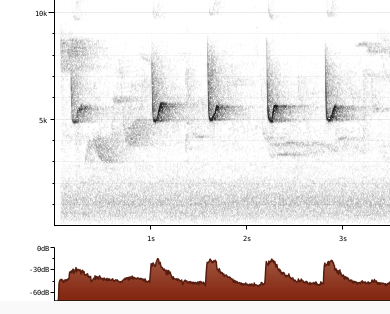
Call attributes:
Call melody: one note, slow, Frequency: 5-7 KHz,
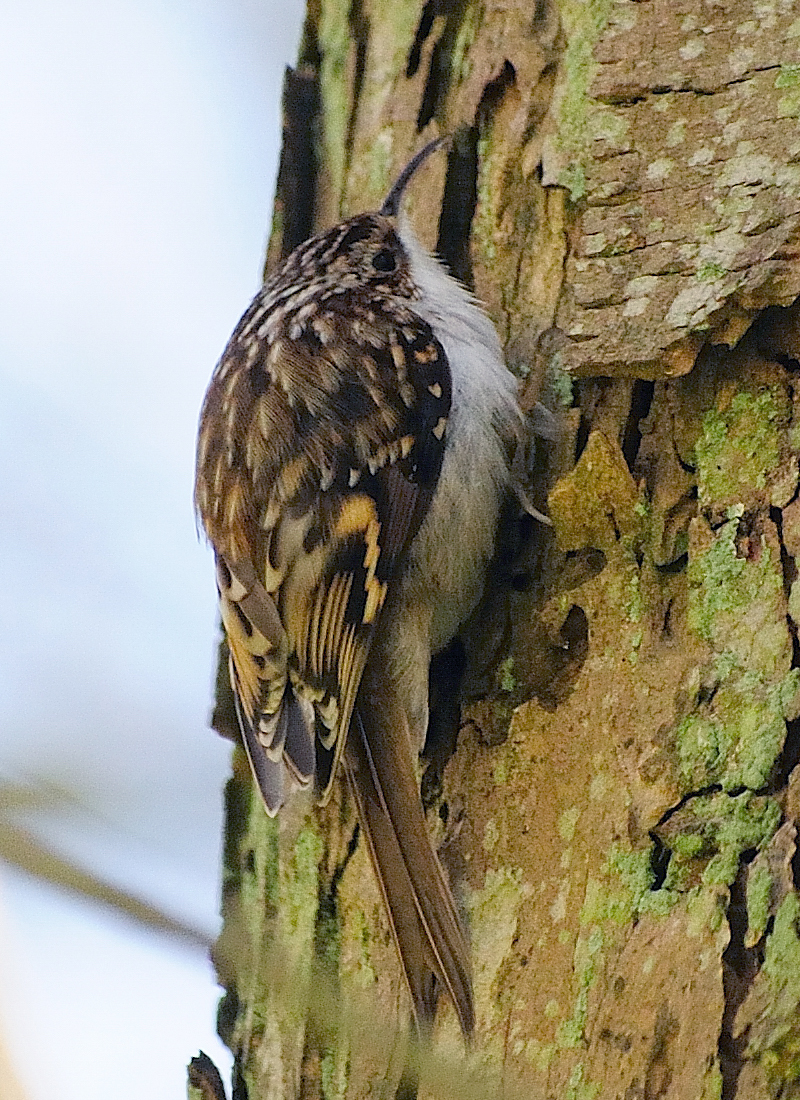
As seen creeping up a tree trunk Source: WIKIPEDIA
Wikimedia - European Treecreeper - Certhia_familiaris_-climbing_tree-8_(cropped_version).jpg
First observed in 🇨🇭 on 2020-04-25.
General: ![]() The Eurasian treecreeper or common treecreeper (Certhia familiaris) is a small passerine bird also known in the British Isles, where it is the only living member of its genus, simply as treecreeper. It is similar to other treecreepers, and has a curved bill, patterned brown upperparts, whitish underparts, and long stiff tail feathers which help it creep up tree trunks. It can be most easily distinguished from the similar short-toed treecreeper, which shares much of its European range, by its different song.
[more]
The Eurasian treecreeper or common treecreeper (Certhia familiaris) is a small passerine bird also known in the British Isles, where it is the only living member of its genus, simply as treecreeper. It is similar to other treecreepers, and has a curved bill, patterned brown upperparts, whitish underparts, and long stiff tail feathers which help it creep up tree trunks. It can be most easily distinguished from the similar short-toed treecreeper, which shares much of its European range, by its different song.
[more]
Song: ![]() Lang u. klar! (Waldwege sind lang). Tonreihe im Ganzen absinkend, nur letzter Ton höher. [Link]
Lang u. klar! (Waldwege sind lang). Tonreihe im Ganzen absinkend, nur letzter Ton höher. [Link]
![]() Song a short, continuous three-part phrase. [Link]
Song a short, continuous three-part phrase. [Link]
Calls: ![]() weniger scharf, „srih,“ weniger eindringlich als oben
[Link]
weniger scharf, „srih,“ weniger eindringlich als oben
[Link]
![]() Contact call a drawn, high-pitched "tzreeee". Similar to Goldcrest in timbre, but of longer duration with a vibrating and slightly rolling tone. Generally repeated in evenly paced, slow series (unlike Goldcrest). Each phrase starts with a few contact call-like notes followed by a Willow Warbler-like descending part, which then jumps to a few descending high notes to form a marked conclusion. Note that "mixed singers" are not uncommon in areas where both species of treecreepers occur. [Link]
Contact call a drawn, high-pitched "tzreeee". Similar to Goldcrest in timbre, but of longer duration with a vibrating and slightly rolling tone. Generally repeated in evenly paced, slow series (unlike Goldcrest). Each phrase starts with a few contact call-like notes followed by a Willow Warbler-like descending part, which then jumps to a few descending high notes to form a marked conclusion. Note that "mixed singers" are not uncommon in areas where both species of treecreepers occur. [Link]
Physical details: length=12 cm,
wingspan=17-21 cm,
weight=8-11 g
Habitats:
Forest
Looks similar to:
Short-toed treecreeper.
Song:
I say: it sounds like a faster higher chaffinch song. Wikipedia says: The male's song begins with srrih, srrih followed in turn by a few twittering notes, a longer descending ripple, and a whistle that falls and then rises.
Song attributes:
Mnemnoic: Sagging tree branch Melody: stereotype melodic, slow, Frequency: medium (1-5 KHz)
Call:
General: Wikipedia says: The contact call is a very quiet, thin and high-pitched sit, but the most distinctive call is a penetrating tsree, with a vibrato quality, sometimes repeated as a series of notes.
Fairly regularly spaced single tseep at 7-9KHz.
Call: ![]() Contact call a drawn, high-pitched "tzreeee". Similar to Goldcrest in timbre, but of longer duration with a vibrating and slightly rolling tone. Generally repeated in evenly paced, slow series (unlike Goldcrest). [Link]
Contact call a drawn, high-pitched "tzreeee". Similar to Goldcrest in timbre, but of longer duration with a vibrating and slightly rolling tone. Generally repeated in evenly paced, slow series (unlike Goldcrest). [Link]
Call attributes:
Call melody: one note, slow, Frequency: 7-9 KHz,
Bohemian waxwing / Seidenschwanz (Bombycilla garrulus)

Wikipedia: Bohemian waxwing Source: OTHER
1200px-Bombycilla_garrulusII.jpg
This bird appears across the great seas in the following continents:
Europe, North America.
Seasonal Behavior: ![]() Seltener Durchzügler, seltener Wintergast [Link]
Seltener Durchzügler, seltener Wintergast [Link]
Song: ![]() Song more or less a variation on the contact call. [Link]
Song more or less a variation on the contact call. [Link]
Calls: ![]() Contact call weak, but distinct and typically alert one to the presence of a flock. A thin, high pitched, ringing "tzrrrrrrr". [Link]
Contact call weak, but distinct and typically alert one to the presence of a flock. A thin, high pitched, ringing "tzrrrrrrr". [Link]
Physical details: length=18 cm,
wingspan=32-35 cm,
weight=50-75 g
Habitats:
Settlement
Song:
![]() Lots of trills. [Link]
Lots of trills. [Link]
Song attributes:
Melody: simple rhythmic, fast, Frequency: 5-7 KHz
Call:
Automatically generated from Xeno-Canto recording
♫ XC763124 - Bohemian Waxwing - Bombycilla garrulus - call recorded in Sweden. Source: XENOCANTO
XC763124 - Bohemian Waxwing - Bombycilla garrulus - call recorded in Sweden.mp3
(call)

Call attributes:
Frequency: ,
White-throated dipper / Wasseramsel (Cinclus cinclus)
Profile Wikipedia eBird Vogelwarte BirdLife ZH ornitho.ch bird-song.ch Xeno-Canto BirdID NABU

Wikipedia - Cinclus cinclus, Wasseramsel. Source: WIKIPEDIA
Wikipedia - Cinclus_cinclus, Wasseramsel.jpg
I saw a bird in Meride on a tree limb that showed three bands of strong colors
that I recall as black, white and red-brown. Unfortunately I discovered that my camera battery
was dead, so I can only rely on a very shaky memory. I've speculatively identified it as a
White-throated Dipper (German Wasseramsel), which are present in that area, though are most
expected at water (there's a river nearby though). At least I'll have this bird on my radar now.
Expected near rivers and streams.
Song: ![]() Song a mid tempo, staccato improvisation on contact call-like sounds. Not unlike a budgerigar. Both sexes sing, the female less melodic and more staccato than the male. [Link]
Song a mid tempo, staccato improvisation on contact call-like sounds. Not unlike a budgerigar. Both sexes sing, the female less melodic and more staccato than the male. [Link]
Calls: ![]() Contact call a short, metallic and explosive "zrreet", often betraying its presence perched among boulders or when flying up and down a stream. [Link]
Contact call a short, metallic and explosive "zrreet", often betraying its presence perched among boulders or when flying up and down a stream. [Link]
Physical details: length=18 cm,
wingspan=25-30 cm,
weight=49-84 g
Habitats:
Wetland
Song:
Wonderfully weird sequence of chirps, cheeps, growls. Elements often repeated twice. In a quiz, I mistook it for a starling. This recording reminds me of other water songbirds like the Marsh warbler and various reed warblers.
Song attributes:
Melody: improvised melodic, fast, Frequency: 1-7 KHz Special sounds: rasp, weird
Call:
Chirp repeated 1-2s.
Call attributes:
Call melody: one note, slow, Frequency: 4-7 KHz,
Profile Wikipedia eBird Vogelwarte BirdLife ZH ornitho.ch Xeno-Canto BirdID NABU

Wikipedia: Woodchat shrike Source: OTHER
1200px-Woodchat_shrike_%28Lanius_senator_senator%29.jpg
General: ![]() The woodchat shrike (Lanius senator) is a member of the shrike family Laniidae. It can be identified by its red-brown crown and nape. It is mainly insectivorous and favours open wooded areas with scattered trees such as orchards, particularly when there is bare or sandy ground. The woodchat shrike breeds in southern Europe, the Middle East and northwest Africa, and winters in tropical Africa.
[more]
The woodchat shrike (Lanius senator) is a member of the shrike family Laniidae. It can be identified by its red-brown crown and nape. It is mainly insectivorous and favours open wooded areas with scattered trees such as orchards, particularly when there is bare or sandy ground. The woodchat shrike breeds in southern Europe, the Middle East and northwest Africa, and winters in tropical Africa.
[more]
Song: ![]() Territorial song loud and varied. Often repeats phrases and includes mimicry. Alternativ song a more continuous chattering with impressive mimicry similar to Red-backed and Lesser Grey Shrike, and difficult to separate from those. [Link]
Territorial song loud and varied. Often repeats phrases and includes mimicry. Alternativ song a more continuous chattering with impressive mimicry similar to Red-backed and Lesser Grey Shrike, and difficult to separate from those. [Link]
Calls: ![]() Alarm call a dry, magpie-like "che-che-che-che-che", or a nasal, ascending oriole-like "weea". [Link]
Alarm call a dry, magpie-like "che-che-che-che-che", or a nasal, ascending oriole-like "weea". [Link]
Physical details: length=18 cm,
wingspan=26-28 cm,
weight=30-40 g
Habitats:
Agricultural
Song:
![]() Territorial song loud and varied. Often repeats phrases and includes mimicry. Alternative [non-territorial] song a more continuous chattering with impressive mimicry similar to Red-backed and Lesser Grey Shrike, and difficult to separate from those. [Link]
Territorial song loud and varied. Often repeats phrases and includes mimicry. Alternative [non-territorial] song a more continuous chattering with impressive mimicry similar to Red-backed and Lesser Grey Shrike, and difficult to separate from those. [Link]
Song attributes:
Melody: sings 30 seconds or longer, fast, Frequency: 2-6 KHz Special sounds: mimicry
Profile Wikipedia eBird Vogelwarte BirdLife ZH ornitho.ch Xeno-Canto NABU
Neutoeter bei La Sauge 2022-06-25 08.43.44
First observed in 🇨🇭 on 2021-05-29.
Kulturland. Im Gebüsch an der Stillen Reuss.
Saw this masked bandit at Maienfeld. I was also told where to find it in the hedges at the Stille Reuss in Rottenschwil.
Culture: ![]() The BirdLife Switzerland bird of the year of 2020, the red-backed shrike or Neuntöter, made a surprising appearance in the New York Times in May 2021 when a private collection of manuscript and books from the Brontë family was put up for sale. Among the books is father Brontë's copy of Thomas Bewick’s 'A History of British Birds,' which Jane Eyre leafs through in a scene in Charlotte's novel of the same name. [NY Times, 'A Lost Brontë Library Surfaces', by Jennifer Schuessler, May 25, 2021]
The BirdLife Switzerland bird of the year of 2020, the red-backed shrike or Neuntöter, made a surprising appearance in the New York Times in May 2021 when a private collection of manuscript and books from the Brontë family was put up for sale. Among the books is father Brontë's copy of Thomas Bewick’s 'A History of British Birds,' which Jane Eyre leafs through in a scene in Charlotte's novel of the same name. [NY Times, 'A Lost Brontë Library Surfaces', by Jennifer Schuessler, May 25, 2021]
Etymology: ![]() Er spiesst Beutetiere oft an Dornen oder spitzen Seitenästen auf, um sie zu bearbeiten und zu zerteilen oder als Vorrat zu halten. Seinen Namen soll der Neuntöter dieser Eigenart verdanken: Man hat früher irrtümlicherweise angenommen, dass er immer erst neun Tiere aufspiesst, bevor er wieder eines verzehrt. [Link]
Er spiesst Beutetiere oft an Dornen oder spitzen Seitenästen auf, um sie zu bearbeiten und zu zerteilen oder als Vorrat zu halten. Seinen Namen soll der Neuntöter dieser Eigenart verdanken: Man hat früher irrtümlicherweise angenommen, dass er immer erst neun Tiere aufspiesst, bevor er wieder eines verzehrt. [Link]
Habitats:
Agricultural
Looks similar to:
Northern wheatear.
Song:
Reminds me a bit of a Rohrsaenger/Feldlerche with its short, varied bits. BirdID says Song surprisingly varied with many expert imitations of small passerines, interwoven with bell-like ringing and dry chirping sounds. May be confusing and hard to identify if bird not seen. Song not very loud, but phrases can be very long. 'May be confusing' - tell me about it! What's not confusing about trying to tell apart 422 species of Swiss birds!
Song attributes:
Melody: sings 30 seconds or longer, slow, Frequency: medium (1-5 KHz) Special sounds: mimicry
♫ Source: XENOCANTO
XC570644 - Marsh Warbler - Acrocephalus palustris - song.mp3
(song)

Call:
Automatically generated from Xeno-Canto recording
♫ Source: BirdNet
20220604_131617 birdnet - Neuntöter - Uznach.mp3
2022-06-04 13.16.17 Uznach (song?)

Wikipedia: Northern shrike Source: OTHER
1200px-Northern_Shrike%2C_Arvada%2C_Jefferson%2C_Colorado.jpg
First observed in 🇨🇭 on 2022-10-02.
General: ![]() The northern shrike (Lanius borealis) is a large songbird species in the shrike family (Laniidae) native to North America and Siberia. Long considered a subspecies of the great grey shrike, it was classified as a distinct species in 2017. Six subspecies are recognised.
[more]
The northern shrike (Lanius borealis) is a large songbird species in the shrike family (Laniidae) native to North America and Siberia. Long considered a subspecies of the great grey shrike, it was classified as a distinct species in 2017. Six subspecies are recognised.
[more]
Song: ![]() Song varied. During breeding season a varied subdued song is heard from both sexes. [Link]
Song varied. During breeding season a varied subdued song is heard from both sexes. [Link]
Calls: ![]() Alarm call very harsh, nasal and noisy. Dry and not as deep or resonant as crows. Territorial call before breeding starts is simple, loud and resonant. Consisting of pleasant sounding single or double syllables, with well defined pauses and peculiar harmonics. [Link]
Alarm call very harsh, nasal and noisy. Dry and not as deep or resonant as crows. Territorial call before breeding starts is simple, loud and resonant. Consisting of pleasant sounding single or double syllables, with well defined pauses and peculiar harmonics. [Link]
Physical details: length=24-25 cm,
wingspan=30-35 cm,
weight=48-81 g
Habitats:
Agricultural
Song:
I'd have called the song a call myself.
Song attributes:
Melody: stereotype melodic, slow, Frequency: 2-5 KHz
♫ Source: XENOCANTO
XC30172 - Great Grey Shrike - Lanius excubitor koenigi - three-note-song lmh recorded in Spain.mp3
Spain (song)

♫ Source: XENOCANTO
XC627164 - Great Grey Shrike - Lanius excubitor excubitor - two-note song lh lh recorded in Poland.mp3
(song)

Dohle, Haus bei chiesa St Antonio. 2023-06-19 18.31.46 Bolle di Magadino
First observed in 🇨🇭 on 2023-05-26.
Nabu: Ein hartes „kjack“ oder „schack“ sowie ein raues „tschräh“ hört man am häufigsten von der Dohle. Sie ist ein begabtes Stimmwunder und hat eine Vielzahl von Lauten und Imitationen auf Lager. [Link]
![]() meist angenehm klingende, kurze Rufe: "kja", oft mehrfach wiederholt, härteres "kjack!" oder gezogenes "kjaar". [Link]
meist angenehm klingende, kurze Rufe: "kja", oft mehrfach wiederholt, härteres "kjack!" oder gezogenes "kjaar". [Link]
Habitats:
Settlement
Call:
Strange tone, Almost barking or a gull cry.
♫ Source: XENOCANTO
XC604997 - Western Jackdaw - Coloeus monedula - call, recorded in England.mp3
(call)

Call attributes:
Call melody: simple rhythmic, fast, Frequency: 1-3 KHz, Special sounds: weird.
Kraehe am luppmen. 2020-04-15 09.15.28 Luppmen
First observed in 🇨🇭 on 2020-04-22.
General: ![]() The carrion crow (Corvus corone) is a passerine bird of the family Corvidae and the genus Corvus which is native to western Europe and the eastern Palearctic.
[more]
The carrion crow (Corvus corone) is a passerine bird of the family Corvidae and the genus Corvus which is native to western Europe and the eastern Palearctic.
[more]
Vocalization: ![]() Probably impossible to tell from Hooded Crow by sound with certainty, but tends to sound harder, and more mean. [Link]
Probably impossible to tell from Hooded Crow by sound with certainty, but tends to sound harder, and more mean. [Link]
Physical details: length=45-47 cm,
wingspan=93-104 cm,
weight=370-650 g
Habitats:
Agricultural
Call:
Graak!
Call attributes:
Call melody: non-musical, slow, Frequency: low (1-3 KHz), Special sounds: cawing.
Kolkrabe am Aabach, Wetzikon. 2021-03-10 09.49.56 Wetzikon
First observed in 🇨🇭 on 2021-03-10.
This bird appears across the great seas in the following continents:
Europe, North America, Africa.
The raven is often mentioned in word puzzles as the largest songbird.
Good to know: Other: A flock of ravens may be called an unkindness [Literary names of groups and flocks]
Etymology: ![]() Kolk, die erste Silbe seines seit dem 16. Jahrhundert bezeugten deutschen Namens, ist vermutlich lautmalerischen Ursprungs, ahmt also den Ruf des Vogels nach. [Link]
Kolk, die erste Silbe seines seit dem 16. Jahrhundert bezeugten deutschen Namens, ist vermutlich lautmalerischen Ursprungs, ahmt also den Ruf des Vogels nach. [Link]
Appearance and identification: ![]() It is one of the two largest corvids, alongside the thick-billed raven, and is possibly the heaviest passerine bird [Link]
It is one of the two largest corvids, alongside the thick-billed raven, and is possibly the heaviest passerine bird [Link]
![]() Ravens are larger, the size of a Red-tailed Hawk [in Switzerland a red kite, similar 'length' but only 2/3 of the huge kite wingspan]. Ravens often travel in pairs, while crows are seen in larger groups. Also, watch the bird’s tail as it flies overhead. The crow’s tail feathers are basically the same length, so when the bird spreads its tail, it opens like a fan. Ravens, however, have longer middle feathers in their tails, so their tail appears wedge-shaped when open.
Listen closely to the birds’ calls. Crows give a cawing sound. But ravens produce a lower croaking sound.
[How to Tell a Raven From a Crow]
Ravens are larger, the size of a Red-tailed Hawk [in Switzerland a red kite, similar 'length' but only 2/3 of the huge kite wingspan]. Ravens often travel in pairs, while crows are seen in larger groups. Also, watch the bird’s tail as it flies overhead. The crow’s tail feathers are basically the same length, so when the bird spreads its tail, it opens like a fan. Ravens, however, have longer middle feathers in their tails, so their tail appears wedge-shaped when open.
Listen closely to the birds’ calls. Crows give a cawing sound. But ravens produce a lower croaking sound.
[How to Tell a Raven From a Crow]
Vocalization: ![]() Quite varied repertoire. Most heard sound a short, coarse, but resonant "korrk. Other sounds may be surprisingly resonant and pure, like a ringing "clong" etc. Shows even more variation when courting. [Link]
Quite varied repertoire. Most heard sound a short, coarse, but resonant "korrk. Other sounds may be surprisingly resonant and pure, like a ringing "clong" etc. Shows even more variation when courting. [Link]
Physical details: length=64 cm,
wingspan=120-150 cm,
weight=800-1560 g
Habitats:
Mountain
Call:
Graak!
Call attributes:
Call melody: non-musical, slow, Frequency: low (1-3 KHz), Special sounds: cawing.

Hooded crow, Locarno Monti. 2020-06-16 18.19.00 Locarno
Von Linnaeus als eigener Genus erfasst, heute Unterart der Aaskrähe (neben Rabenkrähe).
Ich kenne sie aus dem Tessin, auch in der Ghisla Kunstsammlung.
Vocalization: ![]() Cawing is aggressive and more raucous than in Rook, with more rolling r's. [Link]
Cawing is aggressive and more raucous than in Rook, with more rolling r's. [Link]
Song: ![]() Has a large repertoire of seldom heard calls, and even sub-song. [Link]
Has a large repertoire of seldom heard calls, and even sub-song. [Link]
Calls: ![]() Many of these calls are surprisingly resonant and pleasant sounding, and sometimes resembles Raven. Probably impossible to tell from Carrion Crow with certainty by sound alone. [Link]
Many of these calls are surprisingly resonant and pleasant sounding, and sometimes resembles Raven. Probably impossible to tell from Carrion Crow with certainty by sound alone. [Link]
Physical details: length=45-47 cm,
wingspan=93-104 cm,
weight=370-650 g
Habitats:
Agricultural
Call:
![]() Cawing is aggressive and more raucous than in Rook, with more rolling r's. [! [Link]
Cawing is aggressive and more raucous than in Rook, with more rolling r's. [! [Link]
Call attributes:
Call melody: non-musical, slow, Frequency: 2-4 KHz, Special sounds: cawing.
Profile Wikipedia eBird Vogelwarte BirdLife ZH ornitho.ch Xeno-Canto BirdID NABU
General: ![]() Die Saatkrähe (Corvus frugilegus) ist eine der vier europäischen Arten der Gattung Corvus aus der Familie der Rabenvögel (Corvidae).
[more]
Die Saatkrähe (Corvus frugilegus) ist eine der vier europäischen Arten der Gattung Corvus aus der Familie der Rabenvögel (Corvidae).
[more]
Vocalization: ![]() Makes similar caws as Carrion Crow, but is harsher, softer, flatter with less rolling r's. [Link]
Makes similar caws as Carrion Crow, but is harsher, softer, flatter with less rolling r's. [Link]
Song: ![]() Also gives a varied song of soft gurgling and rattling sounds, interwoven with calls at breeding ground. [Link]
Also gives a varied song of soft gurgling and rattling sounds, interwoven with calls at breeding ground. [Link]
Physical details: length=44-46 cm,
wingspan=81-99 cm,
weight=280-340 g
Habitats:
Agricultural
Song:
Gurgling and rattling, but mostly calls
Song attributes:
Melody: non-musical, fast, Frequency: 0-3 KHz Special sounds: weird
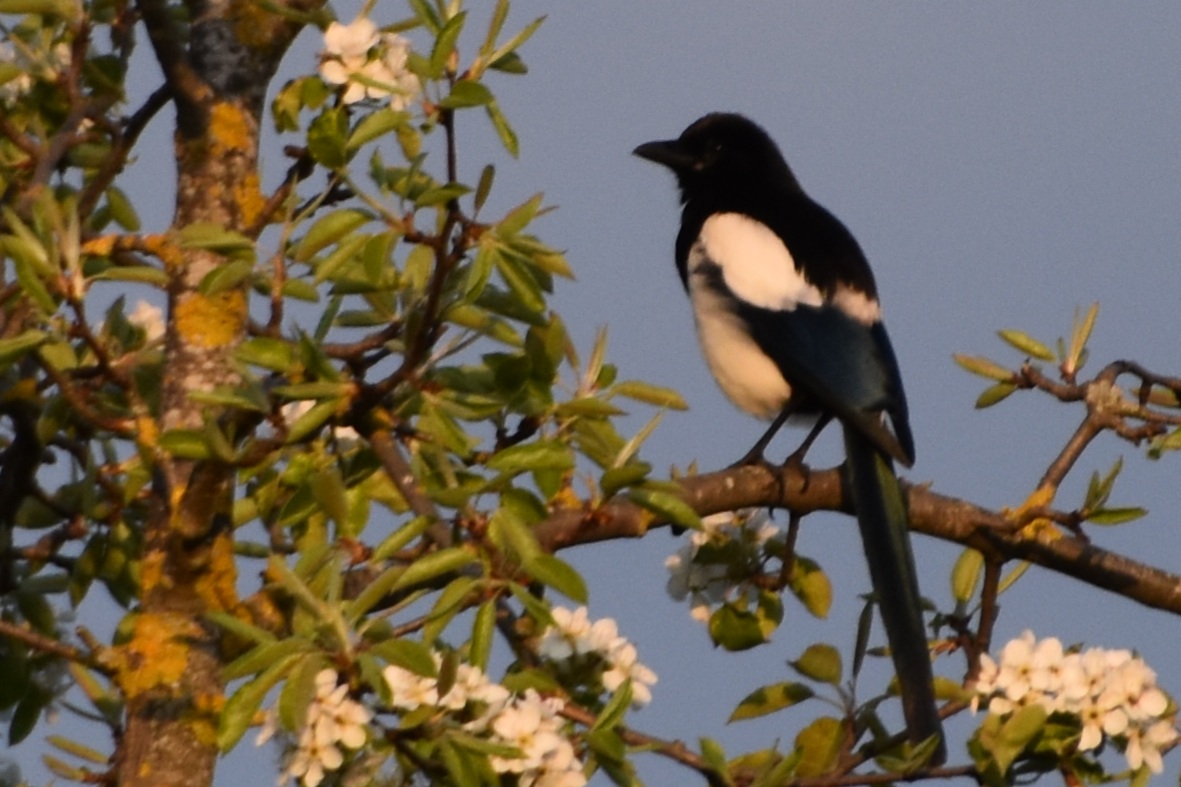
Elster bei friedliweid. 2020-04-13 10.26.40 Friedliweid
First observed in 🇨🇭 on 2020-04-13.
Very common in Fehraltorf. Monogamous. Clever. Female larger than male!
In trees, on roofs or the lawn - frequently underway and too big to hide.
Habitat: ![]() In den 1950er-Jahren sind die Elstern in unsere Städte eingezogen. Zu der Zeit veränderte sich ihr natürlicher Lebensraum. Offene Kulturlandschaften mit Gebüsch und hohen Bäumen verschwanden zunehmend, und in Gebieten mit intensiv genutztem Ackerland fanden die Elstern weder genügend Brutplätze noch ausreichend Nahrung. Dabei haben die Fast-Allesfresser vielfältige Vorlieben. Sie laben sich an Insekten, Reptilien, Amphibien, sie fressen überfahrene Tiere am Strassenrand, und vor allem im Spätsommer ernähren sie sich oft vegetarisch von Früchten und Samen. [Elstern sind besser als ihr Ruf]
In den 1950er-Jahren sind die Elstern in unsere Städte eingezogen. Zu der Zeit veränderte sich ihr natürlicher Lebensraum. Offene Kulturlandschaften mit Gebüsch und hohen Bäumen verschwanden zunehmend, und in Gebieten mit intensiv genutztem Ackerland fanden die Elstern weder genügend Brutplätze noch ausreichend Nahrung. Dabei haben die Fast-Allesfresser vielfältige Vorlieben. Sie laben sich an Insekten, Reptilien, Amphibien, sie fressen überfahrene Tiere am Strassenrand, und vor allem im Spätsommer ernähren sie sich oft vegetarisch von Früchten und Samen. [Elstern sind besser als ihr Ruf]
Song: ![]() Rich repertoire includes soft and surprisingly varied sub-song. [Link]
Rich repertoire includes soft and surprisingly varied sub-song. [Link]
Calls: ![]() Most notable sound a harsh, chattering "chechechecheche" used as warning call, or when mobbing predators. [Link]
Most notable sound a harsh, chattering "chechechecheche" used as warning call, or when mobbing predators. [Link]
Physical details: length=44-46 cm,
wingspan=52-60 cm,
weight=182-272 g
Habitats:
Settlement
Song:
Familiar rattle
Song attributes:
Melody: non-musical, slow, Frequency: low (1-3 KHz) Special sounds: rattle
Call:
Automatically generated from Xeno-Canto recording
♫ Source: BirdNet
20200418_073649 birdnet - Eurasian magpie, great tit HAS CLICKS.mp3
2020-04-18 07.36.49 Luppmen (song?)
Eichelhaeher for profile. 2020-04-17 08.48.34 Wald Fehraltorf
First observed in 🇨🇭 on 2020-04-17.
General: ![]() The Eurasian jay (Garrulus glandarius) is a species of bird occurring over a vast region from western Europe and north-west Africa to the Indian subcontinent and further to the eastern seaboard of Asia and down into south-east Asia. Across its vast range, several very distinct racial forms have evolved to look very different from each other, especially when forms at the extremes of its range are compared.
[more]
The Eurasian jay (Garrulus glandarius) is a species of bird occurring over a vast region from western Europe and north-west Africa to the Indian subcontinent and further to the eastern seaboard of Asia and down into south-east Asia. Across its vast range, several very distinct racial forms have evolved to look very different from each other, especially when forms at the extremes of its range are compared.
[more]
Vocalization: ![]() Large repertoire. Many other social sounds. [Link]
Large repertoire. Many other social sounds. [Link]
Song: ![]() Quiet and varied subsong with mimicry, resembling a small passerine heard from both sexes. [Link]
Quiet and varied subsong with mimicry, resembling a small passerine heard from both sexes. [Link]
Calls: ![]() Most heard call a short, drawn and very hoarse, raspy sound, often given in quick successions. Also a Buzzard-like, mewing "peeeaaa" (more drawn and less full tone than Siberian Jay). [Link]
Most heard call a short, drawn and very hoarse, raspy sound, often given in quick successions. Also a Buzzard-like, mewing "peeeaaa" (more drawn and less full tone than Siberian Jay). [Link]
Physical details: length=34-35 cm,
wingspan=52-58 cm,
weight=140-190 g
Habitats:
Forest
Song:
Harsh crow-like call, or quiet questioning, 'grumbling', or plaintive cries.
Song attributes:
Melody: non-musical, fast, Frequency: medium (1-5 KHz) Special sounds: mimicry, cawing
Calls:
1:
Typically harsh jay call. I would say a contact call usually means 'Here I am', answered by 'Good, here I am.' Listening to two jays in the Swiss mountains of Toggenburg, it sounded like 'HEY IDIOT, HERE I AM...WHERE THE HECK ARE YOU?' 'WHAT? YOU HAVEN'T FIGURE IT OUT? OF COURSE I'M OVER HERE. PEABRAIN.' On the other hand, anthropomorphism is always dangerous, usually completely wrong approach.
2:
We saw and heard a jay (Eichelhaeher) at the Pfaeffikersee imitating a common buzzard - very cool.
♫ Source: XENOCANTO
XC97136 - Eurasian Jay - Garrulus glandarius - imitating common buzzard.mp3
(Imitation of another bird's call)
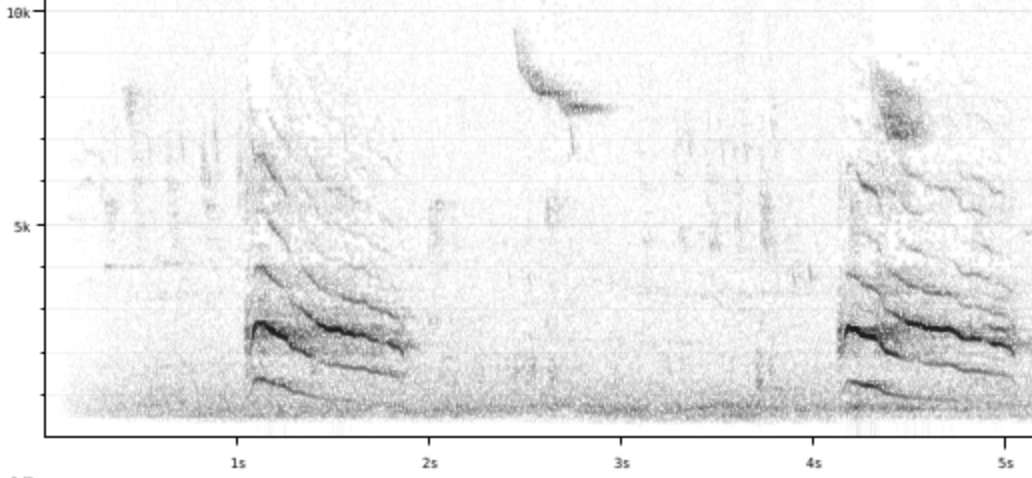
Call attributes:
Call melody: one note, slow, Frequency: medium (1-5 KHz), Special sounds: rasp.

Wikipedia Tannenhaeher Nucifraga caryocatactes. Von Jyrki Salmi from Finland - Nutcracker, CC BY-SA 2.0, Link Source: WIKIPEDIA
Wikipedia Tannenhaeher Nucifraga_caryocatactes.jpg
First observed in 🇨🇭 on 2020-06-10.
What a schnozzola. Spotted like thrush (on belly) or starling (on back), rough jay-like calling but somewhat softer than the Eurasian Jay
Vocalization: ![]() Fairly silent. [Link]
Fairly silent. [Link]
Song: ![]() Song a quiet improvisation of whistling and clappering sounds, interspersed with mimicry of other birds. [Link]
Song a quiet improvisation of whistling and clappering sounds, interspersed with mimicry of other birds. [Link]
Calls: ![]() Warning call a characteristic dry and rasping "karrr karrr karr" in even pitch. [Link]
Warning call a characteristic dry and rasping "karrr karrr karr" in even pitch. [Link]
Physical details: length=32-33 cm,
wingspan=52-58 cm,
weight=140-190 g
Habitats:
Mountain
Song:
Grehh, grehh, grehh!!
Song attributes:
Melody: non-musical, slow, Frequency: 1-10 KHz Special sounds: mimicry, cawing
♫ Source: XENOCANTO
XC641465 - Spotted Nutcracker - Nucifraga caryocatactes - song is a series of calls.mp3
(song)

Call:
Like crow or its cousin the Eurasian jay (Eichelhaeher).
Call attributes:
alarm call Call melody: one note, slow, Frequency: 1-10 KHz, Special sounds: rasp.
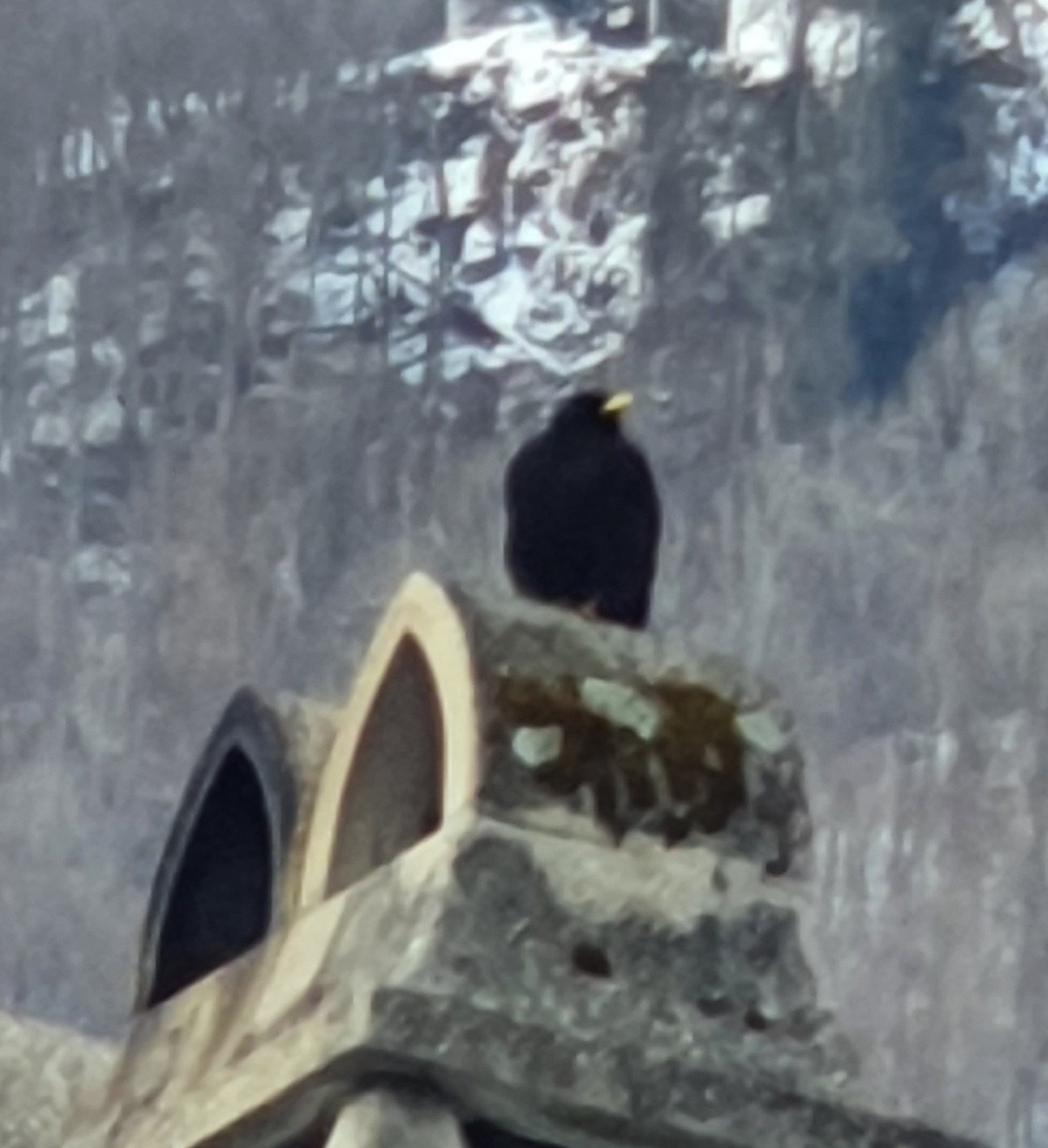
Auf dem Dach unter Vrenelisgärtli 2021-01-01 09.43.48
First observed in 🇨🇭 on 2021-01-01.
Als schwarzer Vogel mit gelbem Schnabel in den Alpen leicht zu erkennen.
Ich habe sie auch in Schwanden (Ortsteil Thon) gesehen, direkt unter Vrenelisgärtli.
Es heisst, bei Schnee fliegen sie tagsüber ins Tal aber abends wieder hoch.
Alpendohlen gibt's von den Kanaren bis in den Himalayen.
In der Schweiz. Man kennt sie in den Schweizer Bergen.
Vocalization: ![]() Diagnostic and very different from Red-billed Chough. A sharp, quite high-pitched, whistling trill "chreeeee". Usually alternated with pure-toned high-pitched whistles, falling abruptly in pitch with a "clipping" ending. [Link]
Diagnostic and very different from Red-billed Chough. A sharp, quite high-pitched, whistling trill "chreeeee". Usually alternated with pure-toned high-pitched whistles, falling abruptly in pitch with a "clipping" ending. [Link]
Physical details: length=38 cm,
wingspan=75-85 cm,
weight=188-252 g
Habitats:
Mountain
Song:
Weird sounding chirping, often in large flocks.
Song attributes:
Melody: non-musical, slow, Frequency: medium (1-5 KHz)
Call:
Automatically generated from Xeno-Canto recording
♫ Source: BirdNet
20210220_112844 birdnet 1200 - Yellow-billed Chough - Adelboden.mp3
2021-02-20 11.28.44 Adelboden (song?)
Profile Wikipedia eBird Vogelwarte BirdLife ZH ornitho.ch Xeno-Canto NABU
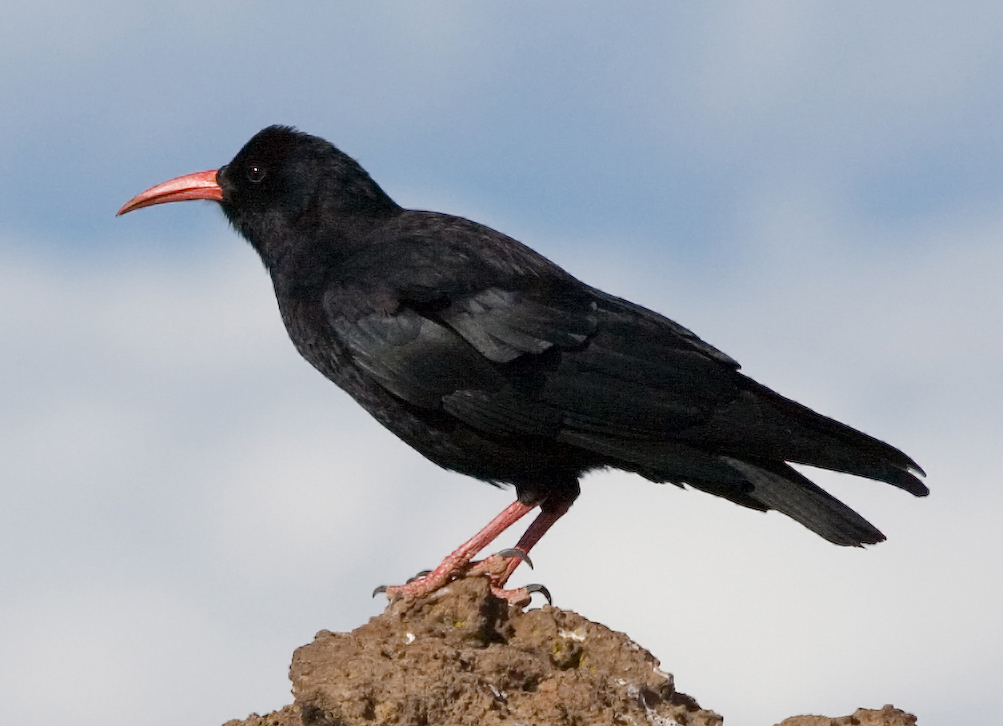
Wikipedia: Red-billed chough Source: OTHER
Pyrrhocorax_pyrrhocorax_-standing-8.jpg
Calls: Ebird: Gives a variety of calls, including a loud “chaw!”, as well as higher-pitched gull-like mewing calls. [Link]
Habitats:
Mountain
Call:
Higher-pitched falling graak.
Call attributes:
Call melody: non-musical, slow, Frequency: low (1-3 KHz), Special sounds: cawing.
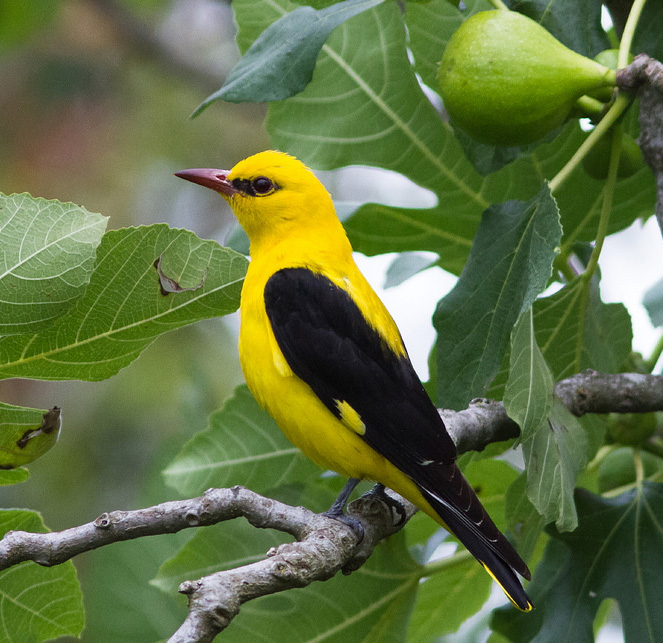
Wikimedia Eurasian golden oriole. Source: WIKIPEDIA
Wikimedia Eurasian golden oriole.jpg
First observed in 🇨🇭 on 2020-05-25.
Pirol: auffälligen Sexualdimorphismus.
Wo/Habitat: lichter Auenwälder, Bruchwälder und gewässernaher Gehölze. Ebenso zählen Laub-, Misch- und Nadelwälder sowie Parks, große Gärten, Friedhöfe, Streuobstwiesen, hohe Obstbäume, Windschutzgürtel und Alleen zu seinen Brutgebieten, wo er sich überwiegend im Kronendach höherer Bäume aufhält.
Der Verbreitungsschwerpunkt liegt hier im kontinentaleren Osteuropa.
knapp amselgross;
Presence april 15 - September 15
https://www.vogelwarte.ch/de/voegel/voegel-der-schweiz/pirol
In Western Europe they prefer open broadleaf forests and plantations, copses, riverine forest, orchards, large gardens.They reside in Switzerland from mid-April to mid-September, breeding in mid-May to mid-July.
They predominate near the German and French borders, from Lake Constance to Geneva.
I want to try to see one at Neeracherried or Thurauen.
Geography: ![]() Wikipedia: only member of the oriole family of passerine birds breeding in Northern Hemisphere temperate regions. It is a summer migrant in Europe and western Asia and spends the winter season in central and southern Africa. [Link]
Wikipedia: only member of the oriole family of passerine birds breeding in Northern Hemisphere temperate regions. It is a summer migrant in Europe and western Asia and spends the winter season in central and southern Africa. [Link]
Song: ![]() Varied repertoire, but song and common contact call very distinct. Song a series of 1-2 seconds long phrases of 3-5 yodeling, clear, fluting notes, interspersed with 2-3 second pauses. Tone very full-bodied, melodic and pleasing. [Link]
Varied repertoire, but song and common contact call very distinct. Song a series of 1-2 seconds long phrases of 3-5 yodeling, clear, fluting notes, interspersed with 2-3 second pauses. Tone very full-bodied, melodic and pleasing. [Link]
Calls: ![]() Flötenrufen
Oft wird der Gesang allerdings vom Star treffend ähnlich nachgeahmt. [Link]
Flötenrufen
Oft wird der Gesang allerdings vom Star treffend ähnlich nachgeahmt. [Link]
![]() Contact call surprisingly different: A forced, drawn "weeackt", slightly resembling Jay, but less harsh, and much more nasal. Other sounds include a Wryneck-like warning call. [Link]
Contact call surprisingly different: A forced, drawn "weeackt", slightly resembling Jay, but less harsh, and much more nasal. Other sounds include a Wryneck-like warning call. [Link]
Physical details: length=24 cm,
wingspan=44-47 cm,
weight=56-79 g
Habitats:
Forest
Song:
A soft, lowish whistling. In my opinion, the golden oriole has a beautiful voice, but no imagination as to melody - it's always the same few notes.
Song attributes:
Melody: stereotype melodic, slow, Frequency: 0-1 KHz Singing season: 04-22 - 09-21
♫ Source: XENOCANTO
XC567973 eurasian golden oriole song.mp3
(song)

Call:
3 somewhat harsh ascending notes, more melodic than a Eurasian jay call
♫ Source: XENOCANTO
XC565722 eurasian golden oriole call.mp3
(call)

Call attributes:
Call melody: simple rhythmic, slow, Frequency: medium (1-5 KHz),
Presence: 04-15 - 09-15
Breeding: 03-15 - 07-15
Migration in: 04-15 - 06-10
Migration out: 07-10 - 09-15
Mittelmeermoewe frisst Muschel. 2021-03-07 12.41.04
First observed in 🇨🇭 on 2021-03-07.
General: ![]() The yellow-legged gull is a large gull found in Europe, the Middle East and North Africa, which has only recently achieved wide recognition as a distinct species. It was formerly treated as a subspecies of either the Caspian gull L. cachinnans, or more broadly as a subspecies of the herring gull L. argentatus.
The genus name is from Latin Larus which appears to have referred to a gull or other large seabird, and the species name honours the German zoologist Karl Michahelles.[2]
[more]
The yellow-legged gull is a large gull found in Europe, the Middle East and North Africa, which has only recently achieved wide recognition as a distinct species. It was formerly treated as a subspecies of either the Caspian gull L. cachinnans, or more broadly as a subspecies of the herring gull L. argentatus.
The genus name is from Latin Larus which appears to have referred to a gull or other large seabird, and the species name honours the German zoologist Karl Michahelles.[2]
[more]
not sexually dimporphic.
No breeding plumage
Identifying characteristics:
general:
head = gray (sprinkled), beak = yellow (yellow orange with a red tip esp. on the lower half), legs = yellow (yellow orange), wings = gray, tail = black (with white stripes)
Habitats:
River and lake
Near Badi Auslikon at the Pfäffikersee. I thought I had only seen black-headed gulls, but on reviewing my photos,
I noticed the yellow bill. Other typical characteristics: it's bigger than the
black-headed gull next to it, it doesn't have the Charlie Brown half-ring around the eye,
it has less gray and only a few shorter black tail feathers. 2021-02-05 11.34.30 Pfäffikersee
First observed in 🇨🇭 on 2021-03-07.
This bird appears across the great seas in the following continents:
Europe, North America, Africa.
Not so common in Switzerland (most common would be the black-headed gull as far as I can see
Appearance and identification: Nabu: NABU ueber das Aussehen der Sturmmoewe:
'Sturmmöwen sind etwas größer als Lachmöwen, jedoch deutlich kleiner als Silbermöwen. Sie sind überwiegend weiß mit grauem Rücken und grauen Flügeln. Die Flügelenden sind schwarz mit weißer Spitze. Der Kopf ist rundlich, die dunklen Augen dünn rot umrandet. Der schlanke Schnabel und die Beine sind grünlichgelb, ein Schnabelfleck fehlt.' [Portraet]
Vocalization: ![]() Various mewing sounds. Similar in form to Herring Gull, but much higher pitched. [Link]
Various mewing sounds. Similar in form to Herring Gull, but much higher pitched. [Link]
Physical details: length=40-42 cm,
wingspan=100-115 cm,
weight=300-480 g
not sexually dimporphic.
Identifying characteristics:
general:
head = white (Gray in winter and when young), beak = yellow (greenish yellow), legs = yellow (duller in winter), , , ,
Adult:
wings = gray, , ,
Youth:
wings = white (with brown streaks), ,
Winter:
tail = black (and white striped),
Prachtkleid:
tail = white
Habitats:
River and lake
Profile Wikipedia eBird Vogelwarte BirdLife ZH ornitho.ch Audubon AllAboutBirds Xeno-Canto NABU
Lesser black-backed gull - yellow legs, yellow break with red under tip, black back but white shoulders. 2023-09-27 12.40.12 Florida
This bird appears across the great seas in the following continents:
Europe, North America, Africa.
General: ![]() The lesser black-backed gull (Larus fuscus) is a large gull that breeds on the Atlantic coasts of Europe. It is migratory, wintering from the British Isles south to West Africa. It is a regular winter visitor to the east coast of North America, probably from the breeding population in Iceland.
[more]
The lesser black-backed gull (Larus fuscus) is a large gull that breeds on the Atlantic coasts of Europe. It is migratory, wintering from the British Isles south to West Africa. It is a regular winter visitor to the east coast of North America, probably from the breeding population in Iceland.
[more]
Habitats:
River and lake

Wikipedia: Caspian gull Source: OTHER
Larus_cachinnans_3_%28Marek_Szczepanek%29.jpg
Deutschland: Brut-, Zugvogel, Wintergast RL R
Habitats:
River and lake
Herring gulls at Squam Lake, New Hampshire. 2023-10-06 12.47.32 New England
This bird appears across the great seas in the following continents:
Europe, North America, South America.
Deutschland: Brut-, Jahres-, Zugvogel, Wintergast
Vocalization: ![]() Quite vocal. A long and strong "ay-kay-kay-kay-kay" with fading strength commonly heard. A deep "ga-ga-ga" heard from anxious birds. [Link]
Quite vocal. A long and strong "ay-kay-kay-kay-kay" with fading strength commonly heard. A deep "ga-ga-ga" heard from anxious birds. [Link]
Calls: ![]() All calls much deeper pitched than Common Gull. Difficult to distinguish from Lesser Black-backed Gull, but tone is less nasal. [Link]
All calls much deeper pitched than Common Gull. Difficult to distinguish from Lesser Black-backed Gull, but tone is less nasal. [Link]
Physical details: length=55-64 cm,
wingspan=123-148 cm,
weight=750-1440 g
Habitats:
River and lake
Profile Wikipedia eBird Vogelwarte BirdLife ZH ornitho.ch Audubon AllAboutBirds Xeno-Canto NABU
Great black-backed gull (Mantelmöwe), Islay near Bridgend. 2023-08-11 09.31.48 Islay
First observed in Islay on 2023-08-11.
This bird appears across the great seas in the following continents:
Europe, North America.
Deutschland: Brut-, Jahres-, Zugvogel, Wintergast RL R
Habitats:
River and lake
On a canal feeding into the Pfäffikersee Paradoxically, they don't have to have a black head. 2020-10-30 16.51.58 Pfäffikersee
First observed in 🇨🇭 on 2020-05-20.
This bird appears across the great seas in the following continents:
Europe, North America, Africa, Asia.
Common waterbird at Pfäffikersee, that doesn't necessarily have the eponymous black head.
not sexually dimporphic.
No breeding plumage
Identifying characteristics:
Summer:
head = black, , , , , tail = black
Winter:
head = white (With Charlie Brown-style half circle behind the eye), , , ,
general:
beak = red, legs = red, wings = gray,
Habitats:
River and lake
Call:
Automatically generated from Xeno-Canto recording
♫ Source: BirdNet
20210427_165123 birdnet 1485 - Black-headed Gull racket at Chlisee - No confident detection - Wetzikon.mp3
2021-04-27 16.51.23 Wetzikon (song?)
Black-legged kittiwake / Dreizehenmöwe (Rissa tridactyla)
Profile Wikipedia eBird Vogelwarte BirdLife ZH ornitho.ch Audubon AllAboutBirds Xeno-Canto BirdID NABU

Wikipedia: Black-legged kittiwake Source: OTHER
1200px-Rissa_tridactyla_%28Vard%C3%B8%2C_2012%29.jpg
This bird appears across the great seas in the following continents:
Europe, North America, Africa.
General: ![]() The black-legged kittiwake (Rissa tridactyla) is a seabird species in the gull family Laridae.
[more]
The black-legged kittiwake (Rissa tridactyla) is a seabird species in the gull family Laridae.
[more]
Vocalization: ![]() Highly vocal at breeding ground. A mewing "kitti-wake", with the pitch rising on the second drawn out syllable, and then falling. Generally silent elsewhere, except when squabbling over food. [Link]
Highly vocal at breeding ground. A mewing "kitti-wake", with the pitch rising on the second drawn out syllable, and then falling. Generally silent elsewhere, except when squabbling over food. [Link]
Physical details: length=38-40 cm,
wingspan=95-105 cm,
weight=310-500 g
Gull-billed tern / Lachseeschwalbe (Gelochelidon nilotica)
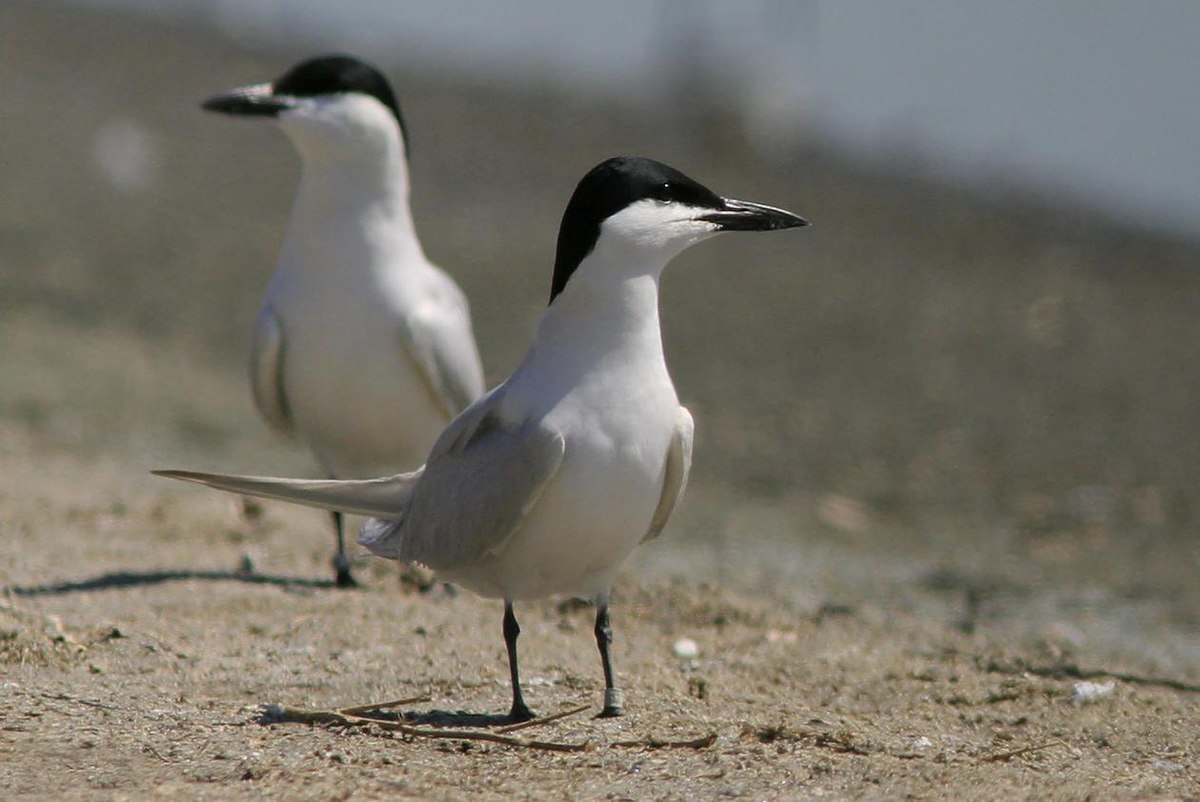
Wikipedia: Gull-billed tern Source: OTHER
1200px-Gelochelidon_nilotica_vanrossemi.jpg
This bird appears across the great seas in the following continents:
Europe, North America, South America, Africa, Asia.
General: ![]() The gull-billed tern (Gelochelidon nilotica), formerly Sterna nilotica,[2] is a tern in the family Laridae. The genus name is from Ancient Greek gelao, "to laugh", and khelidon, "swallow". The specific niloticus is from Latin and means of the Nile.[3] The Australian gull-billed tern was previously considered a subspecies.
[more]
The gull-billed tern (Gelochelidon nilotica), formerly Sterna nilotica,[2] is a tern in the family Laridae. The genus name is from Ancient Greek gelao, "to laugh", and khelidon, "swallow". The specific niloticus is from Latin and means of the Nile.[3] The Australian gull-billed tern was previously considered a subspecies.
[more]
Whiskered tern / Weissbart-Seeschwalbe (Chlidonias hybrida)
Whiskered tern, Phnom Krom. 2024-03-03 08.33.04 Cambodia
First observed in Cambodia on 2024-03-03.
![]() The whiskered tern (Chlidonias hybrida) is a tern in the family Laridae. The genus name is from Ancient Greek khelidonios, "swallow-like", from khelidon, "swallow". The specific hybridus is Latin for hybrid; Pallas thought it might be a hybrid of white-winged black tern and common tern, writing "Sterna fissipes [Chlidonias leucopterus] et Hirundine [Sterna hirundo] natam”.[2]
[more]
The whiskered tern (Chlidonias hybrida) is a tern in the family Laridae. The genus name is from Ancient Greek khelidonios, "swallow-like", from khelidon, "swallow". The specific hybridus is Latin for hybrid; Pallas thought it might be a hybrid of white-winged black tern and common tern, writing "Sterna fissipes [Chlidonias leucopterus] et Hirundine [Sterna hirundo] natam”.[2]
[more]
Calls: ![]() Contact call freely used and fairly distinct: An extremely hoarse, and rasping "krreek" in various moods. Timbre comparable to Corncrake. Sometimes uttered in stuttering series "kr-kr-kr-kr-kr". [Link]
Contact call freely used and fairly distinct: An extremely hoarse, and rasping "krreek" in various moods. Timbre comparable to Corncrake. Sometimes uttered in stuttering series "kr-kr-kr-kr-kr". [Link]
Physical details: length=23-25 cm,
wingspan=74-78 cm,
weight=79-94 g
Habitats:
River and lake
Call:
Automatically generated from Xeno-Canto recording
♫ XC770351 - Whiskered Tern - Chlidonias hybrida - call, flight call - Heves County, Hungary. Source: XENOCANTO
XC770351 - Whiskered Tern - Chlidonias hybrida - call, flight call - Heves County, Hungary.mp3
(flight call)

Call attributes:
flight call Frequency: ,
White-winged tern / Weissflügelseeschwalbe (Chlidonias leucopterus)

Wikipedia: White-winged tern Source: OTHER
Chlidonias_leucopterus_Mai_Po.jpg
General: ![]() The white-winged tern, or white-winged black tern (Chlidonias leucopterus or Chlidonias leucoptera), is a species of tern in the family Laridae. It is a small species generally found in or near bodies of fresh water across much of the world, including Europe, Africa, Asia, and Australia. The genus name is from Ancient Greek khelidonios, "swallow-like", from khelidon, "swallow".
[more]
The white-winged tern, or white-winged black tern (Chlidonias leucopterus or Chlidonias leucoptera), is a species of tern in the family Laridae. It is a small species generally found in or near bodies of fresh water across much of the world, including Europe, Africa, Asia, and Australia. The genus name is from Ancient Greek khelidonios, "swallow-like", from khelidon, "swallow".
[more]
Habitats:
River and lake
Black tern / Trauerseeschwalbe (Chlidonias niger)
Profile Wikipedia eBird Vogelwarte BirdLife ZH ornitho.ch Audubon AllAboutBirds Xeno-Canto BirdID NABU

Wikipedia: Black tern Source: OTHER
1200px-%C4%8Cor%C3%ADk_%C4%8Dierny_%28Chlidonias_niger%29_a_%284644831482%29.jpg
This bird appears across the great seas in the following continents:
Europe, North America, South America, Africa.
![]() The black tern (Chlidonias niger) is a small tern generally found in or near inland water in Europe, Western Asia and North America. As its name suggests, it has predominantly dark plumage. In some lights it can appear blue in the breeding season, hence the old English name "blue darr".[2] The genus name is from Ancient Greek khelidonios, "swallow-like", from khelidon, "swallow": another old English name for the black tern is "carr (i.e. lake) swallow".[3] The species name is from Latin niger "shining black".[4]
[more]
The black tern (Chlidonias niger) is a small tern generally found in or near inland water in Europe, Western Asia and North America. As its name suggests, it has predominantly dark plumage. In some lights it can appear blue in the breeding season, hence the old English name "blue darr".[2] The genus name is from Ancient Greek khelidonios, "swallow-like", from khelidon, "swallow": another old English name for the black tern is "carr (i.e. lake) swallow".[3] The species name is from Latin niger "shining black".[4]
[more]
Vocalization: ![]() Moderately vocal. [Link]
Moderately vocal. [Link]
Calls: ![]() Flight call a more or less clear "kleck, or a disyllabic "klee-ake" with accented first syllable. Sometimes slightly rolling "klirr-eke", but never as much as in White-winged Tern. Also a slightly harsher "kreek", but not as raspy as in Whiskered Tern. [Link]
Flight call a more or less clear "kleck, or a disyllabic "klee-ake" with accented first syllable. Sometimes slightly rolling "klirr-eke", but never as much as in White-winged Tern. Also a slightly harsher "kreek", but not as raspy as in Whiskered Tern. [Link]
Physical details: length=22-24 cm,
wingspan=64-68 cm,
weight=60-86 g
Habitats:
River and lake
Caspian tern / Raubseeschwalbe (Hydroprogne caspia)

Wikipedia: Caspian tern Source: OTHER
1200px-Sterna-caspia-010.jpg
This bird appears across the great seas in the following continents:
Europe, North America, South America, Africa, Asia.
General: ![]() The Caspian tern (Hydroprogne caspia)[2] is a species of tern, with a subcosmopolitan but scattered distribution. Despite its extensive range, it is monotypic of its genus, and has no accepted subspecies.[3] The genus name is from Ancient Greek hudros, "water", and Latin progne, "swallow". The specific caspia is from Latin and, like the English name, refers to the Caspian Sea.[4]
[more]
The Caspian tern (Hydroprogne caspia)[2] is a species of tern, with a subcosmopolitan but scattered distribution. Despite its extensive range, it is monotypic of its genus, and has no accepted subspecies.[3] The genus name is from Ancient Greek hudros, "water", and Latin progne, "swallow". The specific caspia is from Latin and, like the English name, refers to the Caspian Sea.[4]
[more]
Calls: ![]() Easily recognized by its very harsh calls. Sometimes likened to the sound of a plate of steel being dragged across a concrete floor. Similar in harshness to Grey Heron, but more drawn, with an accented middle; "Kraaeeet", or with a double syllable start "ka-ha-kraaaeet". Immature birds begs with a penetrating, sharp whistle. [Link]
Easily recognized by its very harsh calls. Sometimes likened to the sound of a plate of steel being dragged across a concrete floor. Similar in harshness to Grey Heron, but more drawn, with an accented middle; "Kraaeeet", or with a double syllable start "ka-ha-kraaaeet". Immature birds begs with a penetrating, sharp whistle. [Link]
Physical details: length=47-54 cm,
wingspan=130-145 cm,
weight=500-750 g
Habitats:
River and lake
Little tern / Zwergseeschwalbe (Sternula albifrons)
Little Tern, Reykjavik, Iceland. 2015-05-29 11.18.30 Iceland
First observed in Iceland on 2015-05-29.
General: ![]() The little tern (Sternula albifrons) is a seabird of the family Laridae. It was formerly placed into the genus Sterna, which now is restricted to the large white terns.[2] The genus name is a diminutive of Sterna, "tern". The specific albifrons is from Latin albus, "white", and "frons", forehead.[3] The former North American (S. a. antillarum) and Red Sea S. a. saundersi subspecies are now considered to be separate species, the least tern (Sternula antillarum) and Saunders's tern (Sternula saundersi).
[more]
The little tern (Sternula albifrons) is a seabird of the family Laridae. It was formerly placed into the genus Sterna, which now is restricted to the large white terns.[2] The genus name is a diminutive of Sterna, "tern". The specific albifrons is from Latin albus, "white", and "frons", forehead.[3] The former North American (S. a. antillarum) and Red Sea S. a. saundersi subspecies are now considered to be separate species, the least tern (Sternula antillarum) and Saunders's tern (Sternula saundersi).
[more]
Vocalization: ![]() Fairly distinct voice. [Link]
Fairly distinct voice. [Link]
Calls: ![]() Contact call a sharp "kitt", often combined to form undulating, rolling series. Not as sharp and penetrating as Common- and Arctic Tern. [Link]
Contact call a sharp "kitt", often combined to form undulating, rolling series. Not as sharp and penetrating as Common- and Arctic Tern. [Link]
Physical details: length=22-24 cm,
wingspan=48-55 cm,
weight=49-63 g
Habitats:
River and lake
Sandwich tern / Brandseeschwalbe (Thalasseus sandvicensis)
Sandwich tern in flight with distinct yellow tipped bill. 2023-09-27 12.28.34 Florida
First observed in Costa Rica on 2018-03-11.
This bird appears across the great seas in the following continents:
Europe, North America, South America, Africa.
General: ![]() The Sandwich tern (Thalasseus sandvicensis)[2] is a tern in the family Laridae. It is very closely related to the lesser crested tern (T. bengalensis), Chinese crested tern (T. bernsteini), Cabot's tern (T. acuflavidus), and elegant tern (T. elegans) and has been known to interbreed with the lesser crested. It breeds in the Palearctic from Europe to the Caspian Sea wintering to South Africa, India and Sri Lanka.
[more]
The Sandwich tern (Thalasseus sandvicensis)[2] is a tern in the family Laridae. It is very closely related to the lesser crested tern (T. bengalensis), Chinese crested tern (T. bernsteini), Cabot's tern (T. acuflavidus), and elegant tern (T. elegans) and has been known to interbreed with the lesser crested. It breeds in the Palearctic from Europe to the Caspian Sea wintering to South Africa, India and Sri Lanka.
[more]
Calls: ![]() Contact call a sharp and grating "keeree-eek". Often compared to the pressing of amalgam into a tooth. [Link]
Contact call a sharp and grating "keeree-eek". Often compared to the pressing of amalgam into a tooth. [Link]
Physical details: length=36-41 cm,
wingspan=95-105 cm,
weight=215-275 g
Habitats:
River and lake
Little gull / Zwergmöwe (Hydrocoloeus minutus)

Wikipedia: Little gull Source: OTHER
1200px-%C4%8Cajka_mal%C3%A1_%28Larus_minutus%29_a_%284834254958%29.jpg
First observed in 🇨🇭 on 2022-12-03.
This bird appears across the great seas in the following continents:
Europe, North America, Africa.
Deutschland: ausnahmsweise Brutvogel, Zugvogel RL R
Calls: ![]() Repertoire of short, tern-like, hard calls, uttered individually, or in series. E.g. "kep" or "krrk". Also a diagnostic, gull-like, sharp and bouncing "ka-tee,ka-tee,ka-tee", with second syllable rising in pitch. [Link]
Repertoire of short, tern-like, hard calls, uttered individually, or in series. E.g. "kep" or "krrk". Also a diagnostic, gull-like, sharp and bouncing "ka-tee,ka-tee,ka-tee", with second syllable rising in pitch. [Link]
Physical details: length=25-27 cm,
wingspan=75-80 cm,
weight=85-150 g
Habitats:
River and lake
Mediterranean gull / Schwarzkopfmöwe (Ichthyaetus melanocephalus)
Schwarzkopfmoewen, Maennchen in Prachtkleid links, Weibchen rechts. 2022-12-03 10.33.42 Rapperswil
First observed in 🇨🇭 on 2022-12-03.
General: ![]() The Mediterranean gull (Ichthyaetus melanocephalus) is a small gull. The scientific name is from Ancient Greek. The genus Ichthyaetus is from ikhthus, "fish", and aetos, "eagle", and the specific melanocephalus is from melas, "black", and -kephalos "-headed".[2]
[more]
The Mediterranean gull (Ichthyaetus melanocephalus) is a small gull. The scientific name is from Ancient Greek. The genus Ichthyaetus is from ikhthus, "fish", and aetos, "eagle", and the specific melanocephalus is from melas, "black", and -kephalos "-headed".[2]
[more]
Calls: ![]() Distinct calls which can be identified even in mixed flocks. Most common call a short, mewing "yeah". Pitch rises and fall rapidly, with a "surprised" intonation. Timbre is nasal but clear and pure. Alarm call a series of short "ke-ke-ke", with similar timbre. [Link]
Distinct calls which can be identified even in mixed flocks. Most common call a short, mewing "yeah". Pitch rises and fall rapidly, with a "surprised" intonation. Timbre is nasal but clear and pure. Alarm call a series of short "ke-ke-ke", with similar timbre. [Link]
Physical details: length=36-38 cm,
wingspan=92-100 cm,
weight=232-280 g
not sexually dimporphic.
No breeding plumage
Identifying characteristics:
Adult:
head = black, , , , , tail = white,
Youth:
head = white (sprinkled with gray around the eyes), , , , , tail = black (tip of tail black-brown by young birds)
general:
wings = gray (very pale grey mantle and wings with white primary feathers without black tips.), beak = red (Dark red beak [in Levanto I said orange], usually with yellow to orange tip but can also be red. Between the tip and the shaft is a dark band.), legs = red (Their feet are dark red [legs presumably too].), ,
Habitats:
River and lake
Northern lapwing / Kiebitz (Vanellus vanellus)
Profile Wikipedia eBird Vogelwarte BirdLife ZH ornitho.ch bird-song.ch Xeno-Canto BirdID NABU
Kiebitz, Neeracher Ried. 2021-02-24 12.46.02 Neeracherried
First observed in 🇨🇭 on 2021-02-24.
Etymology: ![]() The name lapwing has been variously attributed to the "lapping" sound its wings make in flight, from the irregular progress in flight due to its large wings (the Oxford English Dictionary derives this from an Old English word meaning "to totter"),[4] or from its habit of drawing potential predators away from its nest by trailing a wing as if broken. [Link]
The name lapwing has been variously attributed to the "lapping" sound its wings make in flight, from the irregular progress in flight due to its large wings (the Oxford English Dictionary derives this from an Old English word meaning "to totter"),[4] or from its habit of drawing potential predators away from its nest by trailing a wing as if broken. [Link]
Vocalization: ![]() Quite vocal, especially in flight at breeding ground. [Link]
Quite vocal, especially in flight at breeding ground. [Link]
Calls: ![]() Ruf ist entweder mhhhh oder Bogen-artiges hoch und runter. [Link]
Ruf ist entweder mhhhh oder Bogen-artiges hoch und runter. [Link]
![]() Territorial call: Dry, introductory phrases followed by drawn-out mewing sounds; "wyrrr-peeeoo-weeep". Alarm call "pee-wit". [Link]
Territorial call: Dry, introductory phrases followed by drawn-out mewing sounds; "wyrrr-peeeoo-weeep". Alarm call "pee-wit". [Link]
Physical details: length=28-31 cm,
wingspan=82-87 cm,
weight=140-320 g
Habitats:
Wetland
Little ringed plover / Flussregenpfeifer (Charadrius dubius)
Profile Wikipedia eBird Vogelwarte BirdLife ZH ornitho.ch Xeno-Canto BirdID NABU
Little Ringed Plovers, Phnom Krom. 2024-03-03 09.12.46 Cambodia
First observed in Mallorca on 2022-04-10.
General: ![]() The little ringed plover (Charadrius dubius) is a small plover. The genus name Charadrius is a Late Latin word for a yellowish bird mentioned in the fourth-century Vulgate. It derives from Ancient Greek kharadrios a bird found in river valleys (kharadra, "ravine"). The specific dubius is Latin for doubtful, since Sonnerat, writing in 1776, thought this bird might be just a variant of common ringed plover.[2]
[more]
The little ringed plover (Charadrius dubius) is a small plover. The genus name Charadrius is a Late Latin word for a yellowish bird mentioned in the fourth-century Vulgate. It derives from Ancient Greek kharadrios a bird found in river valleys (kharadra, "ravine"). The specific dubius is Latin for doubtful, since Sonnerat, writing in 1776, thought this bird might be just a variant of common ringed plover.[2]
[more]
Vocalization: ![]() Quite different from Ringed Plover. Sharper sounding, lacking Ringed's soft tone. Often starts with a rolling "r". [Link]
Quite different from Ringed Plover. Sharper sounding, lacking Ringed's soft tone. Often starts with a rolling "r". [Link]
Calls: ![]() Common calls are a two syllable "krrll-uuit" with a rising pitch or just a sharp, rolling "krrri-krrri". Also a longer rolling "krree-looo" with pitch rising in first syllable and falling in the second. [Link]
Common calls are a two syllable "krrll-uuit" with a rising pitch or just a sharp, rolling "krrri-krrri". Also a longer rolling "krree-looo" with pitch rising in first syllable and falling in the second. [Link]
Physical details: length=14-15 cm,
wingspan=42-48 cm,
weight=32-48 g
Habitats:
Wetland
Call:
Automatically generated from Xeno-Canto recording
♫ XC835676 - Little Ringed Plover - Charadrius dubius - flight call, song - Dundgovi, Mongolia. Source: XENOCANTO
XC835676 - Little Ringed Plover - Charadrius dubius - flight call, song - Dundgovi, Mongolia.mp3
(flight call)
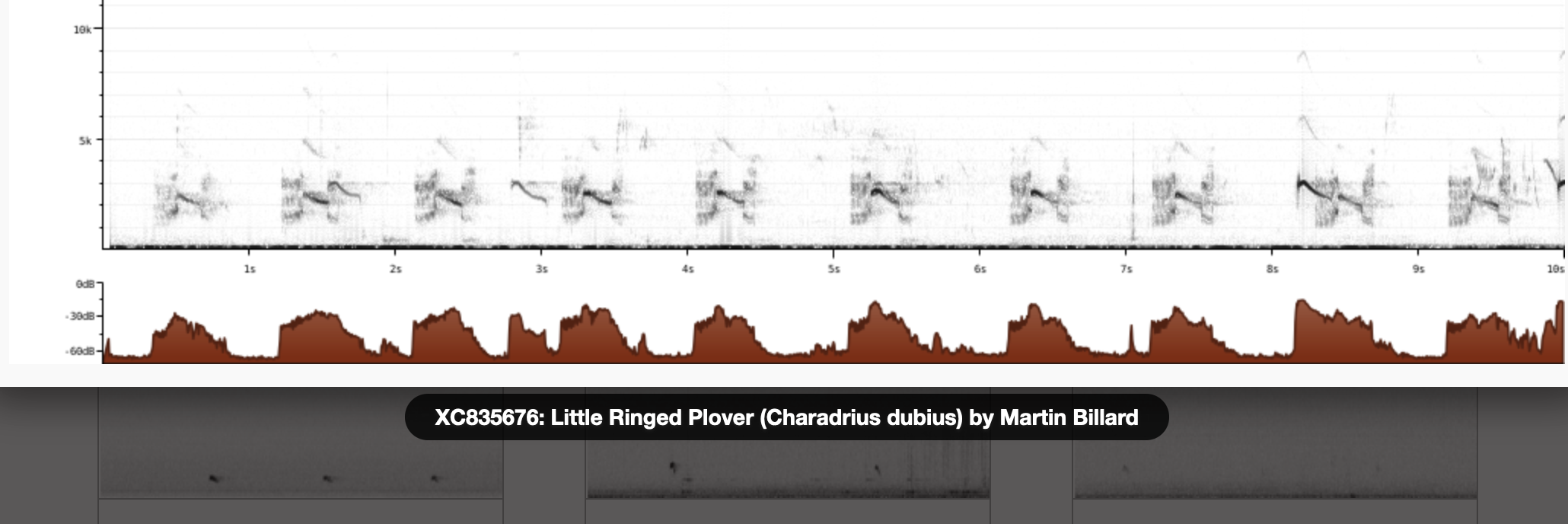
Call attributes:
flight call Frequency: ,
Common ringed plover / Sandregenpfeifer (Charadrius hiaticula)
Profile Wikipedia eBird Vogelwarte BirdLife ZH ornitho.ch Audubon AllAboutBirds Xeno-Canto BirdID NABU
Sandregenpfeifer im Profil, Neeracherried. 2022-09-04 07.25.18 Neeracherried
First observed in 🇨🇭 on 2022-09-04.
This bird appears across the great seas in the following continents:
Europe, North America, Africa.
General: ![]() The common ringed plover or ringed plover (Charadrius hiaticula) is a small plover that breeds in Arctic Eurasia. The genus name Charadrius is a Late Latin word for a yellowish bird mentioned in the fourth-century Vulgate. It derives from Ancient Greek kharadrios a bird found in ravines and river valleys (kharadra, "ravine"). The specific hiaticula is Latin and has a similar meaning to the Greek term, coming from hiatus, "cleft" and -cola, "dweller" (colere, "to dwell").[2]
[more]
The common ringed plover or ringed plover (Charadrius hiaticula) is a small plover that breeds in Arctic Eurasia. The genus name Charadrius is a Late Latin word for a yellowish bird mentioned in the fourth-century Vulgate. It derives from Ancient Greek kharadrios a bird found in ravines and river valleys (kharadra, "ravine"). The specific hiaticula is Latin and has a similar meaning to the Greek term, coming from hiatus, "cleft" and -cola, "dweller" (colere, "to dwell").[2]
[more]
Vocalization: ![]() Usually heard before seen. [Link]
Usually heard before seen. [Link]
Song: ![]() Song a cyclic repetition of the contact call. Sometimes with a shortened phrases and a more creaking timbre. [Link]
Song a cyclic repetition of the contact call. Sometimes with a shortened phrases and a more creaking timbre. [Link]
Calls: ![]() Contact call a short, soft "koo-eep", with the emphasised second part higher and rising in pitch. [Link]
Contact call a short, soft "koo-eep", with the emphasised second part higher and rising in pitch. [Link]
Physical details: length=18-20 cm,
wingspan=48-57 cm,
weight=55-73 g
Habitats:
Wetland
Kentish plover / Seeregenpfeifer (Charadrius alexandrinus)
Profile Wikipedia eBird Vogelwarte BirdLife ZH ornitho.ch Audubon AllAboutBirds Xeno-Canto BirdID NABU
Der kleinste Watvoegel bei Ses Salines, Mallorcal, ein Seeregenpfeifer. 2022-04-08 17.00.16 Mallorca
First observed in Mallorca on 2022-04-08.
This bird appears across the great seas in the following continents:
Europe, North America, Africa, Asia, Australia.
vagrant
Song: ![]() Contact calls more frequently heard than song, with two distinct calls. A short and soft ascending whistle resembling chiff-chaff is often heard from the ground, and a hard and rolling "prrrrt" if flushed (or just a short "tip"). Song a hard and rolling sequence resembling Dunlin song, but less nasal and more pulsating. [Link]
Contact calls more frequently heard than song, with two distinct calls. A short and soft ascending whistle resembling chiff-chaff is often heard from the ground, and a hard and rolling "prrrrt" if flushed (or just a short "tip"). Song a hard and rolling sequence resembling Dunlin song, but less nasal and more pulsating. [Link]
Physical details: length=15-17 cm,
wingspan=42-45 cm,
weight=39-56 g
Habitats:
Wetland
Eurasian dotterel / Mornellregenpfeifer (Charadrius morinellus)

Wikipedia: Eurasian dotterel Source: OTHER
Charadrius_morinellus_male.jpg
Deutschland: ausnahmsweise Brutvogel, Zugvogel RL 0
Calls: ![]() Calls soft and mellow, but far carrying "pit" or "pju". Also "krrrrritpitpit - pit - pit pit pit", starting as a trill and then ending in a long ritardando of "pit"'s. [Link]
Calls soft and mellow, but far carrying "pit" or "pju". Also "krrrrritpitpit - pit - pit pit pit", starting as a trill and then ending in a long ritardando of "pit"'s. [Link]
Physical details: length=20-22 cm,
wingspan=57-64 cm,
weight=90-130 g
Habitats:
Wetland
Black-bellied plover / Kiebitzregenpfeifer (Pluvialis squatarola)
Black-bellied plover eggs. 2016-09-25 16.51.00 Botswana
First observed in Botswana on 2016-09-25.
This bird appears across the great seas in the following continents:
Europe, North America, South America, Africa, Asia.
General: ![]() The grey plover or black-bellied plover (Pluvialis squatarola) is a medium-sized plover breeding in Arctic regions. It is a long-distance migrant, with a nearly worldwide coastal distribution when not breeding.[2] The genus name is Latin and means relating to rain, from pluvia, "rain". It was believed that golden plovers flocked when rain was imminent. The species name squatarola is a Latinised version of Sgatarola, a Venetian name for some kind of plover.[3]
[more]
The grey plover or black-bellied plover (Pluvialis squatarola) is a medium-sized plover breeding in Arctic regions. It is a long-distance migrant, with a nearly worldwide coastal distribution when not breeding.[2] The genus name is Latin and means relating to rain, from pluvia, "rain". It was believed that golden plovers flocked when rain was imminent. The species name squatarola is a Latinised version of Sgatarola, a Venetian name for some kind of plover.[3]
[more]
Calls: ![]() Contact call diagnostic. A plaintive, drawn and trisyllabic (but continuous) "kleeooowee". Pitch falls on second syllable and rises on last. [Link]
Contact call diagnostic. A plaintive, drawn and trisyllabic (but continuous) "kleeooowee". Pitch falls on second syllable and rises on last. [Link]
Physical details: length=27-30 cm,
wingspan=71-83 cm,
weight=190-280 g
Habitats:
Wetland
European golden-plover / Goldregenpfeifer (Pluvialis apricaria)

Wikipedia: European golden-plover Source: OTHER
1200px-Kul%C3%ADk_zlat%C3%BD_%28Pluvialis_apricaria%29_a_%283949776435%29.jpg
General: ![]() The European golden plover (Pluvialis apricaria), also known as the European golden-plover, Eurasian golden plover, or just the golden plover within Europe, is a largish plover. This species is similar to two other golden plovers: the American golden plover, Pluvialis dominica, and Pacific golden plover, Pluvialis fulva, which are both smaller, slimmer and relatively longer-legged than European golden plover, and both have grey rather than white axillary feathers (only properly visible in flight).
[more]
The European golden plover (Pluvialis apricaria), also known as the European golden-plover, Eurasian golden plover, or just the golden plover within Europe, is a largish plover. This species is similar to two other golden plovers: the American golden plover, Pluvialis dominica, and Pacific golden plover, Pluvialis fulva, which are both smaller, slimmer and relatively longer-legged than European golden plover, and both have grey rather than white axillary feathers (only properly visible in flight).
[more]
Song: ![]() In song flight also a trilling, warbling and cyclic "preecaria-preecaria-preecaria". [Link]
In song flight also a trilling, warbling and cyclic "preecaria-preecaria-preecaria". [Link]
Calls: ![]() Most common call at breeding ground a disyllabic, melancholic and wailing whistle with the end falling in pitch. Contact call a straight, short "kluee". [Link]
Most common call at breeding ground a disyllabic, melancholic and wailing whistle with the end falling in pitch. Contact call a straight, short "kluee". [Link]
Physical details: length=26-29 cm,
wingspan=67-76 cm,
weight=160-280 g
Habitats:
Wetland
Curlew sandpiper / Sichelstrandläufer (Calidris ferruginea)
Profile Wikipedia eBird Vogelwarte BirdLife ZH ornitho.ch Audubon AllAboutBirds Xeno-Canto BirdID NABU

Wikipedia: Curlew sandpiper Source: OTHER
1200px-Calidris_ferruginea%2C_winter_adult%2C_Pak_Thale.jpg
This bird appears across the great seas in the following continents:
Europe, North America, South America, Africa, Asia.
Etymology: ![]() Nicolas Baiker sagt, Hauptmerkmale innerhalb der Strandlaeufer sind der Augenstreif und der Schnabel der relativ lang ist und immer lezten Drittel immer krummer, darum Sichelstrandlaeufer. [Link]
Nicolas Baiker sagt, Hauptmerkmale innerhalb der Strandlaeufer sind der Augenstreif und der Schnabel der relativ lang ist und immer lezten Drittel immer krummer, darum Sichelstrandlaeufer. [Link]
Calls: ![]() Flight call a soft, ringing and rolling "krrrrrt, with variations. Lacks the hoarse, nasal quality of similar call by Dunlin. [Link]
Flight call a soft, ringing and rolling "krrrrrt, with variations. Lacks the hoarse, nasal quality of similar call by Dunlin. [Link]
Physical details: length=18-19 cm,
wingspan=42-46 cm,
weight=50-65 g
Habitats:
Wetland
Ruff / Kampfläufer (Calidris pugnax)

Wikipedia: Ruff Source: OTHER
1200px-Philomachus_pugnax_-Diergaarde_Blijdorp-8c.jpg
This bird appears across the great seas in the following continents:
Europe, North America, South America, Africa, Asia.
Etymology: Nabu: Der Name leitet sich vom Balzverhalten der Männchen ab: In Balzarenen tragen sie „Turniere“ aus, um die Weibchen zu beeindrucken, dabei herrscht eine komplizierte Rollenverteilung. [Link]
Vocalization: ![]() Generally silent. Short, muted, nasal, mono or disyllabic grunts sometimes heard. [Link]
Generally silent. Short, muted, nasal, mono or disyllabic grunts sometimes heard. [Link]
Physical details: length=26-30 cm,
wingspan=54-58 cm,
weight=75-230 g
Habitats:
Wetland
Temminck's stint / Temminckstrandläufer (Calidris temminckii)
Profile Wikipedia eBird Vogelwarte BirdLife ZH ornitho.ch Xeno-Canto NABU

Wikipedia: Temminck's stint Source: OTHER
1200px-Temmincks_Stint.jpg
General: ![]() Temminck's stint (Calidris temminckii) is a small wader. This bird's common name and Latin binomial commemorate the Dutch naturalist Coenraad Jacob Temminck.[3] The genus name is from Ancient Greek kalidris or skalidris, a term used by Aristotle for some grey-coloured waterside birds.[4]
[more]
Temminck's stint (Calidris temminckii) is a small wader. This bird's common name and Latin binomial commemorate the Dutch naturalist Coenraad Jacob Temminck.[3] The genus name is from Ancient Greek kalidris or skalidris, a term used by Aristotle for some grey-coloured waterside birds.[4]
[more]
Habitats:
Wetland
Red knot / Knutt (Calidris canutus)
Profile Wikipedia eBird Vogelwarte BirdLife ZH ornitho.ch Audubon AllAboutBirds Xeno-Canto BirdID NABU
Red knots, according to MerlinBirdID - underway to somewhere better at Las Coloradas. 2023-04-15 09.34.08 Yucatan
First observed in Yucatan on 2023-04-15.
This bird appears across the great seas in the following continents:
Europe, North America, South America, Africa, Asia.
![]() The red knot (Calidris canutus) (just knot in English-speaking Europe) is a medium-sized shorebird which breeds in tundra and the Arctic Cordillera in the far north of Canada, Europe, and Russia. It is a large member of the Calidris sandpipers, second only to the great knot.[2] Six subspecies are recognised.
[more]
The red knot (Calidris canutus) (just knot in English-speaking Europe) is a medium-sized shorebird which breeds in tundra and the Arctic Cordillera in the far north of Canada, Europe, and Russia. It is a large member of the Calidris sandpipers, second only to the great knot.[2] Six subspecies are recognised.
[more]
Song: ![]() Song an undulating, nasal mewing "poooor-mee", or "po-hor-mee". [Link]
Song an undulating, nasal mewing "poooor-mee", or "po-hor-mee". [Link]
Calls: ![]() Most commonly heard migratory call, a short "kut" or "knot". Sometimes given in stuttering series. [Link]
Most commonly heard migratory call, a short "kut" or "knot". Sometimes given in stuttering series. [Link]
Physical details: length=23-25 cm,
wingspan=57-61 cm,
weight=110-160 g
Habitats:
Wetland
Sanderling / Sanderling (Calidris alba)
Profile Wikipedia eBird Vogelwarte BirdLife ZH ornitho.ch Audubon AllAboutBirds Xeno-Canto BirdID NABU
Sanderling. 2023-09-27 12.12.20 Florida
First observed in Yucatan on 2023-03-27.
This bird appears across the great seas in the following continents:
Europe, North America, South America, Africa, Asia.
General: ![]() The sanderling (Calidris alba) is a small wading bird. The name derives from Old English sand-yrðling, "sand-ploughman".[2] The genus name is from Ancient Greek kalidris or skalidris, a term used by Aristotle for some grey-coloured waterside birds. The specific alba is Latin for "white".[3]
[more]
The sanderling (Calidris alba) is a small wading bird. The name derives from Old English sand-yrðling, "sand-ploughman".[2] The genus name is from Ancient Greek kalidris or skalidris, a term used by Aristotle for some grey-coloured waterside birds. The specific alba is Latin for "white".[3]
[more]
Calls: ![]() Call not very diagnostic; a short and soft "pleet" or "keek". [Link]
Call not very diagnostic; a short and soft "pleet" or "keek". [Link]
Physical details: length=20-21 cm,
wingspan=40-45 cm,
weight=44-70 g
Habitats:
Wetland
Dunlin / Alpenstrandläufer (Calidris alpina)
Profile Wikipedia eBird Vogelwarte BirdLife ZH ornitho.ch Audubon AllAboutBirds Xeno-Canto BirdID NABU
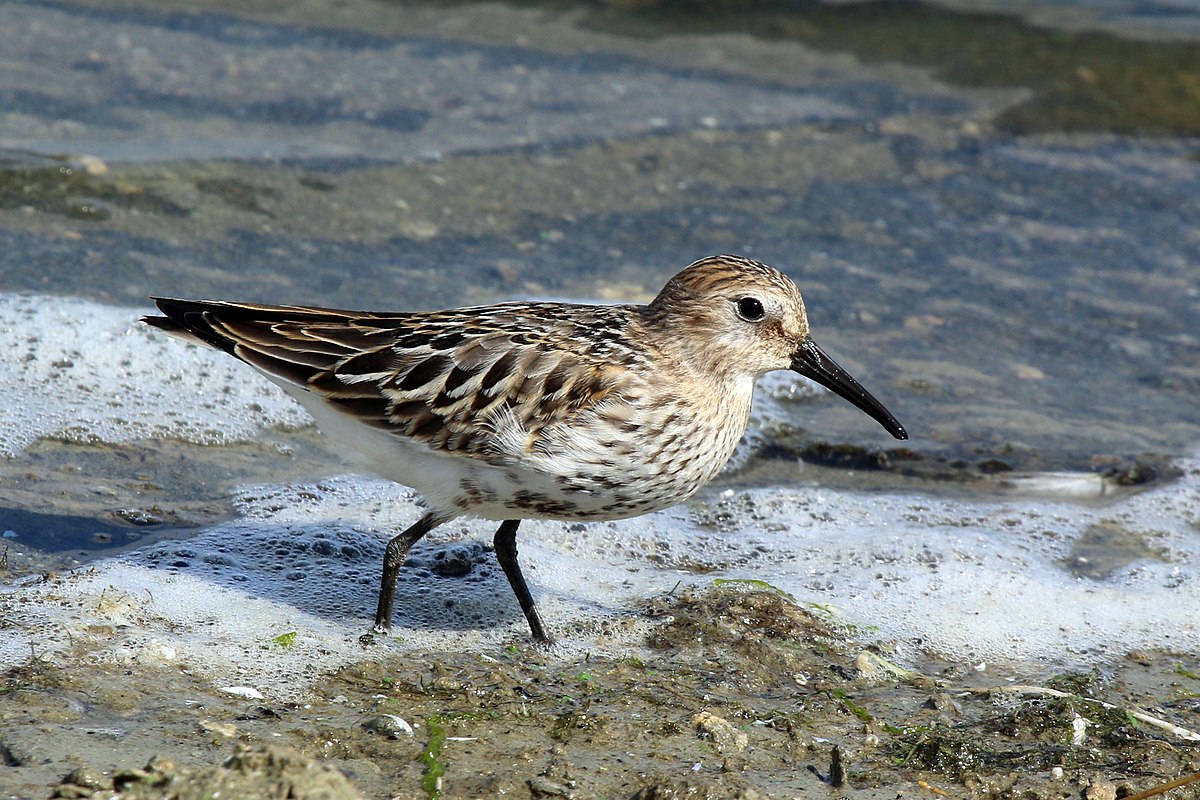
Wikipedia: Dunlin Source: OTHER
1200px-Dunlin_%28Calidris_alpina%29_juvenile.jpg
This bird appears across the great seas in the following continents:
Europe, North America, South America, Africa.
General: ![]() The dunlin (Calidris alpina) is a small wader, sometimes separated with the other "stints" in Erolia. The English name is a dialect form of "dunling", first recorded in 1531–2. It derives from dun, "dull brown", with the suffix -ling, meaning a person or thing with the given quality.[2] The genus name is from Ancient Greek kalidris or skalidris, a term used by Aristotle for some grey-coloured waterside birds. The specific alpina is from Latin and means "of high mountains", in this case referring to the Alps.[3]
[more]
The dunlin (Calidris alpina) is a small wader, sometimes separated with the other "stints" in Erolia. The English name is a dialect form of "dunling", first recorded in 1531–2. It derives from dun, "dull brown", with the suffix -ling, meaning a person or thing with the given quality.[2] The genus name is from Ancient Greek kalidris or skalidris, a term used by Aristotle for some grey-coloured waterside birds. The specific alpina is from Latin and means "of high mountains", in this case referring to the Alps.[3]
[more]
Song: ![]() Song: A drawn out, nasal "tweeet", and ringing variations on the contact call in decrescendo. Low chattering heard from feeding birds. [Link]
Song: A drawn out, nasal "tweeet", and ringing variations on the contact call in decrescendo. Low chattering heard from feeding birds. [Link]
Calls: ![]() Contact call a diagnostic, very nasal "trrreeet" . Given throughout the year and in many situations, including when being flushed. [Link]
Contact call a diagnostic, very nasal "trrreeet" . Given throughout the year and in many situations, including when being flushed. [Link]
Physical details: length=16-20 cm,
wingspan=38-43 cm,
weight=35-60 g
Habitats:
Wetland
Little stint / Zwergstrandläufer (Calidris minuta)
Profile Wikipedia eBird Vogelwarte BirdLife ZH ornitho.ch Xeno-Canto BirdID NABU

Wikipedia: Little stint Source: OTHER
Little_Stint_%28Calidris_minuta%29_2.jpg
General: ![]() The little stint (Calidris minuta) (or Erolia minuta), is a very small wader. It breeds in arctic Europe and Asia, and is a long-distance migrant, wintering south to Africa and south Asia. It occasionally is a vagrant to North America and to Australia. The genus name is from Ancient Greek kalidris or skalidris, a term used by Aristotle for some grey-coloured waterside birds. The specific minuta is Latin for "small.[2]
[more]
The little stint (Calidris minuta) (or Erolia minuta), is a very small wader. It breeds in arctic Europe and Asia, and is a long-distance migrant, wintering south to Africa and south Asia. It occasionally is a vagrant to North America and to Australia. The genus name is from Ancient Greek kalidris or skalidris, a term used by Aristotle for some grey-coloured waterside birds. The specific minuta is Latin for "small.[2]
[more]
Song: ![]() Song a cyclic series of thin "peee-peee-peee" rising and falling in pitch. [Link]
Song a cyclic series of thin "peee-peee-peee" rising and falling in pitch. [Link]
Calls: ![]() Contact call a quite soft, short, high pitched "pit". Sometimes uttered in series, or as soft chattering. [Link]
Contact call a quite soft, short, high pitched "pit". Sometimes uttered in series, or as soft chattering. [Link]
Physical details: length=12-14 cm,
wingspan=34-37 cm,
weight=18-30 g
Habitats:
Wetland
Eurasian curlew / Grosser Brachvogel (Numenius arquata)
Profile Wikipedia eBird Vogelwarte BirdLife ZH ornitho.ch bird-song.ch Xeno-Canto BirdID NABU
Grosser Brachvogel. 2021-02-12 11.59.24
First observed in 🇨🇭 on 2021-02-12.
In Jona findet man viele auf der Wiese unter Obstbaeumen,
anscheinend weil es dort viele Insekten und Schnecken gibt (siehe oben).
Geography: ![]() Die Brachvögel bruetet im Moment recht viel in Vergleich mit früher. [Link]
Die Brachvögel bruetet im Moment recht viel in Vergleich mit früher. [Link]
Diet: Nabu: Auf dem Speiseplan des Großen Brachvogels stehen vor allem Insekten und deren Larven und andere Kleintiere wie Schnecken und Regenwürmer, aber auch Krebstierchen. Ab und zu frisst er auch Amphibien, Reptilien oder Fische. [Link]
Song: ![]() Song starts similar to Whimbrel, with long wailing notes "kluuueee", but takes on a different ending as it accelerates to an ascending phrase repeated in rapid cycles . [Link]
Song starts similar to Whimbrel, with long wailing notes "kluuueee", but takes on a different ending as it accelerates to an ascending phrase repeated in rapid cycles . [Link]
Physical details: length=50-60 cm,
wingspan=80-100 cm,
weight=540-1300 g
Habitats:
Wetland
Call:
![]() Das Männchen steigt mit einzelnen, klangvollen Rufen auf, die vor der Landung in einen weithin hörbaren Triller übergehen. [Link]
Das Männchen steigt mit einzelnen, klangvollen Rufen auf, die vor der Landung in einen weithin hörbaren Triller übergehen. [Link]
♫ Source: XENOCANTO
XC625195-grosser brachvogel, michal jezierski, uk.mp3
(flight call)

Call attributes:
flight call Call melody: simple rhythmic, slow, Frequency: low (1-3 KHz),
Whimbrel / Regenbrachvogel (Numenius phaeopus)
Regenbrachvogel oder Grosser Brachvogel - dunkle Schwanzfedern ein moegliches Zeichen. 2022-06-23 16.53.34 La Sauge
First observed in Canary Islands on 2022-03-19.
This bird appears across the great seas in the following continents:
Europe, North America, South America, Africa, Asia.
General: ![]() Der Regenbrachvogel (Numenius phaeopus) ist mit einer Spannweite um die 80 cm viel kleiner als der Große Brachvogel, auch der Schnabel ist kürzer und der Oberkopf ist hell und dunkel gestreift. Der Ruf dieser Vogelart ähnelt einem hellen Trillern.
[more]
Der Regenbrachvogel (Numenius phaeopus) ist mit einer Spannweite um die 80 cm viel kleiner als der Große Brachvogel, auch der Schnabel ist kürzer und der Oberkopf ist hell und dunkel gestreift. Der Ruf dieser Vogelart ähnelt einem hellen Trillern.
[more]
Song: ![]() Song starts similar to Curlew with long wailing notes "kluuueee", which then accelerates to a continuous, vibrating single note. Lacks the cyclic phrase ending of Curlew. [Link]
Song starts similar to Curlew with long wailing notes "kluuueee", which then accelerates to a continuous, vibrating single note. Lacks the cyclic phrase ending of Curlew. [Link]
Physical details: length=40-42 cm,
wingspan=76-89 cm,
weight=300-660 g
Habitats:
Wetland
Ruddy turnstone / Steinwälzer (Arenaria interpres)
Ruddy turnstone near Las Coloradas. 2023-04-15 10.06.32 Yucatan
First observed in Canary Islands on 2022-03-19.
This bird appears across the great seas in the following continents:
Europe, North America, South America, Africa, Asia.
General: ![]() The ruddy turnstone (Arenaria interpres) is a small wading bird, one of two species of turnstone in the genus Arenaria. The scientific name is from Latin. The genus name arenaria derives from arenarius, "inhabiting sand, from arena, "sand". The specific interpres means "messenger"; when visiting Gotland in 1741, Linnaeus thought that the Swedish word Tolk "interpreter" applied to this species, but in the local dialect the word means "legs" and is used for the redshank.[2]
[more]
The ruddy turnstone (Arenaria interpres) is a small wading bird, one of two species of turnstone in the genus Arenaria. The scientific name is from Latin. The genus name arenaria derives from arenarius, "inhabiting sand, from arena, "sand". The specific interpres means "messenger"; when visiting Gotland in 1741, Linnaeus thought that the Swedish word Tolk "interpreter" applied to this species, but in the local dialect the word means "legs" and is used for the redshank.[2]
[more]
Song: ![]() Alarm call/song more "wader-like", a staccato "kuvi-kuvi-vit-vit-vitua". [Link]
Alarm call/song more "wader-like", a staccato "kuvi-kuvi-vit-vit-vitua". [Link]
Calls: ![]() Characteristic call: An explosive, hard, resonant and short "koi" or "kott" with a peculiar timbre, usually given in rapid or accelerating series. [Link]
Characteristic call: An explosive, hard, resonant and short "koi" or "kott" with a peculiar timbre, usually given in rapid or accelerating series. [Link]
Physical details: length=22-24 cm,
wingspan=50-57 cm,
weight=85-150 g
Habitats:
Wetland
Eurasian woodcock / Waldschnepfe (Scolopax rusticola)
Profile Wikipedia eBird Vogelwarte BirdLife ZH ornitho.ch bird-song.ch Xeno-Canto BirdID NABU

Wikipedia: Eurasian woodcock Source: OTHER
Scolopax_rusticola.jpg
Deutschland: Brut-, Jahres-, Zugvogel, Wintergast RL V
Vocalization: ![]() Sometimes give a snipe-like hoarse "raaat" when flushed. Male display flight at night distinctive. [Link]
Sometimes give a snipe-like hoarse "raaat" when flushed. Male display flight at night distinctive. [Link]
Calls: ![]() Flies above treetops while calling with 3-5 deep croaking grunts, followed by an explosive high-pitched sneeze, "psst". [Link]
Flies above treetops while calling with 3-5 deep croaking grunts, followed by an explosive high-pitched sneeze, "psst". [Link]
Physical details: length=33-35 cm,
wingspan=56-60 cm,
weight=131-420 g
Habitats:
Forest
Great snipe / Doppelschnepfe (Gallinago media)
Profile Wikipedia eBird Vogelwarte BirdLife ZH ornitho.ch Xeno-Canto BirdID NABU

Wikipedia: Great snipe Source: OTHER
Greatsnipe_1000.jpg
General: ![]() The great snipe (Gallinago media) is a small stocky wader in the genus Gallinago. This bird's breeding habitat is marshes and wet meadows with short vegetation in north-eastern Europe, including north-western Russia. Great snipes are migratory, wintering in Africa. The European breeding population is in steep decline.
[more]
The great snipe (Gallinago media) is a small stocky wader in the genus Gallinago. This bird's breeding habitat is marshes and wet meadows with short vegetation in north-eastern Europe, including north-western Russia. Great snipes are migratory, wintering in Africa. The European breeding population is in steep decline.
[more]
Vocalization: ![]() Sometimes utters a faint grunt when flushed, but is generally silent when not lekking. [Link]
Sometimes utters a faint grunt when flushed, but is generally silent when not lekking. [Link]
Calls: ![]() Display call unique: A bubbling, clappering and whistling sequence that accelerates into a crescendo followed by a decrescendo. [Link]
Display call unique: A bubbling, clappering and whistling sequence that accelerates into a crescendo followed by a decrescendo. [Link]
Physical details: length=27-29 cm,
wingspan=47-50 cm,
weight=150-225 g
Common snipe / Bekassine (Gallinago gallinago)
Rechts nach Links - drei Bekassinen, Kiebitz, Krickenten. 2021-10-24 10.34.58 Neeracherried
First observed in 🇨🇭 on 2021-10-24.
This bird appears across the great seas in the following continents:
Europe, North America, Africa, Asia.
Deutschland: Brut-, Zugvogel, Wintergast RL 1
Vocalization: ![]() Quite vocal, especially at breeding ground. [Link]
Quite vocal, especially at breeding ground. [Link]
Song: ![]() Song an unmistakable bleating, drumming sound produced by vibrating tail feathers in sky-dives. [Link]
Song an unmistakable bleating, drumming sound produced by vibrating tail feathers in sky-dives. [Link]
Calls: ![]() Almost always give diagnostic hoarse and nasal "kaaat" call when flushed. Another territorial call is a rhythmic, mechanical and sharp "tika-tika-tka", or "ika-ka-ka". [Link]
Almost always give diagnostic hoarse and nasal "kaaat" call when flushed. Another territorial call is a rhythmic, mechanical and sharp "tika-tika-tka", or "ika-ka-ka". [Link]
Physical details: length=25-27 cm,
wingspan=44-47 cm,
weight=80-140 g
Habitats:
Wetland
Jack snipe / Zwergschnepfe (Lymnocryptes minimus)
Profile Wikipedia eBird Vogelwarte BirdLife ZH ornitho.ch Xeno-Canto BirdID NABU

Wikipedia: Jack snipe Source: OTHER
1200px-Lymnocryptes_minimus.jpg
Deutschland: ehemaliger Brutvogel, Zugvogel, Wintergast
Vocalization: ![]() May occasionally give a harsh, nasal and rolling "reearrr" when flushed, but is usually silent. "Galloping" interspersed with cyclic, whistling, hissing sounds. Hard to locate when displaying. Seems both close and distant at the same time. [Link]
May occasionally give a harsh, nasal and rolling "reearrr" when flushed, but is usually silent. "Galloping" interspersed with cyclic, whistling, hissing sounds. Hard to locate when displaying. Seems both close and distant at the same time. [Link]
Calls: ![]() Display call a peculiar, cyclic and rhythmic sound performed in flight. Recalling a galloping horse in the distance. [Link]
Display call a peculiar, cyclic and rhythmic sound performed in flight. Recalling a galloping horse in the distance. [Link]
Physical details: length=17-19 cm,
wingspan=38-42 cm,
weight=35-73 g
Habitats:
Wetland
Bar-tailed godwit / Pfuhlschnepfe (Limosa lapponica)
Profile Wikipedia eBird Vogelwarte BirdLife ZH ornitho.ch Audubon AllAboutBirds Xeno-Canto NABU

Wikipedia: Bar-tailed godwit Source: OTHER
1200px-Bar-tailed_Godwit.jpg
This bird appears across the great seas in the following continents:
Europe, North America, Africa, Asia.
Seasonal Behavior: Other: Eine junge Pfuhlschnepfe scheint einen Non-Stop-Rekord für Zugvögel aufgestellt zu haben. Der Vogel sei über 13.500 Kilometer von Alaska in den australischen Bundesstaat Tasmanien geflogen, das berichteten mehrere Medien übereinstimmend. [Link]
Habitats:
Wetland
Black-tailed godwit / Uferschnepfe (Limosa limosa)
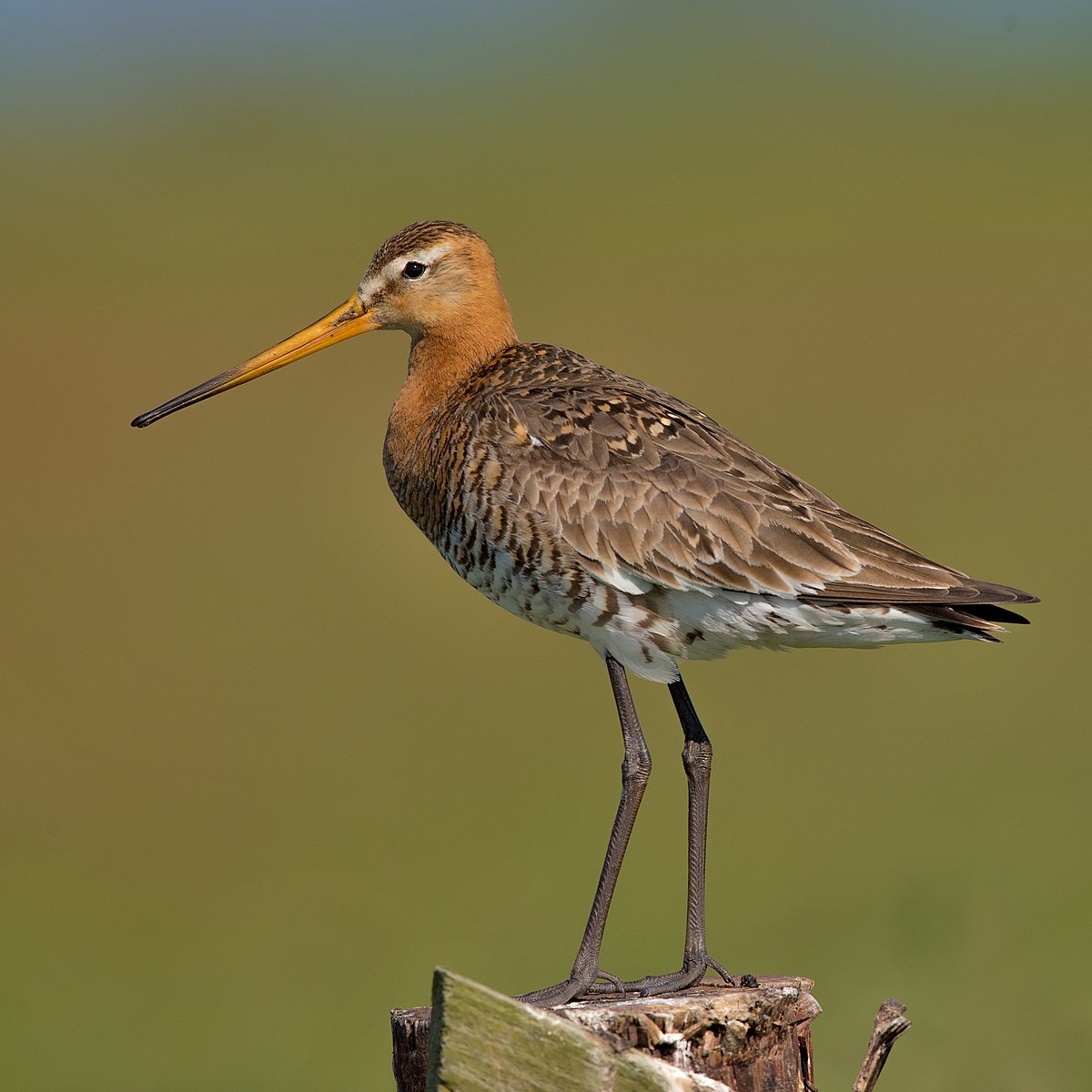
Wikipedia: Black-tailed godwit Source: OTHER
1200px-Black-tailed_Godwit_Uferschnepfe.jpg
This bird appears across the great seas in the following continents:
Europe, North America, Africa, Asia.
General: ![]() The black-tailed godwit (Limosa limosa) is a large, long-legged, long-billed shorebird first described by Carl Linnaeus in 1758. It is a member of the godwit genus, Limosa. There are three subspecies, all with orange head, neck and chest in breeding plumage and dull grey-brown winter coloration, and distinctive black and white wingbar at all times.
[more]
The black-tailed godwit (Limosa limosa) is a large, long-legged, long-billed shorebird first described by Carl Linnaeus in 1758. It is a member of the godwit genus, Limosa. There are three subspecies, all with orange head, neck and chest in breeding plumage and dull grey-brown winter coloration, and distinctive black and white wingbar at all times.
[more]
Habitats:
Wetland
Common redshank / Rotschenkel (Tringa totanus)
Profile Wikipedia eBird Vogelwarte BirdLife ZH ornitho.ch Xeno-Canto BirdID NABU
Common redshank plus common pochard. 2022-04-12 14.02.38 Mallorca
First observed in Mallorca on 2022-04-12.
![]() The common redshank or simply redshank (Tringa totanus) is a Eurasian wader in the large family Scolopacidae. The genus name Tringa is the New Latin name given to the green sandpiper by Aldrovandus in 1599 based on Ancient Greek trungas, a thrush-sized, white-rumped, tail-bobbing wading bird mentioned by Aristotle. The specific totanus is from Tótano, the Italian name for this bird.[2]
[more]
The common redshank or simply redshank (Tringa totanus) is a Eurasian wader in the large family Scolopacidae. The genus name Tringa is the New Latin name given to the green sandpiper by Aldrovandus in 1599 based on Ancient Greek trungas, a thrush-sized, white-rumped, tail-bobbing wading bird mentioned by Aristotle. The specific totanus is from Tótano, the Italian name for this bird.[2]
[more]
Vocalization: ![]() Generally a noisy and loud bird, especially at breeding ground. Most heard is a characteristic "tew-hoo", or "tew-hoo-hoo" with first syllable accentuated. No gap between the syllables like Greenshank, and usually with a marked falling pitch. [Link]
Generally a noisy and loud bird, especially at breeding ground. Most heard is a characteristic "tew-hoo", or "tew-hoo-hoo" with first syllable accentuated. No gap between the syllables like Greenshank, and usually with a marked falling pitch. [Link]
Song: ![]() Song similar to Wood Sandpiper, but with three accented notes in each cycle, not two. [Link]
Song similar to Wood Sandpiper, but with three accented notes in each cycle, not two. [Link]
Physical details: length=27-29 cm,
wingspan=59-66 cm,
weight=85-150 g
Habitats:
Wetland
Wood sandpiper / Bruchwasserläufer (Tringa glareola)
Profile Wikipedia eBird Vogelwarte BirdLife ZH ornitho.ch Audubon AllAboutBirds Xeno-Canto BirdID NABU

Wikipedia: Wood sandpiper Source: OTHER
1200px-Wood_Sandpiper_Safari_Park.jpg
First observed in 🇨🇭 on 2021-08-19.
This bird appears across the great seas in the following continents:
Europe, North America, Africa, Asia.
General: ![]() The wood sandpiper (Tringa glareola) is a small wader. This Eurasian species is the smallest of the shanks, which are mid-sized long-legged waders of the family Scolopacidae. The genus name Tringa is the New Latin name given to the green sandpiper by Aldrovandus in 1599 based on Ancient Greek trungas, a thrush-sized, white-rumped, tail-bobbing wading bird mentioned by Aristotle. The specific glareola is from Latin glarea, " gravel".[2]
[more]
The wood sandpiper (Tringa glareola) is a small wader. This Eurasian species is the smallest of the shanks, which are mid-sized long-legged waders of the family Scolopacidae. The genus name Tringa is the New Latin name given to the green sandpiper by Aldrovandus in 1599 based on Ancient Greek trungas, a thrush-sized, white-rumped, tail-bobbing wading bird mentioned by Aristotle. The specific glareola is from Latin glarea, " gravel".[2]
[more]
Vocalization: ![]() Totally different from Green Sandpiper. [Link]
Totally different from Green Sandpiper. [Link]
Calls: ![]() Flight call a soft, but explosive "whiff whiff" , sometimes with only one syllable. Display call similar to redshank but with only two accented beats; a fast melodious "dee-loo", repeated in cycles. [Link]
Flight call a soft, but explosive "whiff whiff" , sometimes with only one syllable. Display call similar to redshank but with only two accented beats; a fast melodious "dee-loo", repeated in cycles. [Link]
Physical details: length=19-21 cm,
wingspan=56-57 cm,
weight=50-80 g
Habitats:
Wetland
Call:
Automatically generated from Xeno-Canto recording
♫ Source: BirdNet
20210819_082604 birdnet 1940 - Wood Sandpiper, saw a bird flying, check reports in Ornitho - Wood Sandpiper - Uznach.mp3
2021-08-19 08.26.04 Uznach (song?)
Spotted redshank / Dunkler Wasserläufer (Tringa erythropus)
Profile Wikipedia eBird Vogelwarte BirdLife ZH ornitho.ch Xeno-Canto BirdID NABU
Dunkler Wasserlaeufer. 2021-10-24 10.25.42 Neeracherried
First observed in 🇨🇭 on 2021-10-24.
General: ![]() The spotted redshank (Tringa erythropus) is a wader (shorebird) in the large bird family Scolopacidae. The genus name Tringa is the New Latin name given to the green sandpiper by Aldrovandus in 1599 based on Ancient Greek trungas, a thrush-sized, white-rumped, tail-bobbing wading bird mentioned by Aristotle. The specific erythropus is from Ancient Greek eruthros, "red", and pous, "foot".[2]
[more]
The spotted redshank (Tringa erythropus) is a wader (shorebird) in the large bird family Scolopacidae. The genus name Tringa is the New Latin name given to the green sandpiper by Aldrovandus in 1599 based on Ancient Greek trungas, a thrush-sized, white-rumped, tail-bobbing wading bird mentioned by Aristotle. The specific erythropus is from Ancient Greek eruthros, "red", and pous, "foot".[2]
[more]
Calls: ![]() Flight call loud and diagnostic, and is often the first sign of the species' presence; a sharp and short, disyllabic "koo-eett", with the first syllable falling in pitch and the second rising sharply. Display call a squeaky, but melodic "krroo-lee-ooo" repeated in cycles. Alarm call a falcon-like "ke-ke-ke-ke". [Link]
Flight call loud and diagnostic, and is often the first sign of the species' presence; a sharp and short, disyllabic "koo-eett", with the first syllable falling in pitch and the second rising sharply. Display call a squeaky, but melodic "krroo-lee-ooo" repeated in cycles. Alarm call a falcon-like "ke-ke-ke-ke". [Link]
Physical details: length=29-31 cm,
wingspan=61-67 cm,
weight=125-210 g
Habitats:
Wetland
Green sandpiper / Waldwasserläufer (Tringa ochropus)
Profile Wikipedia eBird Vogelwarte BirdLife ZH ornitho.ch Xeno-Canto BirdID NABU
Waldwasserlaeufer. 2023-07-08 19.09.34 Neeracherried
First observed in 🇨🇭 on 2022-09-04.
General: ![]() The green sandpiper (Tringa ochropus) is a small wader (shorebird) of the Old World. The genus name Tringa is the New Latin name given to the green sandpiper by Aldrovandus in 1599 based on Ancient Greek trungas, a thrush-sized, white-rumped, tail-bobbing wading bird mentioned by Aristotle. The specific ochropus is from Ancient Greek okhros, "ochre", and pous, "foot".[2]
[more]
The green sandpiper (Tringa ochropus) is a small wader (shorebird) of the Old World. The genus name Tringa is the New Latin name given to the green sandpiper by Aldrovandus in 1599 based on Ancient Greek trungas, a thrush-sized, white-rumped, tail-bobbing wading bird mentioned by Aristotle. The specific ochropus is from Ancient Greek okhros, "ochre", and pous, "foot".[2]
[more]
Vocalization: ![]() Totally different from Wood Sandpiper. [Link]
Totally different from Wood Sandpiper. [Link]
Calls: ![]() Sharp, penetrating calls. Display call a high-pitched "kee-kleeoo-eet", continuously repeated with a wave-like motion in pitch. Other common calls have similar timbre and tone with different phrasing like; "klooeett -klee-klee-klee-klee-klee" and a rising pitch. [Link]
Sharp, penetrating calls. Display call a high-pitched "kee-kleeoo-eet", continuously repeated with a wave-like motion in pitch. Other common calls have similar timbre and tone with different phrasing like; "klooeett -klee-klee-klee-klee-klee" and a rising pitch. [Link]
Physical details: length=21-24 cm,
wingspan=57-61 cm,
weight=60-90 g
Habitats:
Wetland
Marsh sandpiper / Teichwasserläufer (Tringa stagnatilis)
Profile Wikipedia eBird Vogelwarte BirdLife ZH ornitho.ch Xeno-Canto BirdID NABU

Wikipedia: Marsh sandpiper Source: OTHER
1200px-Tringa_stagnatilis_2_-_Laem_Pak_Bia.jpg
General: ![]() The marsh sandpiper (Tringa stagnatilis) is a small wader. It is a rather small shank, and breeds in open grassy steppe and taiga wetlands from easternmost Europe to the Russian Far East. The genus name Tringa is the New Latin name given to the green sandpiper by Aldrovandus in 1599 based on Ancient Greek trungas, a thrush-sized, white-rumped, tail-bobbing wading bird mentioned by Aristotle. The specific stagnatilis is from Latin stagnum, "swamp".[2]
[more]
The marsh sandpiper (Tringa stagnatilis) is a small wader. It is a rather small shank, and breeds in open grassy steppe and taiga wetlands from easternmost Europe to the Russian Far East. The genus name Tringa is the New Latin name given to the green sandpiper by Aldrovandus in 1599 based on Ancient Greek trungas, a thrush-sized, white-rumped, tail-bobbing wading bird mentioned by Aristotle. The specific stagnatilis is from Latin stagnum, "swamp".[2]
[more]
Song: ![]() Song a slow, melancholic whistle "tu-lee-uu", with the middle part highest in pitch (and with falling glissando). Similar to Spotted Redshank in structure, but with a clear tone (little risk of confusion). [Link]
Song a slow, melancholic whistle "tu-lee-uu", with the middle part highest in pitch (and with falling glissando). Similar to Spotted Redshank in structure, but with a clear tone (little risk of confusion). [Link]
Calls: ![]() Flight call/contact call similar to singular instances of alarm call of Redshank, consisting of a single note rising abruptly in pitch in a split second and then falling; "kieew". Lingers a bit at the ending of the note, giving it a clearer glissando than in Redshank. [Link]
Flight call/contact call similar to singular instances of alarm call of Redshank, consisting of a single note rising abruptly in pitch in a split second and then falling; "kieew". Lingers a bit at the ending of the note, giving it a clearer glissando than in Redshank. [Link]
Physical details: length=22-24 cm,
wingspan=55-59 cm,
weight=50-85 g
Common greenshank / Grünschenkel (Tringa nebularia)
Profile Wikipedia eBird Vogelwarte BirdLife ZH ornitho.ch Audubon AllAboutBirds Xeno-Canto BirdID NABU
MerlinBirdID says common greenshank, probably non-breeding adult. 2022-04-12 14.52.08 Mallorca
First observed in Mallorca on 2022-04-12.
This bird appears across the great seas in the following continents:
Europe, North America, Africa, Asia.
General: ![]() The common greenshank (Tringa nebularia) is a wader in the large family Scolopacidae, the typical waders. The genus name Tringa is the New Latin name given to the green sandpiper by Aldrovandus in 1599 based on Ancient Greek trungas, a thrush-sized, white-rumped, tail-bobbing wading bird mentioned by Aristotle. The specific nebularia is from Latin nebula "mist". Like the Norwegian Skoddefoll, this refers to the greenshank's damp marshy habitat.[2]
[more]
The common greenshank (Tringa nebularia) is a wader in the large family Scolopacidae, the typical waders. The genus name Tringa is the New Latin name given to the green sandpiper by Aldrovandus in 1599 based on Ancient Greek trungas, a thrush-sized, white-rumped, tail-bobbing wading bird mentioned by Aristotle. The specific nebularia is from Latin nebula "mist". Like the Norwegian Skoddefoll, this refers to the greenshank's damp marshy habitat.[2]
[more]
Vocalization: ![]() Most heard is a characteristic, trisyllabic "tew-tew-tew" (sometimes two or four syllables). Can resemble redshank, but pitch more stable, and not falling notably. Each syllable is clearly separated and equally emphasized. [Link]
Most heard is a characteristic, trisyllabic "tew-tew-tew" (sometimes two or four syllables). Can resemble redshank, but pitch more stable, and not falling notably. Each syllable is clearly separated and equally emphasized. [Link]
Song: ![]() Song a clear disyllabic "cloo-eeee", repeated in cycles but each phrase clearly separated. At close range a short creaky sound is audible (between each phrase). Redshank may sing in a slightly similar way, but in continuous, linked phrases. [Link]
Song a clear disyllabic "cloo-eeee", repeated in cycles but each phrase clearly separated. At close range a short creaky sound is audible (between each phrase). Redshank may sing in a slightly similar way, but in continuous, linked phrases. [Link]
Physical details: length=30-33 cm,
wingspan=68-70 cm,
weight=130-270 g
Habitats:
Wetland
Common sandpiper / Flussuferläufer (Actitis hypoleucos)
MerlinBirdID meint Flussuferläufer. 2022-09-04 07.49.06 Neeracherried
First observed in 🇨🇭 on 2022-09-04.
This bird appears across the great seas in the following continents:
Europe, North America, Africa, Asia.
General: ![]() The common sandpiper (Actitis hypoleucos) is a small Palearctic wader. This bird and its American sister species, the spotted sandpiper (A. macularia), make up the genus Actitis. They are parapatric and replace each other geographically; stray birds of either species may settle down with breeders of the other and hybridize. Hybridization has also been reported between the common sandpiper and the green sandpiper, a basal species of the closely related shank genus Tringa.
[more]
The common sandpiper (Actitis hypoleucos) is a small Palearctic wader. This bird and its American sister species, the spotted sandpiper (A. macularia), make up the genus Actitis. They are parapatric and replace each other geographically; stray birds of either species may settle down with breeders of the other and hybridize. Hybridization has also been reported between the common sandpiper and the green sandpiper, a basal species of the closely related shank genus Tringa.
[more]
Calls: ![]() Very vocal with characteristic repertoire of very high-pitched calls. Often heard is a disyllabic call, drawn out and slightly rising in pitch in the second part. This is often repeated in a series of rising tones in a cyclic manner, with approx 5 tones in each cycle. [Link]
Very vocal with characteristic repertoire of very high-pitched calls. Often heard is a disyllabic call, drawn out and slightly rising in pitch in the second part. This is often repeated in a series of rising tones in a cyclic manner, with approx 5 tones in each cycle. [Link]
Physical details: length=19-21 cm,
wingspan=38-41 cm,
weight=40-60 g
Habitats:
Wetland
Red phalarope / Thorshühnchen (Phalaropus fulicarius)

Wikipedia: Red phalarope Source: OTHER
1200px-Phalaropus_fulicarius_10.jpg
This bird appears across the great seas in the following continents:
Europe, North America, South America, Africa.
General: ![]() The red phalarope or grey phalarope (Phalaropus fulicarius) is a small wader. This phalarope breeds in the Arctic regions of North America and Eurasia. It is migratory, and, unusually for a wader, migrating mainly on oceanic routes and wintering at sea on tropical oceans.
[more]
The red phalarope or grey phalarope (Phalaropus fulicarius) is a small wader. This phalarope breeds in the Arctic regions of North America and Eurasia. It is migratory, and, unusually for a wader, migrating mainly on oceanic routes and wintering at sea on tropical oceans.
[more]
Calls: ![]() Flight-call a short and sharp, Coot-like "kit". Cleaner and higher pitched than Red-necked Phalarope. Display sound a rolling cooing, at stable pitch. Other calls: a hissing like the squeezing of a rubber duck, rising quickly in pitch and ending abruptly. [Link]
Flight-call a short and sharp, Coot-like "kit". Cleaner and higher pitched than Red-necked Phalarope. Display sound a rolling cooing, at stable pitch. Other calls: a hissing like the squeezing of a rubber duck, rising quickly in pitch and ending abruptly. [Link]
Physical details: length=20-22 cm,
wingspan=40-44 cm,
weight=40-75 g
Common tern / Flussseeschwalbe (Sterna hirundo)
Profile Wikipedia eBird Vogelwarte BirdLife ZH ornitho.ch bird-song.ch Audubon AllAboutBirds Xeno-Canto BirdID NABU
First observed in 🇨🇭 on 2020-04-27.
This bird appears across the great seas in the following continents:
Europe, North America, South America, Africa, Asia.
Seasonal Behavior: ![]() Die Flussseeschwalbe (Sterna hirundo) ist eine Vogelart aus der Familie der Seeschwalben (Sternidae).
Sie ist in Mitteleuropa ein verbreiteter, aber nicht sehr häufiger Brut- und Sommervogel.
Während der Zugzeiten können im mitteleuropäischen Raum außerdem viele Durchzügler beobachtet werden. [Link]
Die Flussseeschwalbe (Sterna hirundo) ist eine Vogelart aus der Familie der Seeschwalben (Sternidae).
Sie ist in Mitteleuropa ein verbreiteter, aber nicht sehr häufiger Brut- und Sommervogel.
Während der Zugzeiten können im mitteleuropäischen Raum außerdem viele Durchzügler beobachtet werden. [Link]
Vocalization: ![]() Similar to Arctic Tern but deeper. [Link]
Similar to Arctic Tern but deeper. [Link]
Calls: ![]() Lacks latter's high pitched "tip-tip-tip" call, and the drawn out "kree-aaahh" call falls more distinctly in pitch. [Link]
Lacks latter's high pitched "tip-tip-tip" call, and the drawn out "kree-aaahh" call falls more distinctly in pitch. [Link]
Physical details: length=31-35 cm,
wingspan=77-98 cm,
weight=110-150 g
Habitats:
River and lake
Call:
Automatically generated from Xeno-Canto recording
♫ Source: BirdNet
20200427_140813 birdnet 430 - Common tern.mp3
2020-04-27 14.08.13 Luppmen (song?)
Arctic tern / Kü̈stenseeschwalbe (Sterna paradisaea)
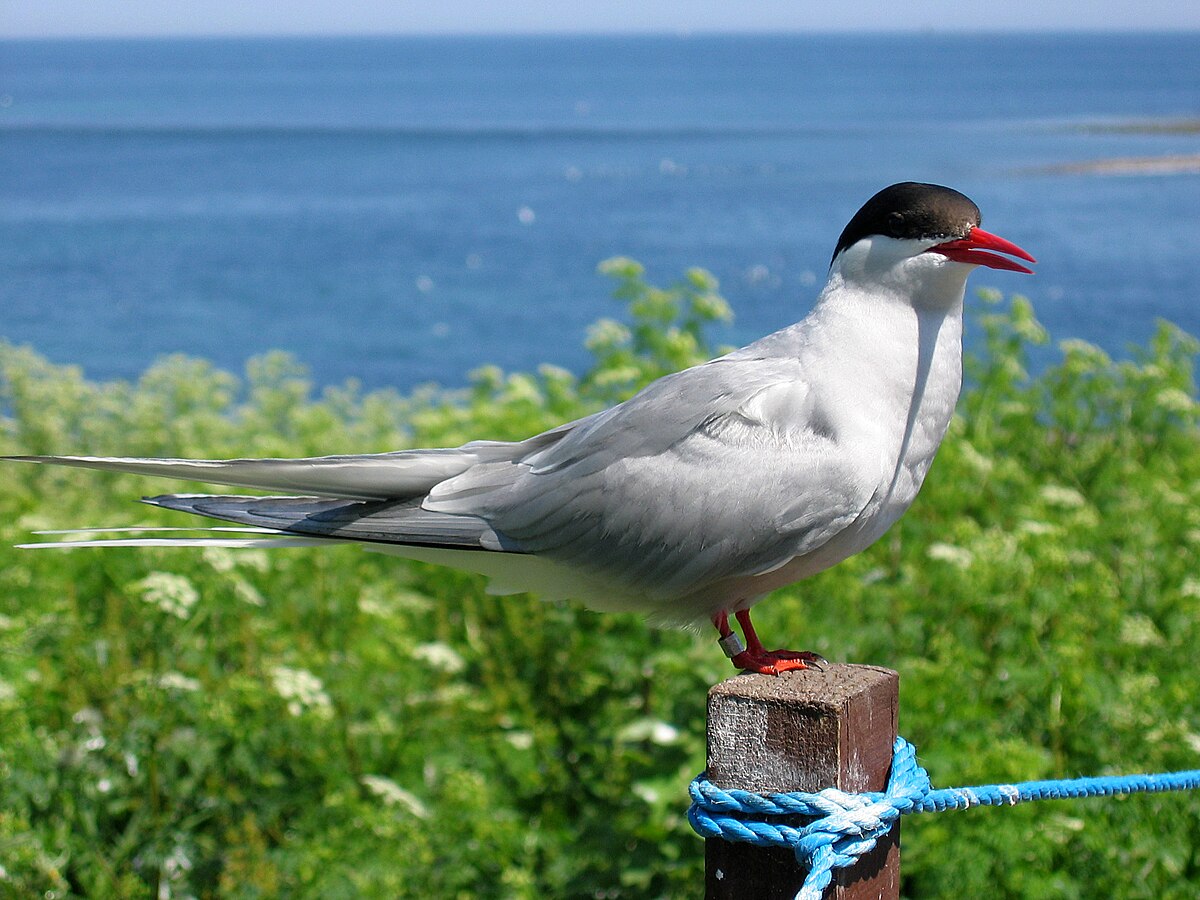
Wikipedia: Arctic tern Source: OTHER
1200px-2009_07_02_-_Arctic_tern_on_Farne_Islands_-_The_blue_rope_demarcates_the_visitors%27_path.JPG
This bird appears across the great seas in the following continents:
Europe, North America, South America, Africa.
General: ![]() The Arctic tern (Sterna paradisaea) is a tern in the family Laridae. This bird has a circumpolar breeding distribution covering the Arctic and sub-Arctic regions of Europe, Asia, and North America (as far south as Brittany and Massachusetts). The species is strongly migratory, seeing two summers each year as it migrates along a convoluted route from its northern breeding grounds to the Antarctic coast for the southern summer and back again about six months later. Recent studies have shown average annual roundtrip lengths of about 70,900 km (44,100 mi) for birds nesting in Iceland and Greenland[3] and about 90,000 km (56,000 mi) for birds nesting in the Netherlands.[4] These are by far the longest migrations known in the animal kingdom. The Arctic tern flies as well as glides through the air. It nests once every one to three years (depending on its mating cycle); once it has finished nesting it takes to the sky for another long southern migration.
[more]
The Arctic tern (Sterna paradisaea) is a tern in the family Laridae. This bird has a circumpolar breeding distribution covering the Arctic and sub-Arctic regions of Europe, Asia, and North America (as far south as Brittany and Massachusetts). The species is strongly migratory, seeing two summers each year as it migrates along a convoluted route from its northern breeding grounds to the Antarctic coast for the southern summer and back again about six months later. Recent studies have shown average annual roundtrip lengths of about 70,900 km (44,100 mi) for birds nesting in Iceland and Greenland[3] and about 90,000 km (56,000 mi) for birds nesting in the Netherlands.[4] These are by far the longest migrations known in the animal kingdom. The Arctic tern flies as well as glides through the air. It nests once every one to three years (depending on its mating cycle); once it has finished nesting it takes to the sky for another long southern migration.
[more]
Vocalization: ![]() Similar to Common Tern but higher pitched. [Link]
Similar to Common Tern but higher pitched. [Link]
Calls: ![]() Typical call a series of high pitched "tip-tip-tip", and longer, ringing, high-pitched "kriiiiii" calls. The drawn out "kree-aaahh" call falls less distinctly in pitch than Common Tern. [Link]
Typical call a series of high pitched "tip-tip-tip", and longer, ringing, high-pitched "kriiiiii" calls. The drawn out "kree-aaahh" call falls less distinctly in pitch than Common Tern. [Link]
Physical details: length=33-35 cm,
wingspan=75-85 cm,
weight=95-120 g
Eurasian oystercatcher / Austernfischer (Haematopus ostralegus)
Profile Wikipedia eBird Vogelwarte BirdLife ZH ornitho.ch Xeno-Canto BirdID NABU
Eurasian oystercatcher, Iceland. 2015-06-09 14.05.20 Iceland
First observed in Iceland on 2015-06-09.
Etymology: Bbc2: A flock of oyster catchers is a parcel [A nugget from Winterwatch 2022, episode 1, from BBC 2]
Vocalization: ![]() Very vocal. [Link]
Very vocal. [Link]
Calls: ![]() Sharp, loud and far carrying, disyllabic or monosyllabic calls "ku-eek" or "kleek". Often works itself up into a crescendos of fast, piping calls, and then mellows out. [Link]
Sharp, loud and far carrying, disyllabic or monosyllabic calls "ku-eek" or "kleek". Often works itself up into a crescendos of fast, piping calls, and then mellows out. [Link]
Physical details: length=40-45 cm,
wingspan=80-86 cm,
weight=430-650 g
Habitats:
Wetland
Pomarine jaeger / Spatelraubmöwe (Stercorarius pomarinus)
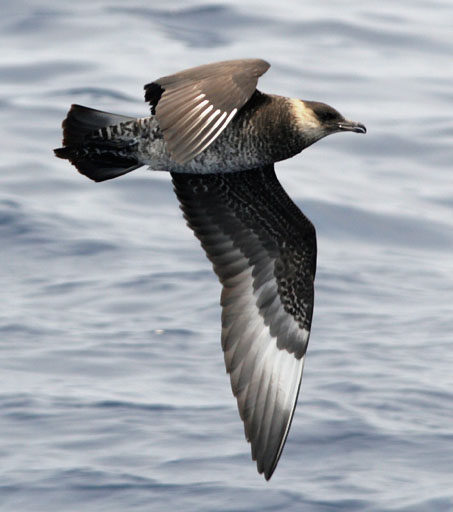
Wikipedia: Pomarine jaeger Source: OTHER
Stercorarius_pomarinusPCCA20070623-3985B.jpg
This bird appears across the great seas in the following continents:
Europe, North America, South America, Africa, Asia.
General: ![]() The pomarine jaeger (Stercorarius pomarinus), pomarine skua, or pomatorhine skua,[2] is a seabird in the skua family Stercorariidae. It is a migrant, wintering at sea in the tropical oceans.
[more]
The pomarine jaeger (Stercorarius pomarinus), pomarine skua, or pomatorhine skua,[2] is a seabird in the skua family Stercorariidae. It is a migrant, wintering at sea in the tropical oceans.
[more]
Calls: ![]() Short "kea" or "ke", and various mewing calls, usually deeper pitched than Arctic Skua. Also a characteristic, laughing and vibrating "kayayayayaya", heard mostly on breeding ground. [Link]
Short "kea" or "ke", and various mewing calls, usually deeper pitched than Arctic Skua. Also a characteristic, laughing and vibrating "kayayayayaya", heard mostly on breeding ground. [Link]
Physical details: length=46-51 cm,
wingspan=125-138 cm,
weight=600-900 g
Long-tailed jaeger / Falkenraubmöwe (Stercorarius longicaudus)

Wikipedia: Long-tailed jaeger Source: OTHER
1200px-Long-tailed_Skua_%28js%29_26.jpg
This bird appears across the great seas in the following continents:
Europe, North America, Africa, Asia.
General: ![]() The long-tailed skua or long-tailed jaeger (Stercorarius longicaudus) is a seabird in the skua family Stercorariidae.
[more]
The long-tailed skua or long-tailed jaeger (Stercorarius longicaudus) is a seabird in the skua family Stercorariidae.
[more]
Parasitic jaeger / Schmarotzerraubmöwe (Stercorarius parasiticus)
Our guide raises his arm, which results in the Arctic Skua keeping a safe distance. 2015-06-10 15.13.04 Iceland
First observed in Iceland on 2015-06-10.
This bird appears across the great seas in the following continents:
Europe, North America, South America, Africa, Asia.
![]() The parasitic jaeger (Stercorarius parasiticus), also known as the Arctic skua, Arctic jaeger or parasitic skua, is a seabird in the skua family Stercorariidae. The word "jaeger" is derived from the German word Jäger, meaning "hunter".[2] The English "skua" comes from the Faroese name skúgvur [ˈskɪkvʊər] for the great skua, with the island of Skúvoy known for its colony of that bird. The general Faroese term for skuas is kjógvi [ˈtʃɛkvə].[3] The genus name Stercorarius is Latin and means "of dung"; the food disgorged by other birds when pursued by skuas was once thought to be excrement. The specific parasiticus is from Latin and means "parasitic".[4]
[more]
The parasitic jaeger (Stercorarius parasiticus), also known as the Arctic skua, Arctic jaeger or parasitic skua, is a seabird in the skua family Stercorariidae. The word "jaeger" is derived from the German word Jäger, meaning "hunter".[2] The English "skua" comes from the Faroese name skúgvur [ˈskɪkvʊər] for the great skua, with the island of Skúvoy known for its colony of that bird. The general Faroese term for skuas is kjógvi [ˈtʃɛkvə].[3] The genus name Stercorarius is Latin and means "of dung"; the food disgorged by other birds when pursued by skuas was once thought to be excrement. The specific parasiticus is from Latin and means "parasitic".[4]
[more]
Vocalization: ![]() Mostly heard at breeding ground. [Link]
Mostly heard at breeding ground. [Link]
Calls: ![]() Most characteristic call is a mewing, kittiwake-like "aeeeee-ah". First syllable drawn-out and rising in pitch, and followed by a deeper conclusive second syllable "ah". Lacks the introductory double accent of Kittiwakes ("kitti-wake"). [Link]
Most characteristic call is a mewing, kittiwake-like "aeeeee-ah". First syllable drawn-out and rising in pitch, and followed by a deeper conclusive second syllable "ah". Lacks the introductory double accent of Kittiwakes ("kitti-wake"). [Link]
Physical details: length=41-46 cm,
wingspan=110-125 cm,
weight=330-570 g
Family Burhinidae (Triele, Haematopodidae – Austernfischer und Recurvirostridae – Säbelschnäblerverwandte):
Eurasian stone-curlew / Triel (Burhinus oedicnemus)

Wikipedia: Eurasian stone-curlew Source: OTHER
1200px-Burhinus_oedicnemus_insularum_Lanzarote_1.jpg
General: ![]() The Eurasian stone-curlew, Eurasian thick-knee, or simply stone-curlew (Burhinus oedicnemus) is a northern species of the Burhinidae (stone-curlew) bird family.
[more]
The Eurasian stone-curlew, Eurasian thick-knee, or simply stone-curlew (Burhinus oedicnemus) is a northern species of the Burhinidae (stone-curlew) bird family.
[more]
Calls: ![]() Very vocal at twilight with various wailing, curlew-like calls, undulating in crescendoes, often in joined choruses. Most typical call a cyclic "turrru-leeek", with rolling "r" and second part higher pitched (at end of sound file). [Link]
Very vocal at twilight with various wailing, curlew-like calls, undulating in crescendoes, often in joined choruses. Most typical call a cyclic "turrru-leeek", with rolling "r" and second part higher pitched (at end of sound file). [Link]
Physical details: length=40-44 cm,
wingspan=77-85 cm,
weight=430-500 g
Habitats:
Wetland
Pied avocet / Säbelschnäbler (Recurvirostra avosetta)
Profile Wikipedia eBird Vogelwarte BirdLife ZH ornitho.ch Xeno-Canto BirdID NABU
Saebelschnaebler bei Ses Salines. 2022-04-08 17.01.38 Mallorca
First observed in Mallorca on 2022-04-08.
General: ![]() The pied avocet (Recurvirostra avosetta) is a large black and white wader in the avocet and stilt family, Recurvirostridae. They breed in temperate Europe and across the Palearctic to Central Asia then on to the Russian Far East. It is a migratory species and most winter in Africa or southern Asia. Some remain to winter in the mildest parts of their range, for example in southern Spain and southern England. The pied avocet is one of the species to which the Agreement on the Conservation of African-Eurasian Migratory Waterbirds (AEWA) applies.
[more]
The pied avocet (Recurvirostra avosetta) is a large black and white wader in the avocet and stilt family, Recurvirostridae. They breed in temperate Europe and across the Palearctic to Central Asia then on to the Russian Far East. It is a migratory species and most winter in Africa or southern Asia. Some remain to winter in the mildest parts of their range, for example in southern Spain and southern England. The pied avocet is one of the species to which the Agreement on the Conservation of African-Eurasian Migratory Waterbirds (AEWA) applies.
[more]
Vocalization: ![]() Not very vocal away from breeding ground. [Link]
Not very vocal away from breeding ground. [Link]
Calls: ![]() Most common contact call a soft, short "kluitt" reminiscent of Ringed Plover, but harder and less varied. Also sometimes followed by repeated chattering: "kluitt-trt-trt-trt-trt-trt-trt". [Link]
Most common contact call a soft, short "kluitt" reminiscent of Ringed Plover, but harder and less varied. Also sometimes followed by repeated chattering: "kluitt-trt-trt-trt-trt-trt-trt". [Link]
Physical details: length=42-45 cm,
wingspan=77-80 cm,
weight=260-290 g
Habitats:
Wetland
Call:
Automatically generated from Xeno-Canto recording
♫ Source: BirdNet
20220408_171858 birdnet - Säbelschnäbler - Säbelschnäbler - Campos.mp3
2022-04-08 17.18.58 Mallorca (song?)
Black-winged stilt / Stelzenläufer (Himantopus himantopus)
Profile Wikipedia eBird Vogelwarte BirdLife ZH ornitho.ch Xeno-Canto NABU
Black winged stilt. 2024-02-24 09.29.24 Laos
First observed in Mallorca on 2022-04-12.
General: ![]() The black-winged stilt (Himantopus himantopus) is a widely distributed very long-legged wader in the avocet and stilt family (Recurvirostridae). The scientific name H. himantopus was formerly applied to a single, almost cosmopolitan species. It is now normally applied to the form that is widespread in Eurosiberia and Africa and which was formerly regarded as the nominate subspecies of Himantopus himantopus sensu lato. The scientific name Himantopus comes from the Greek meaning "strap foot" or "thong foot".[2] Most sources today accept 2–4 species.[3][4][5][6][7][8] It is sometimes called pied stilt, but that name is now reserved for the Australian species, Himantopus leucocephalus.
[more]
The black-winged stilt (Himantopus himantopus) is a widely distributed very long-legged wader in the avocet and stilt family (Recurvirostridae). The scientific name H. himantopus was formerly applied to a single, almost cosmopolitan species. It is now normally applied to the form that is widespread in Eurosiberia and Africa and which was formerly regarded as the nominate subspecies of Himantopus himantopus sensu lato. The scientific name Himantopus comes from the Greek meaning "strap foot" or "thong foot".[2] Most sources today accept 2–4 species.[3][4][5][6][7][8] It is sometimes called pied stilt, but that name is now reserved for the Australian species, Himantopus leucocephalus.
[more]
Habitats:
Wetland
Call:
Automatically generated from Xeno-Canto recording
♫ XC863470 - Black-winged Stilt - Himantopus himantopus - flight call, a squeaky yapping - Camargue, France. Source: XENOCANTO
XC863470 - Black-winged Stilt - Himantopus himantopus - flight call, a squeaky yapping - Camargue, France.mp3
(flight call)

Call attributes:
flight call Frequency: ,
Eurasian coot / Blässhuhn (Fulica atra)
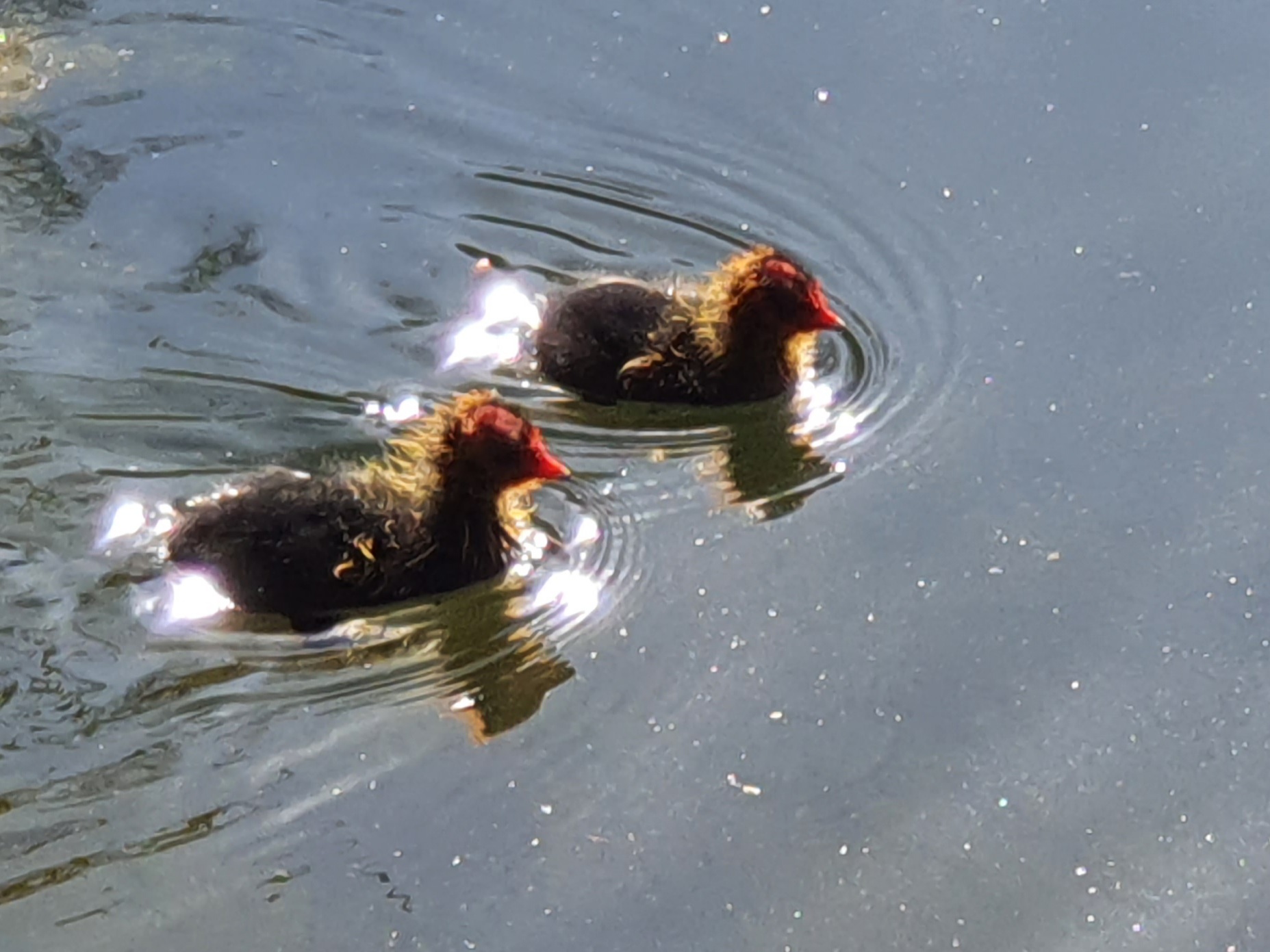
Baby coots near Fehraltorf 2020-04-14 18.00.54 Luppmen
First observed in 🇨🇭 on 2020-04-14.
![]() The Eurasian coot (Fulica atra), also known as the common coot, or Australian coot, is a member of the rail and crake bird family, the Rallidae. It is found in Europe, Asia, Australia, New Zealand and parts of North Africa. It has a slaty-black body, a glossy black head and a white bill with a white frontal shield. The sexes are similar.
[more]
The Eurasian coot (Fulica atra), also known as the common coot, or Australian coot, is a member of the rail and crake bird family, the Rallidae. It is found in Europe, Asia, Australia, New Zealand and parts of North Africa. It has a slaty-black body, a glossy black head and a white bill with a white frontal shield. The sexes are similar.
[more]
Vocalization: ![]() Varied. Usually short, metallic and explosive. [Link]
Varied. Usually short, metallic and explosive. [Link]
Calls: ![]() Most diagnostic call a very short, sharp and explosive "tsk". Sometimes a longer, less sharp but nasal "caw", with varying harshness. [Link]
Most diagnostic call a very short, sharp and explosive "tsk". Sometimes a longer, less sharp but nasal "caw", with varying harshness. [Link]
Physical details: length=36-38 cm,
wingspan=70-80 cm,
weight=600-1000 g
Habitats:
River and lake
Call:
Automatically generated from Xeno-Canto recording
♫ Taucherli Pfaeffikersee. 2021-02-05 10.34.24 Pfäffikersee (song?)
Water rail / Wasserralle (Rallus aquaticus)
Wasserralle im schilf am pfaeffikersee. 2021-02-15 08.33.30 Pfäffikersee
First observed in 🇨🇭 on 2021-02-15.
In reeds at a lake.
Appearance and identification: ![]() The upper parts from the forehead to tail are olive-brown with black streaks, especially on the shoulders. The sides of the head and the underparts down to the upper belly are dark slate-blue, except for a blackish area between bill and eye, and brownish sides to the upper breast. The flanks are barred black and white, and the undertail is white with some darker streaks. The long bill and the iris are red, and the legs are flesh-brown. [Link]
The upper parts from the forehead to tail are olive-brown with black streaks, especially on the shoulders. The sides of the head and the underparts down to the upper belly are dark slate-blue, except for a blackish area between bill and eye, and brownish sides to the upper breast. The flanks are barred black and white, and the undertail is white with some darker streaks. The long bill and the iris are red, and the legs are flesh-brown. [Link]
Vocalization: ![]() Varied but distinct. [Link]
Varied but distinct. [Link]
Song: ![]() Most heard is the territorial song consisting of short, nasal, sharp grunts "tuck- tuck-tuck", ending with a drawn-out trill rising and falling in pitch "kiiiieeerrrr". [Link]
Most heard is the territorial song consisting of short, nasal, sharp grunts "tuck- tuck-tuck", ending with a drawn-out trill rising and falling in pitch "kiiiieeerrrr". [Link]
Calls: ![]() Another diagnostic call is heard from excited birds; a longer pig-like shrilling squeal, with waning repetitions. A bit like someone squeezing a rubber toy. Also short and sharp calls "kvii". [Link]
Another diagnostic call is heard from excited birds; a longer pig-like shrilling squeal, with waning repetitions. A bit like someone squeezing a rubber toy. Also short and sharp calls "kvii". [Link]
Physical details: length=23-28 cm,
wingspan=38-45 cm,
weight=80-180 g
Habitats:
Wetland
Common moorhen / Teichhuhn (Gallinula chloropus)
Teichhuhn bei Rapperswil 2021-02-12 12.54.22 Rapperswil
First observed in 🇨🇭 on 2021-02-12.
This bird appears across the great seas in the following continents:
Europe, North America, Africa, Asia.
Seen at the Pfäffikersee walking across the path from one set of reeds to another.
An apprentice at the nature center gave us the identification, presuming it was a juvenile
because of the lack of color. I'd have said its legs were shorter, but the moorhen definitely
has the main trait we saw, that it holds its short tail in the air.
Habitat: ![]() Common Moorhens prefer to nest in the thicket on the edge of ponds, lakes or rivers and mostly only give themselves away through their guttural calls. They are easier to observe in winter because then they leave their well-vegetated habitat and are seen in meadows, parks and on open waters. [Link]
Common Moorhens prefer to nest in the thicket on the edge of ponds, lakes or rivers and mostly only give themselves away through their guttural calls. They are easier to observe in winter because then they leave their well-vegetated habitat and are seen in meadows, parks and on open waters. [Link]
Song: ![]() Most typical is the territorial call (song); a sharp, loud and resonant "krrrr-ook" or "krrrk". [Link]
Most typical is the territorial call (song); a sharp, loud and resonant "krrrr-ook" or "krrrk". [Link]
Calls: ![]() Rich repertoire of loud calls and softer sounds. Other calls; a sharp, three or four-syllable "kekeke", and a soft "wep" sometimes drawn-out in a more mewing version. [Link]
Rich repertoire of loud calls and softer sounds. Other calls; a sharp, three or four-syllable "kekeke", and a soft "wep" sometimes drawn-out in a more mewing version. [Link]
Physical details: length=32-35 cm,
wingspan=50-55 cm,
weight=240-420 g
Habitats:
Wetland
Little crake / Kleinsumpfhuhn (Zapornia parva)
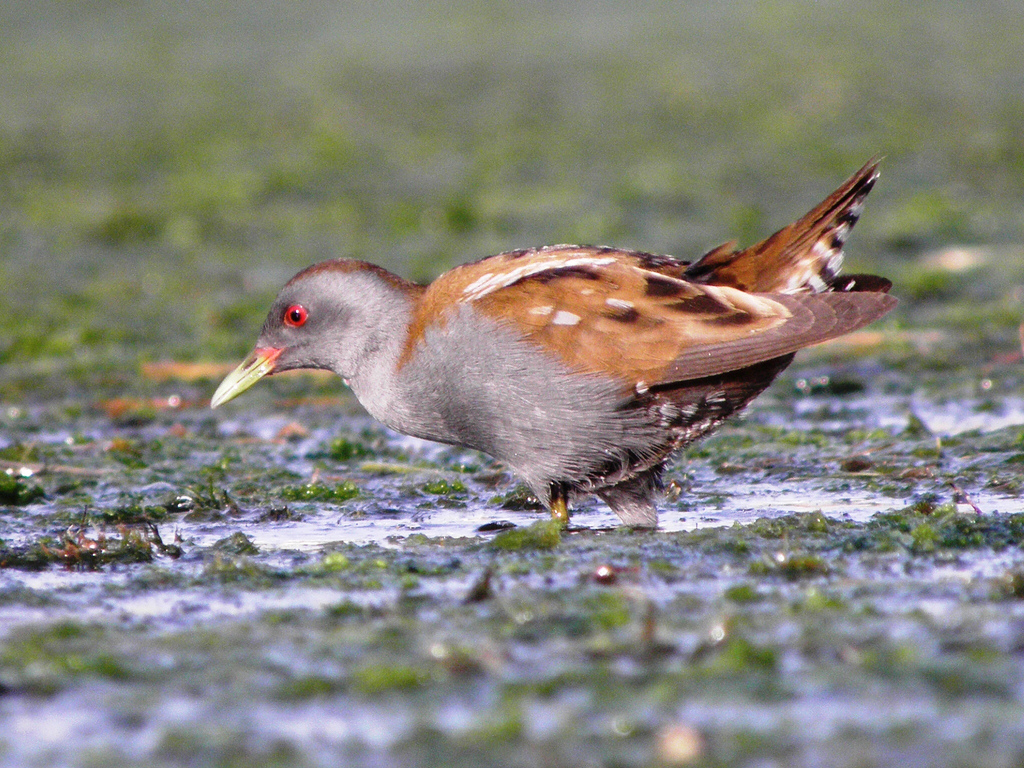
Wikipedia: Little crake Source: OTHER
Porzana_parva_%2850%29.jpg
General: ![]() The little crake (Zapornia parva) is a very small waterbird of the family Rallidae. parva is Latin for "small".[2]
[more]
The little crake (Zapornia parva) is a very small waterbird of the family Rallidae. parva is Latin for "small".[2]
[more]
Song: ![]() Male song diagnostic. A loud series of short, nasal ascending "quek" repeated every one and a half seconds or so, before accelerating and descending at the same time to a more guttural voice. Female song with similar short "quek" but with less pure tone and in shorter series (sometimes just one call), immediately followed by a rolling trill. [Link]
Male song diagnostic. A loud series of short, nasal ascending "quek" repeated every one and a half seconds or so, before accelerating and descending at the same time to a more guttural voice. Female song with similar short "quek" but with less pure tone and in shorter series (sometimes just one call), immediately followed by a rolling trill. [Link]
Calls: ![]() Rich repertoire of calls used freely in breeding season. [Link]
Rich repertoire of calls used freely in breeding season. [Link]
Physical details: length=18-20 cm,
wingspan=34-39 cm,
weight=40-60 g
Habitats:
Wetland
Spotted crake / Tüpfelsumpfhuhn (Porzana porzana)
Profile Wikipedia eBird Vogelwarte BirdLife ZH ornitho.ch Xeno-Canto BirdID NABU

Wikipedia: Spotted crake Source: OTHER
Porzana_porzana_6_%28Marek_Szczepanek%29.jpg
General: ![]() The spotted crake (Porzana porzana) is a small waterbird of the family Rallidae. The scientific name is derived from Venetian terms for small rails.[2]
[more]
The spotted crake (Porzana porzana) is a small waterbird of the family Rallidae. The scientific name is derived from Venetian terms for small rails.[2]
[more]
Song: ![]() Loud and far reaching song uttered with relentless stamina for hours on end. A monosyllabic, resonant and drawn-out "huiiit". [Link]
Loud and far reaching song uttered with relentless stamina for hours on end. A monosyllabic, resonant and drawn-out "huiiit". [Link]
Calls: ![]() The pith rises towards the emphasized end of the call, which is repeated about once a second. Often compared to the dripping of water. Mostly heard at night, and often i duet with mate. The female answers the male with a slightly deeper and softer call, giving the impression of one bird giving a disyllabic call. [Link]
The pith rises towards the emphasized end of the call, which is repeated about once a second. Often compared to the dripping of water. Mostly heard at night, and often i duet with mate. The female answers the male with a slightly deeper and softer call, giving the impression of one bird giving a disyllabic call. [Link]
Physical details: length=22-24 cm,
wingspan=37-42 cm,
weight=70-110 g
Habitats:
Wetland
Corn crake / Wachtelkönig (Crex crex)
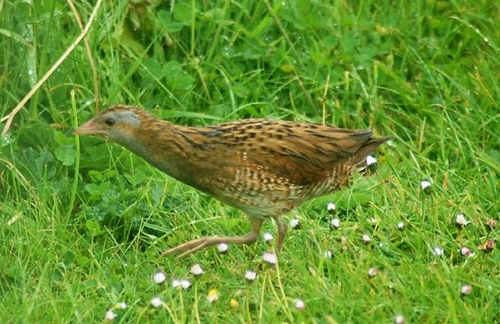
Wikipedia: Corn crake Source: OTHER
Corncrake2.jpg
General: ![]() The corn crake, corncrake or landrail (Crex crex) is a bird in the rail family. It breeds in Europe and Asia as far east as western China, and migrates to Africa for the Northern Hemisphere's winter. It is a medium-sized crake with buff- or grey-streaked brownish-black upperparts, chestnut markings on the wings, and blue-grey underparts with rust-coloured and white bars on the flanks and undertail. The strong bill is flesh-toned, the iris is pale brown, and the legs and feet are pale grey. Juveniles are similar in plumage to adults, and downy chicks are black, as with all rails. There are no subspecies, although individuals from the east of the breeding range tend to be slightly paler than their western counterparts. The male's call is a loud krek krek, from which the scientific name is derived. The corn crake is larger than its closest relative, the African crake, which shares its wintering range; that species is also darker-plumaged, and has a plainer face.
[more]
The corn crake, corncrake or landrail (Crex crex) is a bird in the rail family. It breeds in Europe and Asia as far east as western China, and migrates to Africa for the Northern Hemisphere's winter. It is a medium-sized crake with buff- or grey-streaked brownish-black upperparts, chestnut markings on the wings, and blue-grey underparts with rust-coloured and white bars on the flanks and undertail. The strong bill is flesh-toned, the iris is pale brown, and the legs and feet are pale grey. Juveniles are similar in plumage to adults, and downy chicks are black, as with all rails. There are no subspecies, although individuals from the east of the breeding range tend to be slightly paler than their western counterparts. The male's call is a loud krek krek, from which the scientific name is derived. The corn crake is larger than its closest relative, the African crake, which shares its wintering range; that species is also darker-plumaged, and has a plainer face.
[more]
Song: ![]() Characteristic song can be heard at night. A rasping, hoarse "crex-crex" repeated about every second for long periods of time. [Link]
Characteristic song can be heard at night. A rasping, hoarse "crex-crex" repeated about every second for long periods of time. [Link]
Physical details: length=27-30 cm,
wingspan=46-53 cm,
weight=120-200 g
Habitats:
Agricultural
Eurasian crane / Kranich (Grus grus)
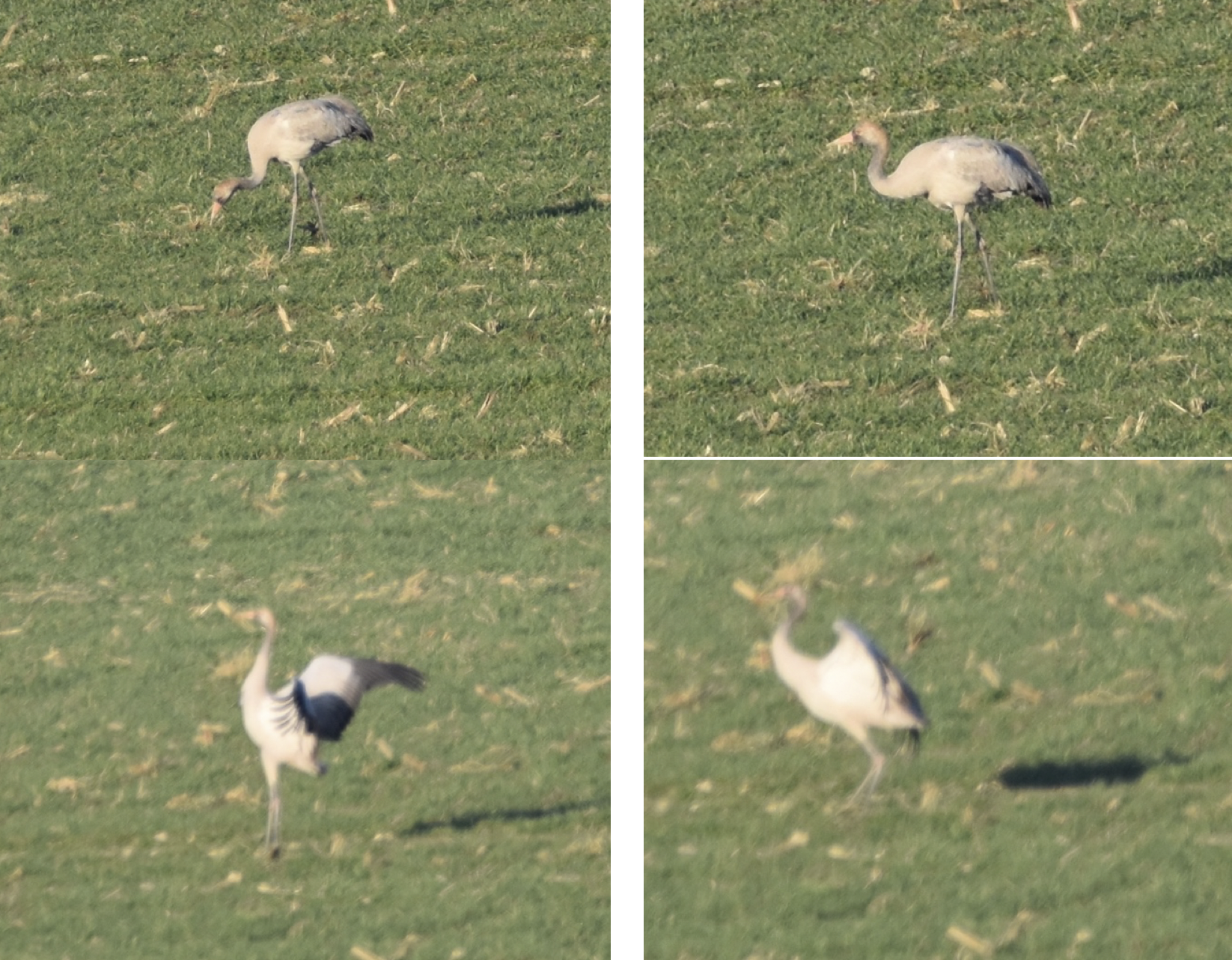
4 Bilder eines Kranich bei Uster-Werrikon. 2023-02-10 16.20.34 Uster
First observed in 🇨🇭 on 2023-02-10.
General: ![]() The common crane (Grus grus), also known as the Eurasian crane, is a bird of the family Gruidae, the cranes. A medium-sized species, it is the only crane commonly found in Europe besides the demoiselle crane (Grus virgo) and the Siberian crane (Leucogeranus leucogeranus) that only are regular in the far eastern part of the continent. Along with the sandhill crane (Antigone canadensis), demoiselle crane and the brolga (Antigone rubicunda), it is one of only four crane species not currently classified as threatened with extinction or conservation dependent on the species level. Despite the species' large numbers, local extinctions and extirpations have taken place in part of its range, and an ongoing reintroduction project is underway in the United Kingdom.[3]
[more]
The common crane (Grus grus), also known as the Eurasian crane, is a bird of the family Gruidae, the cranes. A medium-sized species, it is the only crane commonly found in Europe besides the demoiselle crane (Grus virgo) and the Siberian crane (Leucogeranus leucogeranus) that only are regular in the far eastern part of the continent. Along with the sandhill crane (Antigone canadensis), demoiselle crane and the brolga (Antigone rubicunda), it is one of only four crane species not currently classified as threatened with extinction or conservation dependent on the species level. Despite the species' large numbers, local extinctions and extirpations have taken place in part of its range, and an ongoing reintroduction project is underway in the United Kingdom.[3]
[more]
Vocalization: ![]() Powerful, resonant and bugling "kriiiiioooo" in various forms. Very far reaching. [Link]
Powerful, resonant and bugling "kriiiiioooo" in various forms. Very far reaching. [Link]
Calls: ![]() Often heard in duet where the female immediately answers the male call at a slightly deeper pitch. Also very vocal when flocks meet. [Link]
Often heard in duet where the female immediately answers the male call at a slightly deeper pitch. Also very vocal when flocks meet. [Link]
Physical details: length=110-120 cm,
wingspan=220-245 cm,
weight=4500-7000 g
Habitats:
Wetland
Maeusebussard. 2020-04-17 08.14.46 Wald Fehraltorf
First observed in 🇨🇭 on 2020-04-17.
This bird appears across the great seas in the following continents:
Europe, North America, Africa, Asia.
General: ![]() The common buzzard (Buteo buteo) is a medium-to-large bird of prey which has a large range. A member of the genus Buteo, it is a member of the family Accipitridae. The species lives in most of Europe and extends its breeding range across much of the Palearctic as far as the northwestern China (Tien Shan), far western Siberia and northwestern Mongolia.[1][2] Over much of its range, it is a year-round resident. However, buzzards from the colder parts of the Northern Hemisphere as well as those that breed in the eastern part of their range typically migrate south for the northern winter, many journeying as far as South Africa.[3] The common buzzard is an opportunistic predator that can take a wide variety of prey, but it feeds mostly on small mammals, especially rodents such as voles. It typically hunts from a perch.[4] Like most accipitrid birds of prey, it builds a nest, typically in trees in this species, and is a devoted parent to a relatively small brood of young.[2] The common buzzard appears to be the most common diurnal raptor in Europe, as estimates of its total global population run well into the millions.[2][5]
[more]
The common buzzard (Buteo buteo) is a medium-to-large bird of prey which has a large range. A member of the genus Buteo, it is a member of the family Accipitridae. The species lives in most of Europe and extends its breeding range across much of the Palearctic as far as the northwestern China (Tien Shan), far western Siberia and northwestern Mongolia.[1][2] Over much of its range, it is a year-round resident. However, buzzards from the colder parts of the Northern Hemisphere as well as those that breed in the eastern part of their range typically migrate south for the northern winter, many journeying as far as South Africa.[3] The common buzzard is an opportunistic predator that can take a wide variety of prey, but it feeds mostly on small mammals, especially rodents such as voles. It typically hunts from a perch.[4] Like most accipitrid birds of prey, it builds a nest, typically in trees in this species, and is a devoted parent to a relatively small brood of young.[2] The common buzzard appears to be the most common diurnal raptor in Europe, as estimates of its total global population run well into the millions.[2][5]
[more]
Vocalization: ![]() Quite vocal. [Link]
Quite vocal. [Link]
Calls: ![]() Most typical call a wailing, mewing "peeoooo". Quite similar to Rough-legged Buzzard, but the pitch falls more rapidly and is then sustained for the last part of the call. [Link]
Most typical call a wailing, mewing "peeoooo". Quite similar to Rough-legged Buzzard, but the pitch falls more rapidly and is then sustained for the last part of the call. [Link]
Physical details: length=51-57 cm,
wingspan=113-128 cm,
weight=550-1300 g
Habitats:
Agricultural
Call:
Automatically generated from Xeno-Canto recording
♫ Source: BirdNet
20210421_090653 birdnet 1464 - Common Buzzard - 2021-04-21 09:06:53 - Common Buzzard - Fehraltorf.mp3
2021-04-21 09.06.53 Fehraltorf (song?)
Young goshawk in Fehraltorf. A young hawk has these thrush-style streaks on its breast.
When grown, these become bars. 2021-01-17 10.19.26 Luppmen
First observed in 🇨🇭 on 2021-01-17.
This bird appears across the great seas in the following continents:
Europe, North America, Africa.
A young northern goshawk appeared in a tree on the Bahnhofstrasse in Fehraltorf
one snowy January day in 2021.
Appearance and identification: ![]() A medium-large raptor in the family Accipitridae, which also includes other extant diurnal raptors, such as eagles, buzzards and harriers. As a species in the genus Accipiter, the goshawk is often considered a "true hawk".[3] The scientific name is Latin; Accipiter is "hawk", from accipere, "to grasp", and gentilis is "noble" or "gentle" because in the Middle Ages only the nobility were permitted to fly goshawks for falconry. [Link]
A medium-large raptor in the family Accipitridae, which also includes other extant diurnal raptors, such as eagles, buzzards and harriers. As a species in the genus Accipiter, the goshawk is often considered a "true hawk".[3] The scientific name is Latin; Accipiter is "hawk", from accipere, "to grasp", and gentilis is "noble" or "gentle" because in the Middle Ages only the nobility were permitted to fly goshawks for falconry. [Link]
Vocalization: ![]() Series of short "ke-ke-ke-ke-ke". [Link]
Series of short "ke-ke-ke-ke-ke". [Link]
Calls: ![]() More resonant, both sharper and deeper pitched than similar call of Sparrowhawk, and much slower. Also a wailing "peeeaaaaw". [Link]
More resonant, both sharper and deeper pitched than similar call of Sparrowhawk, and much slower. Also a wailing "peeeaaaaw". [Link]
Physical details: length=48-62 cm,
wingspan=135-165 cm,
weight=600-2000 g
Habitats:
Agricultural
Sperber am Luppmen nicht weit vom Bahnhof 2021-02-06 10.49.12 Luppmen
First observed in 🇨🇭 on 2021-02-06.
General: ![]() The Eurasian sparrowhawk (Accipiter nisus), also known as the northern sparrowhawk or simply the sparrowhawk, is a small bird of prey in the family Accipitridae. Adult male Eurasian sparrowhawks have bluish grey upperparts and orange-barred underparts; females and juveniles are brown above with brown barring below. The female is up to 25% larger than the male – one of the greatest size differences between the sexes in any bird species. Though it is a predator which specialises in catching woodland birds, the Eurasian sparrowhawk can be found in any habitat and often hunts garden birds in towns and cities. Males tend to take smaller birds, including tits, finches, and sparrows; females catch primarily thrushes and starlings, but are capable of killing birds weighing 500 g (18 oz) or more.
[more]
The Eurasian sparrowhawk (Accipiter nisus), also known as the northern sparrowhawk or simply the sparrowhawk, is a small bird of prey in the family Accipitridae. Adult male Eurasian sparrowhawks have bluish grey upperparts and orange-barred underparts; females and juveniles are brown above with brown barring below. The female is up to 25% larger than the male – one of the greatest size differences between the sexes in any bird species. Though it is a predator which specialises in catching woodland birds, the Eurasian sparrowhawk can be found in any habitat and often hunts garden birds in towns and cities. Males tend to take smaller birds, including tits, finches, and sparrows; females catch primarily thrushes and starlings, but are capable of killing birds weighing 500 g (18 oz) or more.
[more]
Vocalization: ![]() Series of short "ke-ke-ke-ke-ke", with rising pitch. [Link]
Series of short "ke-ke-ke-ke-ke", with rising pitch. [Link]
Song: ![]() Meist in Horstnähe zu hören. Eine Reihe von kurzen Einzellauten,
[Link]
Meist in Horstnähe zu hören. Eine Reihe von kurzen Einzellauten,
[Link]
Calls: ![]() wie „gigigi“. Ähnlichkeit mit Wendehals, aber klarer und schneller. Schneller auch als Grünspecht und tiefer als Turmfalke. [Link]
wie „gigigi“. Ähnlichkeit mit Wendehals, aber klarer und schneller. Schneller auch als Grünspecht und tiefer als Turmfalke. [Link]
![]() Less resonant and less full than similar call of Goshawk, and much faster. Also a short "peeaaaa", shorter and more squeaky than Buzzard. [Link]
Less resonant and less full than similar call of Goshawk, and much faster. Also a short "peeaaaa", shorter and more squeaky than Buzzard. [Link]
Physical details: length=28-38 cm,
wingspan=55-70 cm,
weight=110-342 g
Habitats:
Agricultural
Call:
Automatically generated from Xeno-Canto recording
♫ XC818384 - Eurasian Sparrowhawk - Accipiter nisus - call, Brandenburg, Germany. Source: XENOCANTO
XC818384 - Eurasian Sparrowhawk - Accipiter nisus - call, Brandenburg, Germany.mp3
Germany (call)
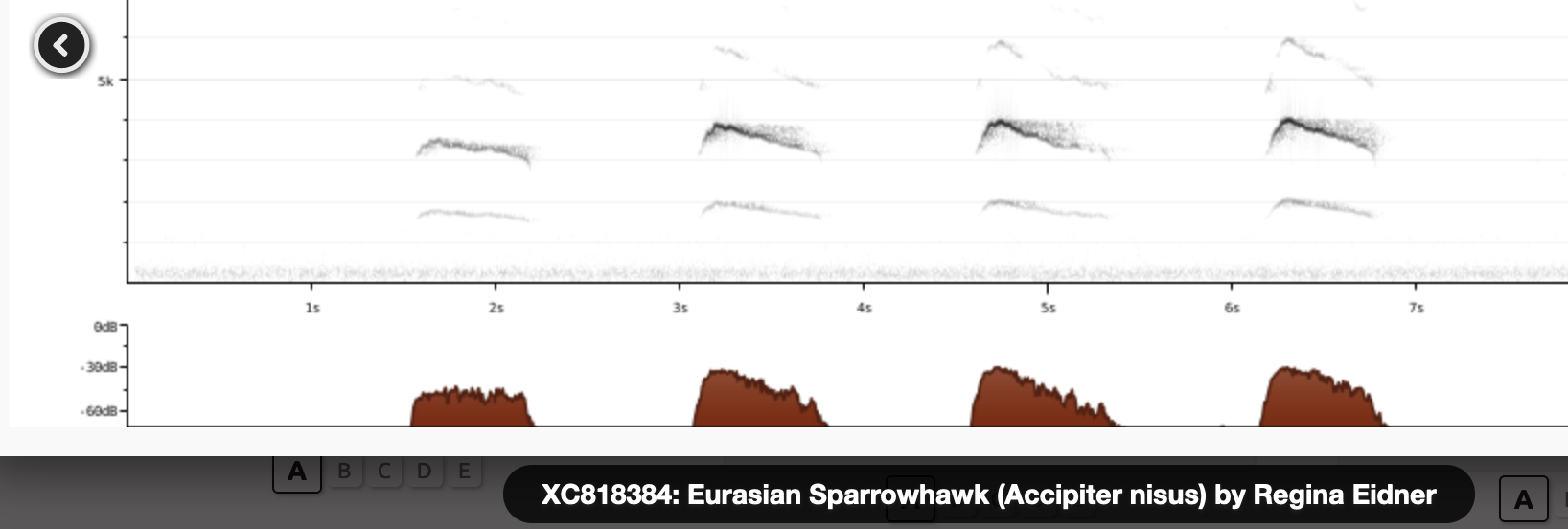
Call attributes:
Frequency: ,
Steinadler. 2022-05-22 12.58.16 Leuk and surroundings
First observed in 🇨🇭 on 2022-05-21.
This bird appears across the great seas in the following continents:
Europe, North America, Africa.
Deutschland: Brut-, Jahresvogel RL 2
Vocalization: ![]() Not very vocal. A short, clear, yelping "kew". Sometimes in series in mellow tempo. [Link]
Not very vocal. A short, clear, yelping "kew". Sometimes in series in mellow tempo. [Link]
Calls: ![]() Also mewing, Buzzard-like calls. [Link]
Also mewing, Buzzard-like calls. [Link]
Physical details: length=75-88 cm,
wingspan=204-220 cm,
weight=2840-6665 g
Habitats:
Agricultural
MerlinBirdID meint Rohrweihe. 2022-05-21 16.00.56 Leuk and surroundings
First observed in 🇨🇭 on 2022-05-21.
General: ![]() The western marsh harrier (Circus aeruginosus) is a large harrier, a bird of prey from temperate and subtropical western Eurasia and adjacent Africa. It is also known as the Eurasian marsh harrier. The genus name Circus is derived from the Ancient Greek kirkos, referring to a bird of prey named for its circling flight (kirkos, "circle"), probably the hen harrier. The specific aeruginosus is Latin for "rusty".[3]
[more]
The western marsh harrier (Circus aeruginosus) is a large harrier, a bird of prey from temperate and subtropical western Eurasia and adjacent Africa. It is also known as the Eurasian marsh harrier. The genus name Circus is derived from the Ancient Greek kirkos, referring to a bird of prey named for its circling flight (kirkos, "circle"), probably the hen harrier. The specific aeruginosus is Latin for "rusty".[3]
[more]
Calls: ![]() Call: A sharp "kwii-uuu" of about a seconds length, rapidly ascending in pitch, and ending on a falling tone. [Link]
Call: A sharp "kwii-uuu" of about a seconds length, rapidly ascending in pitch, and ending on a falling tone. [Link]
Physical details: length=48-56 cm,
wingspan=115-130 cm,
weight=405-800 g
Habitats:
Agricultural
Profile Wikipedia eBird Vogelwarte BirdLife ZH ornitho.ch Xeno-Canto BirdID NABU

Wikipedia: Pallid harrier Source: OTHER
1200px-Pallid_Harrier_Male.jpg
General: ![]() The pale or pallid harrier (Circus macrourus) is a migratory bird of prey of the harrier family. The scientific name is derived from the Ancient Greek. Circus is from kirkos, referring to a bird of prey named for its circling flight (kirkos, "circle"), probably the hen harrier and macrourus is "long-tailed", from makros, "long" and -ouros "-tailed".[2]
[more]
The pale or pallid harrier (Circus macrourus) is a migratory bird of prey of the harrier family. The scientific name is derived from the Ancient Greek. Circus is from kirkos, referring to a bird of prey named for its circling flight (kirkos, "circle"), probably the hen harrier and macrourus is "long-tailed", from makros, "long" and -ouros "-tailed".[2]
[more]
Calls: ![]() Some calls similar to Montagu's and Hen Harrier, but display call quite diagnostic. A thin, vibrating trill "peerrrrrrrr". [Link]
Some calls similar to Montagu's and Hen Harrier, but display call quite diagnostic. A thin, vibrating trill "peerrrrrrrr". [Link]
Physical details: length=40-48 cm,
wingspan=95-120 cm,
weight=300-550 g
Profile Wikipedia eBird Vogelwarte BirdLife ZH ornitho.ch Xeno-Canto NABU
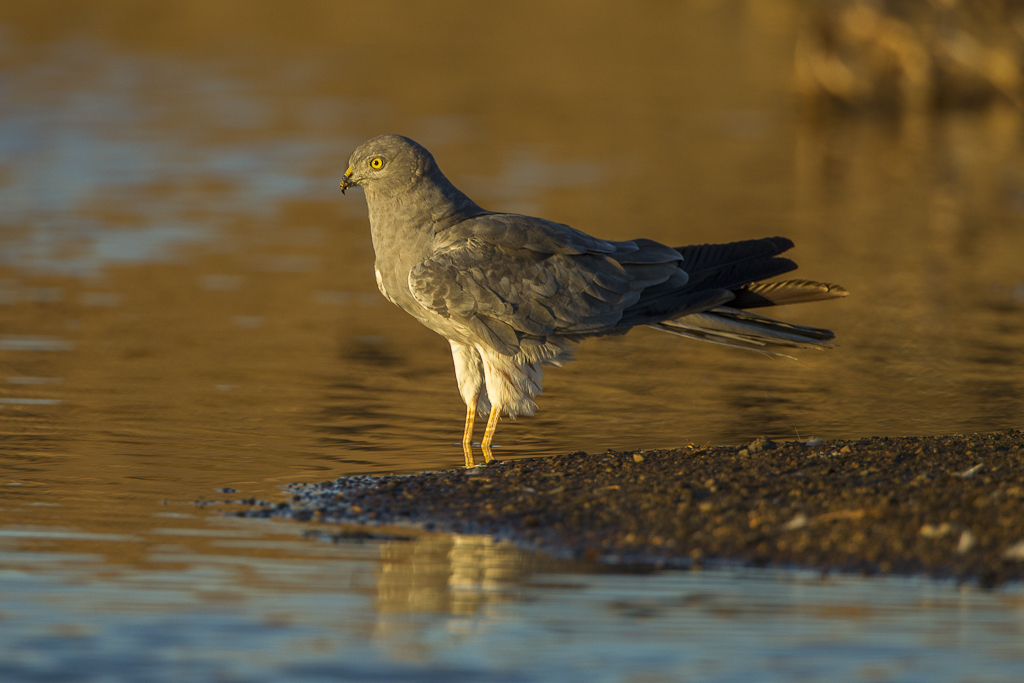
Wikipedia: Montagu's harrier Source: OTHER
Montagu%27s_harrier_%28Circus_pygargus%29.jpg
General: ![]() Montagu's harrier (Circus pygargus) is a migratory bird of prey of the harrier family. Its common name commemorates the British naturalist George Montagu.
[more]
Montagu's harrier (Circus pygargus) is a migratory bird of prey of the harrier family. Its common name commemorates the British naturalist George Montagu.
[more]
Habitats:
Agricultural
Unklares Bild von entfernter Kornweihe beim Kraftwerk neben Albufera. 2022-04-12 13.11.40 Mallorca
First observed in Mallorca on 2022-04-12.
Deutschland: Brut-, Jahres-, Zugvogel, Wintergast RL 1
Vocalization: ![]() Mostly heard at breeding ground. [Link]
Mostly heard at breeding ground. [Link]
Calls: ![]() Calls with quite soft series of "ke-ke-ke-ke". Also a wailing, squealing whistle, with emphasized first syllable. [Link]
Calls with quite soft series of "ke-ke-ke-ke". Also a wailing, squealing whistle, with emphasized first syllable. [Link]
Physical details: length=44-52 cm,
wingspan=100-120 cm,
weight=300-600 g
Habitats:
Agricultural

Wikipedia: Griffon vulture Source: OTHER
1200px-Gypful.jpg
General: ![]() The griffon vulture (Gyps fulvus) is a large Old World vulture in the bird of prey family Accipitridae. It is also known as the Eurasian griffon. It is not to be confused with a different species, Rüppell's griffon vulture (Gyps rueppellii). It is closely related to the white-backed vulture (Gyps africanus).
[more]
The griffon vulture (Gyps fulvus) is a large Old World vulture in the bird of prey family Accipitridae. It is also known as the Eurasian griffon. It is not to be confused with a different species, Rüppell's griffon vulture (Gyps rueppellii). It is closely related to the white-backed vulture (Gyps africanus).
[more]
Vocalization: ![]() Quite vocal for a vulture, but generally silent in flight. Various shrieking high notes, hissing, and harsh cackling sounds. [Link]
Quite vocal for a vulture, but generally silent in flight. Various shrieking high notes, hissing, and harsh cackling sounds. [Link]
Physical details: length=95-105 cm,
wingspan=240-280 cm,
weight=7500-11000 g
Habitats:
Agricultural

Wikipedia: Bearded vulture Source: OTHER
1200px-Bartgeier_Gypaetus_barbatus_front_Richard_Bartz.jpg
General: ![]() The bearded vulture (Gypaetus barbatus), also known as the lammergeier and ossifrage, is a bird of prey and the only member of the genus Gypaetus. This bird is also identified as Huma bird or Homa bird in Iran and north west Asia. Traditionally considered an Old World vulture, it actually forms a minor lineage of Accipitridae together with the Egyptian vulture (Neophron percnopterus), its closest living relative. It is not much more closely related to the Old World vultures proper than to, for example, hawks, and differs from the former by its feathered neck. Although dissimilar, the Egyptian and bearded vulture each have a lozenge-shaped tail—unusual among birds of prey.
[more]
The bearded vulture (Gypaetus barbatus), also known as the lammergeier and ossifrage, is a bird of prey and the only member of the genus Gypaetus. This bird is also identified as Huma bird or Homa bird in Iran and north west Asia. Traditionally considered an Old World vulture, it actually forms a minor lineage of Accipitridae together with the Egyptian vulture (Neophron percnopterus), its closest living relative. It is not much more closely related to the Old World vultures proper than to, for example, hawks, and differs from the former by its feathered neck. Although dissimilar, the Egyptian and bearded vulture each have a lozenge-shaped tail—unusual among birds of prey.
[more]
Calls: ![]() Display call a thin whistling with several register breaks, reminiscent of Honey Buzzard (Pernis apivorus). A passerine-like trill is also sometimes heard, but generally not a vocal bird. [Link]
Display call a thin whistling with several register breaks, reminiscent of Honey Buzzard (Pernis apivorus). A passerine-like trill is also sometimes heard, but generally not a vocal bird. [Link]
Physical details: length=100-115 cm,
wingspan=266-282 cm,
weight=5000-7000 g
Habitats:
Agricultural
Wikipedia: Short-toed snake-eagle Source: OTHER
PikiWiki_Israel_43227_Wildlife_and_Plants_of_Israel.JPG
General: ![]() The short-toed snake eagle (Circaetus gallicus), also known as the short-toed eagle, is a medium-sized bird of prey in the family Accipitridae, which also includes many other diurnal raptors such as kites, buzzards and harriers. The genus name Circaetus is from the Ancient Greek kirkos, a type of hawk, and aetos, "eagle". The specific gallicus means "of Gaul".[3]
[more]
The short-toed snake eagle (Circaetus gallicus), also known as the short-toed eagle, is a medium-sized bird of prey in the family Accipitridae, which also includes many other diurnal raptors such as kites, buzzards and harriers. The genus name Circaetus is from the Ancient Greek kirkos, a type of hawk, and aetos, "eagle". The specific gallicus means "of Gaul".[3]
[more]
Habitats:
Agricultural
Profile Wikipedia eBird Vogelwarte BirdLife ZH ornitho.ch bird-song.ch Xeno-Canto BirdID NABU
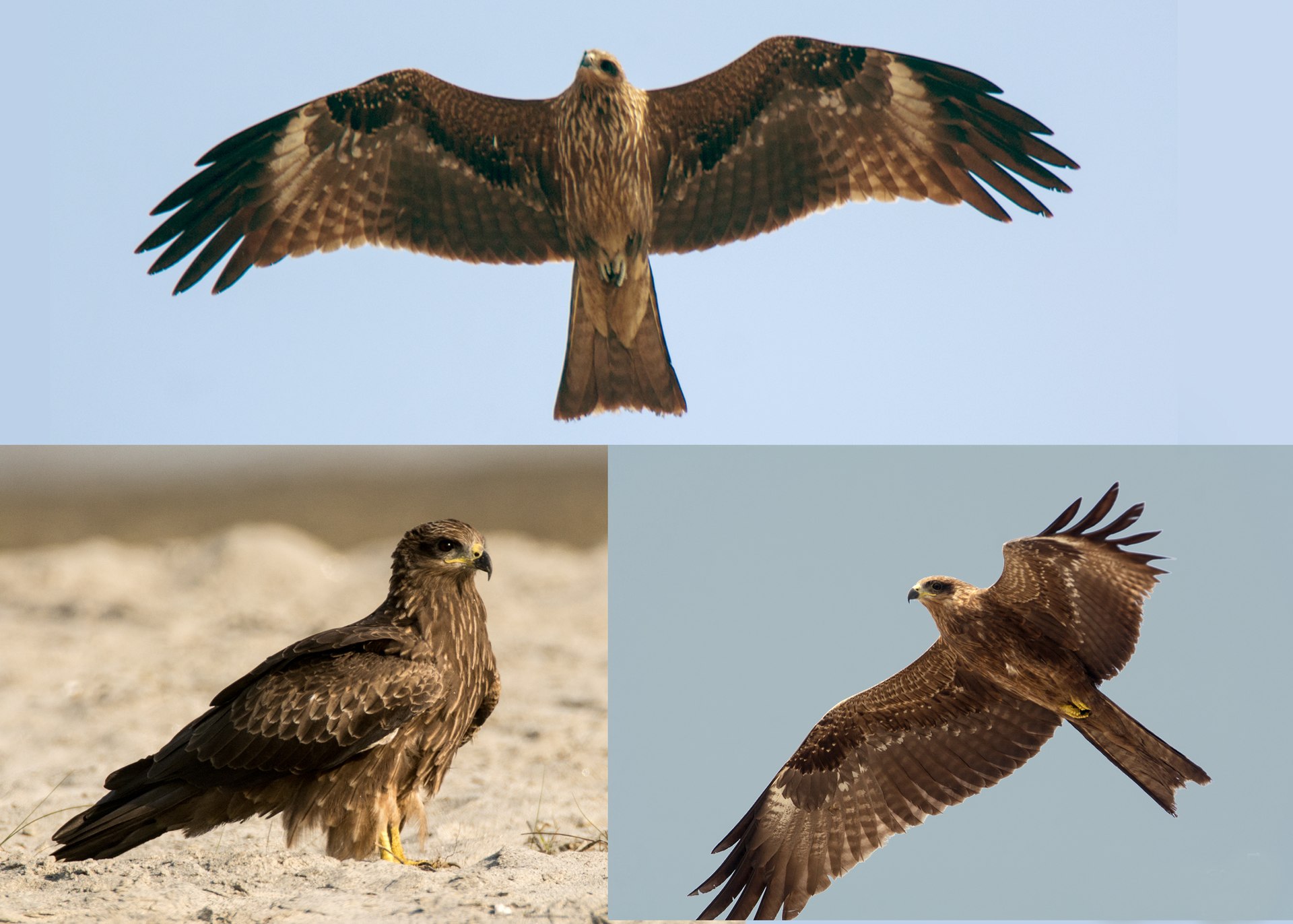
Black kite in the air and on the ground Source: WIKIPEDIA
Wikimedia Black_Kite_(Milvus_migrans).jpg
First observed in 🇨🇭 on 2021-04-03.
This is on my list of birds to find, as it is supposed to be exist in this area,but I've never identified one. Their call (see Vogelwarte link) is a rapid sequence of whistles,
and definitely distinct from that of the red kites.
Visually they are harder to tell apart, but if you look closely, it should be clear:
the black kite has less of a V in its tail and no big white patch at the wingtips.
birdguides.com has a guide to distinguishing black and red kites, and says black are much rarer,
but that is not true in Switzerland -
Vogelwarte.ch says Switzerland has 2800–3500 red kites and 2000-3000 black kites.
Tenatively identified one flying high over Lake Lugano at San Salvatore in Ticino.
Often near water.
Vocalization: ![]() A piercing, first ascending then descending long "piuuu". Starting as a clear tone then gradually taking on a vibrating character that differs from Red Kite. Also a sharp "kieee -ki- ki-ki". More vocal than Red Kite. [Link]
A piercing, first ascending then descending long "piuuu". Starting as a clear tone then gradually taking on a vibrating character that differs from Red Kite. Also a sharp "kieee -ki- ki-ki". More vocal than Red Kite. [Link]
Physical details: length=55-60 cm,
wingspan=160-180 cm,
weight=630-941 g
Habitats:
Agricultural
Call:
Automatically generated from Xeno-Canto recording
♫ Source: BirdNet
20210814_093255 birdnet 1932 - Wild guess was once black kite, check - Not analyzed - Volketswil.mp3
2021-08-14 09.32.55 (song?)
Profile Wikipedia eBird Vogelwarte BirdLife ZH ornitho.ch bird-song.ch Xeno-Canto BirdID NABU
Im Baum am Pfäffikersee 2020-05-20 08.58.48 Pfäffikersee
First observed in 🇨🇭 on 2020-04-13.
Geography: ![]() Very common here in the summer, I've seen up to 30 on a freshly plowed field, and you can seldom look up without seeing one.
(You should look closely though, as they'll often circle in the air with buzzards.)They migrate to Spain in the winter, but increasing numbers stay here.Elsewhere in Europe they've been decreasing, while here they've become so successful that young birds have trouble
finding a territory of their own. Wikipedia mentions them competing with the black kite, which I've never
identified locally, so perhaps that's part of the key to their success. [Link]
Very common here in the summer, I've seen up to 30 on a freshly plowed field, and you can seldom look up without seeing one.
(You should look closely though, as they'll often circle in the air with buzzards.)They migrate to Spain in the winter, but increasing numbers stay here.Elsewhere in Europe they've been decreasing, while here they've become so successful that young birds have trouble
finding a territory of their own. Wikipedia mentions them competing with the black kite, which I've never
identified locally, so perhaps that's part of the key to their success. [Link]
Vocalization: ![]() Mainly heard in breeding season. A piercing long whistle, quickly ascending, then descending "piuuu". Often used in movies to give an eerie wildlife mood. [Link]
Mainly heard in breeding season. A piercing long whistle, quickly ascending, then descending "piuuu". Often used in movies to give an eerie wildlife mood. [Link]
Calls: ![]() Differs from Black Kite in being a clear whistle all the way through the call, without "shivering". Higher pitched than Buzzard, and with less pause between calls. [Link]
Differs from Black Kite in being a clear whistle all the way through the call, without "shivering". Higher pitched than Buzzard, and with less pause between calls. [Link]
Physical details: length=60-66 cm,
wingspan=175-195 cm,
weight=800-1300 g
Habitats:
Agricultural
Call:
Automatically generated from Xeno-Canto recording
♫ Rotmilan. 2020-05-24 16.56.51 Luppmen (song?)
Presence: 01-01 - 12-31
Breeding: 04-10 - 07-28
Migration in: 01-20 - 04-30
Migration out: 08-18 - 11-28

Wikipedia: European honey-buzzard Source: OTHER
1200px-Wespenbussard_European_honey_buzzard_Pernis_apivorus%2C_crop.jpg
General: ![]() The European honey buzzard (Pernis apivorus), also known as the pern or common pern,[2] is a bird of prey in the family Accipitridae.
[more]
The European honey buzzard (Pernis apivorus), also known as the pern or common pern,[2] is a bird of prey in the family Accipitridae.
[more]
Calls: ![]() Call an ascending, then descending; "pjuuuuu" much thinner than buzzards, and with a distinct register break when changing pitch. May be confused with newly fledged Buzzard chicks. [Link]
Call an ascending, then descending; "pjuuuuu" much thinner than buzzards, and with a distinct register break when changing pitch. May be confused with newly fledged Buzzard chicks. [Link]
Physical details: length=52-60 cm,
wingspan=135-150 cm,
weight=360-1050 g
Habitats:
Agricultural
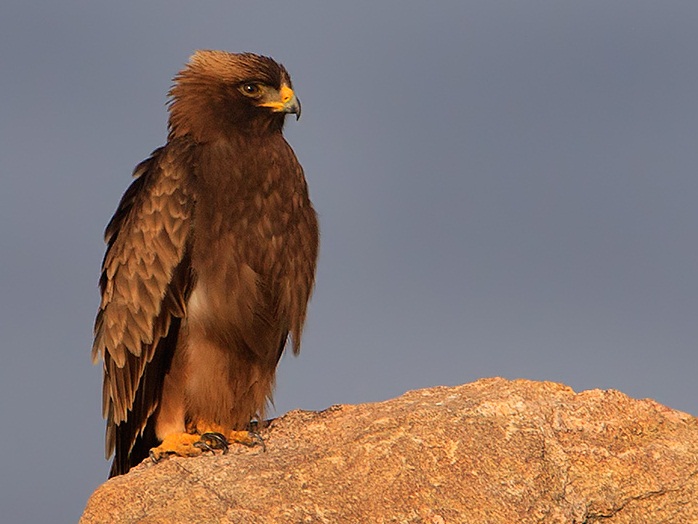
Wikipedia: Booted eagle Source: OTHER
MH_Booted.jpg
General: ![]() The booted eagle (Hieraaetus pennatus, also classified as Aquila pennata) is a medium-sized mostly migratory bird of prey with a wide distribution in the Palearctic and southern Asia, wintering in the tropics of Africa and Asia, with a small, disjunct breeding population in south-western Africa. Like all eagles, it belongs to the family Accipitridae.
[more]
The booted eagle (Hieraaetus pennatus, also classified as Aquila pennata) is a medium-sized mostly migratory bird of prey with a wide distribution in the Palearctic and southern Asia, wintering in the tropics of Africa and Asia, with a small, disjunct breeding population in south-western Africa. Like all eagles, it belongs to the family Accipitridae.
[more]
Vocalization: ![]() Very vocal in breeding season. Most often heard is a quite soft, wader-like series of "kli-kli-kli-kli-kli-kli". [Link]
Very vocal in breeding season. Most often heard is a quite soft, wader-like series of "kli-kli-kli-kli-kli-kli". [Link]
Physical details: length=45-53 cm,
wingspan=100-121 cm,
weight=510-1250 g
Osprey / Fischadler (Pandion haliaetus)
Osprey in flight. 2023-09-27 12.22.08 Florida
First observed in Yucatan on 2023-04-21.
This bird appears across the great seas in the following continents:
Europe, North America, South America, Africa, Asia.
General: ![]() Falco haliaetus Linnaeus, 1758
[more]
Falco haliaetus Linnaeus, 1758
[more]
Calls: ![]() Calls with sequences of short, soft and clear whistling notes. Often in series with rising pitch, then ending with a few lower pitched notes. [Link]
Calls with sequences of short, soft and clear whistling notes. Often in series with rising pitch, then ending with a few lower pitched notes. [Link]
Physical details: length=55-58 cm,
wingspan=145-170 cm,
weight=1120-2050 g
Habitats:
Agricultural
Call:
Automatically generated from Xeno-Canto recording
♫ 2023-10-12 15 55 surprising sound of an osprey. 2023-10-12 15.55.00 New England (song?)
Stork in field towards Mesikon 2020-04-25 07.19.22 Luppmen
First observed in 🇨🇭 on 2020-04-25.
New as frequent visitor in Fehraltorf area in the 2010's. It actually died out in Switzerland in the 1950's, but has reestablished itself.
Either in the fields looking for food, or on a high output like a lamppost
(the soccer field has especially high ones) or the chimneys at the RAV/Electrosuisse building or occasinally
a rooftop.
Vocalization: ![]() Mostly silent. Loud, modulated bill-clattering from both sexes is heard during courtship/display. [Link]
Mostly silent. Loud, modulated bill-clattering from both sexes is heard during courtship/display. [Link]
Physical details: length=100-115 cm,
wingspan=155-165 cm,
weight=2275-4400 g
Habitats:
Wetland
Song:
The famous Klappern.
Song attributes:
Melody: non-musical, slow, Frequency: low (1-3 KHz) Special sounds: rattle
Call:
Automatically generated from Xeno-Canto recording
♫ Source: BirdNet
20200520_085006 birdnet 521 - White stork.mp3
2020-05-20 08.50.06 Luppmen (song?)
Profile Wikipedia eBird Vogelwarte BirdLife ZH ornitho.ch Xeno-Canto BirdID NABU
![]()
Wikipedia: Black stork Source: OTHER
1200px-Ciconia_nigra_-Kruger_National_Park-8.jpg
General: ![]() The black stork (Ciconia nigra) is a large bird in the stork family Ciconiidae. It was first described by Carl Linnaeus in the 10th edition of his Systema Naturae. Measuring on average 95 to 100 cm (37 to 39 in) from beak tip to end of tail with a 145-to-155 cm (57-to-61 in) wingspan, the adult black stork has mainly black plumage, with white underparts, long red legs and a long pointed red beak. A widespread but uncommon species, it breeds in scattered locations across Europe (predominantly in Portugal and Spain, and central and eastern parts), and east across the Palearctic to the Pacific Ocean. It is a long-distance migrant, with European populations wintering in tropical Sub-Saharan Africa, and Asian populations in the Indian subcontinent. When migrating between Europe and Africa, it avoids crossing the Mediterranean Sea and detours via the Levant in the east or the Strait of Gibraltar in the west. An isolated, non-migratory, population occurs in Southern Africa.
[more]
The black stork (Ciconia nigra) is a large bird in the stork family Ciconiidae. It was first described by Carl Linnaeus in the 10th edition of his Systema Naturae. Measuring on average 95 to 100 cm (37 to 39 in) from beak tip to end of tail with a 145-to-155 cm (57-to-61 in) wingspan, the adult black stork has mainly black plumage, with white underparts, long red legs and a long pointed red beak. A widespread but uncommon species, it breeds in scattered locations across Europe (predominantly in Portugal and Spain, and central and eastern parts), and east across the Palearctic to the Pacific Ocean. It is a long-distance migrant, with European populations wintering in tropical Sub-Saharan Africa, and Asian populations in the Indian subcontinent. When migrating between Europe and Africa, it avoids crossing the Mediterranean Sea and detours via the Levant in the east or the Strait of Gibraltar in the west. An isolated, non-migratory, population occurs in Southern Africa.
[more]
Vocalization: ![]() Thin, disyllabic "ahhh-li" heard at nest and when courting. One syllable sounds like gasping intake of air, the other is a thin, piping sound. A bit like a cheap, manual, air-mattress pump. Bill-clattering used by juveniles in alarm. [Link]
Thin, disyllabic "ahhh-li" heard at nest and when courting. One syllable sounds like gasping intake of air, the other is a thin, piping sound. A bit like a cheap, manual, air-mattress pump. Bill-clattering used by juveniles in alarm. [Link]
Physical details: length=95-100 cm,
wingspan=145-155 cm,
weight=3000 g
Habitats:
Wetland
Taube. 2020-04-11 08.25.00 Luppmen
First observed in 🇨🇭 on 2020-04-18.
Song: ![]() Gu-guh-guh-guh guh-gugugu –gu. „ Hansruedi wo geisch hi, ga Thun, was ga mache, ga Mähl hole, wiviel, es mutt“
[Link]
Gu-guh-guh-guh guh-gugugu –gu. „ Hansruedi wo geisch hi, ga Thun, was ga mache, ga Mähl hole, wiviel, es mutt“
[Link]
![]() Song a 5 syllable cooing phrase, with emphasis on first syllable (1.st also higher pitched). Fift syllable functions as an introduction to next phrase. [Link]
Song a 5 syllable cooing phrase, with emphasis on first syllable (1.st also higher pitched). Fift syllable functions as an introduction to next phrase. [Link]
Calls: Other: Usual call has 5 coos: 2+1+2, contrasted with the collared dove's 3 = 2+1 [Link]
Physical details: length=40-42 cm,
wingspan=75-80 cm,
weight=284-614 g
Habitats:
Forest
Call:
Automatically generated from Xeno-Canto recording
♫ Source: BirdNet
20200418_073258 birdnet - Common wood pigeon.mp3
2020-04-18 07.32.58 Luppmen (song?)
Profile Wikipedia eBird Vogelwarte BirdLife ZH ornitho.ch Xeno-Canto BirdID NABU
Hohltaube bei Maienfeld. 2021-05-29 11.42.52 Maienfeld
First observed in 🇨🇭 on 2021-05-29.
General: ![]() The stock dove (Columba oenas) is a species of bird in the family Columbidae, the doves and pigeons. It is widely distributed in the western Palearctic.
[more]
The stock dove (Columba oenas) is a species of bird in the family Columbidae, the doves and pigeons. It is widely distributed in the western Palearctic.
[more]
Song: ![]() „Huuh-hup“ . Das „huuh“ fast zweisilbig, erste Silbe höher, das „hup“ noch höher. Fast wie „Hooh ruck“
[Link]
„Huuh-hup“ . Das „huuh“ fast zweisilbig, erste Silbe höher, das „hup“ noch höher. Fast wie „Hooh ruck“
[Link]
![]() Song a two-syllable, cooing. Much louder and more accentuated first syllable than in Feral Pigeon. First a short ascending "oooh", immediately followed by a short descending "oohh". Tone quite pure, mostly lacking the rolling quality of Feral Pigeon. [Link]
Song a two-syllable, cooing. Much louder and more accentuated first syllable than in Feral Pigeon. First a short ascending "oooh", immediately followed by a short descending "oohh". Tone quite pure, mostly lacking the rolling quality of Feral Pigeon. [Link]
Calls: ![]() Nur noch sehr selten zu hören!
[Link]
Nur noch sehr selten zu hören!
[Link]
Physical details: length=32-34 cm,
wingspan=63-69 cm,
weight=250-350 g
Habitats:
Forest
Didn't recognize this collared dove ...so I annotated it with the characteristics I should have recognized 2021-02-01 13.14.42 Luppmen
First observed in 🇨🇭 on 2020-05-21.
This bird appears across the great seas in the following continents:
Europe, North America (introduced), Africa, Asia (introduced).
General: ![]() The Eurasian collared dove (Streptopelia decaocto) is a dove species native to Europe and Asia; it was introduced to Japan, North America and islands in the Caribbean. Because of its vast global range and increasing population trend, it has been listed as Least Concern on the IUCN Red List since 2014.[1]
[more]
The Eurasian collared dove (Streptopelia decaocto) is a dove species native to Europe and Asia; it was introduced to Japan, North America and islands in the Caribbean. Because of its vast global range and increasing population trend, it has been listed as Least Concern on the IUCN Red List since 2014.[1]
[more]
Song: ![]() Gu-guh-gu, klingt wie „ Gross-mue-ti“ Dazu auch „chräi“ oder „chwii“
[Link]
Gu-guh-gu, klingt wie „ Gross-mue-ti“ Dazu auch „chräi“ oder „chwii“
[Link]
![]() Song a characteristic, rhythmic cooing, consisting of three syllables with emphasis on the second. The third lower pitched than the rest. Can be rendered as "su-do-ku" (or "deca-oc-to", latin name derived from song). [Link]
Song a characteristic, rhythmic cooing, consisting of three syllables with emphasis on the second. The third lower pitched than the rest. Can be rendered as "su-do-ku" (or "deca-oc-to", latin name derived from song). [Link]
Calls: ![]() Excitement-call a nasal "wrrraa". [Link]
Excitement-call a nasal "wrrraa". [Link]
Physical details: length=31-33 cm,
wingspan=47-55 cm,
weight=170-240 g
Habitats:
Settlement
Call:
Automatically generated from Xeno-Canto recording
♫ Türkentaube. 2020-05-21 07.45.50 Luppmen (song?)
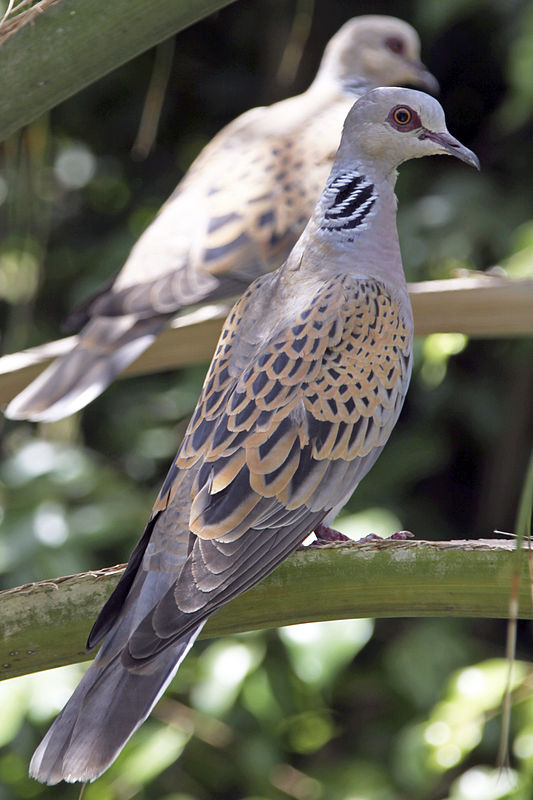
Wikipedia European Turtle Dove (Streptopelia turtur). Source: WIKIPEDIA
Wikipedia European_Turtle_Dove_(Streptopelia_turtur).jpg
First observed in 🇨🇭 on 2023-06-19.
General: ![]() Die Turteltaube (Streptopelia turtur) ist eine Vogelart aus der Familie der Tauben. Das Verbreitungsgebiet umfasst weite Teile der westlichen und zentralen Paläarktis und reicht vom nördlichen Afrika, der iberischen Halbinsel und Großbritannien nach Osten über den Nahen und Mittleren Osten bis Nordwestchina und in die Mongolei. Im Mittelmeerraum ist die Turteltaube besonders häufig. Nach einer im Jahr 2007 veröffentlichten Studie der EU ist ihr Bestand jedoch in den letzten 25 Jahren um 62 Prozent zurückgegangen.[1] Der Bestandsrückgang wird auf veränderte landwirtschaftliche Anbaumethoden und den Rückgang der Erdraucharten zurückgeführt, die bei der Ernährung der Turteltauben eine große Rolle spielen. Zu den für den Bestandsrückgang verantwortlichen Faktoren gehört aber auch der Abschuss der Tauben insbesondere im Mittelmeerraum während der Zugzeiten.
[more]
Die Turteltaube (Streptopelia turtur) ist eine Vogelart aus der Familie der Tauben. Das Verbreitungsgebiet umfasst weite Teile der westlichen und zentralen Paläarktis und reicht vom nördlichen Afrika, der iberischen Halbinsel und Großbritannien nach Osten über den Nahen und Mittleren Osten bis Nordwestchina und in die Mongolei. Im Mittelmeerraum ist die Turteltaube besonders häufig. Nach einer im Jahr 2007 veröffentlichten Studie der EU ist ihr Bestand jedoch in den letzten 25 Jahren um 62 Prozent zurückgegangen.[1] Der Bestandsrückgang wird auf veränderte landwirtschaftliche Anbaumethoden und den Rückgang der Erdraucharten zurückgeführt, die bei der Ernährung der Turteltauben eine große Rolle spielen. Zu den für den Bestandsrückgang verantwortlichen Faktoren gehört aber auch der Abschuss der Tauben insbesondere im Mittelmeerraum während der Zugzeiten.
[more]
Song: ![]() Song: a deep, rolling, and slightly ascending cooing; "trrrrrrrrrrrrrrrrr trrr-trrrr" with variations in rhythm. Sometimes birds sticks to a phrase, but phrases varies between individuals. [Link]
Song: a deep, rolling, and slightly ascending cooing; "trrrrrrrrrrrrrrrrr trrr-trrrr" with variations in rhythm. Sometimes birds sticks to a phrase, but phrases varies between individuals. [Link]
Physical details: length=26-28 cm,
wingspan=47-53 cm,
weight=100-180 g
Habitats:
Forest
Song:
Trilling coo.
Song attributes:
Melody: one note, slow, Frequency: low (1-3 KHz)
Call:
Automatically generated from Xeno-Canto recording
♫ XC728296 - European Turtle Dove - Streptopelia turtur. Source: XENOCANTO
XC728296 - European Turtle Dove - Streptopelia turtur.mp3
(song?)
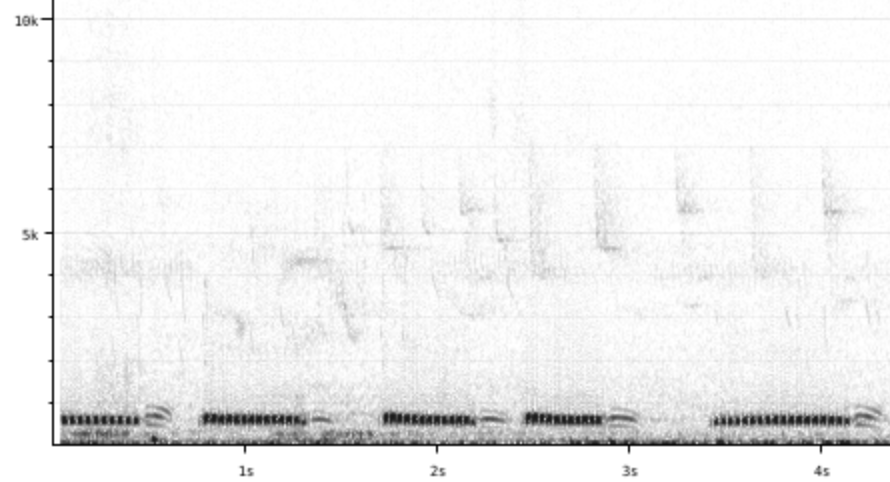
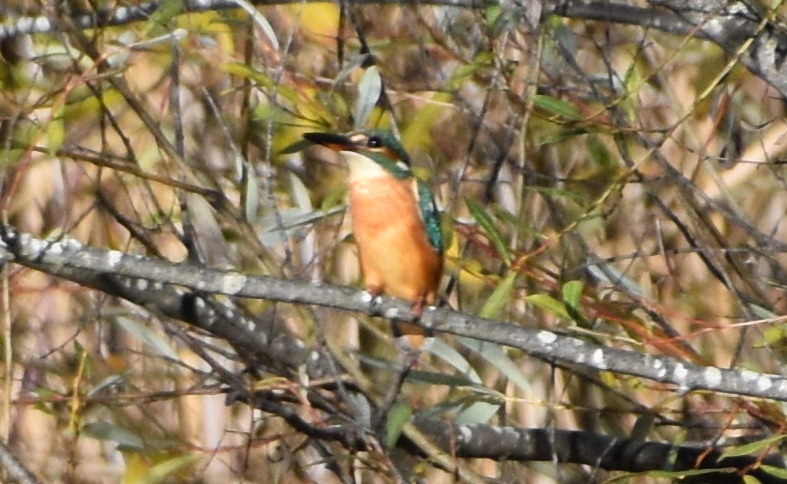
Eisvogel beim Pfaeffikersee Ein paar sind im Herbst und Winter am Meteorwasserkanal nahe Schellenberger Textil zu sehen. 2020-11-17 10.57.56 Pfäffikersee
First observed in 🇨🇭 on 2020-10-08.
This is a favorite bird in Switzerland. On the one hand it's colorful and very active when seen
in its hunting grounds at a waterway; on the other hand, it's seldom seen. Contrast the 400-500 breeding
pairs with 400,000-550,000 of the everpresent great tits.
An apprentice for the nature center on Lake Pfaeffikon told us a bit
about the kingfishers that hunt on a waterway that feeds into the lake.
She said they spend the breeding season elsewhere in sandy areas and return to the lake
in fall. I've read elsewhere that they watch for fish from convenient waterside branches.
A classic motif for a picture is a branch sticking out of the water, and one photographer
said he has actually placed a branch there, knowing the kingfisher would not be able to resist.
Etymology: Nabu: Ob der Name des Eisvogels (Alcedo atthis) tatsächlich mit Eis zu tun hat oder das eisblaue Rückengefieder Pate stand, ist strittig. Manche Deutungen leiten den Namen vom althochdeutschen „eisan“ für „schillern“ oder „glänzen“ ab. Der „Schillervogel“ wäre eine gute Beschreibung für das flirrende Farbenspiel, das der Eisvogel im Sitzen und erst recht im Flug bietet. Wieder andere Autoren interpretieren den „Eisvogel“ als „Eisenvogel“ und vermuten einen Bezug auf das stahlblaue Rücken- oder das rostfarbene Bauchgefieder des Eisvogels. [Link]
Seasonal Behavior: ![]() Status (in CH): regelmässiger, spärlicher Brutvogel, Durchzügler und Wintergast. [Link]
Status (in CH): regelmässiger, spärlicher Brutvogel, Durchzügler und Wintergast. [Link]
Calls: ![]() Wikipedia says 'The common kingfisher has no song.
The flight call is a short, sharp whistle chee repeated two or three times. Anxious birds emit a harsh, shrit-it-it and nestlings call for food with a churring noise.'
The NABU app only has calls,
which seems to confirm this. Therefore I'm classifying all recordings as calls,
even though some say Song at Xeno-Canto. [Link]
Wikipedia says 'The common kingfisher has no song.
The flight call is a short, sharp whistle chee repeated two or three times. Anxious birds emit a harsh, shrit-it-it and nestlings call for food with a churring noise.'
The NABU app only has calls,
which seems to confirm this. Therefore I'm classifying all recordings as calls,
even though some say Song at Xeno-Canto. [Link]
![]() Most heard is the thin and penetrating contact call: A short "tzee", or disyllabic "tzee-tzu", with a ringing metallic quality. In excitement it is often alternated with ringing trills "tzeerrrrrrrrrr". [Link]
Most heard is the thin and penetrating contact call: A short "tzee", or disyllabic "tzee-tzu", with a ringing metallic quality. In excitement it is often alternated with ringing trills "tzeerrrrrrrrrr". [Link]
Physical details: length=16-17 cm,
wingspan=24-26 cm,
weight=34-46 g
Habitats:
Wetland
Song:
Automatically generated from Xeno-Canto recording
Song attributes:
Frequency:
♫ XC839045 - Common Kingfisher - Alcedo atthis - song - Viana do Castelo, Portugal. Source: XENOCANTO
XC839045 - Common Kingfisher - Alcedo atthis - song - Viana do Castelo, Portugal.mp3
Portugal (song)
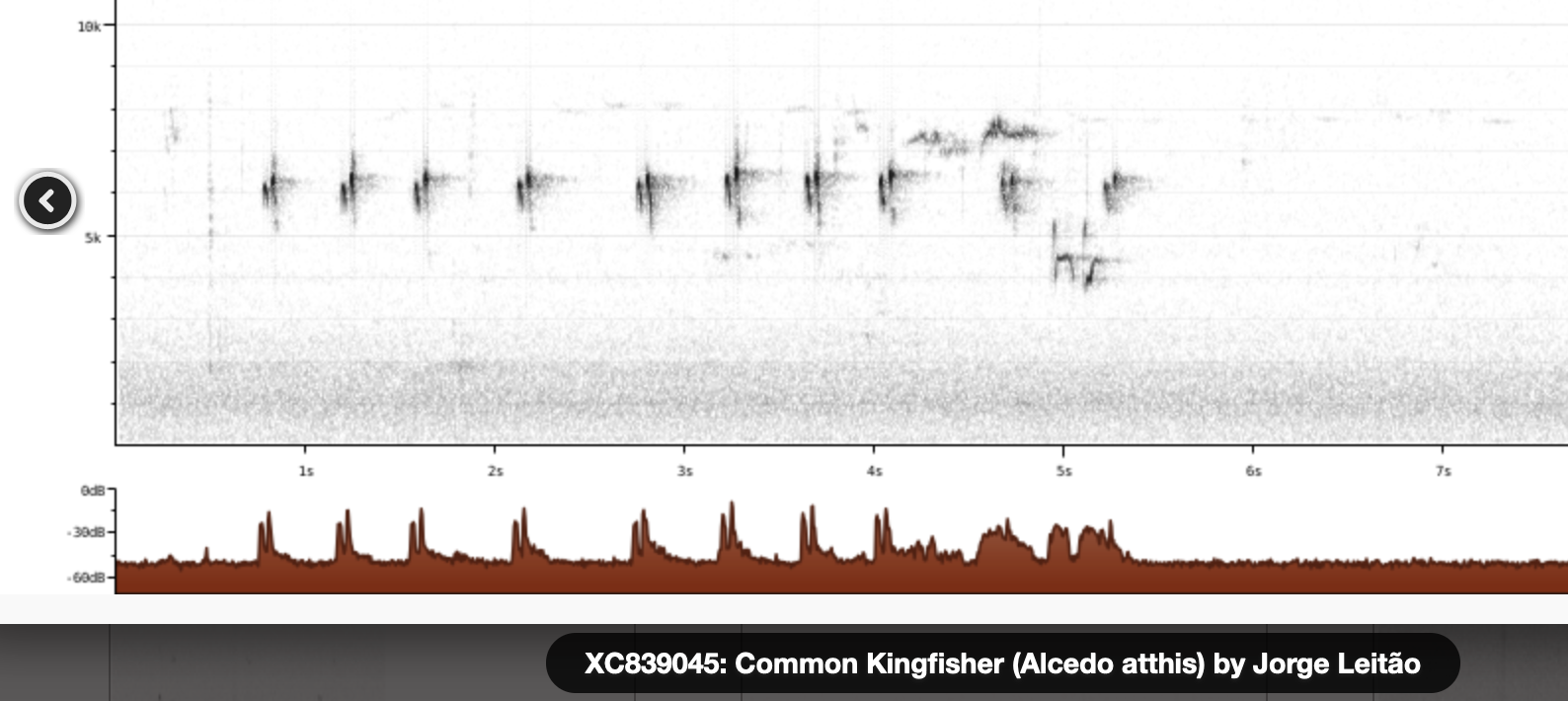
Call:
Common kingfisher call from Xeno-Canto, similar to one from NABU app.
Fairly high pitched single chirps or occasional high-low pairs.
Call from Xeno-Canto
♫ Call from Xeno-Canto Source: XENOCANTO
XC511677 Common kingfisher call similar to one from NABU app.mp3
(call)

Call attributes:
Call melody: one note, slow, Frequency: 5-7 KHz,

Wikipedia: European roller Source: OTHER
1200px-Arrival_%2847961559816%29.jpg
General: ![]() The European roller (Coracias garrulus) is the only member of the roller family of birds to breed in Europe. Its overall range extends into the Middle East, Central Asia and Morocco.
[more]
The European roller (Coracias garrulus) is the only member of the roller family of birds to breed in Europe. Its overall range extends into the Middle East, Central Asia and Morocco.
[more]
Vocalization: ![]() Various dry rasping, sometimes mewing, sounds and short clicks: "ahrahrahrahrahrahrahr" or pulse of clicks: "trrrtrrrrtrr". Also a clearer raptor- or jay-like descending "piiuu". [Link]
Various dry rasping, sometimes mewing, sounds and short clicks: "ahrahrahrahrahrahrahr" or pulse of clicks: "trrrtrrrrtrr". Also a clearer raptor- or jay-like descending "piiuu". [Link]
Physical details: length=30-32 cm,
wingspan=66-73 cm,
weight=120-160 g
Bienenfresser. 2022-05-21 12.53.36 Leuk and surroundings
First observed in 🇨🇭 on 2022-05-21.
Hoped to hear it and especially see it in Maienfeld (Kulturland-Exkursion) but didn't. It'll show up in Leuk in 2022!
Habitats:
Agricultural
Song:
BirdID says multi-syllabic, rolling phrases, although it often seems to be one syllable as well. Hope to hear it and especially see it in Maienfeld.
Song attributes:
Melody: simple rhythmic, slow, Frequency: medium (1-5 KHz)
Profile Wikipedia eBird Vogelwarte BirdLife ZH ornitho.ch bird-song.ch Audubon AllAboutBirds Xeno-Canto BirdID NABU
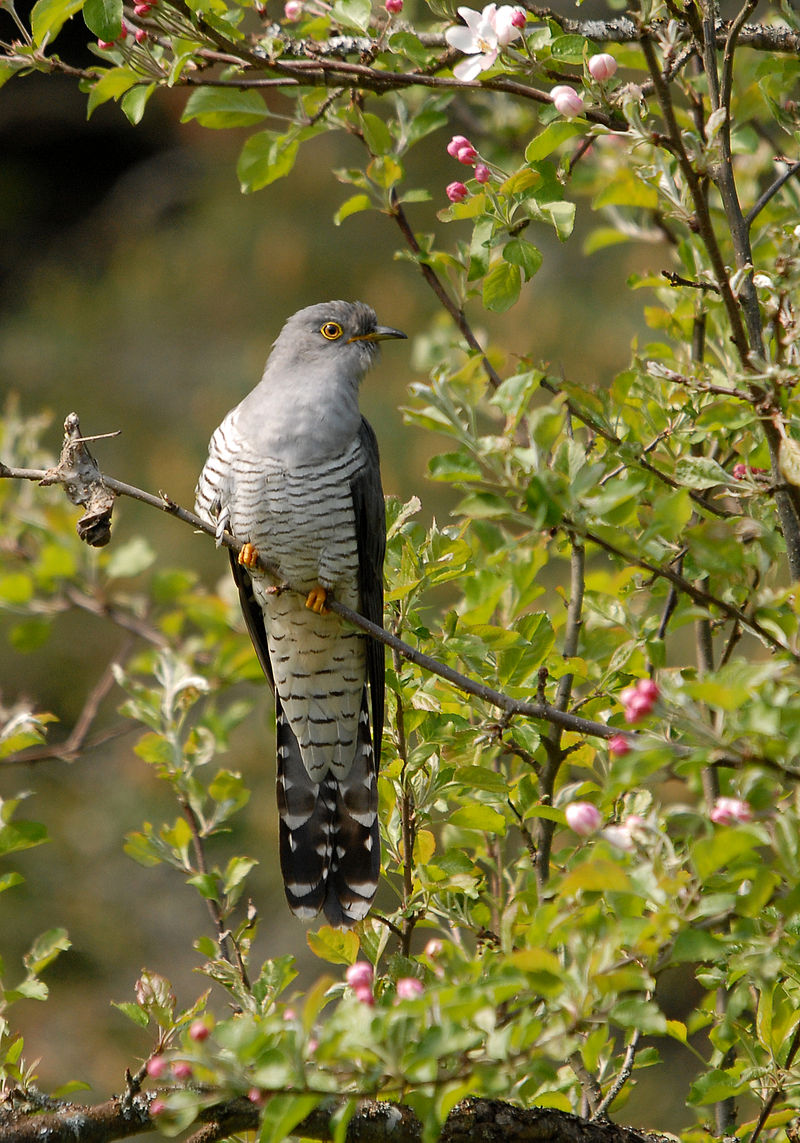
Wikipedia Kuckuck, Cuculus canorus. Von Locaguapa - Eigenes Werk, CC BY-SA 3.0, Link Source: WIKIPEDIA
Wikipedia Kuckuck, Cuculus canorus.jpg
First observed in 🇨🇭 on 2021-05-04.
This bird appears across the great seas in the following continents:
Europe, North America, Africa.
Geography: ![]() A common migratory bird across most of Europe and Asia, it regularly strays to the western Alaskan islands in late spring and early summer. [Link]
A common migratory bird across most of Europe and Asia, it regularly strays to the western Alaskan islands in late spring and early summer. [Link]
Song: ![]() Männchen: Unverwechselbarer Ruf. Weibchen: im Frühling eine kichernde Rufreihe,
[Link]
Männchen: Unverwechselbarer Ruf. Weibchen: im Frühling eine kichernde Rufreihe,
[Link]
![]() Song: the well known disyllabic "cuck-coo" with emphasis on first note, and the second note a third lower than the first one. Also a harsh "tchaa tchaa", and a bubbly trill, reminiscent of Little Grebe, uttered by the female. [Link]
Song: the well known disyllabic "cuck-coo" with emphasis on first note, and the second note a third lower than the first one. Also a harsh "tchaa tchaa", and a bubbly trill, reminiscent of Little Grebe, uttered by the female. [Link]
Calls: ![]() wie „kwickkwickkwick“, 6-8 dicht gereihte, fast metallisch klingende Laute, von unten her angeschlagen. Jungkuckucke betteln durchdringend „ssrieb“
[Link]
wie „kwickkwickkwick“, 6-8 dicht gereihte, fast metallisch klingende Laute, von unten her angeschlagen. Jungkuckucke betteln durchdringend „ssrieb“
[Link]
Physical details: length=32-34 cm,
wingspan=55-60 cm,
weight=95-140 g
Habitats:
Forest
Song:
Two-noter
Song attributes:
Melody: simple rhythmic, slow, Frequency: 0-1 KHz
Call:
Automatically generated from Xeno-Canto recording
♫ XC801215 - Common Cuckoo - Cuculus canorus. Source: XENOCANTO
XC801215 - Common Cuckoo - Cuculus canorus.mp3
(song?)
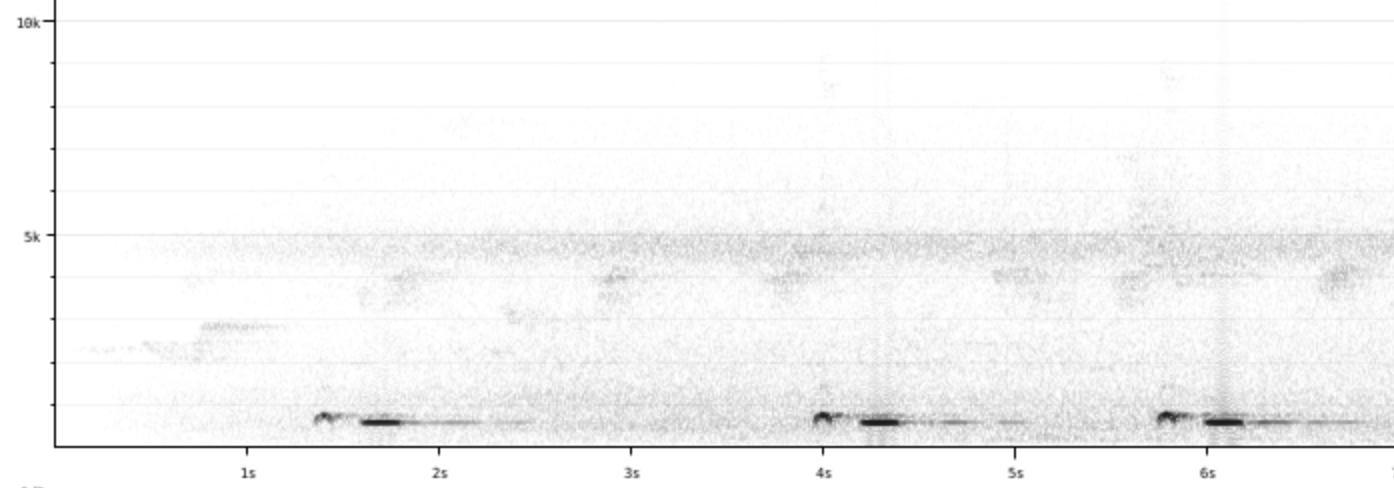
Flying by Pfäffikon 2020-04-24 12.12.44 Luppmen
First observed in 🇨🇭 on 2020-04-24.
Oft seen in the fields around Fehraltorf, flapping away to stay in place.
Calls: ![]() Turmfalke kann auch wie einen Specht tönen, scharf und relativ hoch [Link]
Turmfalke kann auch wie einen Specht tönen, scharf und relativ hoch [Link]
![]() Most common call a fast series of short, high-pitched "ke-ke-ke". Much less raucous than Merlin or Peregrine. [Link]
Most common call a fast series of short, high-pitched "ke-ke-ke". Much less raucous than Merlin or Peregrine. [Link]
Physical details: length=32-35 cm,
wingspan=71-80 cm,
weight=156-252 g
Habitats:
Agricultural
Call:
Automatically generated from Xeno-Canto recording
♫ Source: BirdNet
20210421_092214 birdnet 1466 - Eurasian Kestrel uncertain - Eurasian Kestrel - Pf=C3=A4ffikon.mp3
2021-04-21 09.22.14 Pfäffikersee (song?)
Profile Wikipedia eBird Vogelwarte BirdLife ZH ornitho.ch Xeno-Canto NABU

Wikipedia: Red-footed falcon Source: OTHER
Falco_vespertinus_3_%28Martin_Mecnarowski%29.jpg
General: ![]() The red-footed falcon (Falco vespertinus), formerly the western red-footed falcon, is a bird of prey. It belongs to the family Falconidae, the falcons. This bird is found in eastern Europe and Asia although its numbers are dwindling rapidly due to habitat loss and hunting. It is migratory, wintering in Africa. It is a regular wanderer to western Europe, and in August 2004 a red-footed falcon was found in North America for the first time on the island of Martha's Vineyard, Massachusetts.[2]
[more]
The red-footed falcon (Falco vespertinus), formerly the western red-footed falcon, is a bird of prey. It belongs to the family Falconidae, the falcons. This bird is found in eastern Europe and Asia although its numbers are dwindling rapidly due to habitat loss and hunting. It is migratory, wintering in Africa. It is a regular wanderer to western Europe, and in August 2004 a red-footed falcon was found in North America for the first time on the island of Martha's Vineyard, Massachusetts.[2]
[more]
Habitats:
Agricultural
Profile Wikipedia eBird Vogelwarte BirdLife ZH ornitho.ch Xeno-Canto BirdID NABU
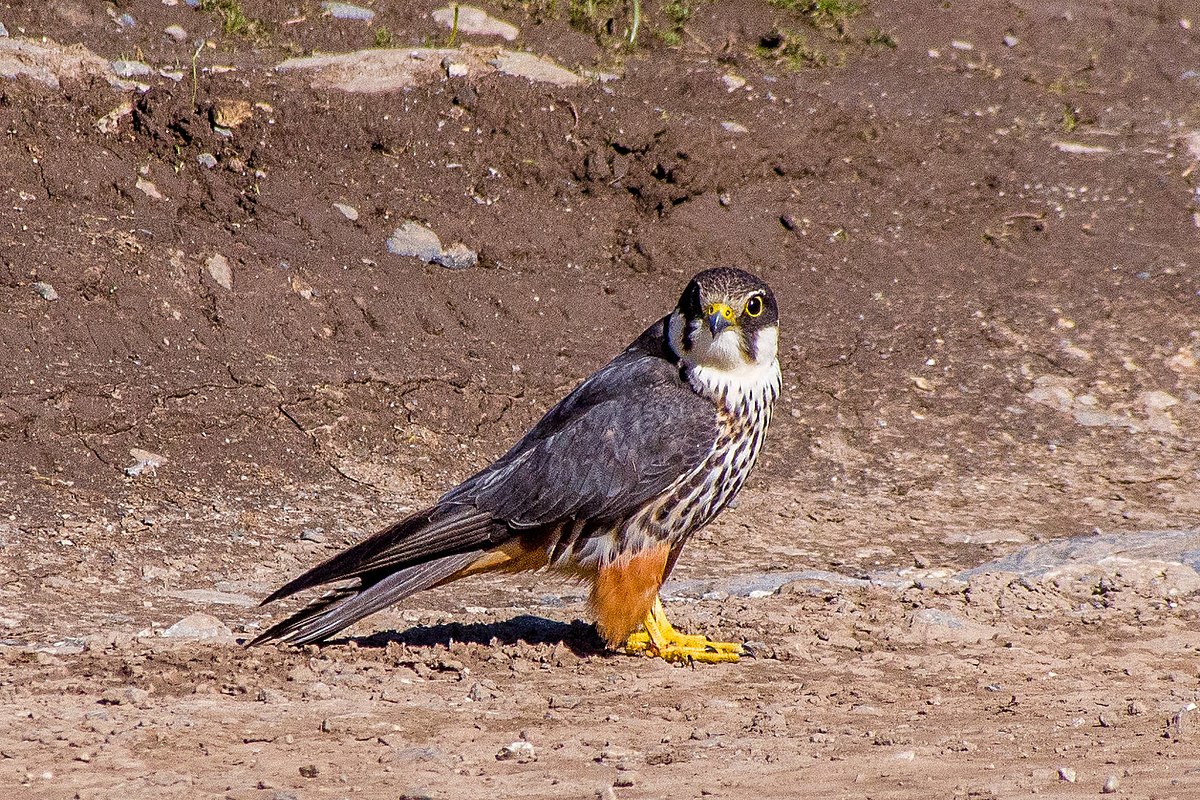
Wikipedia: Eurasian hobby Source: OTHER
1200px-Eurasian_Hobby_%2814574008925%29_%28cropped%29.jpg
![]() The Eurasian hobby (Falco subbuteo) or just simply hobby, is a small, slim falcon. It belongs to a rather close-knit group of similar falcons often considered a subgenus Hypotriorchis.[2][3][4]
[more]
The Eurasian hobby (Falco subbuteo) or just simply hobby, is a small, slim falcon. It belongs to a rather close-knit group of similar falcons often considered a subgenus Hypotriorchis.[2][3][4]
[more]
Vocalization: ![]() Varied, but not very vocal. [Link]
Varied, but not very vocal. [Link]
Calls: ![]() Calls when courting and at breeding ground. Most common sound a high-pitched "tew-tew-tew". Similar to Wryneck, but less pleading. Also a sneezing "ktcho". [Link]
Calls when courting and at breeding ground. Most common sound a high-pitched "tew-tew-tew". Similar to Wryneck, but less pleading. Also a sneezing "ktcho". [Link]
Physical details: length=30-36 cm,
wingspan=82-92 cm,
weight=131-340 g
Habitats:
Agricultural
Call:
Automatically generated from Xeno-Canto recording
♫ Source: BirdNet
20200507_131403 birdnet 488 BirdNet guesses eurasian hobby or eurasian jay - No confident detection.mp3
2020-05-07 13.14.03 Hungerseeli (song?)

Wikipedia: Peregrine falcon Source: OTHER
Falco_peregrinus_good_-_Christopher_Watson.jpg
This bird appears across the great seas in the following continents:
Europe, North America, South America, Africa, Asia.
General: ![]() The peregrine falcon (Falco peregrinus), also known as the peregrine,[2] and historically as the duck hawk in North America,[3] is a widespread bird of prey (raptor) in the family Falconidae. A large, crow-sized falcon, it has a blue-grey back, barred white underparts, and a black head. The peregrine is renowned for its speed, reaching over 320 km/h (200 mph) during its characteristic hunting stoop (high-speed dive),[4] making it the fastest bird in the world, as well as the fastest member of the animal kingdom.[5][6][7] According to a National Geographic TV program, the highest measured speed of a peregrine falcon is 389 km/h (242 mph).[8][9] As is typical for bird-eating raptors, peregrine falcons are sexually dimorphic, with females being considerably larger than males.[10][11]
[more]
The peregrine falcon (Falco peregrinus), also known as the peregrine,[2] and historically as the duck hawk in North America,[3] is a widespread bird of prey (raptor) in the family Falconidae. A large, crow-sized falcon, it has a blue-grey back, barred white underparts, and a black head. The peregrine is renowned for its speed, reaching over 320 km/h (200 mph) during its characteristic hunting stoop (high-speed dive),[4] making it the fastest bird in the world, as well as the fastest member of the animal kingdom.[5][6][7] According to a National Geographic TV program, the highest measured speed of a peregrine falcon is 389 km/h (242 mph).[8][9] As is typical for bird-eating raptors, peregrine falcons are sexually dimorphic, with females being considerably larger than males.[10][11]
[more]
Vocalization: ![]() A harsh, drawn out "kiaaaa" with emphasised endings repeated in series. Much slower than Merlin, but higher pitched than Gyrfalcon. [Link]
A harsh, drawn out "kiaaaa" with emphasised endings repeated in series. Much slower than Merlin, but higher pitched than Gyrfalcon. [Link]
Calls: ![]() Also shorter, coarse warning-calls. [Link]
Also shorter, coarse warning-calls. [Link]
Physical details: length=36-48 cm,
wingspan=95-110 cm,
weight=582-1300 g
Habitats:
Agricultural

Merlin SoundID bird list. Source: OTHER
Merlin SoundID bird list.jpg
This bird appears across the great seas in the following continents:
Europe, North America, South America, Africa.
Deutschland: Zugvogel, Wintergast
Vocalization: ![]() Series of harsh "kwik-wik wik". Coarseness similar to Peregrine, but pace much quicker. [Link]
Series of harsh "kwik-wik wik". Coarseness similar to Peregrine, but pace much quicker. [Link]
Calls: ![]() Female call harsher than male. Lacking the clearer tones and attack of Kestrel. [Link]
Female call harsher than male. Lacking the clearer tones and attack of Kestrel. [Link]
Physical details: length=25-30 cm,
wingspan=50-62 cm,
weight=125-300 g
Habitats:
Agricultural
Profile Wikipedia eBird Vogelwarte BirdLife ZH ornitho.ch bird-song.ch Xeno-Canto NABU
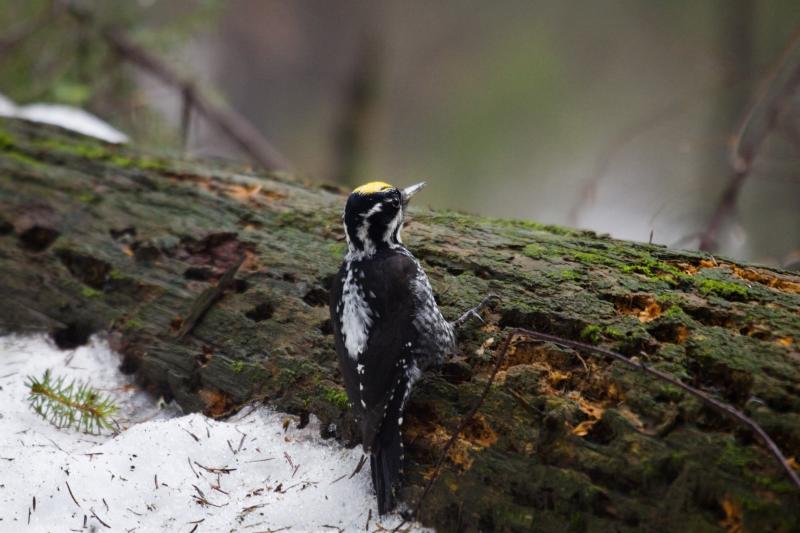
Männchen mit gut erkennbarem gelben Oberkopf. Von Alberto Chiarle - https://www.flickr.com/photos/alberto_chiarle/5373229161/, CC BY-SA 3.0, Link Source: WIKIPEDIA
Wikipedia Dreizehenspecht.jpg
First observed in 🇨🇭 on 2021-08-02.
Behavior: ![]() Der Borkenkäferspezialist bevorzugt ungepflegte Fichtenwälder mit reichlich Totholz. [Portrait]
Der Borkenkäferspezialist bevorzugt ungepflegte Fichtenwälder mit reichlich Totholz. [Portrait]
Behavior: ![]() Die Anwesenheit des heimlichen Dreizehenspechts wird oft übersehen. Er ist wenig scheu und fliegt kaum weg, wenn man sich ihm nähert. [Portrait]
Die Anwesenheit des heimlichen Dreizehenspechts wird oft übersehen. Er ist wenig scheu und fliegt kaum weg, wenn man sich ihm nähert. [Portrait]
Habitats:
Forest
Song:
Fast drumming, constant volume, longer than great spotted woodpecker's.
Song attributes:
Melody: simple rhythmic, fast, Frequency: low (1-3 KHz) Special sounds: drumming
♫ Dreizehenspecht trommelt Source: XENOCANTO
XC627431 dreizehenspecht drumming.mp3
(drumming)
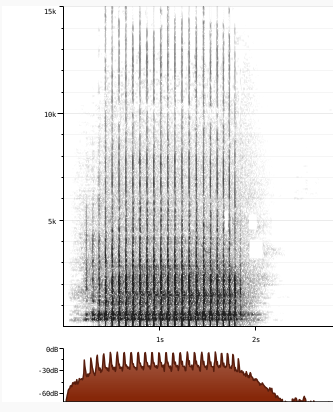
Call:
Behavior: ![]() Seine unauffälligen Rufe sind nicht laut und tönen ähnlich wie jene des Buntspechts. [Portrait]
Seine unauffälligen Rufe sind nicht laut und tönen ähnlich wie jene des Buntspechts. [Portrait]
♫ Source: XENOCANTO
XC498796 Dreizehenspecht call.mp3
(call)

Call attributes:
drumming Call melody: simple rhythmic, slow, Frequency: low (1-3 KHz),
Buntspecht hoch im Baum im Wald 'Im Brand' 2020-04-25 07.57.12 Luppmen
First observed in 🇨🇭 on 2020-04-12.
Most common woodpecker in Switzerland
Vocalization: ![]() It's frequent drumming is easily recognized by its short duration. [Link]
It's frequent drumming is easily recognized by its short duration. [Link]
Calls: ![]() Typically it lasts 0.5 seconds, sometimes slightly longer. Contact call frequently hear throughout the year. A short hiccup "kek", sometimes in series. When excited this may escalate into a trill. [Link]
Typically it lasts 0.5 seconds, sometimes slightly longer. Contact call frequently hear throughout the year. A short hiccup "kek", sometimes in series. When excited this may escalate into a trill. [Link]
Physical details: length=22-23 cm,
wingspan=34-39 cm,
weight=70-100 g
Habitats:
Forest
Song or calls similar to:
Ring ouzel.
Song:
Song: Other: ‘Drumming’ is the sound that Great Spotted Woodpeckers make by hammering their bills against dead wood 10-20 times over 2-3 seconds. The sound resonates in the dead wood and can be heard over large distances. This drumming acts as an advert and is used by Great spotted Woodpeckers and other woodpecker species instead of a song. [From the GardenBird web site]
Nabu: Manchmal, bei strahlendem Sonnenschein, fangen die Spechte schon im Dezember an zu trommeln. [NABU Vogel des Jahres 1997]
Call: Nabu: Das bekannteste Geräusch des schwarz-weißen Spechtes ist aber wohl sein kurzes, aber häufiges Trommeln. [Link]
![]() In a sonogram I can see about 13 taps in just over half a second, but you can never distinguish so many.
It's short but intense, and the second half trails off,
especially contrasted with the constant drumming of the three-toed woodpecker. [[Listen here.]]
In a sonogram I can see about 13 taps in just over half a second, but you can never distinguish so many.
It's short but intense, and the second half trails off,
especially contrasted with the constant drumming of the three-toed woodpecker. [[Listen here.]]
Song attributes:
Melody: non-musical, fast, Frequency: low (1-3 KHz) Special sounds: drumming Singing season: 01-01 - 06-30
♫ Great spotted woodpecker drumming Source: XENOCANTO
XC625181 buntspecht drumming.mp3
(drumming)
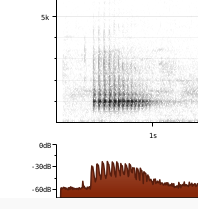
Call:
General: A chirping (that I couldn't associate in my mind with a woodpecker), repeated at somewhat irregular intervals of about a second
2023: klang in bird-song.ch Quiz wie eine lauter Haussperling
Call: Nabu: Der häufigste Ruf ist ein kurzes und spitzes „kix“. Ist ein Buntspecht aufgebracht, etwa durch einen Artgenossen, kann man ein schnelles Schnarren hören. [Link]
Great spotted woodpecker call
♫ Great spotted woodpecker call Source: XENOCANTO
XC200059 Great spotted woodpecker call.mp3
(call)
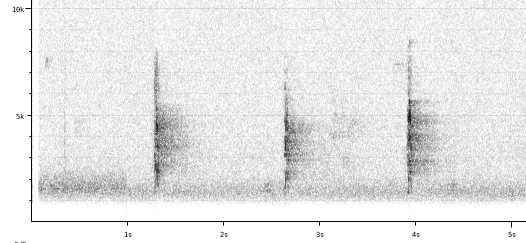
Call attributes:
Call melody: one note, slow, Frequency: 1-8 KHz,
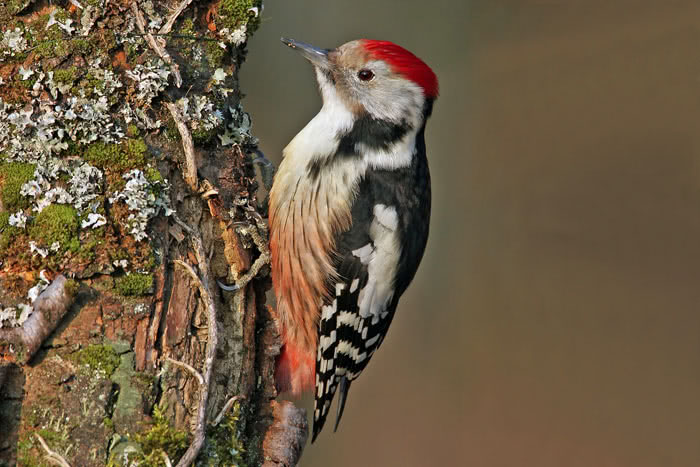
Vogelwarte Mittelspecht. Source: VOGELWARTE
Vogelwarte Mittelspecht.jpg
Habitat: ![]() Der Mittelspecht ist ein Habitatspezialist, der bei uns hauptsächlich ehemalige Mittelwälder mit zahlreichen Alteichen besiedelt. Der Bestand ist gefährdet und langfristig wird er sich nur halten können, wenn grossflächige Wälder mit der Eiche als Hauptbaumart bestehen bleiben. [Link]
Der Mittelspecht ist ein Habitatspezialist, der bei uns hauptsächlich ehemalige Mittelwälder mit zahlreichen Alteichen besiedelt. Der Bestand ist gefährdet und langfristig wird er sich nur halten können, wenn grossflächige Wälder mit der Eiche als Hauptbaumart bestehen bleiben. [Link]
Song: ![]() Im Gegensatz zu anderen Spechten trommelt der Mittelspecht nur sehr selten. [Link]
Im Gegensatz zu anderen Spechten trommelt der Mittelspecht nur sehr selten. [Link]
![]() Song is a series of short, mewing and nasal "peeaa peeaa peeaa ", where each syllable quickly rises in pitch, but the overall phrase is fairly constant. [Link]
Song is a series of short, mewing and nasal "peeaa peeaa peeaa ", where each syllable quickly rises in pitch, but the overall phrase is fairly constant. [Link]
Calls: ![]() Contact and alarm call consists of a series of short "kitt" sounds, where the first syllable is clearer and distinctly in a higher pitch than the rest of the phrase. Seldom drums. [Link]
Contact and alarm call consists of a series of short "kitt" sounds, where the first syllable is clearer and distinctly in a higher pitch than the rest of the phrase. Seldom drums. [Link]
Physical details: length=20-22 cm,
wingspan=33-34 cm,
weight=50-80 g
Habitats:
Forest
Call:
![]() Stattdessen ist in der Brutzeit das klagende Quäken zu hören, womit der Mittelspecht sein Revier markiert. [Link]
Stattdessen ist in der Brutzeit das klagende Quäken zu hören, womit der Mittelspecht sein Revier markiert. [Link]
♫ Source: XENOCANTO
XC624229 Mittelspecht call.mp3
(call)
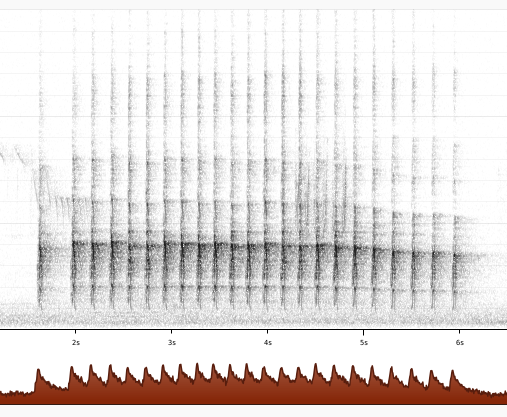
Call attributes:
Call melody: simple rhythmic, slow, Frequency: 0-4 KHz,
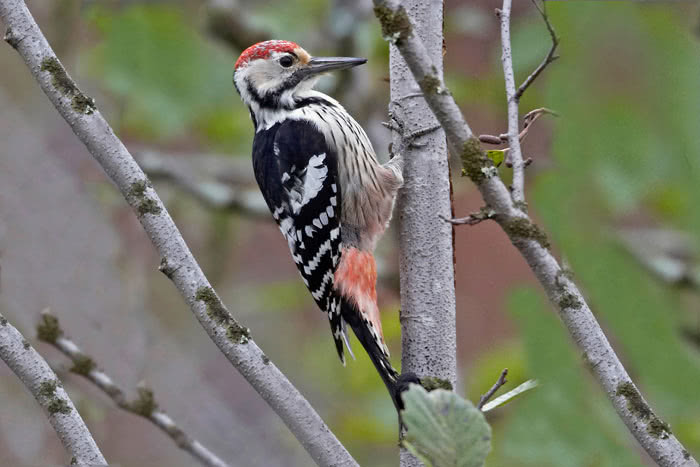
Vogelwarte Weissrueckenspecht. Source: VOGELWARTE
Vogelwarte Weissrueckenspecht.jpg
Da es selten zu sehen ist, habe ich wenig beschrieben.
Habitat: ![]() The White-backed Woodpecker is the largest and rarest of the black and white woodpeckers. Since a few years only, individual breeding pairs have been observed in the east of Switzerland. Because of its special habitat requirements – natural forests with a great number of dying and dead trees – the occurrence of the White-backed Woodpecker is limited to remote and inaccessible forests. It has secretive habits and is most likely observed during the courtship period. [Link]
The White-backed Woodpecker is the largest and rarest of the black and white woodpeckers. Since a few years only, individual breeding pairs have been observed in the east of Switzerland. Because of its special habitat requirements – natural forests with a great number of dying and dead trees – the occurrence of the White-backed Woodpecker is limited to remote and inaccessible forests. It has secretive habits and is most likely observed during the courtship period. [Link]
Habitats:
Forest
Profile Wikipedia eBird Vogelwarte BirdLife ZH ornitho.ch bird-song.ch Xeno-Canto BirdID NABU

Black Woodpecker adult and young By Alastair Rae from London, United Kingdom - Black Woodpecker, CC BY-SA 2.0. Source: WIKIPEDIA
Wikimedia Black Woodpecker adult and young.jpg
First observed in 🇨🇭 on 2020-10-21.
Seen and later seen, but never photgraphed well.
Appearance and identification: ![]() The black woodpecker (Dryocopus martius) is a large woodpecker that lives in mature forests across the northern Palearctic. It is the sole representative of its genus in that region. Its range is expanding. It does not migrate. [Link]
The black woodpecker (Dryocopus martius) is a large woodpecker that lives in mature forests across the northern Palearctic. It is the sole representative of its genus in that region. Its range is expanding. It does not migrate. [Link]
Habitat: ![]() The black woodpecker is mainly found in forested regions, with a preference for extensive, mature woodland, including coniferous, tropical, subtropical and boreal forests. It is very widespread throughout mountainous and lowland forests. It is more likely to occur in marginal woods near human habitations during the non-breeding season. [Link]
The black woodpecker is mainly found in forested regions, with a preference for extensive, mature woodland, including coniferous, tropical, subtropical and boreal forests. It is very widespread throughout mountainous and lowland forests. It is more likely to occur in marginal woods near human habitations during the non-breeding season. [Link]
Vocalization: ![]() Most sounds diagnostic and very far reaching. Drumming very powerful and long (1.8 - 3 sec.) with slightly falling intensity and accelerated ending. Each beat clearly distinguishable as in Tree-toed Woodpecker, but duration much longer. [Link]
Most sounds diagnostic and very far reaching. Drumming very powerful and long (1.8 - 3 sec.) with slightly falling intensity and accelerated ending. Each beat clearly distinguishable as in Tree-toed Woodpecker, but duration much longer. [Link]
Song: ![]() Beide Geschlechter ähnlich Grünspecht aber klangvoller. „klückklückklück“ 10-20 Laute. Die „klück“ werden etwas von unten heraufgeholt, vor allem gegen den Schluss zu. Häufiger hört man „kliüüh“ von am Stamme sitzenden Vogel. Bei Platzwechsel ruft er „krükrükrü“.
[Link]
Beide Geschlechter ähnlich Grünspecht aber klangvoller. „klückklückklück“ 10-20 Laute. Die „klück“ werden etwas von unten heraufgeholt, vor allem gegen den Schluss zu. Häufiger hört man „kliüüh“ von am Stamme sitzenden Vogel. Bei Platzwechsel ruft er „krükrükrü“.
[Link]
![]() Song a quick series of "klee" calls resembling Green Woodpecker, but with a purer tone and upward infliction at end of each syllable. [Link]
Song a quick series of "klee" calls resembling Green Woodpecker, but with a purer tone and upward infliction at end of each syllable. [Link]
Calls: ![]() Drumming:
Drumming:
Flight call a characteristic resonant trill "krrreekrrreekrrreekrrree". A characteristic short, sharp and plaintive "keeaaa" with descending pitch often uttered when excited. A few slower drawn-out introductory calls before the phrase gets going is diagnostic. [Link]
Physical details: length=45-57 cm,
wingspan=64-68 cm,
weight=290-370 g
Habitats:
Forest
Song:
Automatically generated from Xeno-Canto recording
Song attributes:
Frequency:
♫ XC554337 Black woodpecker song. Source: XENOCANTO
XC554337 Black woodpecker song.mp3
(song)
Calls:
1:
General: A loud unearthly call on a single unwavering note.
Blood curdling call
♫ Blood curdling call Source as noted in xeno-canto: Recordist Bodo Sonnenburg
2021-10-11 07:26
Latitude 52.2333
Longitude 13.8365
Location Oder-Spree (near Storkow (Mark)), Brandenburg
Country Germany
Elevation 40 m Source: XENOCANTO
XC679746 - Black Woodpecker - Dryocopus martius.mp3
(call)
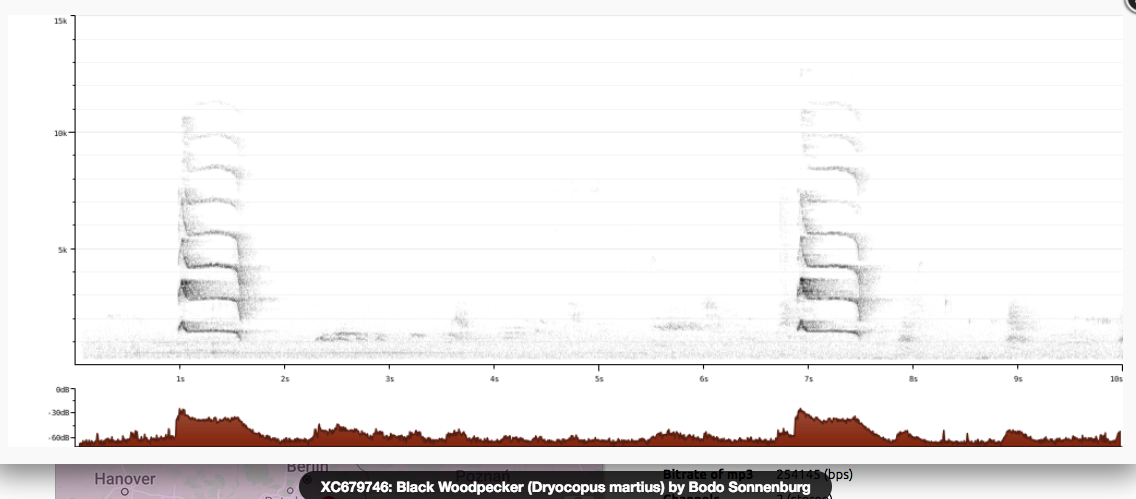
2:
Describe drumming here, cf to other peckers!
Call attributes:
Call melody: one note, slow, Frequency: 1-8 KHz,
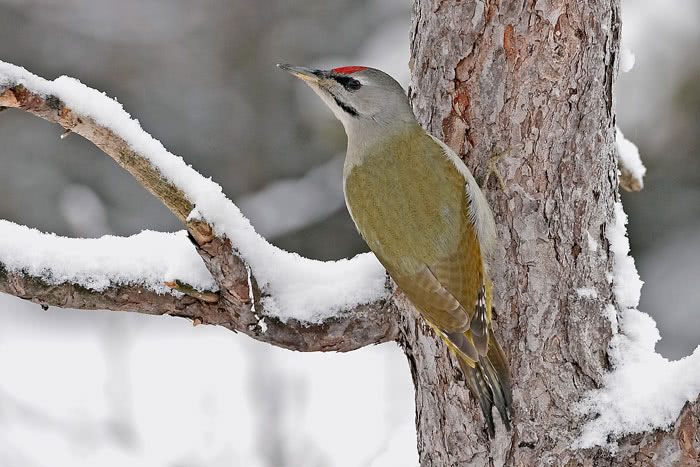
Vogelwarte Grauspecht. Note that it's quite green despite its name. Source: VOGELWARTE
Vogelwarte Grauspecht.jpg
Behavior: ![]() Der Grauspecht gehört mit dem Grünspecht zu den «Erdspechten», die ihre Nahrung vorwiegend auf dem Boden suchen. Obwohl er fast so gross ist wie der Grünspecht, ist der heimlicher lebende Grauspecht ungleich schwieriger zu lokalisieren. Am ehesten verrät er sich durch die fallende, etwas melancholisch wirkende Rufreihe. Über seine Lebensweise ist vergleichsweise wenig bekannt. [Link]
Der Grauspecht gehört mit dem Grünspecht zu den «Erdspechten», die ihre Nahrung vorwiegend auf dem Boden suchen. Obwohl er fast so gross ist wie der Grünspecht, ist der heimlicher lebende Grauspecht ungleich schwieriger zu lokalisieren. Am ehesten verrät er sich durch die fallende, etwas melancholisch wirkende Rufreihe. Über seine Lebensweise ist vergleichsweise wenig bekannt. [Link]
Song: ![]() Deutlich abfallende Tonreihe. 4-10 Töne. Absinken beginnt
gewöhnlich erst mit dem dritten oder vierten Ton und wird etwas langsamer.
Klingt etwas klagend (moll). Vor allem gegen den Schluss. Kann nachgepfiffen werden. (beim Grünspecht nicht )
[Link]
Deutlich abfallende Tonreihe. 4-10 Töne. Absinken beginnt
gewöhnlich erst mit dem dritten oder vierten Ton und wird etwas langsamer.
Klingt etwas klagend (moll). Vor allem gegen den Schluss. Kann nachgepfiffen werden. (beim Grünspecht nicht )
[Link]
Habitats:
Forest
Song:
Drumming in lieu of song. Fast, constant, somehow less harsh than great and middle spotted woodpeckers.
Song attributes:
Melody: simple rhythmic, fast, Frequency: 0-4 KHz Special sounds: drumming
♫ Source: XENOCANTO
XC552636 Kleinspecht drumming.mp3
(drumming)
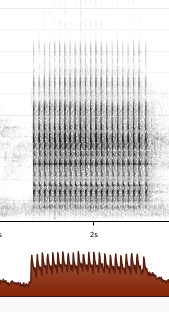
Call:
In the FOK course, Christina said he sounds like he's running out of gas, which is a great description.
♫ Source: XENOCANTO
XC623125 grauspecht call.mp3
(call)
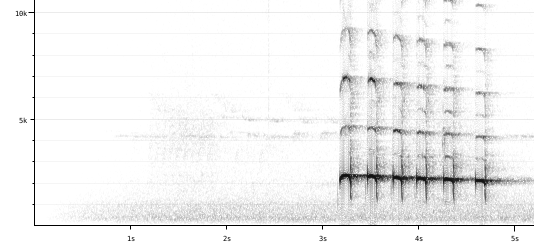
Call attributes:
Call melody: simple rhythmic, slow, Frequency: high (3-9 KHz),
First observed in 🇨🇭 on 2020-11-08.
In the FOK course, Tom mentioned that his nephew said it should be called the Buntspecht, since it has so many colors.
Da es v.a. Ameisen frisst, trommelt es nicht viel, so weit ich mich erinnere, daher ist es hier nicht beschrieben. Xenocanto hat auch nichts.
Appearance and identification: ![]() Der Grünspecht fällt neben dem laut lachenden Balzruf auch durch den wellenförmigen Flug auf, bei dem er die Flügel zwischen zwei Schlagphasen ganz an den Körper anlegt. Neben dem Wendehals ist er unter den Spechtarten Europas am stärksten auf Ameisen spezialisiert. Er besitzt eine mehr als 10 Zentimeter lange Zunge, die klebrig und an der Spitze mit Widerhaken versehen ist. [Link]
Der Grünspecht fällt neben dem laut lachenden Balzruf auch durch den wellenförmigen Flug auf, bei dem er die Flügel zwischen zwei Schlagphasen ganz an den Körper anlegt. Neben dem Wendehals ist er unter den Spechtarten Europas am stärksten auf Ameisen spezialisiert. Er besitzt eine mehr als 10 Zentimeter lange Zunge, die klebrig und an der Spitze mit Widerhaken versehen ist. [Link]
Song: ![]() Helles Lachen. Weiche, oft leicht abfallende Tonreihe. Variabel in Lautstärke und Silbenzahl. je nach Stimmung. Wenn abfallend dann vom Anfang der Rufreihe an. Auch dreisilbig „kiäckkiäckkiäck“.
[Link]
Helles Lachen. Weiche, oft leicht abfallende Tonreihe. Variabel in Lautstärke und Silbenzahl. je nach Stimmung. Wenn abfallend dann vom Anfang der Rufreihe an. Auch dreisilbig „kiäckkiäckkiäck“.
[Link]
![]() Song similar to Grey-headed Woodpecker, but not as soft and fluty. Each phrase consist of a series of short "klee", with a laughing quality. Pitch drops slightly throughout the phrase, but not as markedly as in Grey-headed, and tempo is fairly constant (no ritardando). [Link]
Song similar to Grey-headed Woodpecker, but not as soft and fluty. Each phrase consist of a series of short "klee", with a laughing quality. Pitch drops slightly throughout the phrase, but not as markedly as in Grey-headed, and tempo is fairly constant (no ritardando). [Link]
Calls: ![]() Short "kek" calls when excited and in flight. Drumming of 1.5 seconds duration with decelerating tempo, but not often heard. Another call is similar to Black Woodpecker; a series of resonant "klit-klit-klit-klit-klit-klit", but is less clear, has a more determined start and has less obvious rising pitch at the end of each syllable. [Link]
Short "kek" calls when excited and in flight. Drumming of 1.5 seconds duration with decelerating tempo, but not often heard. Another call is similar to Black Woodpecker; a series of resonant "klit-klit-klit-klit-klit-klit", but is less clear, has a more determined start and has less obvious rising pitch at the end of each syllable. [Link]
Physical details: length=31-33 cm,
wingspan=40-42 cm,
weight=150-220 g
Habitats:
Forest
Song:
Spooky laugh.
Song attributes:
Melody: non-musical, slow, Frequency: 1-6 KHz
Call:
Hysterical laughter. 7-8 loud urgent slightly falling notes, reminding me of George of the Jungle's dooky dooky bird for some reason.
♫ Source: XENOCANTO
XC627157 Gruenspecht laughing call.mp3
(call)
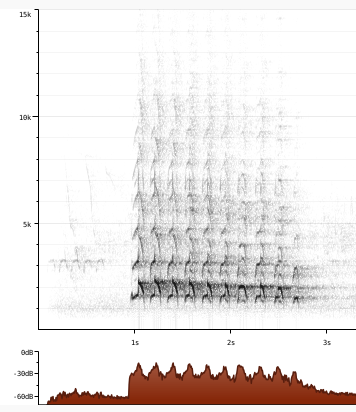
Call attributes:
Call melody: simple rhythmic, slow, Frequency: high (3-9 KHz),
Profile Wikipedia eBird Vogelwarte BirdLife ZH ornitho.ch bird-song.ch Xeno-Canto BirdID NABU
Wendehals in Susten. 2022-05-21 10.28.36 Leuk and surroundings
First observed in 🇨🇭 on 2021-05-10.
Invisible as soon as it lands in a tree - perfect bark camouflage.
Vocalization: ![]() Normally silent when not breeding. Other sounds: a guttural "gru", and hissing sounds when threatened. [Link]
Normally silent when not breeding. Other sounds: a guttural "gru", and hissing sounds when threatened. [Link]
Song: ![]() Reihe von 8-12 Pfeiftönen. Klingt fast etwas heiser., Jeder Ruf etwas absinkend. Die Tonhöhe kann innerhalb der Reihe etwas schwanken, etwas zunehmen und eindringlicher werden. Klangfarbe weich, obertönig.
[Link]
Reihe von 8-12 Pfeiftönen. Klingt fast etwas heiser., Jeder Ruf etwas absinkend. Die Tonhöhe kann innerhalb der Reihe etwas schwanken, etwas zunehmen und eindringlicher werden. Klangfarbe weich, obertönig.
[Link]
![]() Song (both sexes): an insisting, Merlin- or Lesser Spotted Woodpecker-like series of plaintive "kee kee kee kee kee ". First slightly ascending, then descending. [Link]
Song (both sexes): an insisting, Merlin- or Lesser Spotted Woodpecker-like series of plaintive "kee kee kee kee kee ". First slightly ascending, then descending. [Link]
Physical details: length=16-17 cm,
wingspan=25-27 cm,
weight=30-45 g
Habitats:
Agricultural
Song:
Woodpecker-like series of up to 25 slightly rising calls.
Song attributes:
Melody: non-musical, slow, Frequency: 1-6 KHz
Call:
Automatically generated from Xeno-Canto recording
♫ Wendehals, bolle magadino. 2021-05-10 08.28.04 Magadino (song?)
Kleinspecht am luppmen. Never saw one until after a heavy snowfall one checked out the trees along the Luppmen 2021-01-16 12.56.16 Luppmen
First observed in 🇨🇭 on 2021-01-16.
Bisher gesehen aber nicht gehört!
Appearance and identification: ![]() The smallest European woodpecker. ... From its small size and its habit of spending most of its time in the tops of tall trees in woods and parks, this little woodpecker is often overlooked, but if sighted on a trunk
it may at once be identified by the broad barring on the wings and narrower bars across the lower back. [Link]
The smallest European woodpecker. ... From its small size and its habit of spending most of its time in the tops of tall trees in woods and parks, this little woodpecker is often overlooked, but if sighted on a trunk
it may at once be identified by the broad barring on the wings and narrower bars across the lower back. [Link]
![]() Der Kleinspecht ist der Zwerg unter den europäischen Spechten.
Er macht sich im Frühjahr mit hohen Rufreihen und gleichmässigen Trommelwirbeln bemerkbar. [Link]
Der Kleinspecht ist der Zwerg unter den europäischen Spechten.
Er macht sich im Frühjahr mit hohen Rufreihen und gleichmässigen Trommelwirbeln bemerkbar. [Link]
Habitat: ![]() As above: spend(s) most of its time in the tops of tall trees [Link]
As above: spend(s) most of its time in the tops of tall trees [Link]
Vocalization: ![]() Frequently drums in quite long series. Much longer than Great Spotted, and without ritardando. [Link]
Frequently drums in quite long series. Much longer than Great Spotted, and without ritardando. [Link]
Calls: ![]() Most common call a series of merlin-like "ke-ke-ke-ke-ke-ke" given at fairly stable pitch, and less hoarse than Merlin. Differs from Wryneck in lacking marked rise and fall in pitch, and being less plaintive. [Link]
Most common call a series of merlin-like "ke-ke-ke-ke-ke-ke" given at fairly stable pitch, and less hoarse than Merlin. Differs from Wryneck in lacking marked rise and fall in pitch, and being less plaintive. [Link]
Physical details: length=14-15 cm,
wingspan=25-27 cm,
weight=17-25 g
Habitats:
Forest
Song:
Drumming in lieu of song. Fast, constant.
Song attributes:
Melody: simple rhythmic, fast, Frequency: 0-4 KHz Special sounds: drumming
♫ Source: XENOCANTO
XC552636 Kleinspecht drumming.mp3
(drumming)

Call:
Vogelwarte wie oben..hohe Rufreihen
♫ Source: XENOCANTO
XC625101 Kleinspecht call.mp3
(call)
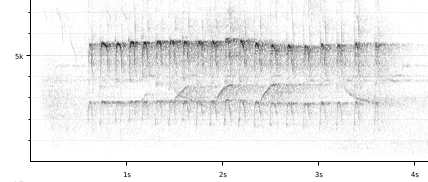
Call attributes:
Call melody: simple rhythmic, fast, Frequency: high (3-9 KHz),

Wikipedia: Red-throated loon Source: OTHER
1200px-Gavia_Stellata_%C3%96lfus%C3%A1_20090606.jpg
This bird appears across the great seas in the following continents:
Europe, North America.
Deutschland: Zugvogel, Wintergast
Habitats:
River and lake
Great northern loon, Squam Lake, New Hampshire. 2023-10-06 12.26.58 New England
First observed in New England on 2023-10-06.
This bird appears across the great seas in the following continents:
Europe, North America.
Deutschland: seltener Wintergast
Song: ![]() Song: Like a slow Black-throated Diver. Pitch slowly rising with a register break, progressing into a cyclic, two to four syllable, motif. [Link]
Song: Like a slow Black-throated Diver. Pitch slowly rising with a register break, progressing into a cyclic, two to four syllable, motif. [Link]
Calls: ![]() Also various vibrating eerie descending calls. Often used as sound effect in horror movies. [Link]
Also various vibrating eerie descending calls. Often used as sound effect in horror movies. [Link]
Physical details: length=69-91 cm,
wingspan=69-91 cm,
weight=3600-4480 g

Wikipedia: Black-throated loon Source: OTHER
Black-throated_Diver%2C_Oulu%2C_Finland_02_%2815195370798%29.jpg
This bird appears across the great seas in the following continents:
Europe, North America.
Deutschland: Zugvogel, Wintergast
Habitats:
River and lake
Profile Wikipedia eBird Vogelwarte BirdLife ZH ornitho.ch bird-song.ch Xeno-Canto BirdID NABU
First observed in 🇨🇭 on 2020-04-27.
Exotic looking waterbird common at Pfäffikersee
Vocalization: ![]() Laughing sequences with nasal grunts, a rolling nasal "treaa" and bill-clattering. [Link]
Laughing sequences with nasal grunts, a rolling nasal "treaa" and bill-clattering. [Link]
Physical details: length=46-51 cm,
wingspan=85-90 cm,
weight=568-813 g
Habitats:
River and lake
Call:
Automatically generated from Xeno-Canto recording
♫ Source: BirdNet
20210421_103108 birdnet 1470 - Great Crested Grebe - 2021-04-21 10:31:08 - Great Crested Grebe - Pf=C3=A4ffikon.mp3
2021-04-21 10.31.08 Pfäffikersee (song?)
Evtl Schwarzhalstaucher. 2021-03-07 11.13.08
First observed in 🇨🇭 on 2021-03-07.
This bird appears across the great seas in the following continents:
Europe, North America, Africa.
General: ![]() The black-necked grebe or eared grebe (Podiceps nigricollis) is a member of the grebe family of water birds. It was described in 1831 by Christian Ludwig Brehm. There are currently three accepted subspecies, including the nominate subspecies. Its breeding plumage features a distinctive ochre-coloured plumage which extends behind its eye and over its ear coverts. The rest of the upper parts, including the head, neck, and breast, are coloured black to blackish brown. The flanks are tawny rufous to maroon-chestnut, and the abdomen is white. When in its non-breeding plumage, this bird has greyish-black upper parts, including the top of the head and a vertical stripe on the back of the neck. The flanks are also greyish-black. The rest of the body is a white or whitish colour. The juvenile has more brown in its darker areas. The subspecies californicus can be distinguished from the nominate by the former's usually longer bill. The other subspecies, P. n. gurneyi, can be differentiated by its greyer head and upper parts and by its smaller size. P. n. gurneyi can also be told apart by its lack of a non-breeding plumage. This species is present in parts of Africa, Eurasia, and the Americas.
[more]
The black-necked grebe or eared grebe (Podiceps nigricollis) is a member of the grebe family of water birds. It was described in 1831 by Christian Ludwig Brehm. There are currently three accepted subspecies, including the nominate subspecies. Its breeding plumage features a distinctive ochre-coloured plumage which extends behind its eye and over its ear coverts. The rest of the upper parts, including the head, neck, and breast, are coloured black to blackish brown. The flanks are tawny rufous to maroon-chestnut, and the abdomen is white. When in its non-breeding plumage, this bird has greyish-black upper parts, including the top of the head and a vertical stripe on the back of the neck. The flanks are also greyish-black. The rest of the body is a white or whitish colour. The juvenile has more brown in its darker areas. The subspecies californicus can be distinguished from the nominate by the former's usually longer bill. The other subspecies, P. n. gurneyi, can be differentiated by its greyer head and upper parts and by its smaller size. P. n. gurneyi can also be told apart by its lack of a non-breeding plumage. This species is present in parts of Africa, Eurasia, and the Americas.
[more]
Habitats:
River and lake
Horned grebe, Myvatn, Iceland. 2015-06-05 11.22.28 Iceland
First observed in Iceland on 2015-06-05.
This bird appears across the great seas in the following continents:
Europe, North America.
Deutschland: Brut-, Zugvogel, Wintergast RL 1
Vocalization: ![]() Varied. Vibrating, wailing, dry and cackling sequences. A mewing, falling and far-reaching "kiaa" and various rattling sounds. [Link]
Varied. Vibrating, wailing, dry and cackling sequences. A mewing, falling and far-reaching "kiaa" and various rattling sounds. [Link]
Physical details: length=31-38 cm,
wingspan=46-55 cm,
weight=364-449 g
Habitats:
River and lake
Profile Wikipedia eBird Vogelwarte BirdLife ZH ornitho.ch Audubon AllAboutBirds Xeno-Canto NABU

Wikipedia: Red-necked grebe Source: OTHER
1200px-Podicepsgrisegena.jpg
This bird appears across the great seas in the following continents:
Europe, North America.
Deutschland: Brut-, Zugvogel
Habitats:
River and lake
Profile Wikipedia eBird Vogelwarte BirdLife ZH ornitho.ch bird-song.ch Xeno-Canto BirdID NABU
Zwergtaucher. 2022-06-25 12.07.24 La Sauge
First observed in Gqeberha (former Port Elisabeth) on 2009-10-22.
General: ![]() The little grebe (Tachybaptus ruficollis), also known as dabchick, is a member of the grebe family of water birds. The genus name is from Ancient Greek takhus "fast" and bapto "to sink under". The specific ruficollis is from Latin rufus "red" and Modern Latin -collis, "-necked", itself derived from Latin collum "neck".[2]
[more]
The little grebe (Tachybaptus ruficollis), also known as dabchick, is a member of the grebe family of water birds. The genus name is from Ancient Greek takhus "fast" and bapto "to sink under". The specific ruficollis is from Latin rufus "red" and Modern Latin -collis, "-necked", itself derived from Latin collum "neck".[2]
[more]
Vocalization: ![]() Relatively vocal compared to many other grebes. [Link]
Relatively vocal compared to many other grebes. [Link]
Calls: ![]() Call; sometimes a single quite clear high pitched "dydlylyyt". More often combined into longer phrases with harsher quality, oscillating like laughter and travelling up and down in pitch in agitated motion. Reminiscent of female Cuckoo. [Link]
Call; sometimes a single quite clear high pitched "dydlylyyt". More often combined into longer phrases with harsher quality, oscillating like laughter and travelling up and down in pitch in agitated motion. Reminiscent of female Cuckoo. [Link]
Physical details: length=25-29 cm,
wingspan=40-45 cm,
weight=140-193 g
Habitats:
River and lake
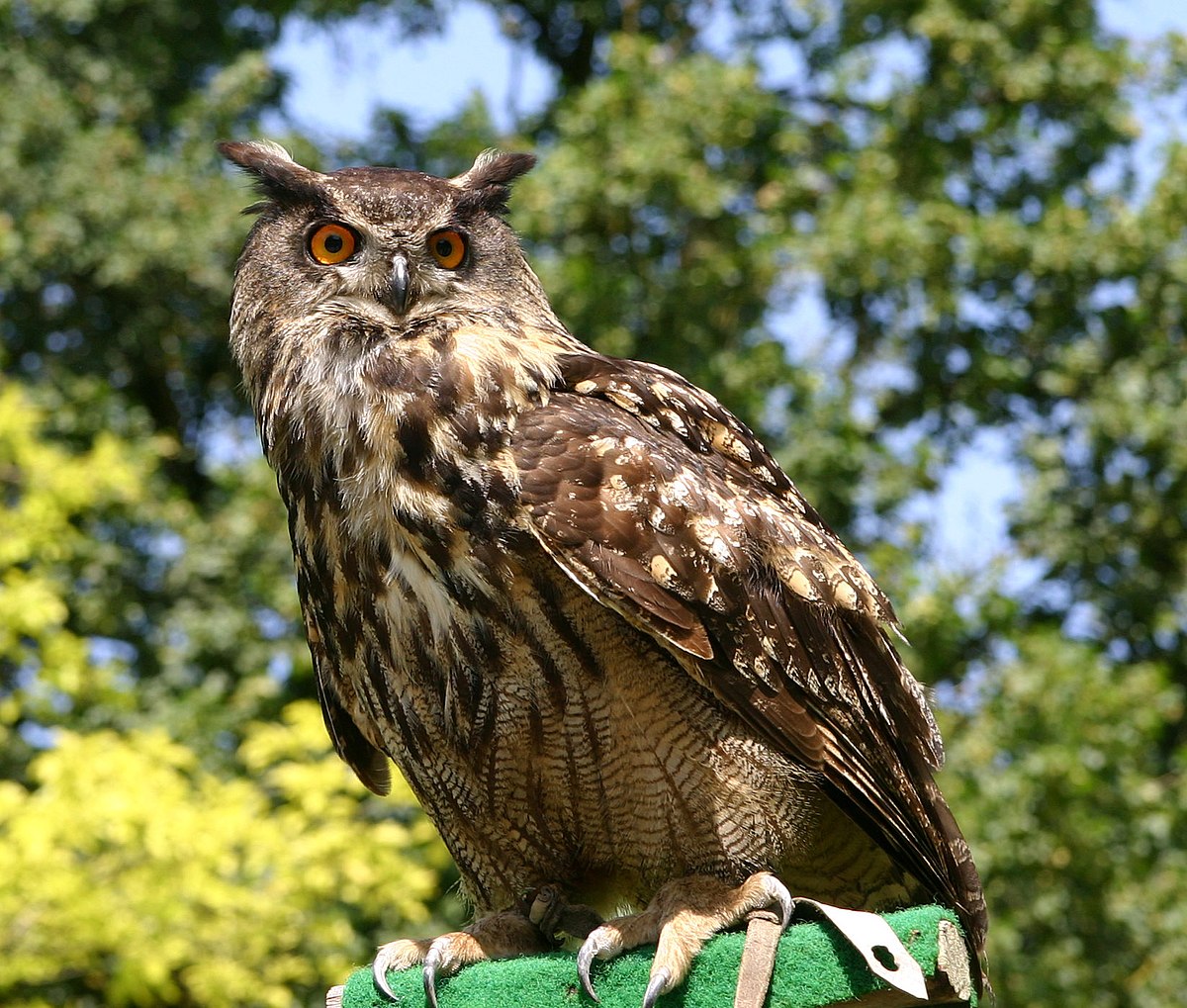
Wikipedia: Eurasian eagle-owl Source: OTHER
1200px-Uhu-muc.jpg
Deutschland: Brut-, Jahresvogel
Song: ![]() Song a very deep "ooho". Continuous, but disyllabic. First syllable emphasized and second syllable rapidly falling in pitch. Quite similar to Long-eared Owl, but deeper and with more pronounced pitch change at end ("release"). [Link]
Song a very deep "ooho". Continuous, but disyllabic. First syllable emphasized and second syllable rapidly falling in pitch. Quite similar to Long-eared Owl, but deeper and with more pronounced pitch change at end ("release"). [Link]
Calls: ![]() Frequency of calls also diagnostic: Typically 8-10 seconds between each "ooho" (2-3 seconds in Long-eared Owl ). Audible at 1 - 4 km distance. Both sexes sing. Has a rich repertoire of contact/alarm calls like a hoarse, heron-like "kreaaak", and an excited, bubbling "hohohohoh". [Link]
Frequency of calls also diagnostic: Typically 8-10 seconds between each "ooho" (2-3 seconds in Long-eared Owl ). Audible at 1 - 4 km distance. Both sexes sing. Has a rich repertoire of contact/alarm calls like a hoarse, heron-like "kreaaak", and an excited, bubbling "hohohohoh". [Link]
Physical details: length=60-75 cm,
wingspan=160-188 cm,
weight=1800-4200 g
Habitats:
Agricultural
Profile Wikipedia eBird Vogelwarte BirdLife ZH ornitho.ch bird-song.ch Xeno-Canto BirdID NABU
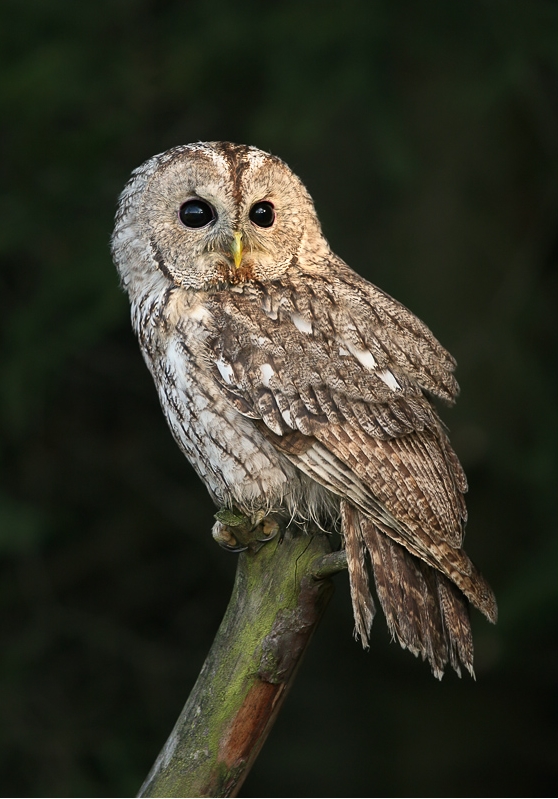
Wikipedia: Tawny owl Source: OTHER
Strix_aluco_3_%28Martin_Mecnarowski%29.jpg
First observed in 🇨🇭 on 2021-04-03.
Zuerst gehört in Carona südlich von Lugano
Vocalization: ![]() Other often heard sounds; a sharp, short, disyllabic "kiu-wik". First syllable ascending then descending, and last ascending in pitch. [Link]
Other often heard sounds; a sharp, short, disyllabic "kiu-wik". First syllable ascending then descending, and last ascending in pitch. [Link]
Song: ![]() Song a resonant descending "hoooooo". After 2-3 sec. [Link]
Song a resonant descending "hoooooo". After 2-3 sec. [Link]
Calls: ![]() typically followed by a slightly ascending, vibrating "hohohohohoho" and quickly another descending "hooooooo". Complete phrase: "hoooooo, hohohohohoho-hoooooo". May omit parts. [Link]
typically followed by a slightly ascending, vibrating "hohohohohoho" and quickly another descending "hooooooo". Complete phrase: "hoooooo, hohohohohoho-hoooooo". May omit parts. [Link]
Physical details: length=37-39 cm,
wingspan=94-104 cm,
weight=340-620 g
Habitats:
Forest
Call:
Automatically generated from Xeno-Canto recording
♫ Waldkauz in Carona. 2021-04-05 03.44.43 Carona (song?)

Wikipedia: Boreal owl Source: OTHER
Aegolius-funereus-001.jpg
This bird appears across the great seas in the following continents:
Europe, North America.
Deutschland: Brut-, Jahresvogel
Habitats:
Forest

Wikipedia: Short-eared owl Source: OTHER
1200px-Hibou_des_marais.jpg
This bird appears across the great seas in the following continents:
Europe, North America, South America, Africa, Asia.
Deutschland: Brut-, Zugvogel, Wintergast RL 1
Habitats:
Wetland

Wikipedia: Long-eared owl Source: OTHER
Waldohreule_in_freier_Wildbahn.jpg
This bird appears across the great seas in the following continents:
Europe, North America, Africa.
Deutschland: Brut-, Jahres-, Zugvogel, Wintergast
Habitats:
Agricultural

Wikipedia: Eurasian scops owl Source: OTHER
1200px-Scops_Owl_%28Otus_scops%29%2C_Kalloni%2C_Lesvos%2C_Greece%2C_19.04.2015_%2816773748434%29.jpg
General: ![]() The Eurasian scops owl (Otus scops), also known as the European scops owl or just scops owl, is a small owl in the typical owl family Strigidae. Its breeding range extends from southern Europe eastwards to southern Siberia and the western Himalayas. It is migratory, wintering in Africa south of the Sahara.
[more]
The Eurasian scops owl (Otus scops), also known as the European scops owl or just scops owl, is a small owl in the typical owl family Strigidae. Its breeding range extends from southern Europe eastwards to southern Siberia and the western Himalayas. It is migratory, wintering in Africa south of the Sahara.
[more]
Song: ![]() Song: a slightly descending, short "klooit". The tone is resonant, clear and pure, unlike Little Owl. [Link]
Song: a slightly descending, short "klooit". The tone is resonant, clear and pure, unlike Little Owl. [Link]
Calls: ![]() Calls uttered endlessly in a frequency of about 20 a minute. Resembles Midwife Toad (Alytes), but is clearly modulated in pitch, as opposed to the toads straight tone. [Link]
Calls uttered endlessly in a frequency of about 20 a minute. Resembles Midwife Toad (Alytes), but is clearly modulated in pitch, as opposed to the toads straight tone. [Link]
Physical details: length=19-20 cm,
wingspan=53-63 cm,
weight=60-120 g
Habitats:
Agricultural

Wikipedia: Eurasian pygmy-owl Source: OTHER
Glaucidium_passerinum_20110413.jpg
Deutschland: Brut-, Jahresvogel
Calls: ![]() Calls in a clear voice, like a straight note blown on a recorder. Each note often followed by a rhythmic, trisyllabic accent a whole tone deeper than the first note. [Link]
Calls in a clear voice, like a straight note blown on a recorder. Each note often followed by a rhythmic, trisyllabic accent a whole tone deeper than the first note. [Link]
Physical details: length=16-17 cm,
wingspan=34-36 cm,
weight=47-80 g
Habitats:
Forest

Wikipedia: Little owl Source: OTHER
1200px-Mochuelo_Com%C3%BAn_%28_Athene_noctua_%29%281%29.jpg
Behavior: ![]() Seltener Vogel brütet in der Nordwestschweiz. Nach 40 Jahren ist der Steinkauz zurück in der Nordwestschweiz.
Die seltenen Vögel haben wieder in der Region gebrütet, wie Bird Life meldet.
Über eine Million Franken haben die vier Nordwestschweizer Kantone und Partner dafür investiert. [Artikel im Tagi]
Seltener Vogel brütet in der Nordwestschweiz. Nach 40 Jahren ist der Steinkauz zurück in der Nordwestschweiz.
Die seltenen Vögel haben wieder in der Region gebrütet, wie Bird Life meldet.
Über eine Million Franken haben die vier Nordwestschweizer Kantone und Partner dafür investiert. [Artikel im Tagi]
Vocalization: ![]() Rich repertoire of social sounds: E.g. a clear "klewew", and sharp short "kek kek kek". [Link]
Rich repertoire of social sounds: E.g. a clear "klewew", and sharp short "kek kek kek". [Link]
Song: ![]() Song a clear drawn "klooit" resembling Scops Owl, but with different intonation and longer single notes. [Link]
Song a clear drawn "klooit" resembling Scops Owl, but with different intonation and longer single notes. [Link]
Calls: ![]() Tone rises slowly in pitch throughout the call and ends with marked raised pitch, often with a change in timbre to a coarse shriek. [Link]
Tone rises slowly in pitch throughout the call and ends with marked raised pitch, often with a change in timbre to a coarse shriek. [Link]
Physical details: length=21-23 cm,
wingspan=54-58 cm,
weight=140-220 g
Habitats:
Agricultural

Wikipedia: Barn owl Source: OTHER
1200px-Tyto_alba_-British_Wildlife_Centre%2C_Surrey%2C_England-8a_%281%29.jpg
This bird appears across the great seas in the following continents:
Europe, North America, South America, Africa, Asia.
General: ![]() The barn owl (Tyto alba) is the most widely distributed species of owl in the world and one of the most widespread of all species of birds, being found almost everywhere in the world except for the polar and desert regions, Asia north of the Himalayas, most of Indonesia, and some Pacific Islands. It is also known as the common barn owl, to distinguish it from the other species in its family, Tytonidae, which forms one of the two main lineages of living owls, the other being the typical owls (Strigidae).
[more]
The barn owl (Tyto alba) is the most widely distributed species of owl in the world and one of the most widespread of all species of birds, being found almost everywhere in the world except for the polar and desert regions, Asia north of the Himalayas, most of Indonesia, and some Pacific Islands. It is also known as the common barn owl, to distinguish it from the other species in its family, Tytonidae, which forms one of the two main lineages of living owls, the other being the typical owls (Strigidae).
[more]
Vocalization: ![]() Large repertoire of mainly hissing and screeching sounds. [Link]
Large repertoire of mainly hissing and screeching sounds. [Link]
Song: ![]() Song consists of a single, drawn screech, lasting about a second and is often performed in flight. Starting in a very hoarse tone, then progressing with a rising pitch into a more burbling sound, before suddenly ending. [Link]
Song consists of a single, drawn screech, lasting about a second and is often performed in flight. Starting in a very hoarse tone, then progressing with a rising pitch into a more burbling sound, before suddenly ending. [Link]
Physical details: length=33-35 cm,
wingspan=80-95 cm,
weight=240-350 g
Habitats:
Agricultural
Wiedehopf. 2022-05-22 11.02.06 Leuk and surroundings
First observed in Mallorca on 2022-04-07.
![]() 3 cooing Noten: wie de hopf, or hoop-hoop-hoop [Link]
3 cooing Noten: wie de hopf, or hoop-hoop-hoop [Link]
![]() Song a characteristic, hollow, far-reaching and trisyllabic "hoop-hoop-hoop". Dove-like timbre and slightly ascending in pitch. Sometimes two or four syllables, depending on virility of male. [Link]
Song a characteristic, hollow, far-reaching and trisyllabic "hoop-hoop-hoop". Dove-like timbre and slightly ascending in pitch. Sometimes two or four syllables, depending on virility of male. [Link]
Calls: ![]() Other calls include a dry, hoarse and rasping "ehrrrrrr". [Link]
Other calls include a dry, hoarse and rasping "ehrrrrrr". [Link]
Physical details: length=26-28 cm,
wingspan=42-46 cm,
weight=55-87 g
Habitats:
Agricultural

Wikipedia: Grey partridge Source: OTHER
1200px-Nurmkanad.jpg
This bird appears across the great seas in the following continents:
Europe, North America.
Deutschland: Brut-, Jahresvogel RL 2
Vocalization: ![]() Also various clucking sounds. [Link]
Also various clucking sounds. [Link]
Song: ![]() Song a sharp, very raspy sound, e.g. "krii-uuu-ii", with middle part lowered in pitch. Often compared to the sound of a rusty gate. [Link]
Song a sharp, very raspy sound, e.g. "krii-uuu-ii", with middle part lowered in pitch. Often compared to the sound of a rusty gate. [Link]
Physical details: length=29-31 cm,
wingspan=45-48 cm,
weight=340-450 g
Habitats:
Agricultural
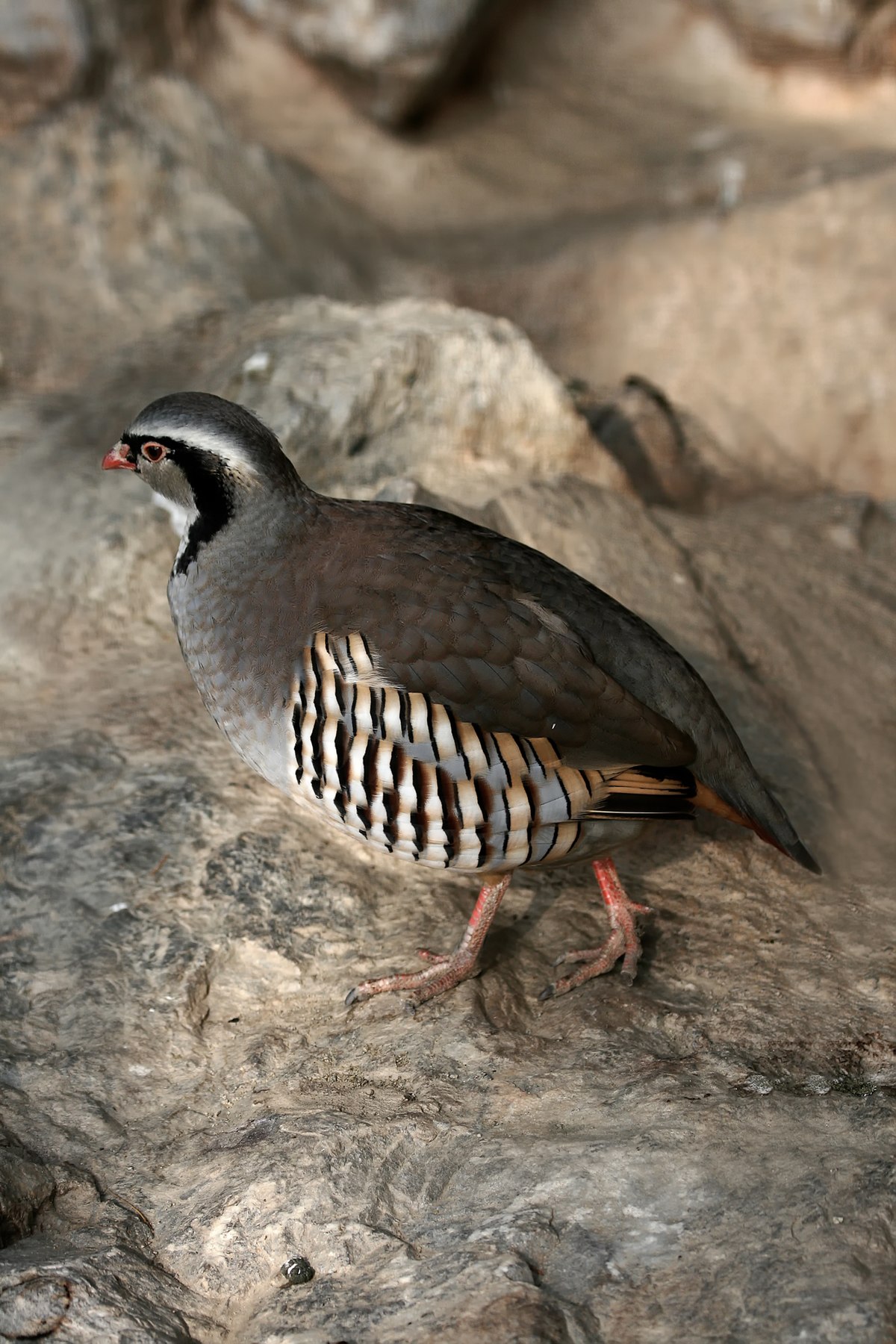
Wikipedia: Rock partridge Source: OTHER
1200px-Steinhuhn_Alectoris_graeca.jpg
General: ![]() The rock partridge (Alectoris graeca) is a gamebird in the pheasant family, Phasianidae, of the order Galliformes (gallinaceous birds). It is native to southern Europe, and is closely related and very similar to its eastern equivalent, the chukar partridge, A. chukar.
[more]
The rock partridge (Alectoris graeca) is a gamebird in the pheasant family, Phasianidae, of the order Galliformes (gallinaceous birds). It is native to southern Europe, and is closely related and very similar to its eastern equivalent, the chukar partridge, A. chukar.
[more]
Habitats:
Mountain
Profile Wikipedia eBird Vogelwarte BirdLife ZH ornitho.ch bird-song.ch Xeno-Canto BirdID NABU

Wikipedia: Common quail Source: OTHER
1200px-A_common_quail_in_Lebanon.jpg
![]() The common quail (Coturnix coturnix), or European quail, is a small ground-nesting game bird in the pheasant family Phasianidae. It is mainly migratory, breeding in the western Palearctic and wintering in Africa and southern India.
[more]
The common quail (Coturnix coturnix), or European quail, is a small ground-nesting game bird in the pheasant family Phasianidae. It is mainly migratory, breeding in the western Palearctic and wintering in Africa and southern India.
[more]
Vocalization: ![]() Other sounds: A nasal disyllabic mewing "mau-au", and a wader-like rolling "wreee". [Link]
Other sounds: A nasal disyllabic mewing "mau-au", and a wader-like rolling "wreee". [Link]
Song: ![]() Song a very characteristic, short, tri-syllabic whistling, with each syllable ending with a sharp rise in pitch "weet weet-weet". The two last syllable linked together. [Link]
Song a very characteristic, short, tri-syllabic whistling, with each syllable ending with a sharp rise in pitch "weet weet-weet". The two last syllable linked together. [Link]
Physical details: length=16-18 cm,
wingspan=32-35 cm,
weight=75-135 g
Habitats:
Agricultural
Profile Wikipedia eBird Vogelwarte BirdLife ZH ornitho.ch bird-song.ch Audubon AllAboutBirds Xeno-Canto BirdID NABU
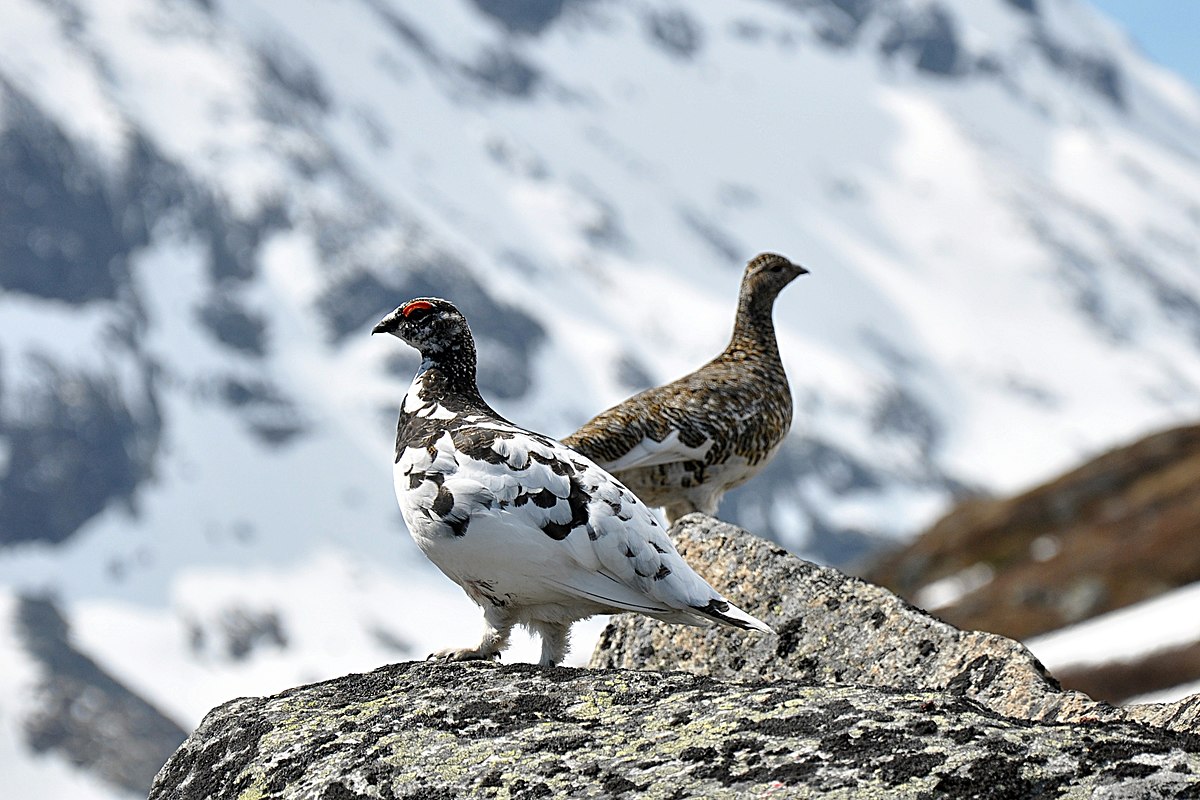
Wikipedia: Rock ptarmigan Source: OTHER
1200px-Rock_Ptarmigan_%28Lagopus_Muta%29.jpg
This bird appears across the great seas in the following continents:
Europe, North America.
Deutschland: Brut-, Jahresvogel RL R
Vocalization: ![]() Female has similar sounds, but is higher pitched and not so coarse as male. [Link]
Female has similar sounds, but is higher pitched and not so coarse as male. [Link]
Calls: ![]() Call of male a very distinct "rrrrrrr", being a rattling rapid pulse of clicks, like running a stick along a picket fence. [Link]
Call of male a very distinct "rrrrrrr", being a rattling rapid pulse of clicks, like running a stick along a picket fence. [Link]
Physical details: length=34-36 cm,
wingspan=54-60 cm,
weight=350-600 g
Habitats:
Mountain
Profile Wikipedia eBird Vogelwarte BirdLife ZH ornitho.ch Xeno-Canto BirdID NABU

Wikipedia: Western capercaillie Source: OTHER
1200px-Tetrao_urogallus_Richard_Bartz.jpg
Deutschland: Brut-, Jahresvogel RL 1
Vocalization: ![]() Display-sounds from male unmistakable. Then closing with grinding and hissing sounds. [Link]
Display-sounds from male unmistakable. Then closing with grinding and hissing sounds. [Link]
Song: ![]() Four phased song: First a slow introductory, double-tapping phase which suddenly bursts into an accelerating crescendo followed by a distinct pop. [Link]
Four phased song: First a slow introductory, double-tapping phase which suddenly bursts into an accelerating crescendo followed by a distinct pop. [Link]
Calls: ![]() Female calls with a deep nasal "kok kok". [Link]
Female calls with a deep nasal "kok kok". [Link]
Physical details: length=60-87 cm,
wingspan=87-125 cm,
weight=1500-5000 g
Habitats:
Mountain

Wikipedia: Hazel grouse Source: OTHER
Haselhuhn-01.jpg
Deutschland: Brut-, Jahresvogel RL 2
Song: ![]() Song an extremely high pitched whistle; "piuuuuuuuiiii pju pju pju". [Link]
Song an extremely high pitched whistle; "piuuuuuuuiiii pju pju pju". [Link]
Calls: ![]() Start-note typically sustained, first descending then ascending and descending again. Often followed by three short conclusive "pju, pju pju". Warning call of female a bubbling thrill. [Link]
Start-note typically sustained, first descending then ascending and descending again. Often followed by three short conclusive "pju, pju pju". Warning call of female a bubbling thrill. [Link]
Physical details: length=35-37 cm,
wingspan=48-54 cm,
weight=310-490 g
Habitats:
Mountain

Wikipedia: Black grouse Source: OTHER
1200px-Black_Grouse_Nationalpark_Bayerischer_Wald.jpg
Rolf hat einen auf dem Amdener Hoehenweg Mai 2023 gesehen, wuerde den gerne sehen!
Habitats:
Mountain
Song:
Song can be a rapid dove-like cooing that goes up, then repeats.
Song attributes:
Melody: simple rhythmic, slow, Frequency: 0-1 KHz
♫ Source: XENOCANTO
XC731604 - Black Grouse - Lyrurus tetrix.mp3
(song)
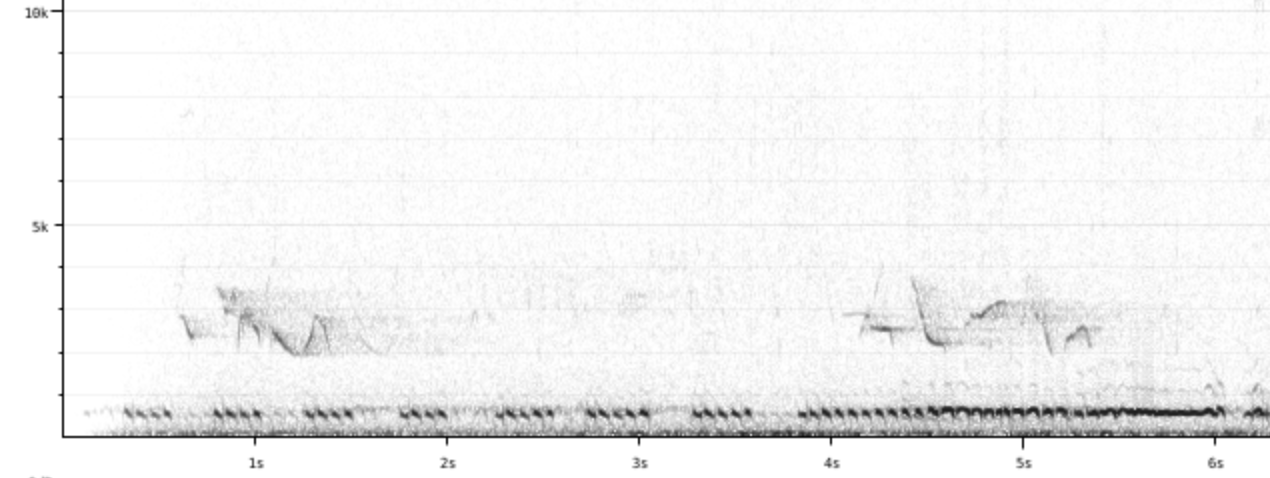
Call:
Automatically generated from Xeno-Canto recording
♫ XC731604 - Black Grouse - Lyrurus tetrix. Source: XENOCANTO
XC731604 - Black Grouse - Lyrurus tetrix.mp3
(song?)

Mauersegler, Sils-Maria. 2020-06-10 12.30.10 Sils
First observed in 🇨🇭 on 2020-06-10.
Vielleicht haben wir bald Mauersegler Brutkaesten am Haus!
Vocalization: ![]() A shrilling trill "zreeeee" of about 1 -2 seconds length, gradually rising in pitch with accentuated firs half, then falling from the middle of phrase. [Link]
A shrilling trill "zreeeee" of about 1 -2 seconds length, gradually rising in pitch with accentuated firs half, then falling from the middle of phrase. [Link]
Calls: ![]() Often continued with a dry lower pitched "trrrrrr" before calling again. Very vocal at breeding area, and often a flock will call together. Despite being quite similar to Pallid Swift, the call is probably the best field character to separate the two. Pallid puts the stress on the ending of the call, followed by a quick fall in pitch (dynamics like moaning with a quick release). Plain Swift calls similar to Common Swift, but differs in slightly fluctuating pitch during the call, and a loss of resonance towards the ending (thinner sounding). [Link]
Often continued with a dry lower pitched "trrrrrr" before calling again. Very vocal at breeding area, and often a flock will call together. Despite being quite similar to Pallid Swift, the call is probably the best field character to separate the two. Pallid puts the stress on the ending of the call, followed by a quick fall in pitch (dynamics like moaning with a quick release). Plain Swift calls similar to Common Swift, but differs in slightly fluctuating pitch during the call, and a loss of resonance towards the ending (thinner sounding). [Link]
Physical details: length=16-17 cm,
wingspan=42-48 cm,
weight=31-56 g
Habitats:
Settlement

Wikipedia: Pallid swift Source: OTHER
Apus_pallidus_-Greece-8.jpg
General: ![]() The pallid swift (Apus pallidus) is a small bird, superficially similar to a barn swallow or house martin. It is, however, completely unrelated to those passerine species, since the swifts are in the order Apodiformes. The resemblances between the groups are due to convergent evolution reflecting similar life styles.
[more]
The pallid swift (Apus pallidus) is a small bird, superficially similar to a barn swallow or house martin. It is, however, completely unrelated to those passerine species, since the swifts are in the order Apodiformes. The resemblances between the groups are due to convergent evolution reflecting similar life styles.
[more]
Vocalization: ![]() Similar to Common Swift, but usually very helpful for ID. Almost di-syllabic, with marked accent on second syllable which rapidly drops in pitch, "srrrree-aah". [Link]
Similar to Common Swift, but usually very helpful for ID. Almost di-syllabic, with marked accent on second syllable which rapidly drops in pitch, "srrrree-aah". [Link]
Calls: ![]() Common swift has a more even call, with accents on first part, without the sudden pitch-drop. [Link]
Common swift has a more even call, with accents on first part, without the sudden pitch-drop. [Link]
Physical details: length=16-17 cm,
wingspan=42-46 cm,
weight=41 g
Habitats:
Settlement

Wikipedia: Alpine swift Source: OTHER
1200px-%CE%92%CE%BF%CF%85%CE%BD%CE%BF%CF%83%CF%84%CE%B1%CF%87%CF%84%CE%AC%CF%81%CE%B1_Alpine_Swift_Tachymarptis_melba.jpg
First observed in 🇨🇭 on 2020-06-20.
General: ![]() The Alpine swift (Tachymarptis melba) formerly Apus melba, is a species of swift. The genus name is from the Ancient Greek takhus, "fast", and marptis, "seizer". The specific name melba comes from ‘melano-alba’ or ‘mel-alba’; Eigenhuis & Swaab (1992) posited that ‘melba’ might be a short form for ‘melano-alba’ or ‘mel-alba’ (Gr. melas, melanos = black; L. albus = white). Linnaeus certainly referred to these two colors in his diagnosis.[2]
[more]
The Alpine swift (Tachymarptis melba) formerly Apus melba, is a species of swift. The genus name is from the Ancient Greek takhus, "fast", and marptis, "seizer". The specific name melba comes from ‘melano-alba’ or ‘mel-alba’; Eigenhuis & Swaab (1992) posited that ‘melba’ might be a short form for ‘melano-alba’ or ‘mel-alba’ (Gr. melas, melanos = black; L. albus = white). Linnaeus certainly referred to these two colors in his diagnosis.[2]
[more]
Habitats:
Settlement
Call:
Automatically generated from Xeno-Canto recording
♫ Source: BirdNet
20200620_121816 birdnet 688 - Alpine swift.mp3
2020-06-20 12.18.16 Luppmen (song?)

Wikipedia: Nightjar Source: OTHER
1200px-Great_Eared-Nightjar%2C_Tangkoko%2C_Sulawesi_%285799113025%29_%282%29.jpg
![]() Nightjars are medium-sized nocturnal or crepuscular birds in the family Caprimulgidae /ˌkæprɪˈmʌldʒɪdiː/ and order Caprimulgiformes, characterised by long wings, short legs, and very short bills. They are sometimes called goatsuckers, due to the ancient folk tale that they sucked the milk from goats (the Latin for goatsucker is caprimulgus), or bugeaters,[1] their primary source of food being insects. Some New World species are called nighthawks. The English word "nightjar" originally referred to the European nightjar.
[more]
Nightjars are medium-sized nocturnal or crepuscular birds in the family Caprimulgidae /ˌkæprɪˈmʌldʒɪdiː/ and order Caprimulgiformes, characterised by long wings, short legs, and very short bills. They are sometimes called goatsuckers, due to the ancient folk tale that they sucked the milk from goats (the Latin for goatsucker is caprimulgus), or bugeaters,[1] their primary source of food being insects. Some New World species are called nighthawks. The English word "nightjar" originally referred to the European nightjar.
[more]
Song: ![]() Song unique among birds, but quite similar to Mole cricket. A mechanical, continuous slur, like the sound of a distant motorbike. As opposed to the Mole Cricket, it often "shifts gear" by changing pitch to a note approximately a fourth below the drone. [Link]
Song unique among birds, but quite similar to Mole cricket. A mechanical, continuous slur, like the sound of a distant motorbike. As opposed to the Mole Cricket, it often "shifts gear" by changing pitch to a note approximately a fourth below the drone. [Link]
Calls: ![]() Flight call a peculiar "kew-eek", with a nasal and frog-like timbre. [Link]
Flight call a peculiar "kew-eek", with a nasal and frog-like timbre. [Link]
Physical details: length=26-28 cm,
wingspan=57-64 cm,
weight=65-100 g
Habitats:
Forest
Song or calls similar to:
Savi's warbler.
Song:
Buzzing like machinery or a (BirdID says) a cricket. Changes pitch at times.
Song attributes:
Melody: simple rhythmic, fast, Frequency: 2-4 KHz
♫ Source: XENOCANTO
XC768849 - European Nightjar - Caprimulgus europaeus - song.mp3
(song)

Classification errors:
Eastern subalpine warbler / Weissbartgrasmücke (Sylvia cantillans)
General: ![]() The eastern subalpine warbler (Curruca cantillans) is a small typical warbler which breeds in the southernmost areas of Europe. It was first described by the German naturalist Peter Simon Pallas in 1764 and given the binomial name Motacilla cantillans.[2][3][4] The specific cantillans is Latin for "warbling" from canere, "to sing".[5]
[more]
The eastern subalpine warbler (Curruca cantillans) is a small typical warbler which breeds in the southernmost areas of Europe. It was first described by the German naturalist Peter Simon Pallas in 1764 and given the binomial name Motacilla cantillans.[2][3][4] The specific cantillans is Latin for "warbling" from canere, "to sing".[5]
[more]
Song: ![]() Song a rapid, vivid stream of squeaks and clearer notes, with timbre similar to Whitethroat. [Link]
Song a rapid, vivid stream of squeaks and clearer notes, with timbre similar to Whitethroat. [Link]
Calls: ![]() Alarm call a short, hard "tuk", but softer and fainter than Blackcap and Sardinian W. May be confused with Sardinian W., but lacks that species interwoven hard and rolling contact call. [Link]
Alarm call a short, hard "tuk", but softer and fainter than Blackcap and Sardinian W. May be confused with Sardinian W., but lacks that species interwoven hard and rolling contact call. [Link]
Physical details: length=12 cm,
wingspan=15-19 cm,
weight=8-13 g